CyberBank CB-0870 Pocket PC / POV CDMA Handset User Manual table of contents
CyberBank Corp Pocket PC / POV CDMA Handset table of contents
Contents
- 1. users manual I
- 2. users manual II
- 3. revised users manual
users manual II

Pocket PC/POZ
User’s Manual

Table of Contents 2
The information contained in this document is provided “as is” and is subject to change
without notice. Cyberbank makes no warranty of any kind with regard to this manual,
including, but not limited to, the implied warranties of merchantability and fitness for a
particular purpose. Cyberbank shall not be liable for any errors contained herein or for
incidental or consequential damages in connection with the furnishing, performance, or
use of this manual or the examples herein.
This document contains proprietary information that is protected by copyright. All rights
are reserved. No part of this document may be photocopied, reproduced, adapted, or
translated to another language without the prior written consent of H Cyberbank, except
as allowed under the copyright laws.
The programs that control this product are copyrighted and all rights are reserved.
Reproduction, adaptation, or translation of those programs without prior written
permission of Cyberbank is also prohibited. Microsoft, ActiveSync, MSN, Outlook,
Windows, Windows Media, Windows NT, and the Windows logo are either registered
trademarks or trademarks of Microsoft Corporation in the United States and/or other
countries. Microsoft products are licensed to OEMs by Microsoft Licensing, Inc., a wholly
owned subsidiary of Microsoft Corporation.
All other brand names and product names used in this document are trade names,
service marks, trademarks, or registered trademarks of their respective owners.
CYBERBANK. CORP.
18th Fl. Pagoda Tower B/D 1306-6
Seocho-dong, Seocho-gu, Seoul, Korea 137-855
Copyright
Cyberbank assumes no responsibility for any damage or loss resulting form the
use of this manual. And also Cyberbank assumes no responsibility for any
damage or loss caused by deletion of data as a result of malfunction, dead
battery, or repairs. Be sure to make backup copies of all-important data on other
media to protect against data loss.

Table of Contents 3
In August 1996 the Federal Communications Commission (FCC) of the United States with its action in
Report and Order FCC 96-326 adopted an updated safety standard for human exposure to radio
frequency electromagnetic energy emitted by FCC regulated transmitters. Those guidelines are consistent
with the safety standard previously set by both U.S. and international standards bodies. The design of POZ
complies with the FCC guidelines and these international standards.
Use only the supplied or an approved antenna. Unauthorized antennas, modifications, or attachments
could impair call quality, damage your POZ, or result in violation of FCC regulations.
Do not use your POZ with a damaged antenna. If a damaged antenna comes into contact with the skin, a
minor burn may result. Please contact your local dealer for replacement antenna.
POZ was tested for typical body-worn operations using the optional belt-clip / holster placed 1 inch
(2.54cm) from the body. To comply with FCC RF exposure requirements, a minimum separation distance
of 1 inch (2.54cm) must be maintained between the user's body and POZ, including the antenna, whether
extended or retracted. The use of third-party belt-clips / holsters with no metallic components that provide
the minimum separation distance of 1 inch (2.54cm) can be used to satisfy FCC RF exposure
requirements. The use of non-tested accessories or other body-worn operations may not comply with
FCC RF exposure requirements and should be avoided. Contact your local dealer for optional accessory
items.
For more information about RF exposure, please visit the FCC website at www.fcc.gov
FCC RF Exposure Information

Table of Contents 4
Please read these simple guidelines before using your phone. Failure to comply with these guidelines may
be dangerous or illegal.
Do not use a hand held phone whilst driving a vehicle; park the vehicle first.
Switch off your phone when in an aircraft. The use of cellular phones whilst airborne is illegal in some
countries. It may disrupt the operation of the aircraft. Follow any regulations or rules regarding air travel.
Wireless phones can cause interference. Switch off your phone near medical equipment.
Do not use your mobile phone at a petrol station or near fuel, chemicals or in any area where blasting is in
progress. Observe restrictions and follow all rules and regulations.
Use the phone only in a normal manner as instructed in this manual and do not handle the antenna
unnecessarily.
Only qualified service personnel must install or repair equipment. Breaking the warranty seal and opening
the casing of the phone will void your warranty.
Use only approved accessories and batteries. Do not connect to incompatible products.
Avoid any contact with water and any type of moisture.
Safety Information

Table of Contents 5
1 | About Device...................................................................................................... 1-1
What’s in the Box...................................................................................................... 1-2
Hardware Features ................................................................................................... 1-3
Using Stylus .............................................................................................................. 1-5
Soft Reset & Hard Reset .......................................................................................... 1-6
Microsoft Pocket PC Software .................................................................................. 1-7
The 3rd party programs ............................................................................................. 1-8
Where to Find Information ........................................................................................ 1-9
Using Help on Your Device....................................................................................... 1-9
Using This Manual .................................................................................................... 1-9
2 | Getting Started ................................................................................................. 2-1
Complete the Welcome wizard ................................................................................. 2-4
Using Today Screen ................................................................................................. 2-9
File Explorer ............................................................................................................ 2-14
Powering up device .................................................................................................. 2-18
Using the Hardware Buttons..................................................................................... 2-20
Caring for your device ............................................................................................. 2-21
3 | Using Input Panel .............................................................................................. 3-1
Using Input Panel ..................................................................................................... 3-2
Block Recognizer...................................................................................................... 3-13
Keyboard................................................................................................................... 3-17
Letter Recognizer ..................................................................................................... 3-17
Transcriber................................................................................................................ 3-17
4 | Connecting to Desktop ..................................................................................... 4-1
Install Microsoft ActiveSync and establish a partnership ......................................... 4-2
How to install Microsoft ActiveSync.......................................................................... 4-2
Full Backup & Restore using Backup/Restore of ActiveSync................................... 4-7
How to install programs using ActiveSync................................................................ 4-9
5 | Using the Internet & E-mail............................................................................... 5-1
Browsing the Web from your device......................................................................... 5-2
Sending and Receiving E-mail.................................................................................. 5-6
Contents

Table of Contents 6
6 | Configuring Device............................................................................................ 6-1
Adjusting Settings ..................................................................................................... 6-2
Managing Memory .................................................................................................... 6-22
7 | Using the Mobile Phone .................................................................................... 7-1
Phone Program......................................................................................................... 7-2
SMS(Short Message Service) .................................................................................. 7-17
8 | Microsoft Pocket Outlook ................................................................................. 8-1
Calendar: Scheduling Appointments and Meetings.................................................. 8-2
Contacts: Tracking Friends and Colleagues............................................................. 8-6
Tasks: Keeping a To-Do List .................................................................................... 8-9
Notes: Capturing Thoughts and Ideas...................................................................... 8-11
9 | Microsoft Programs ......................................................................................... 9-1
Microsoft Pocket Word.............................................................................................. 9-2
Microsoft Pocket Excel ............................................................................................. 9-4
Microsoft Windows Media Player.............................................................................. 9-6
Microsoft Reader ...................................................................................................... 9-9
MSN Messenger ....................................................................................................... 9-13
10 | Support & Service .......................................................................................... 10-1
Web Site ................................................................................................................... 10-1
Service ...................................................................................................................... 10-1
Appendix
A. Hardware Specification ........................................................................................ A-1
B. Warranty ............................................................................................................... B-1

Chapter 1 About Device 1-1
Congratulations on purchasing PDA (personal digital assistant) device powered by
Microsoft® Windows® for Pocket PC. Your device lets you keep your most important
business and personal information current and close at hand. Your device includes
Microsoft Pocket PC Software 2002, which includes the latest version of Microsoft
Pocket Outlook®, so you can read and write e-mail while on the road and manage your
appointments and contacts. You will find that your device is also the perfect companion
to your desktop or notebook PC, allowing you to take vital business data and documents
with you and easily upload updated information. The device offers you the highest quality
in performance and power management as well as rich programs and utilities designed
by cyberbank.
⊙ In this chapter, you will find:
- What’s in the Box?
- Hardware Features
- Using Stylus
- Soft Reset & Hard Reset
- Microsoft Pocket PC Software
- The 3rd programs
- Where to Find Information
- Using This Manual
Chapter 1
About Device
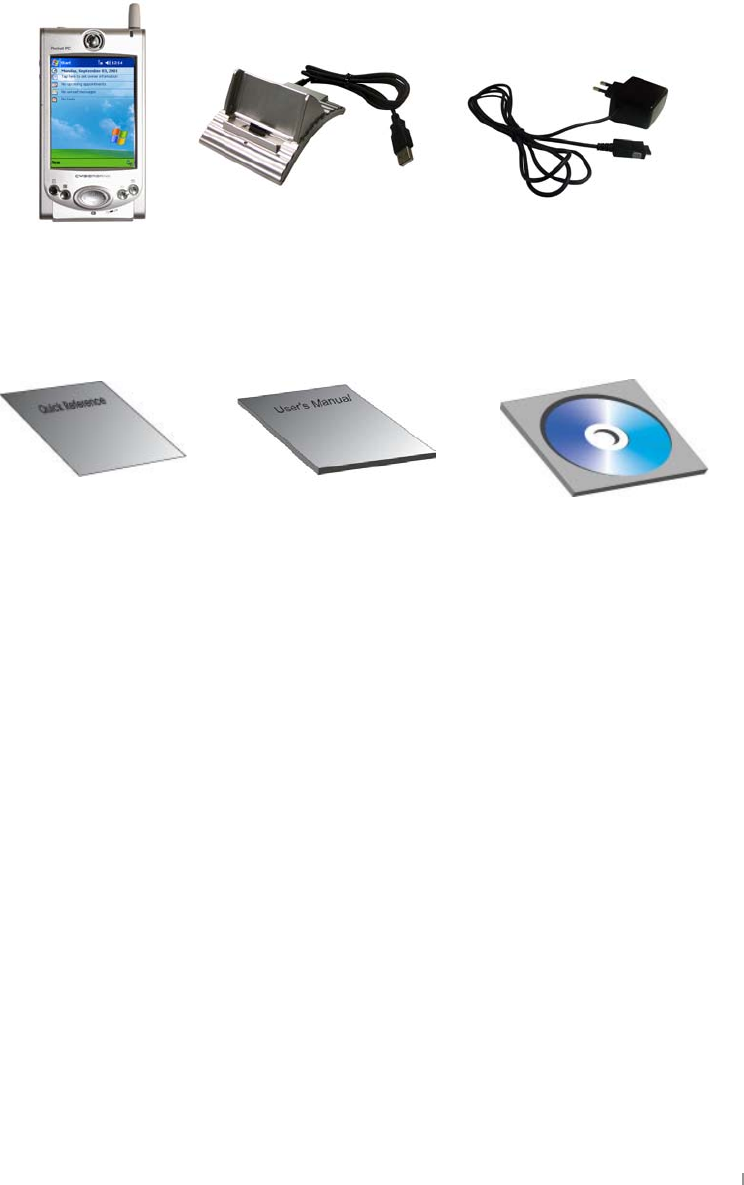
User’s Manual 1-2
What’s in the Box?
Your device package includes the following items:
Device Cradle & USB Cable AC Adapter
Quick Start Guide
(
A
graphic guide to
setting up your device.)
User's Manual Pocket PC Companion CD
(Includes Microsoft
ActiveSync® and Microsoft
Outlook 2002 for your desktop
PC, as well as programs and
utilities that add functionality to
your device.)
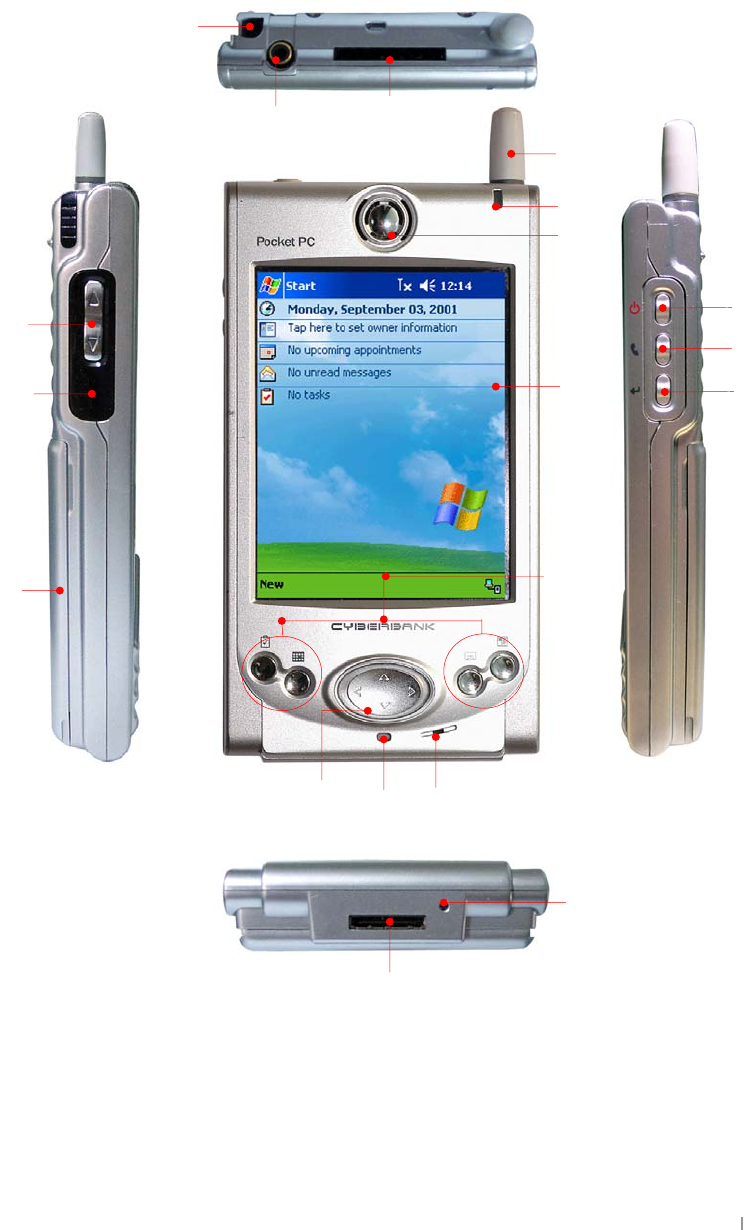
Chapter 1 About Device 1-3
Hardware Features
The illustrations below introduces you to the various buttons and other features of your
device.
a. Stylus: Use the stylus to navigate on the touch screen.
b. Stereo headphone jack: Connect a proprietary stereo headphone.
c. SD (Secure Digital) card slot: Insert an optional SD card to add memory.
d. Up/down control button: Scroll through documents.
e. Infrared port: Beam files to other mobile devices.
ⓑ
ⓔ
ⓖ
ⓚ
ⓝ
ⓞ
ⓐ
ⓓ
ⓛ
ⓜ
ⓕ
ⓒ
ⓗ
ⓘ
ⓙ
ⓟ
ⓠ
ⓡ
ⓢ

User’s Manual 1-4
f. Battery: main battery(1400mAh).
g. Antenna: used for built-in cellular module.
h. Phone status LED: flashes when a phone-call comes in and displays the status of
mobile phone. Notifies you of phone status including SMS.
i. Speaker: Listen to music or set audible reminders and alerts and hear the voice
while communicating on the mobile phone.
j. Touch screen(TFT LCD): Tap on-screen controls or buttons to select menu
commands or input text.
k. Charging status LED: indicates power status while recharging. (Blue : fully charged,
Red : charging)
l. Hot keys: Press to open an application or programmed function.
m. Microphone: Speak into the microphone to record voice notes and communicate on
the mobile phone.
n. Navigation pad: Press to navigate through documents or select on-screen buttons
and controls.
o. Power button: Press to turn your device on and off.
p. Phone button: Press to turn your phone program on.
q. Enter button: Press it once to have the last called phone number displayed on the
phone display with the phone program on and press it once to finish your
communication you want.
r. Reset button: Use the stylus to press the reset button and restart your device so that
all your unsaved files will be deleted.
s. USB port: Connect to your desktop PC using the supplied cradle, or directly through
an optional sync cable.
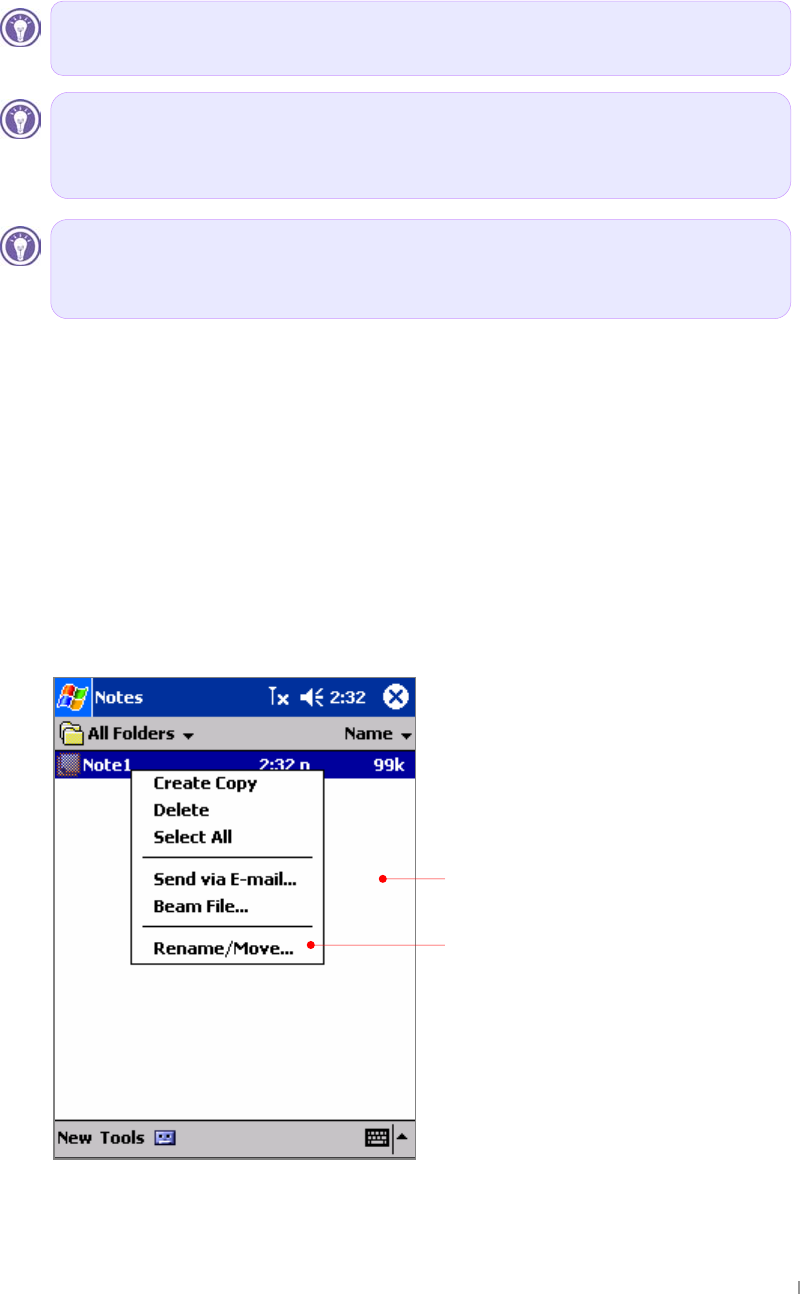
Chapter 1 About Device 1-5
Using the Stylus
Use the stylus to navigate and select objects on the screen.
Pop-up menu
With pop-up menus, you can quickly choose an action for an item. For example, you can
use the pop-up menu in the contact list to quickly delete a contact, make a copy of a
contact, or send an e-mail message to a contact. The actions in the pop-up menus vary
from program to program.
To access a pop-up menu, tap and hold the stylus on the name of the item that you want.
When the menu appears, lift the stylus, and tap the action you want. Or tap anywhere
outside the menu to close the menu without performing an action.
Tap and hold to display the pop-up menu.
Lift the stylus and tap the action you want.
Select from the pop-up menu to copy,
delete, paste, select all, rename, move.
Tap and hold
Tap and hold the stylus on an item to see a list of actions available for that item.
On the pop-up menu that appears, tap the action you want to perform.
Drag
Hold the stylus on the screen and drag across the screen to select text and
images. Drag in a list to select multiple items.
Tap
Touch the screen once with the stylus to open items and select options.
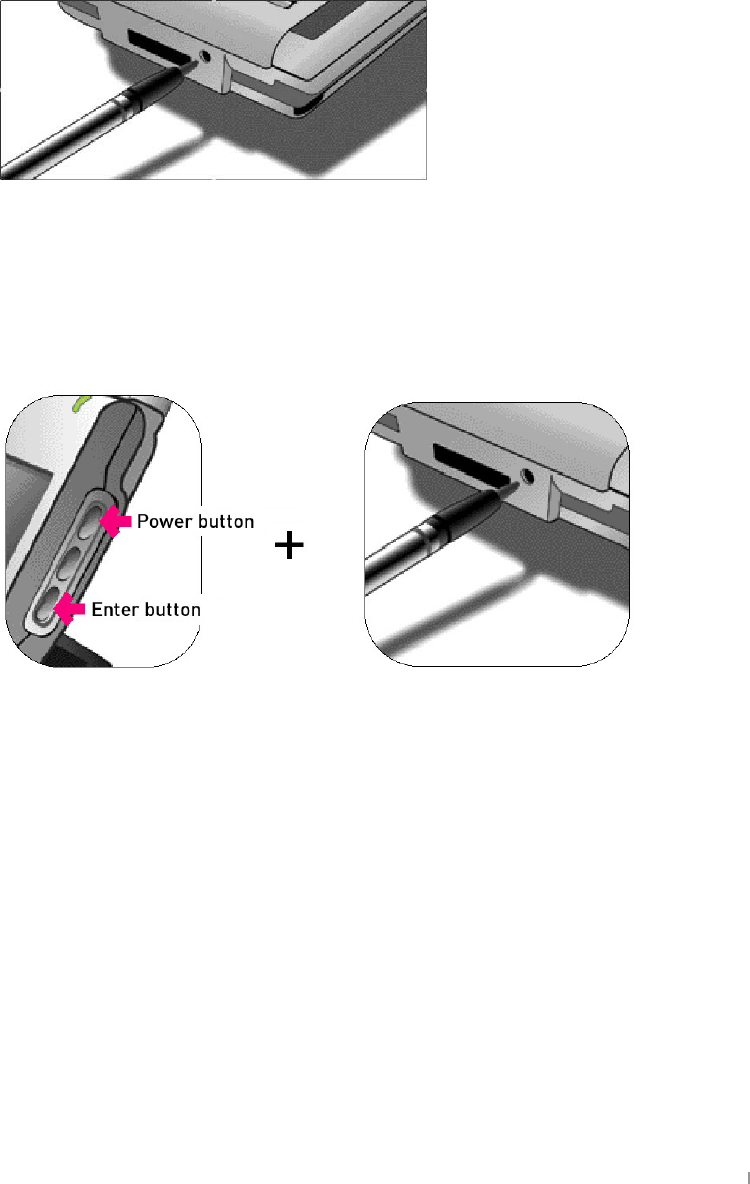
User’s Manual 1-6
Soft Reset & Hard Reset
When your device is running slow or improperly, use the stylus to press the Reset button
located on the bottom. This is called “Soft Reset” in this manual. When you perform a
Soft Reset, you will lose all unsaved data. Be sure to save all data in open documents or
programs beforehand. This is similar to pressing the Reset button on your desktop.
Performing Hard Reset is at the same time to press the power button and the Enter
button located on the right side of your device. When you perform Hard Reset, you will
lose all information that is stored in the RAM. Be sure to save all data using ActiveSync
or the Backup utility before you perform Hard Reset.
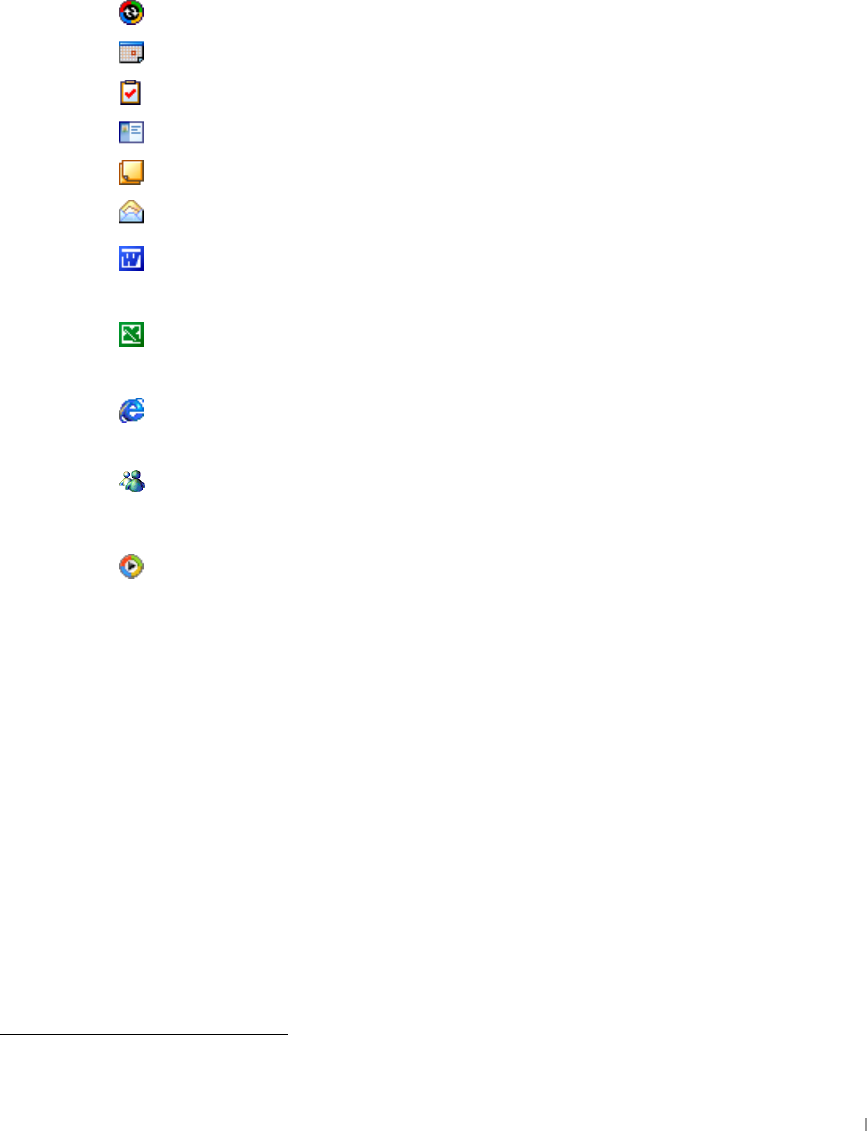
Chapter 1 About Device 1-7
Microsoft Pocket PC Software
Your device already includes the full suite of software you need to function as a mobile
professional. These programs are introduced below.
Detailed information can be found in later chapters.
The programs listed below are preinstalled in Flash ROM or in the Built-in Flash. These
preinstalled programs will not be deleted if your device suffers a loss of power.
ActiveSync. Synchronize information between your device and desktop computer.
Calendar. Keep track of your appointments and create meeting requests.
Tasks. Keep track of your to-do list.
Contacts. Keep track of your friends and colleagues.
Notes. Create handwritten or typed notes, drawings, and recordings.
Inbox. Send and receive e-mail messages from your device.
Pocket Word. Create new documents or view and edit Word documents created on
your desktop PC.
Pocket Excel. Create new workbooks or view and edit Excel workbooks created on
your desktop PC.
Microsoft Pocket Internet Explorer. Browse the Web and view channels and
subscription content.
MSN Messenger.1 Send and receive instant messages with your MSN® Messenger
contacts.
Microsoft Windows Media Player for Pocket PC.2 Play audio and video clips on
your device. Windows Media™ Player lets you play songs and video files that have
been recorded in the MP3 or WMA formats.
1 Requires an account with an Internet service provider.
2 Check the Microsoft Mobile Devices Web site for updates to Windows Media Player, including details on
support for video file formats and streaming audio and video capabilities.

User’s Manual 1-8
The 3rd Party Software
The Pocket PC Companion CD included with your device has additional programs for
both your desktop PC and your device. The programs listed below are preinstalled in
Flash ROM or Companion CD.
Phone. Enables you to make voice calls just like a mobile phone.
SMS(Short Message Service). Enables you to send and receive short messages to and
from other mobile phones.
Pocket Backup. Enables you to backup and restore the data in your device’s RAM to
and from SD cards and Built-in Flash.
Task Manager. Enables you to do the functions similar to the Task Manager on your
desktop PC.
ClearVue Presentation. Enables you to open Microsoft PowerPoint programs on your
device.
ClearVue Image. Enables you to view any image files on your device.
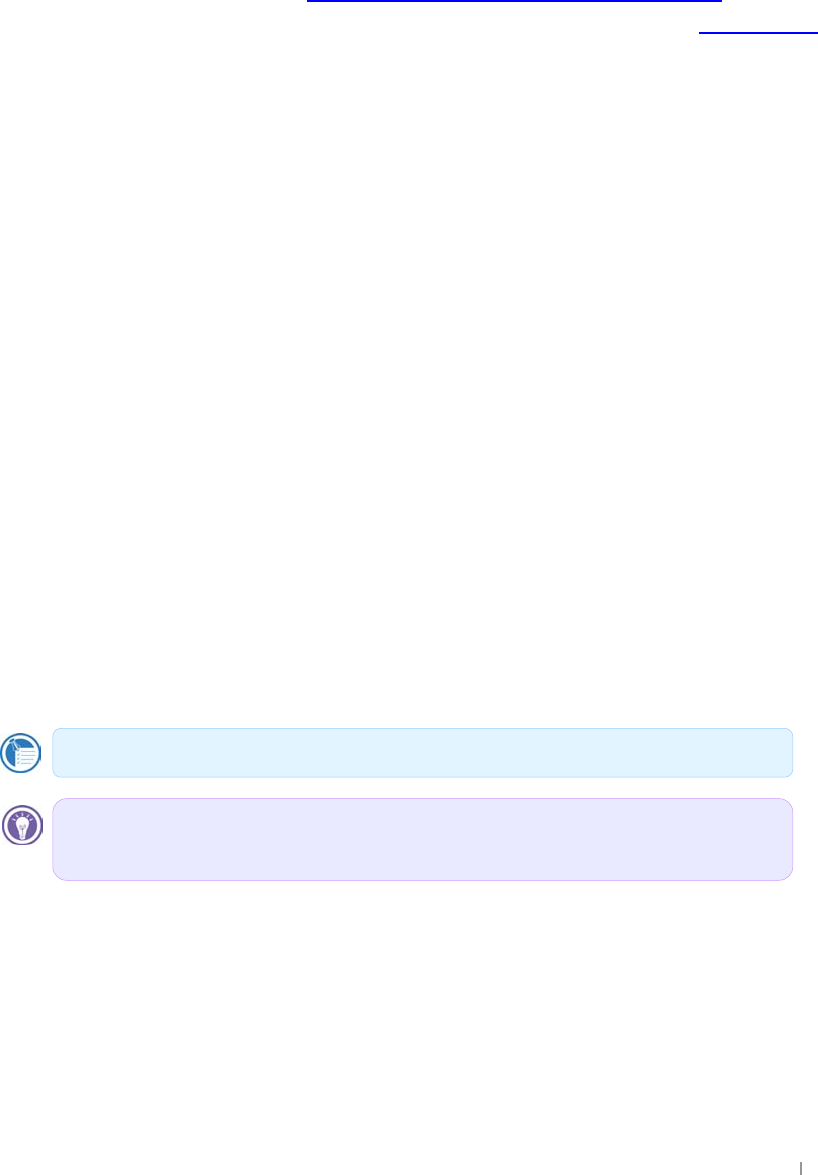
Chapter 1 About Device 1-9
Where to Find Information
ActiveSync
The ActiveSync Troubleshooter on your desktop PC is on the ActiveSync File menu,
click Connection Settings, and then click Help. You can install ActiveSync 3.6 from the
provided Companion CD. In case that you lose the companion CD, download and install
the latest ActiveSync 3.6 on www.microsoft.com/mobile/pocketpc/download on your
desktop PC and also download and install CyberbankUsBupdate.exe on www.cb.co.kr.
The reason is that ActiveSync 3.6 on companion CD has been updated with USB ID, but
the downloaded ActiveSync 3.6 on www.microsoft.com/mobile/pocketpc/download is not
updated with USB ID.
Using Help on Your Device
You can get help for specific programs and for Microsoft Pocket PC software by tapping
Help on the Start menu. Help can be displayed for the active program. To display a
menu of all Help files available on your device, tap the View menu, and then tap All
Installed Help, or simply tap Help while the Today screen is active.
Using This Manual
This User's manual is designed to help you get started using your device quickly and
easily. Although great care has been taken to ensure the accuracy of procedures and
artwork, some of the screens displayed on your device may be a little different from the
ones that appear in this User’s manual.
This User's manual includes certain visual cues that will help you find the information you
want easily.
Notes : Helpful information related to the topic.
Notice : This is important information that should be observed to prevent loss of
data or damage to your device.

Chapter 2 Getting Started 2-1
This chapter will help you start using your device. You will become familiar with the hardware
and learn how to set up your device. When you finish this chapter, you will have all the
information you need to begin working with your device.
⊙ This chapter includes step-by-step instructions to help you.
- Complete the Welcome Wizard
- Using Today Screen
- Using File Explorer
- Power up the first time
- Hardware buttons
- Caring for your device
Chapter 2
Gettin
g
Started
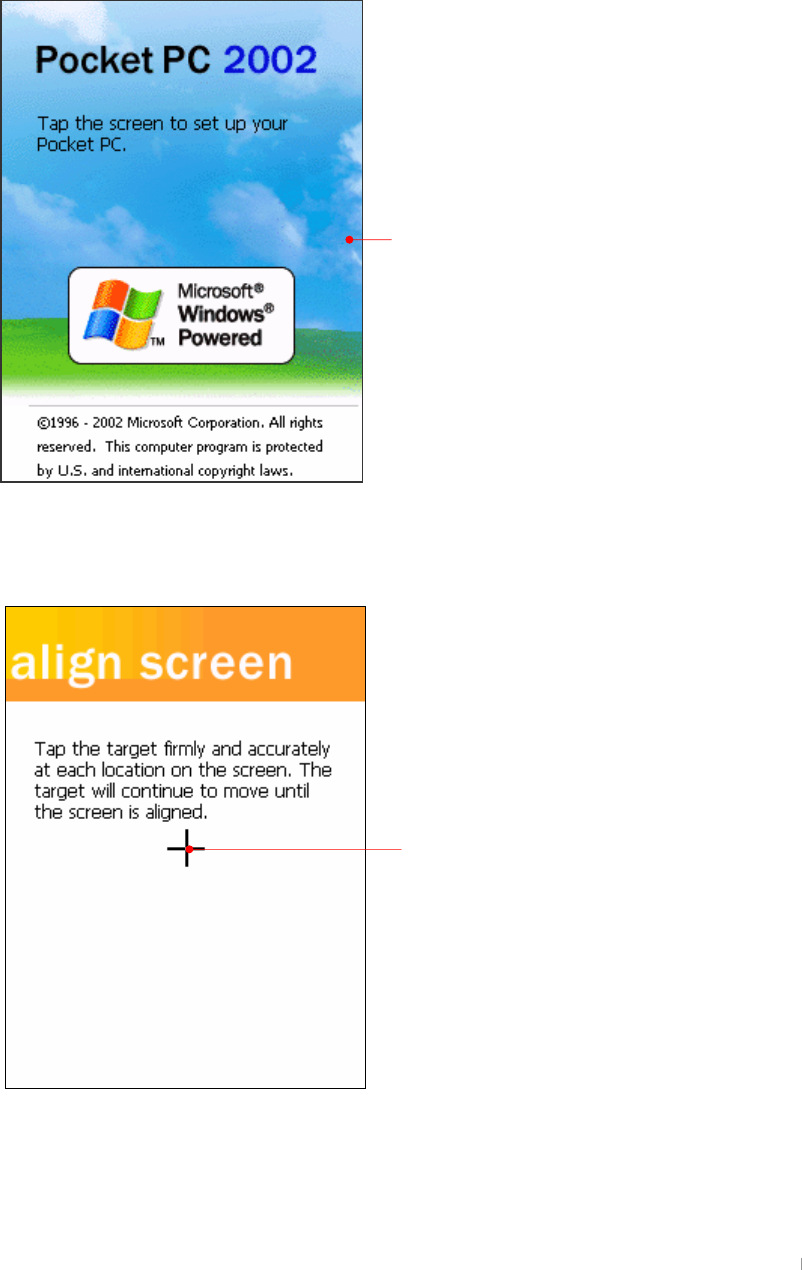
User’s Manual 2-2
Complete the Welcome wizard
Follow the steps in this section to start using your device for the first time or after performing
hard-reset.
Gently touch the screen with stylus. From
now on, it is called “tap”.
A target (+) will move in the order of “center
→ upper left → lower left → lower right →
upper right” on your screen. Since
calibrating the touch screen has a direct
affect on the recognition ability of your touch
screen, be sure to accurately tap the center
of the target (+) with your stylus.
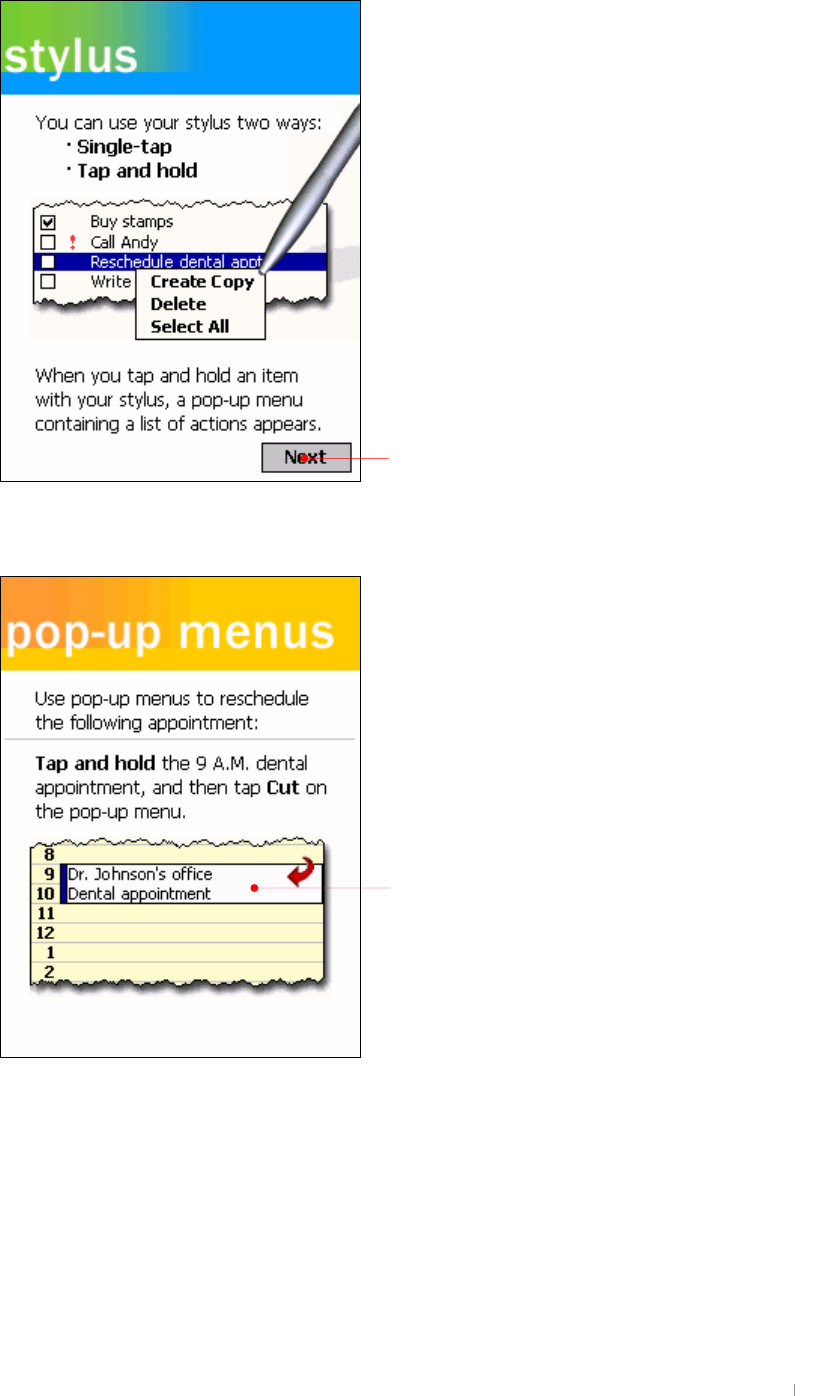
Chapter 2 Getting Started 2-3
This is the way of how to single-tap and tap and
hold, ta
p
the Next button.
Tap and hold this location to have next window.
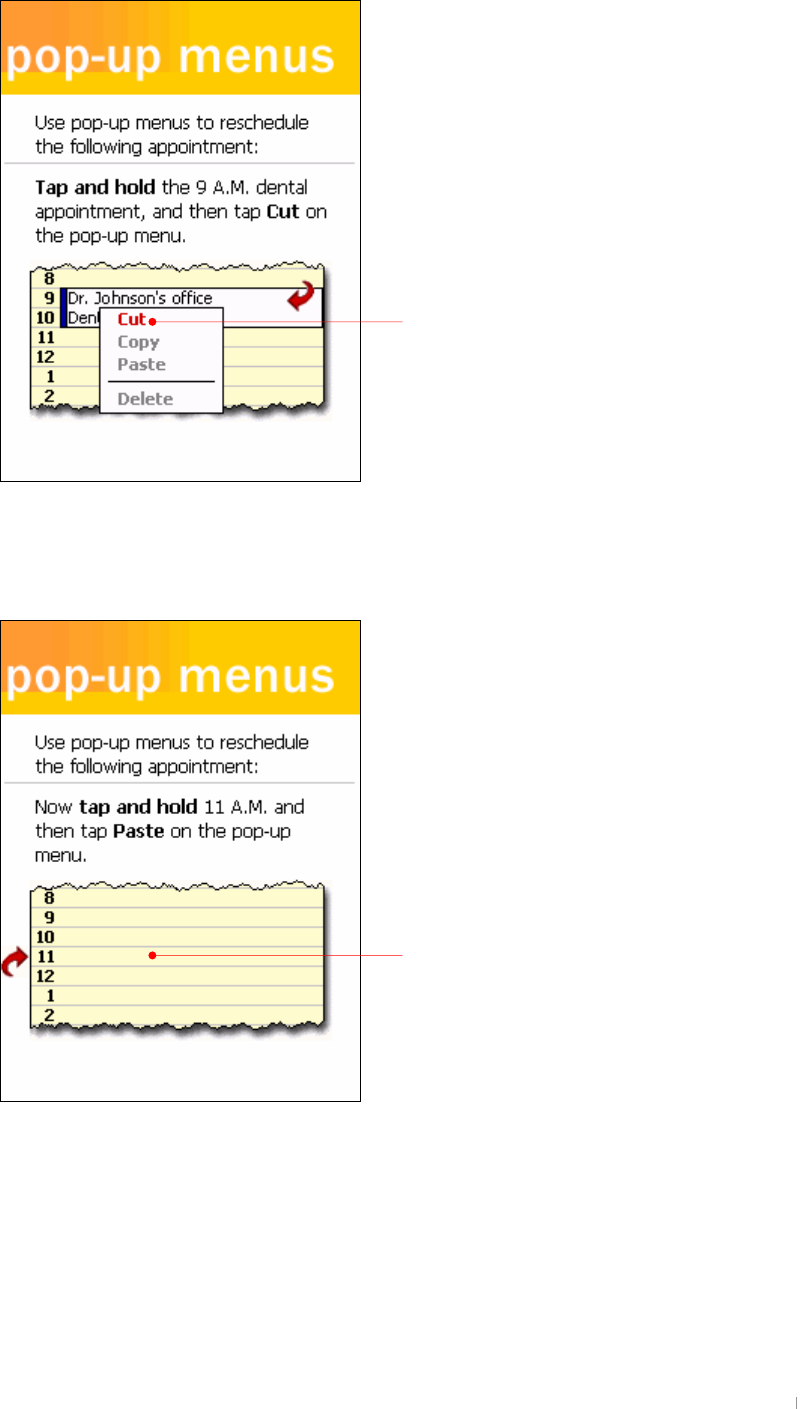
User’s Manual 2-4
It is called “Pop-up” menu. Select Cut.
Tap and hold this location next to 11 to paste the
cut contents. Then you will have the new pop-up
menu.
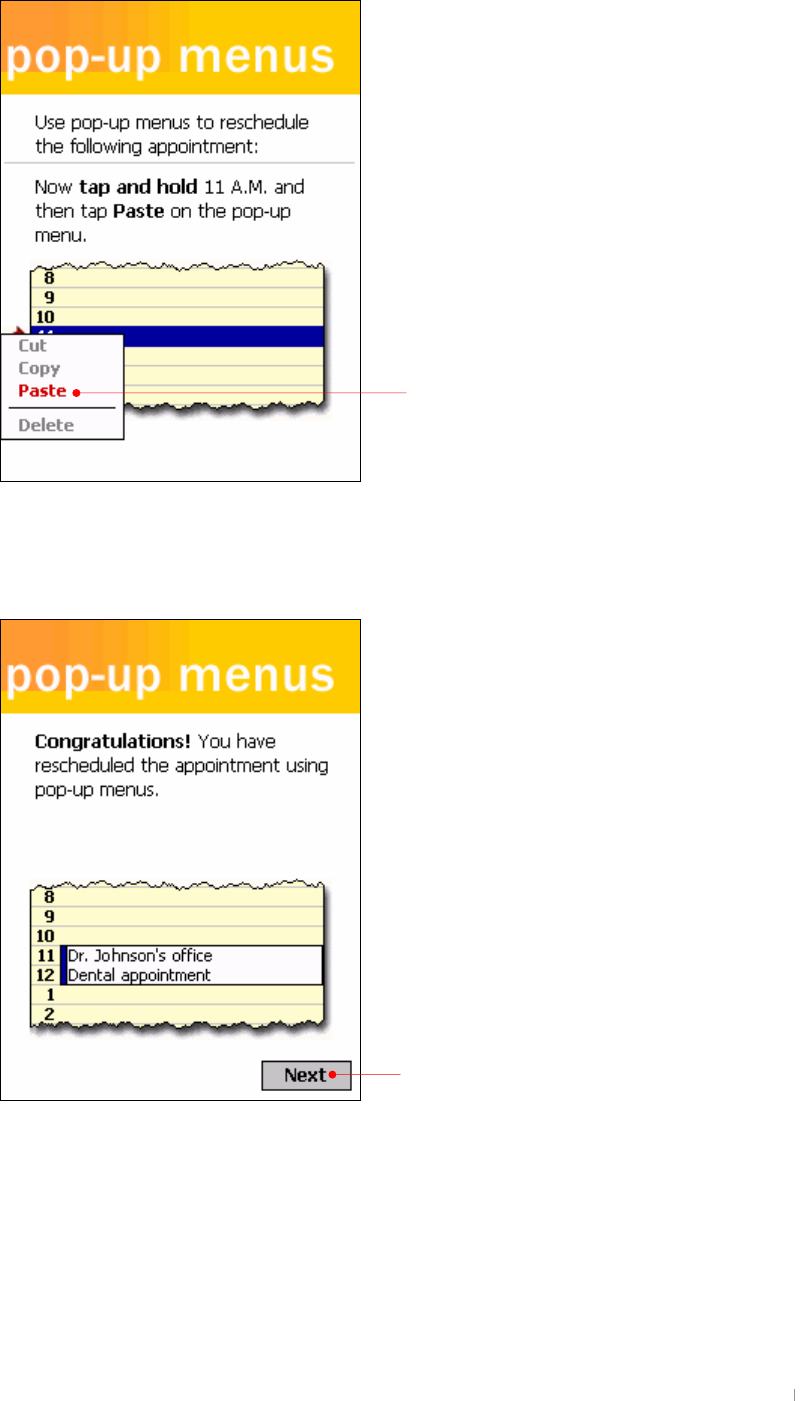
Chapter 2 Getting Started 2-5
Select Paste on this list.
The pasted contents have appeared. Tap the Next
button.
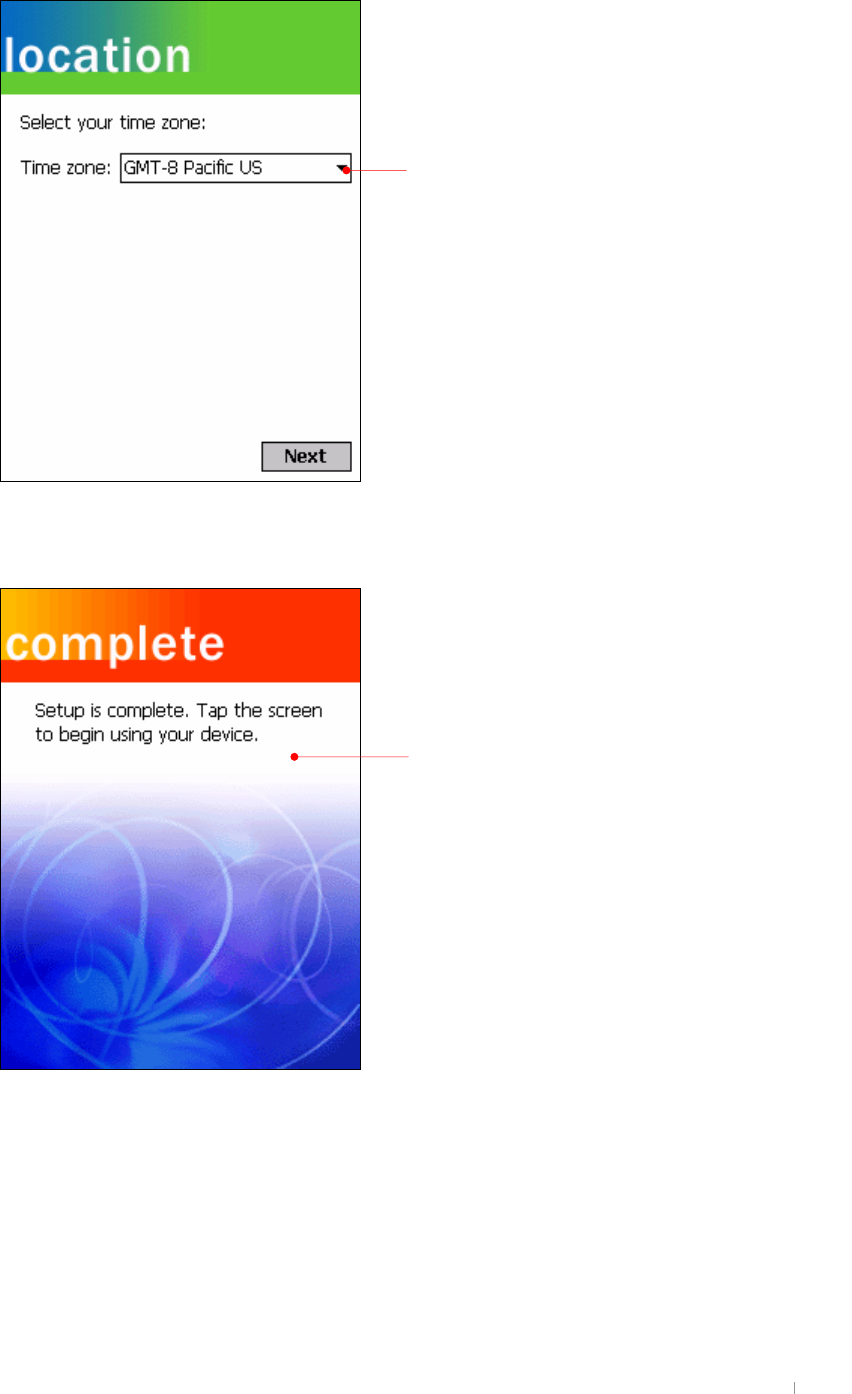
User’s Manual 2-6
Select GMT-3 Brasilia from the drop-down list box.
Tap the screen to finish the Welcome wizard.
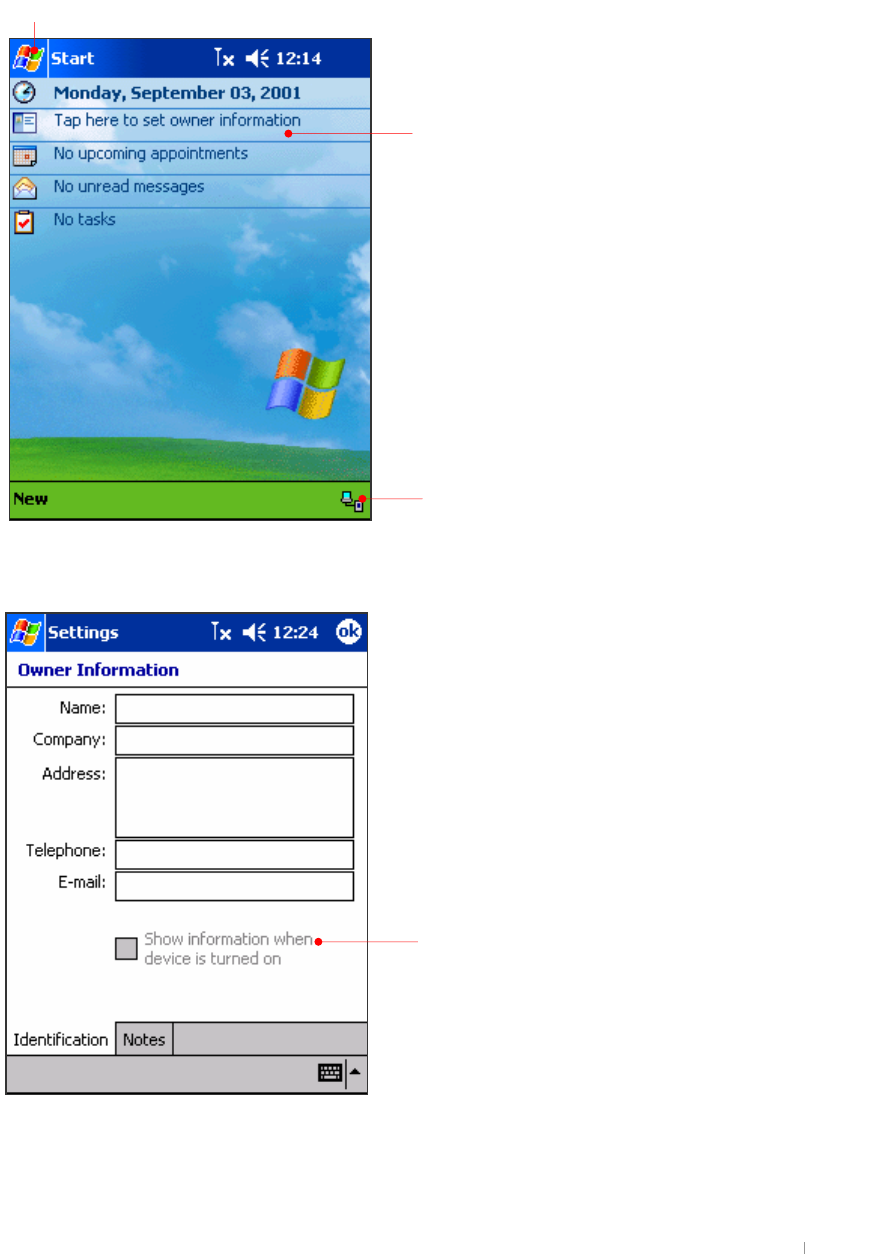
Chapter 2 Getting Started 2-7
Using Today Screen
After finishing the Welcome wizard, put your device on the cradle connected to your desktop
PC to automatically synchronize through Microsoft ActiveSync so that you have the next screen.
Now, you are ready to enter Owner information. Tap Owner information to have next screen.
Tap any text box where you want to enter information to have input panel displayed. For more
detailed information on input panel, see chapter 3.
Enter your personal information which is not synchronized
with your desktop PC.
Start menu
Select this option box to have your personal
information displayed whenever you turn on
y
our device.
Synchronize today with your desktop PC through
ActiveSync
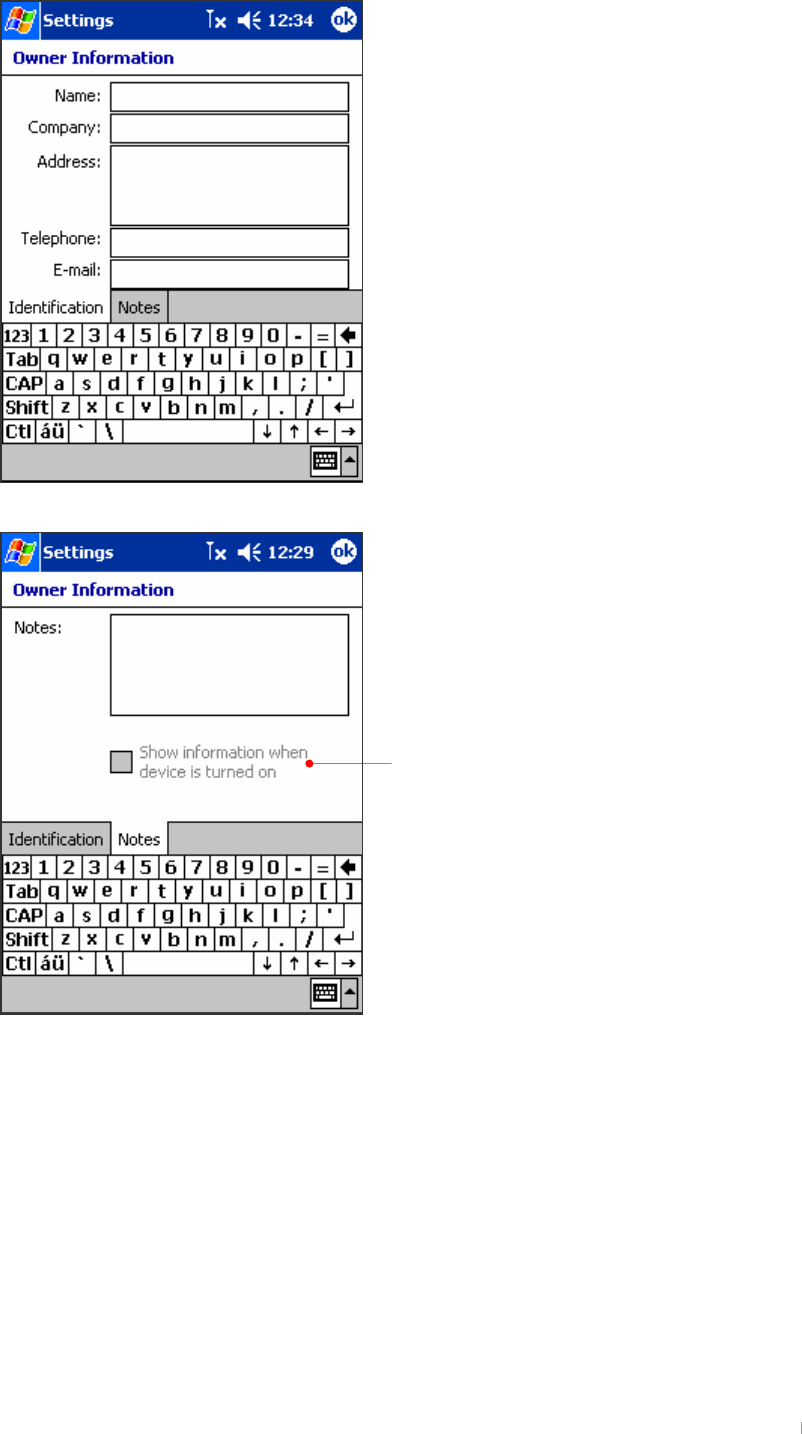
User’s Manual 2-8
For more personal information if needed, select the Notes tab.
Select to have owner information displayed
whenever turn on device.
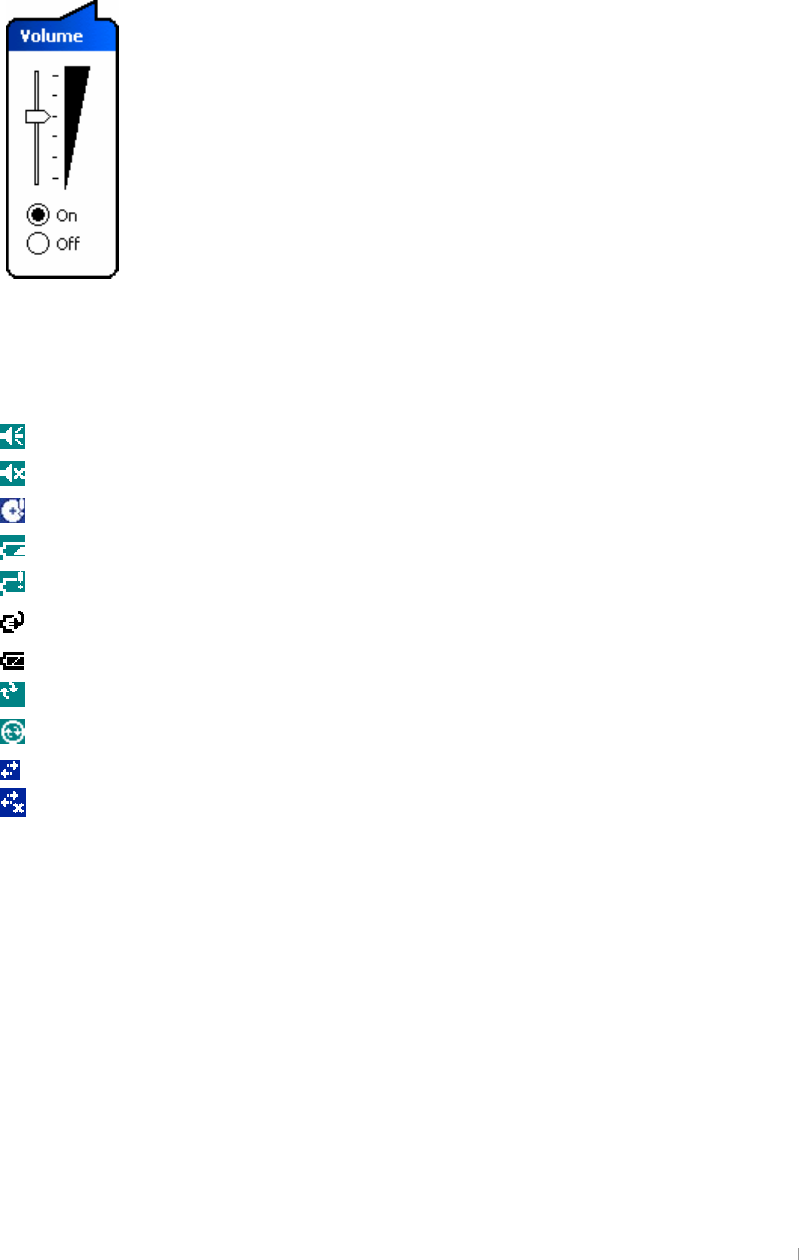
Chapter 2 Getting Started 2-9
Status Icons
When the Today screen is displayed, you may see the following status icons on the Command
bar or Navigation bar. In most cases, you can tap a status icon to display the associated control
panel or more information related to the item. For example, tap a battery status icon to open
the Power control panel.
Icon Meaning
Speaker is on
Speaker is off
Backup Battery is low
Battery is low
Battery is very low
Battery is charging
Battery is fully charged
Synchronization is occurring
Synchronization is beginning or ending
Internet connected
Internet disconnected
Alerts and Notifications
Your device reminds you in a variety of ways when you have something to do. For example, if
you have set up an appointment in Calendar, a task with a due date in Tasks, or an alarm in
Clock, you will be notified in any of the following ways:
* A message appears on the screen.
* A sound, which you can specify, is played.
To choose reminder types and sounds for your device, tap Settings on the Start menu. On the
Personal tab, tap Sounds & Notifications.
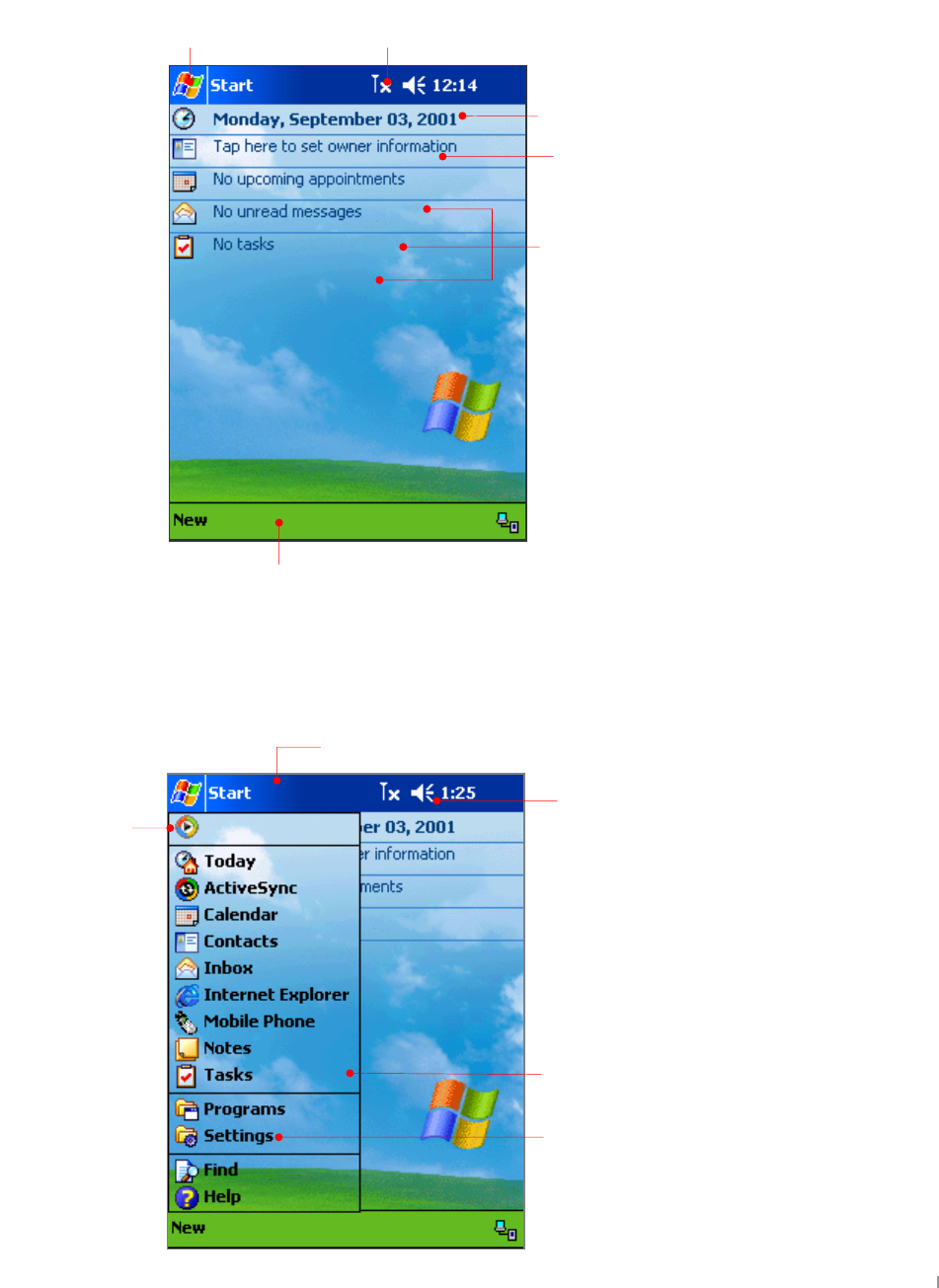
User’s Manual 2-10
When you turn on your device for the first time each day (or after 4 hours of inactivity), you will
see the Today screen. You can also display it by tapping Today. On the Today screen, you can
see at glance important information for the day.
⊙ To start or switch programs
1. Press the Start menu.
2. Select the icon that corresponds to the program or document.
Synchronize today with your desktop PC
through ActiveSync.
Enter your personal information which is not
synchronized with your desktop PC.
Display the current
state of connection
Calendar, Inbox and tasks have been
synchronized with desktop PC.
Select the Start menu to
switch to other programs.
Command Bar
Navigation Bar
Tap to quickly
select a program
you have
recently used.
Tap to change volume or mute the
device.
Tap to select a program.
Tap Settings to customize the device.

Chapter 2 Getting Started 2-11
The Navigation bar is located at the top of the screen. It displays the active program and
current time, and allows you to switch programs and close screens.
Use the Command bar at the bottom of the screen to perform tasks in programs. The
Command bar includes menu names, buttons, and the Input panel button. To create a new
item in the current program, tap New.
To open a program you have recently used, select the corresponding program icon.
You can customize both the New menu and the Start menu to make it easier to
access the programs you use frequently. On the Start menu, select Settings >
the Personal tab > Menu and select the icons you want as described.
You can switch programs using task manager.
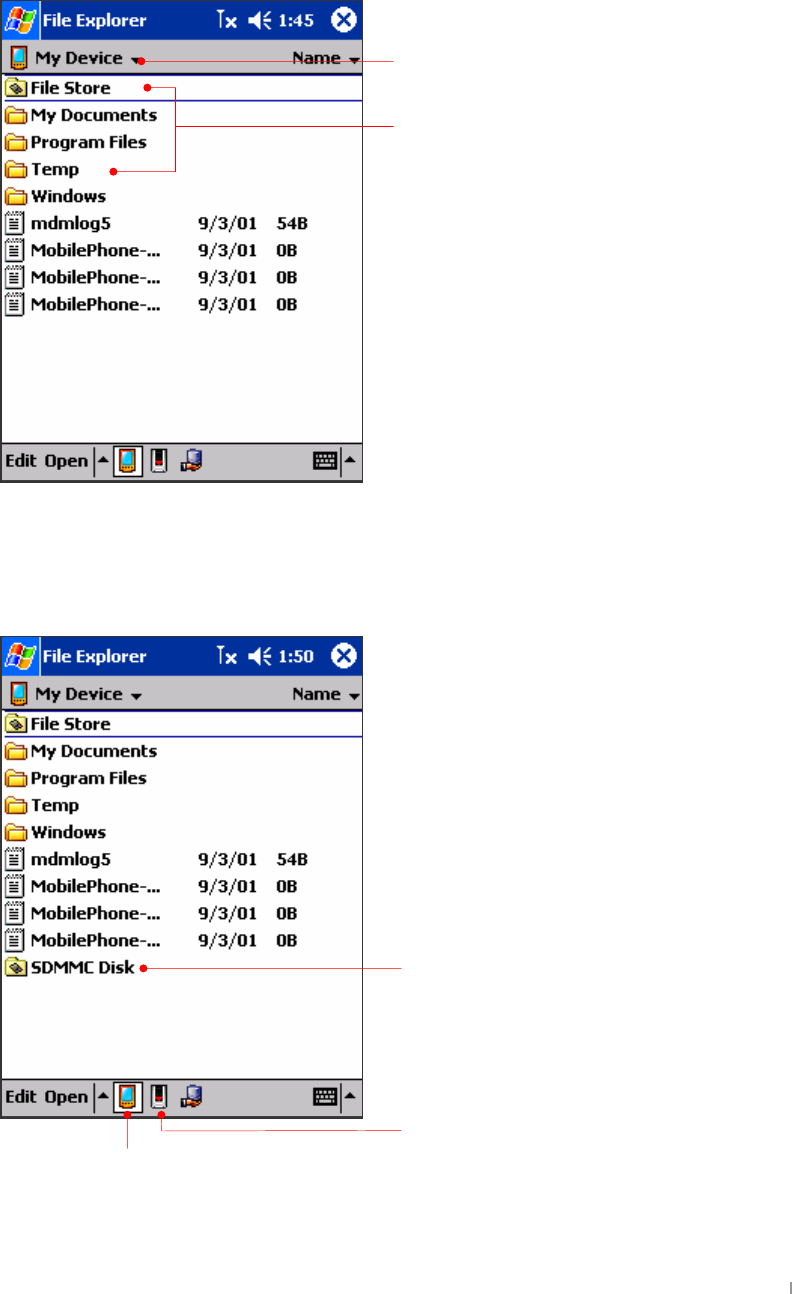
User’s Manual 2-12
File Explorer
This File Explorer of your device is similar to Window Explorer of desktop PC.
Select the Start menu > Programs > File Explorer.
⊙ View the contents of SD(Secure Digital) card
Insert SD cards into the SD card slot so that SDMMC Disk folder appears. Tap this folder to
view the contents of SD card.
Select to go to the higher
level of a folder.
Select a folder below My Device you want to
move to.
SD card folder
My Device icon
SD card folder icon
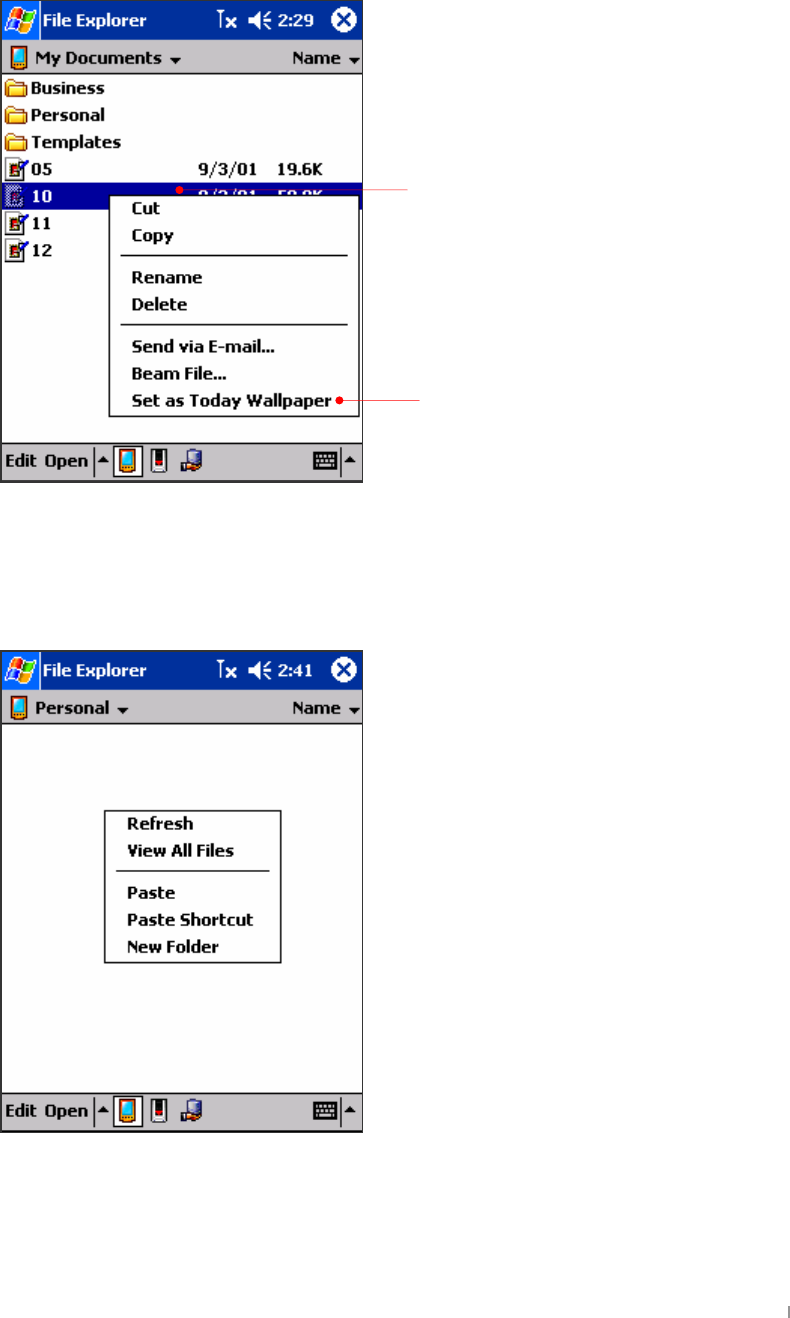
Chapter 2 Getting Started 2-13
⊙ Pop-Up Menus
Tap and hold the file you cut, copy, rename and delete to have Pop-up menu displayed. Also tap
and hold out of files or folders to have a little different pop-up menu that includes new folder. Now
we show you an example of process where we copy a file from a folder and paste it to another folder.
Tap and hold a file you copy to have Pop-up menu displayed and tap Copy. Select Personal
you want to paste the copied file to. On the Personal folder, tap and hold the empty space to
have pop-up menu that includes Paste.
Tap and hold a file you copy to have Pop-up
menu displayed and tap Copy.
Tap Set as Today Wallpaper to have this
file displayed as Today Wallpaper.
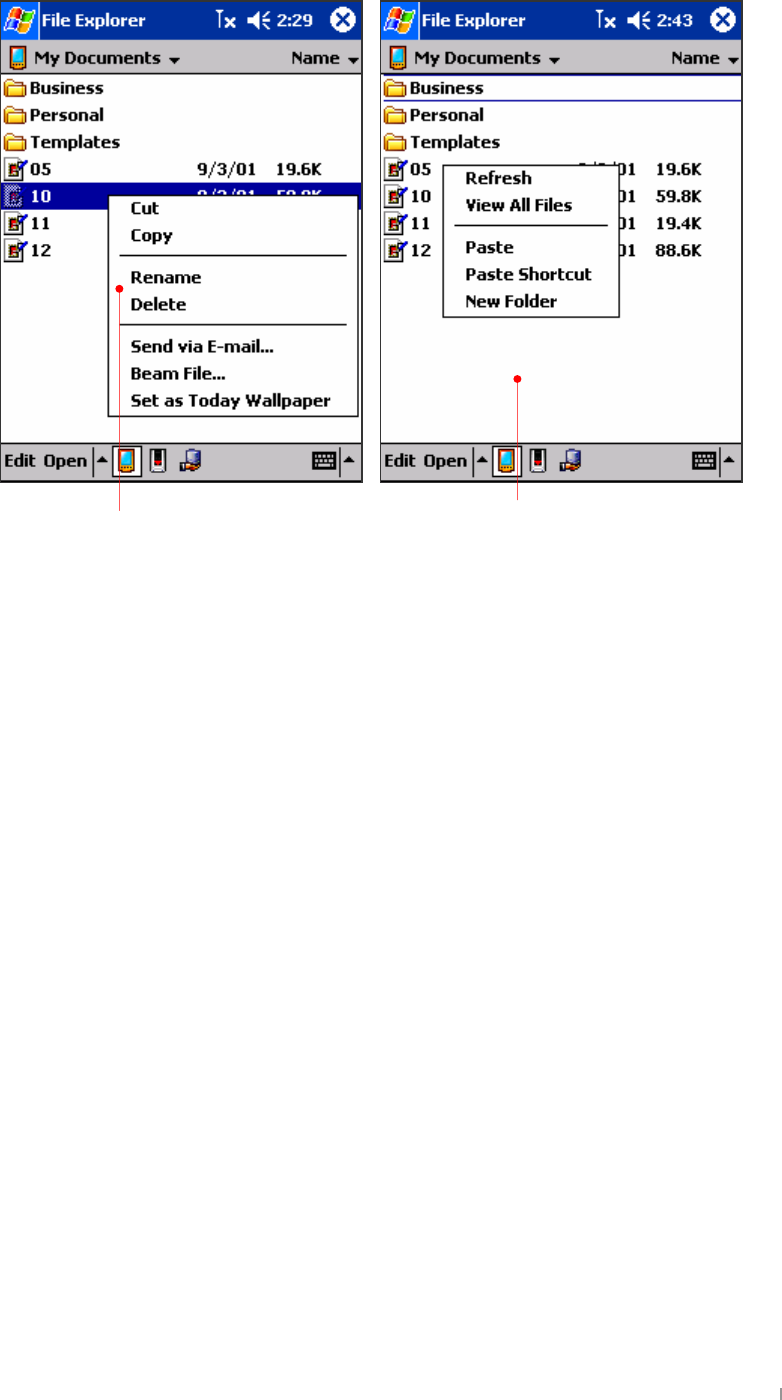
User’s Manual 2-14
Here are two different pop-up menus.
This is pop-up menu that results from tap
and hold the empty space.
This is pop-up menu that results from
tapping and hold a file.
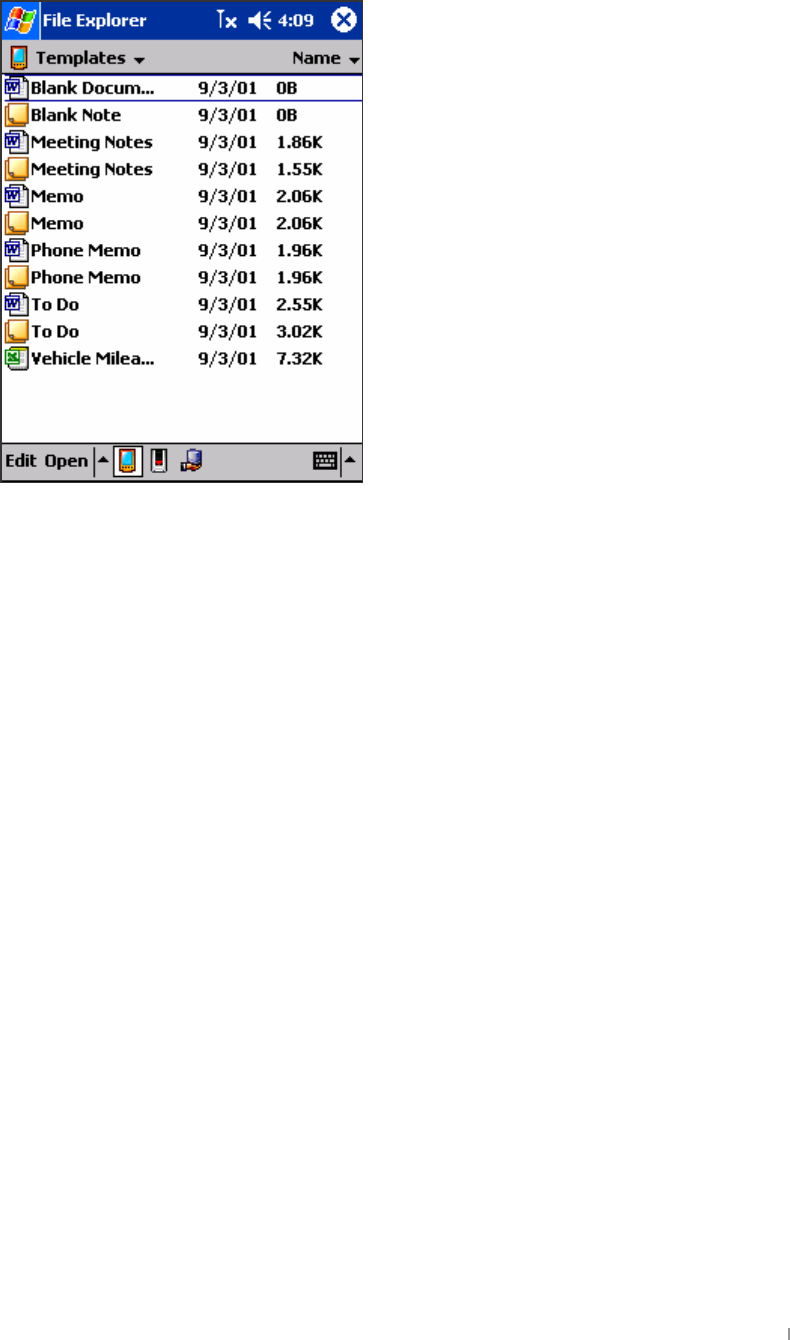
Chapter 2 Getting Started 2-15
⊙ View All Files
Select View All Files on pop-up menu that results from tapping and hold the empty space to
view all files below My Device/My Documents/Templates.
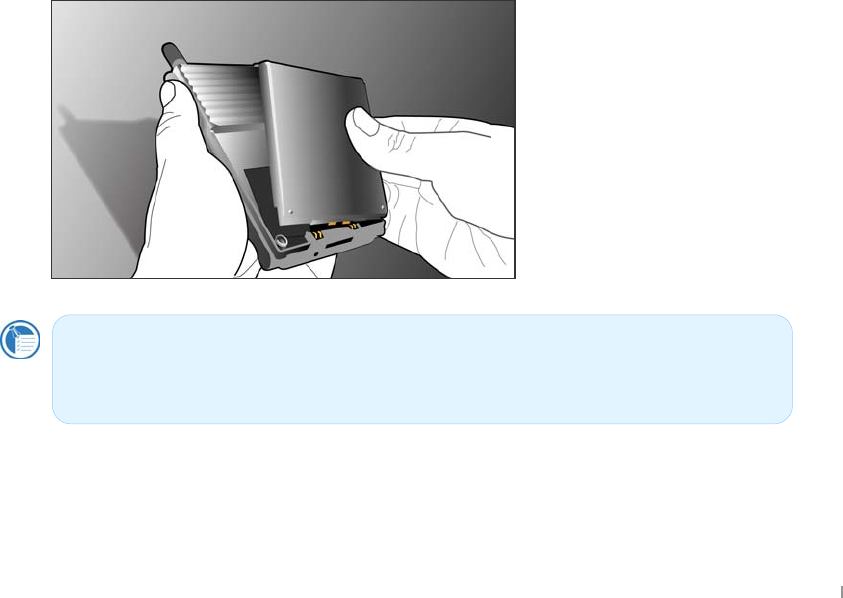
User’s Manual 2-16
Powering up device
Because the data and files you save on your device are stored in RAM, maintaining a
continuous power supply to the device at all times is extremely important. If your device runs
out of power, all information stored in RAM is lost. The preinstalled programs will not be deleted
even if your device suffers a loss of power; however, any custom settings and programs you
have added will be erased.
To safeguard data against loss in the event of power failure, you can save or back up files to NAND Flash
ROM(called “File Store” here). For more information, see “Backing Up and Restoring Data” in chapter 4
and “Managing Memory” in chapter 6.
Your device receives power from two sources: the main battery and the ac power adapter. The
following sections describe these sources. For tips on extending battery life, see “Managing
Power” in chapter 6.
Battery
The lithium-ion battery pack provides power to your device while it is not connected to ac power.
Actual battery life will vary depending on how you use your device. Some functions, such as
listening to music, using the backlight, or operating SD cards, use considerable power and may
reduce this time significantly.
The battery is charged whenever your device is connected to an ac power source—either the
AC adapter or the USB cradle. Usually, it takes 5 hours to charge your battery fully depending
on the battery status. Connect your device to AC power or place it in the cradle when it is not in
use, to ensure that the battery is fully charged when you need to take it with you. When the
battery is fully charged, charging stops automatically; the battery will not overcharge even if it is
left upon being connected to AC power.
When the battery charge is low, a low battery warning is displayed. If you see a
low battery warning message, connect to AC power and charge the battery
immediately to prevent possible data loss.
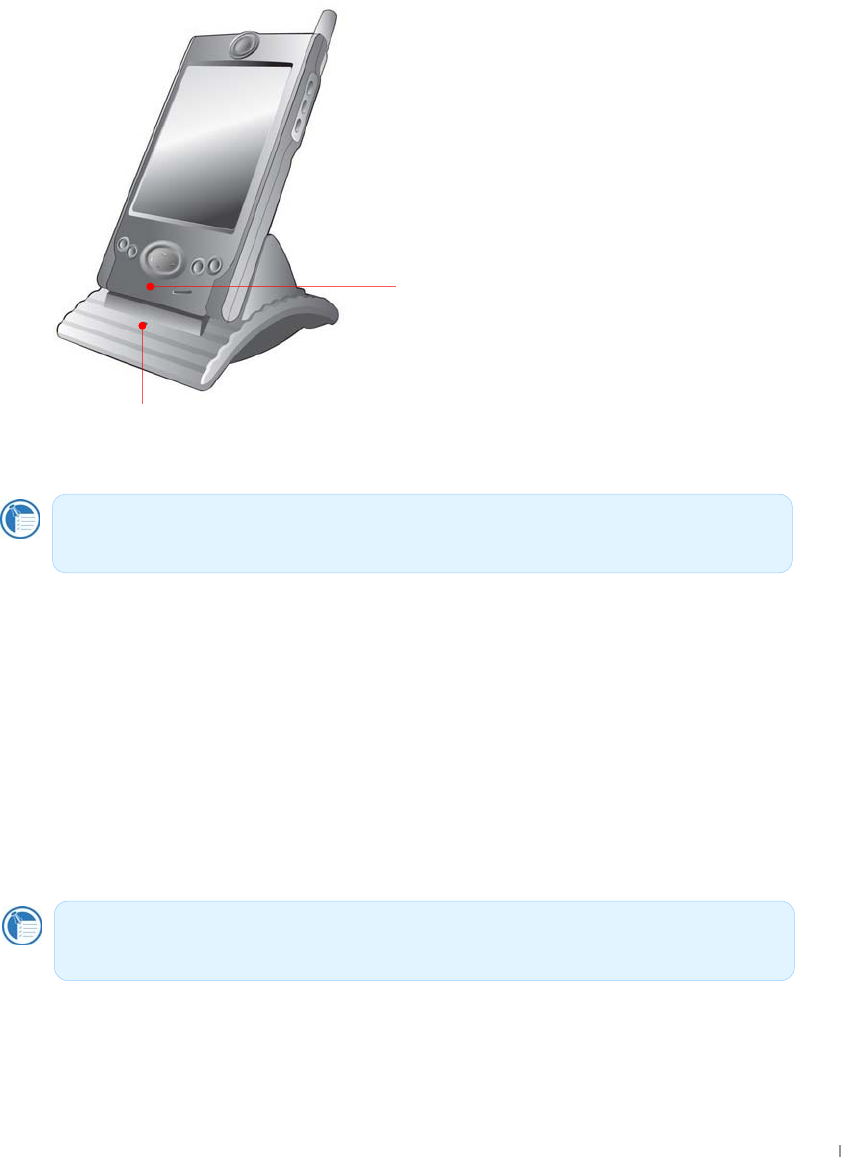
Chapter 2 Getting Started 2-17
AC Power with Cradle
To avoid running out of battery power, you can operate your device on AC power using the
supplied AC adapter. The AC adapter accepts 100 V to 240 V, enabling you to connect to AC
power anywhere in the world. When you travel, you may need adapters to accommodate
different electrical outlets, but the AC adapter will safely convert AC line voltage to the DC
voltage required by your device.
While your device is connected to AC power, the battery is charged automatically. The color of
the LED indicates the status of the battery:
Turning device On and Off
One of the most convenient features of device is “instant on.” With instant on, there is no
waiting for your device to start up or shut down; you can start working immediately by pressing
the power button or one of the hot keys.
When you are finished working, turn off your device by pressing the power button. By default,
your device will turn off automatically after 5 minute of inactivity if it is not connected to an AC
power source. You can use the Power control panel to change these settings.
Red indicates that the battery is charging, and blue indicates that the battery is
fully charged.
You can use the Power control panel to change these settings. On the Start
menu, tap Settings, tap the System tab, and then tap the Power icon.
Red indicates that the battery is charging, and
blue indicates that the battery is fully charged.
This LED shows you the status of extra battery
that may be seated on the back of this cradle.

User’s Manual 2-18
Using the Hardware Buttons
Hot Keys
The hardware buttons on your device (that is, the buttons on the device itself, rather than
buttons or icons that appear on the screen) can each be used to perform several functions,
such as turning on your device or starting a particular program.
The features associated with each button are described below. In addition, most buttons can be
reassigned or configured to start a program that you designate.
The hot keys can be reprogrammed to perform different functions or to open any program or
document you want. The descriptions below refer to the default functions. For more information,
see “Configuring Settings” in chapter 6.
Phone Status LED
Phone service area : Green flashing with a period of 20 seconds.
Not Phone service area : Red on.
When sending call signal, your call is connect : Blue on.
When receiving call signal, bell sound rings : Blue on.
Receiving SMS message : Blue on
When you have the received SMS message unread : Blue flashing.
using wireless internet : Blue on when transferring data, green on when receiving data.
Charging Status LED
Blue indicates that the battery is fully charged.
Red indicates that the battery is charging.
Flashing Red indicates that the temperature of battery is higher than the standard
temperature. It is recommended to seat your device on the cradle again.
Up/Down Control button & Enter button
When your phone program is displayed on the screen but you are not connected to any other
person, press the enter button to display the last phone number you have called recently. At
this time, press the up/down control upward or downward to display the phone numbers you
have recently called. When you find a phone number you want to make a call, just press the
enter button.
While you are communicating with someone through CDMA module, press the up/down control
upward or downward to make volume higher or lower. In other words, if you press the up/down
control upward, then you can hear the voice of your partner louder through your device.
Tasks Calendar Contacts Voice Recording

Chapter 2 Getting Started 2-19
While you are communicating with someone through CDMA module, press the enter button to
end up this call.
Navigation Pad
Press the up/down control to scroll through documents or to highlight items in a list.

User’s Manual 2-20
Caring for Your device
When treated properly, your device will be a reliable personal digital assistant. Follow these tips
to ensure long and trouble-free use of your device:
Protect the screen.
Pressing too hard on the touch screen may damage the screen. Use the stylus to tap the
device screen to avoid scratches or damage to the screen. To clean the screen, use a small
amount of commercial glass cleaner sprayed on a soft cloth. Avoid spraying the screen directly.
Be sure to turn off your device before cleaning the touch screen. If your device is set to power on when
you tap the screen, change this setting before you clean the touch screen.
Do not drop your device.
Dropping your device can cause damage to delicate components such as the screen.
Accidental damage is not covered under the warranty.
Avoid radiated interference.
Radiated interference from other electronic equipment may affect the appearance of the display
of your device. Removing the source of the interference will return the display to normal.
Avoid high temperatures.
Your device is designed to operate at temperatures between -20 to 60 ºC (-4 to 140 ºF). Using
the device at temperatures outside this range may damage the unit or result in loss of data. Be
especially careful not to leave your device in direct sunlight or in a car where temperatures can
rise to harmful levels.

Chapter 3 Pocket PC Overview 3-1
⊙ In this chapter you have several options for entering new information:
- Block Recognizer
- Keyboard
- Letter Recognizer
- Transcriber
Chapter 3
Using Input Panel
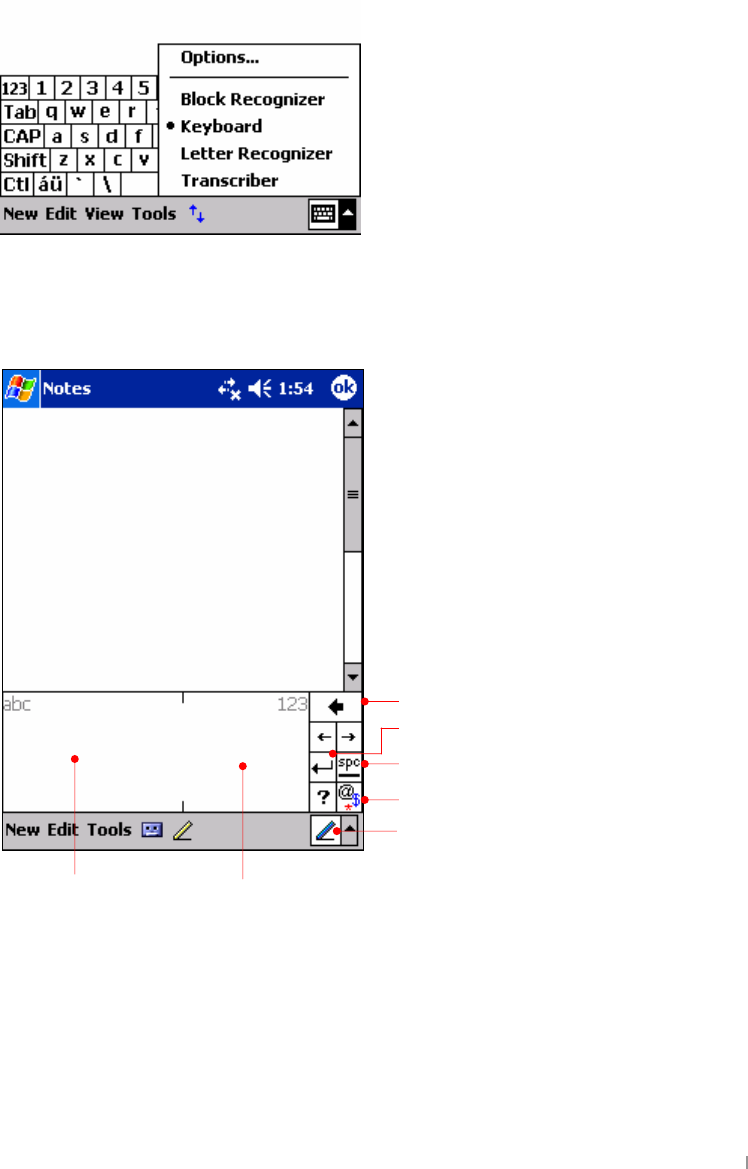
User’s Manual 3-2
Using the Input Panel
Use the Input panel to enter information in any program on your device. You can write
using keyboard, Block Recognizer, Letter Recognizer, or Transcriber. In any case, the
characters appear as typed text on the screen.
To show or hide the Input panel, tap the Input panel button. Tap the arrow next to the
Input Panel button to see your choice.
Block Recognizer
⊙ Using Block Recognizer
1. Tap the arrow next to the Input panel button, and then tap Block Recognizer.
2. Write a letter in the box.
When you write a letter, it is converted to typed text that appears on the screen. For
specific instructions on using Block Recognizer, open Block Recognizer, and then
tap the question mark next to the writing area.
Punctuation & symbol
S
p
ace
English entry area Number entry area
Return
Back space
Input Panel for Block Recognizer
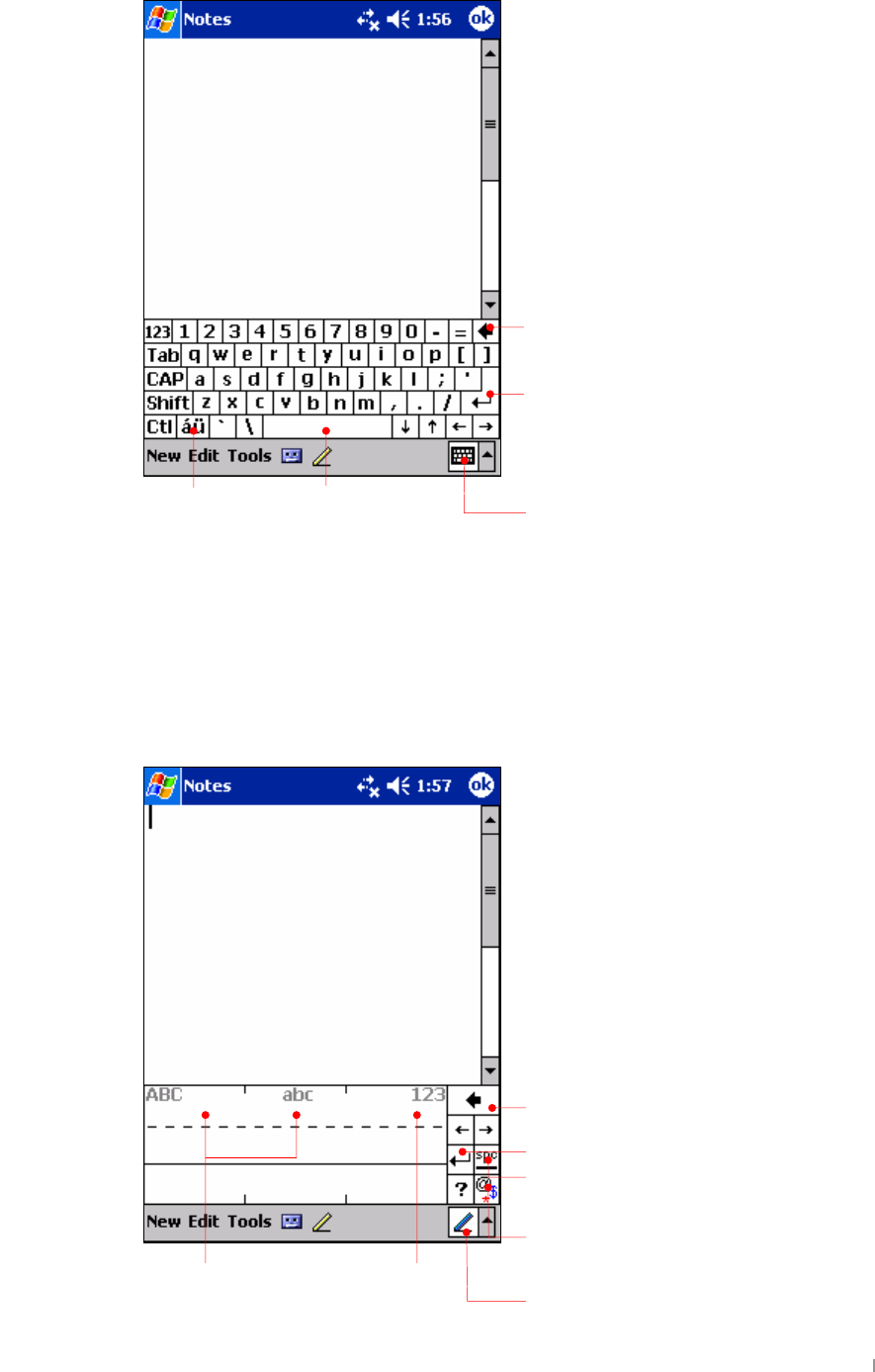
Chapter 3 Pocket PC Overview 3-3
Keyboard
⊙ To type with the soft keyboard
1. Tap the arrow next to the Input panel button, and then tap Keyboard.
2. On the keyboard that is displayed, tap the keys with your stylus.
Letter Recognizer
Back space
Return
Space Input Panel for Keyboard
Back space
Return
Space
Punctuation & symbol entry
Number entry areaEnglish upper/lower case entry area
Input Panel for Letter Recognizer
Punctuation entry
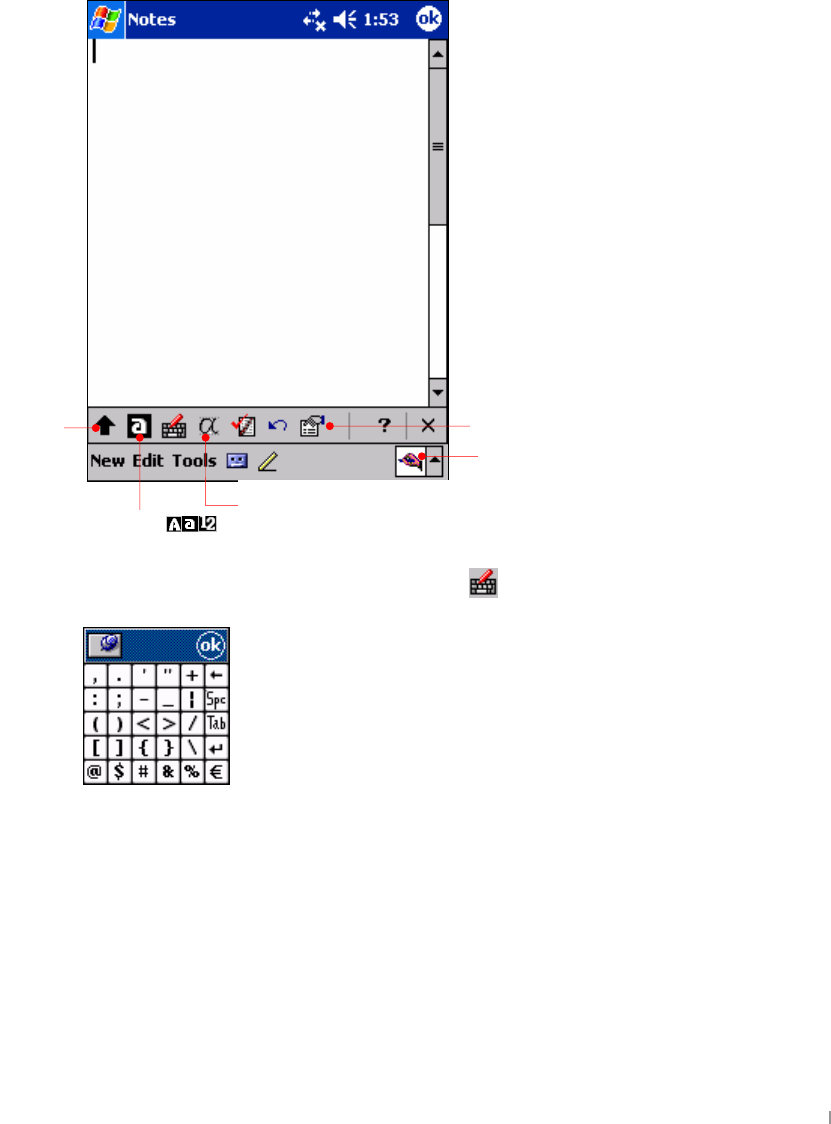
User’s Manual 3-4
⊙ Using Letter Recognizer
1. Tap the arrow next to the Input panel button, and then tap Letter Recognizer.
2. Write a letter in the box.
When you write a letter, it is converted to typed text that appears on the screen. For
specific instructions on using Letter Recognizer, open Letter Recognizer and then
tap the question mark next to the writing area.
Transcriber
Tap the punctuation & symbol entry button ( ) to have the next window displayed.
Input Panel for Transcriber
Arrow
Take turns selecting .
Settings
How to make strokes
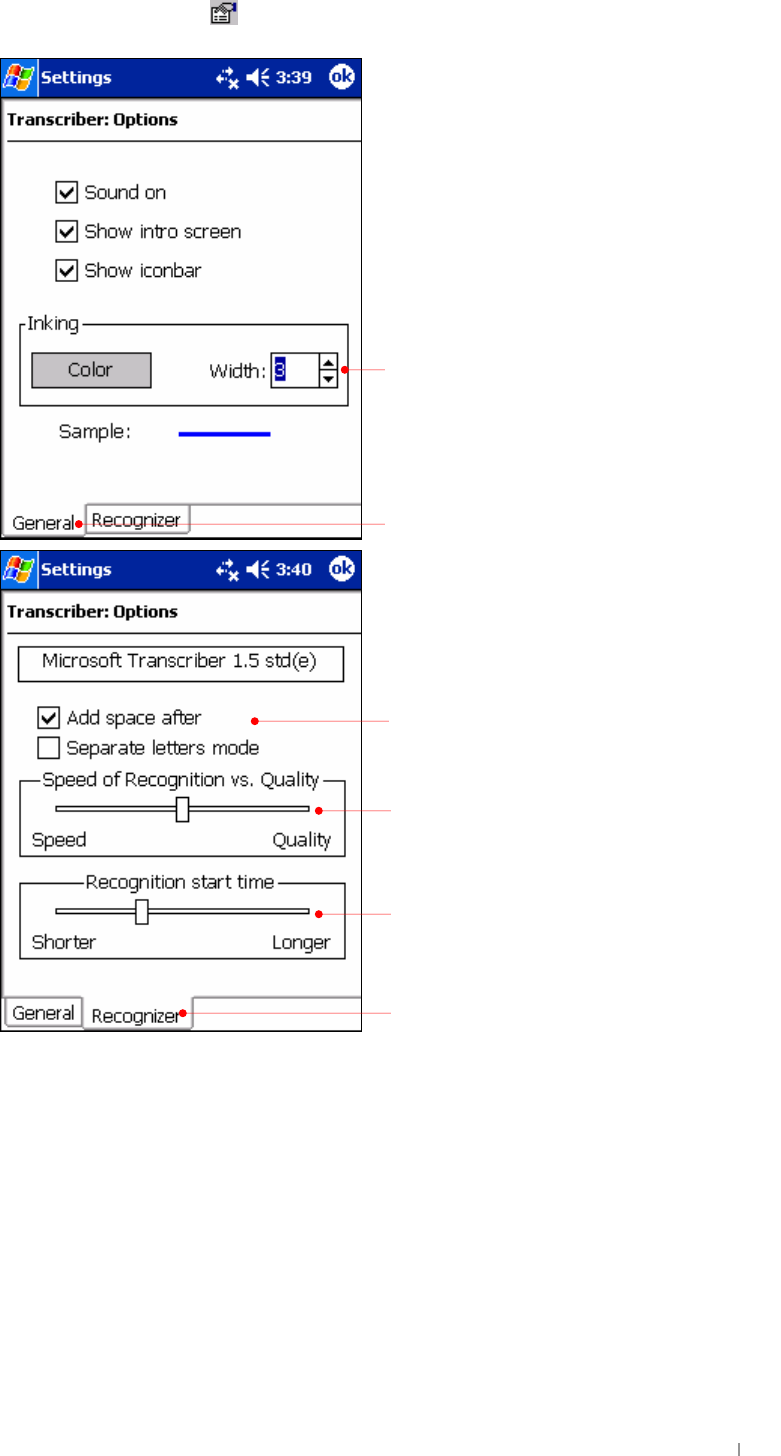
Chapter 3 Pocket PC Overview 3-5
Tap the Settings button( ) to have the next window displayed.
Select the width of pen and see
sample displayed below
Add space after entry
General tab of Settings
Move the slide to right/left side to select speed
and quality.
Move the slide to right/left side to select
recognition start time.
Reco
g
nizer tab of Settin
g
s
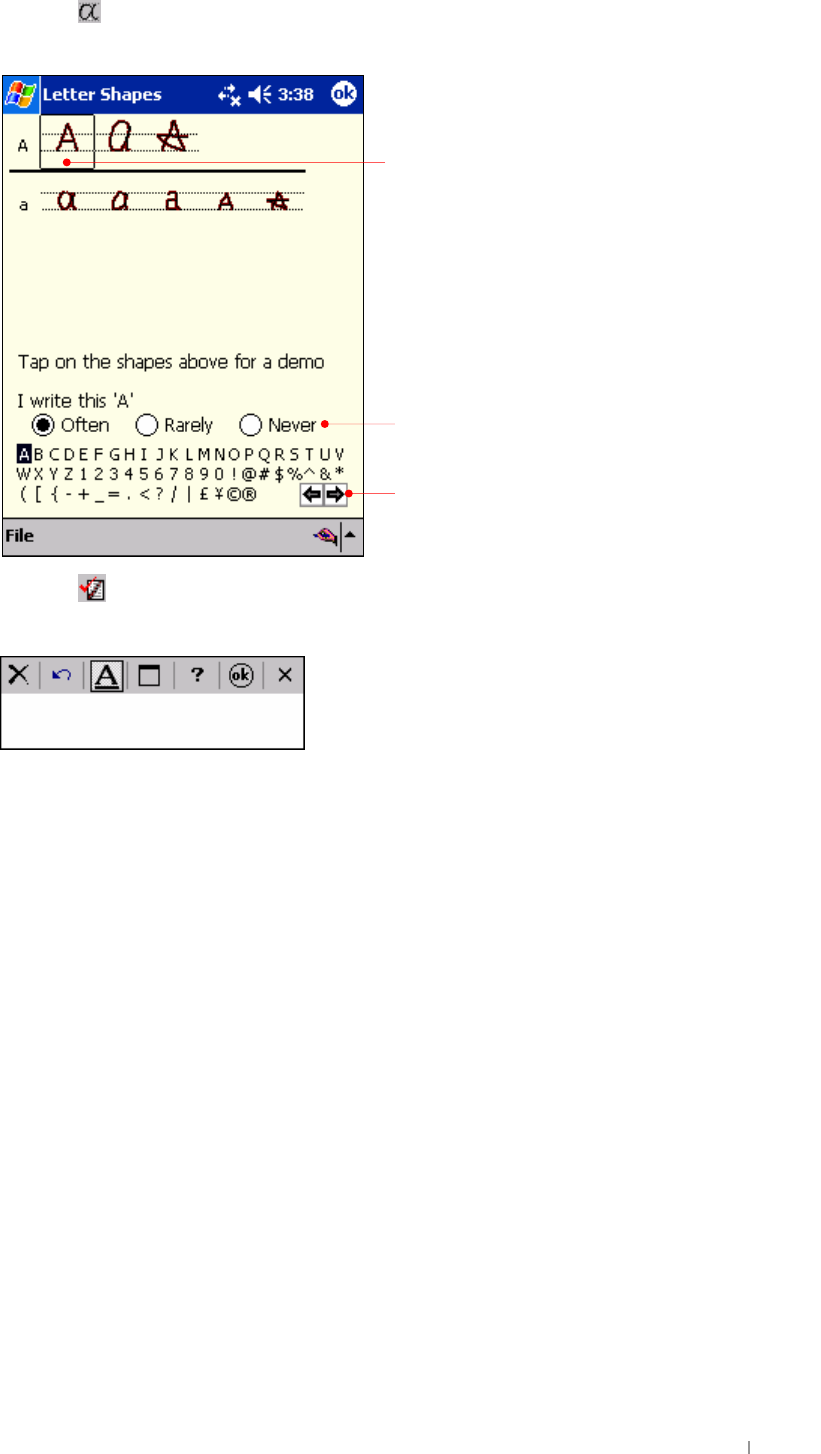
User’s Manual 3-6
Tap the button to refer to how to make strokes.
Tap the button to have this window displayed.
With Transcriber you can write anywhere on the screen using the stylus just as you
would on paper. Unlike Letter Recognizer and Block Recognizer, you can write a
sentence or more of information; then, you pause and let Transcriber change the written
characters to typed characters.
⊙ To type with Transcriber
1. Tap the arrow next to the Input panel button, and then tap Transcriber.
2. Write anywhere on the screen.
For specific instructions on using Transcriber, open Transcriber and then tap the
question mark in the lower-right corner of the screen.
Selected character
Select one of 3 options according to how often you use
the selected shape.
Tap these arrows to see more choices.

Chapter 4 Connecting to Desktop PC 4-1
To get the most from your device, you will want to connect to your desktop or notebook
PC. This chapter describes how to establish the connection between your device and
your desktop PC, and how to synchronize and transfer files between your device and
your desktop (or any PC that has Microsoft ActiveSync installed).
⊙ In this chapter, you will learn the followings :
- Install Microsoft ActiveSync and establish a partnership
- Full Backup & Restore using Backup/Restore of ActiveSync
- How to install programs using ActiveSync
- Connecting to Device
Chapter 4
Connecting to Desktop
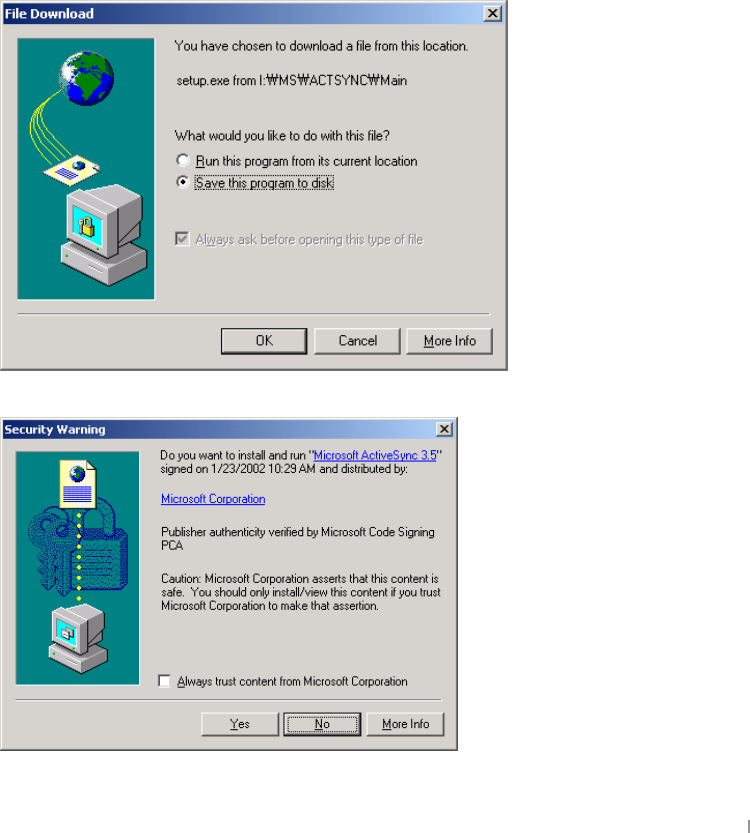
User’s Manual 4-2
Install Microsoft ActiveSync and establish a partnership
To get the most from your device, you have to connect to your desktop or notebook PC.
Microsoft ActiveSync enables you to synchronize the information on your desktop PC
with the information on your device. In addition, you can back up data from your device
to your desktop PC and restore this data to your device, and copy files between your
device and desktop PC. Before you begin synchronization, install ActiveSync on your
desktop PC from the provided Companion CD. By the way, ActiveSync is already
installed on your device.
First of all, insert Companion CD into the CD-ROM of your desktop PC and the CD-ROM
will begin automatically. Then, select Start and select Install ActiveSync 3.6. Just follow
the Installation Wizard that automatically begins to install ActiveSync 3.6.
After installation is complete, the ActiveSync Setup Wizard helps you connect your
device to your desktop PC, establish a partnership so you can synchronize information
between your device and your desktop computer, and customize your synchronization
settings.
This is an explanation on how to install ActiveSync 3.6, based on Windows 2000
Professional, so you may have a little bit different screen on the different OS versions
from below.
Select Run this program from its current location to install without saving.
Click Yes to move to the next screen.
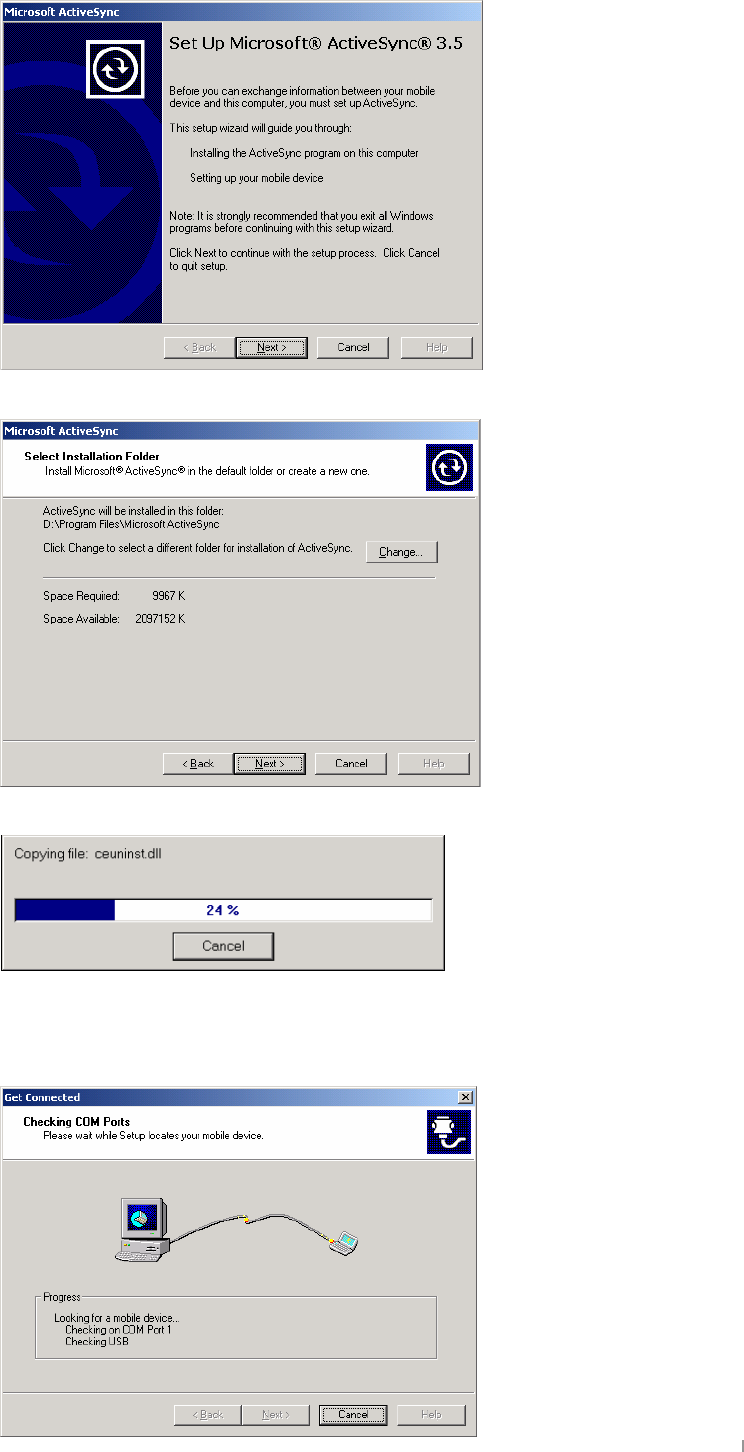
Chapter 4 Connecting to Desktop PC 4-3
Click Next.
Click Next.
When the process becomes 100%, automatically it will go to the next screen.
Connect USB port to desktop PC and the power cable to cradle. Then seat your device
into USB cradle.
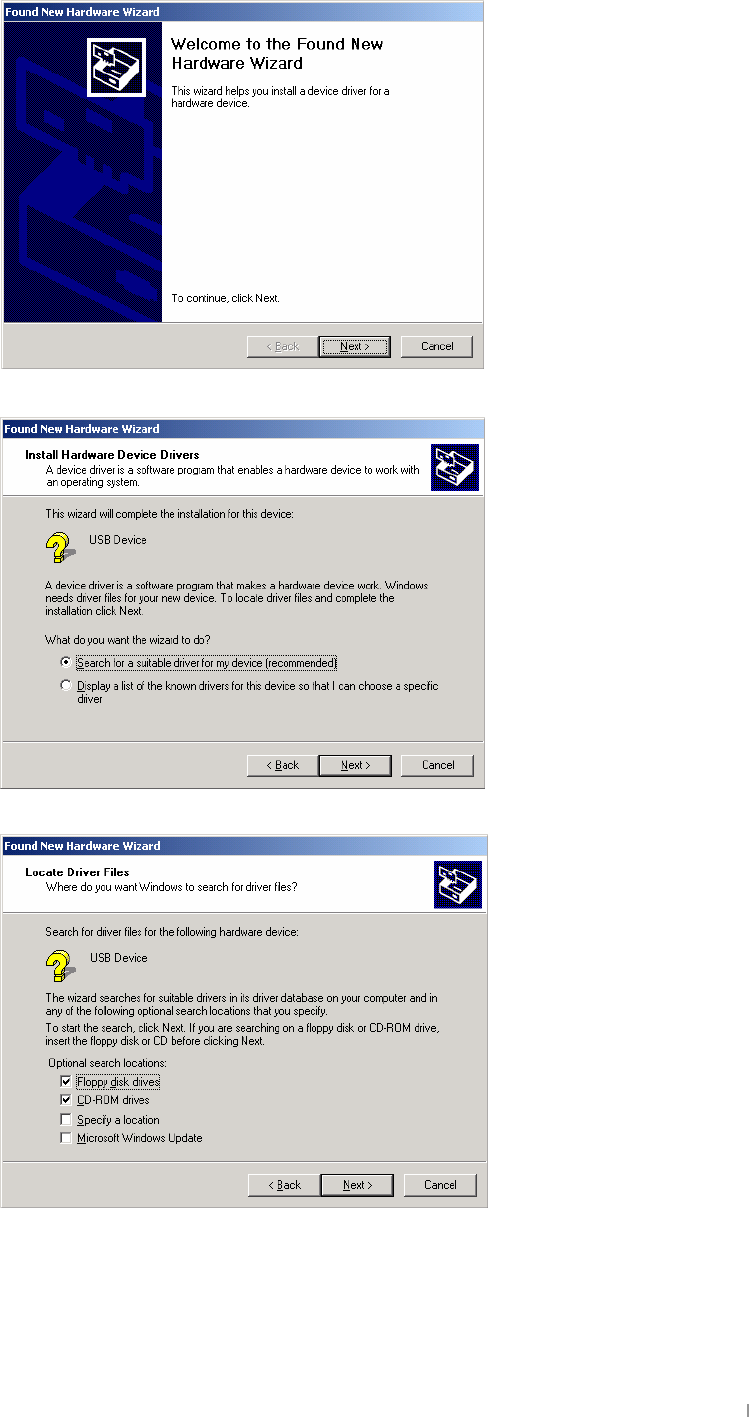
User’s Manual 4-4
A wizard of finding a new hardware will begin automatically as below.
Click Next.
Click Next.
Select CD-ROM drive and click Next.
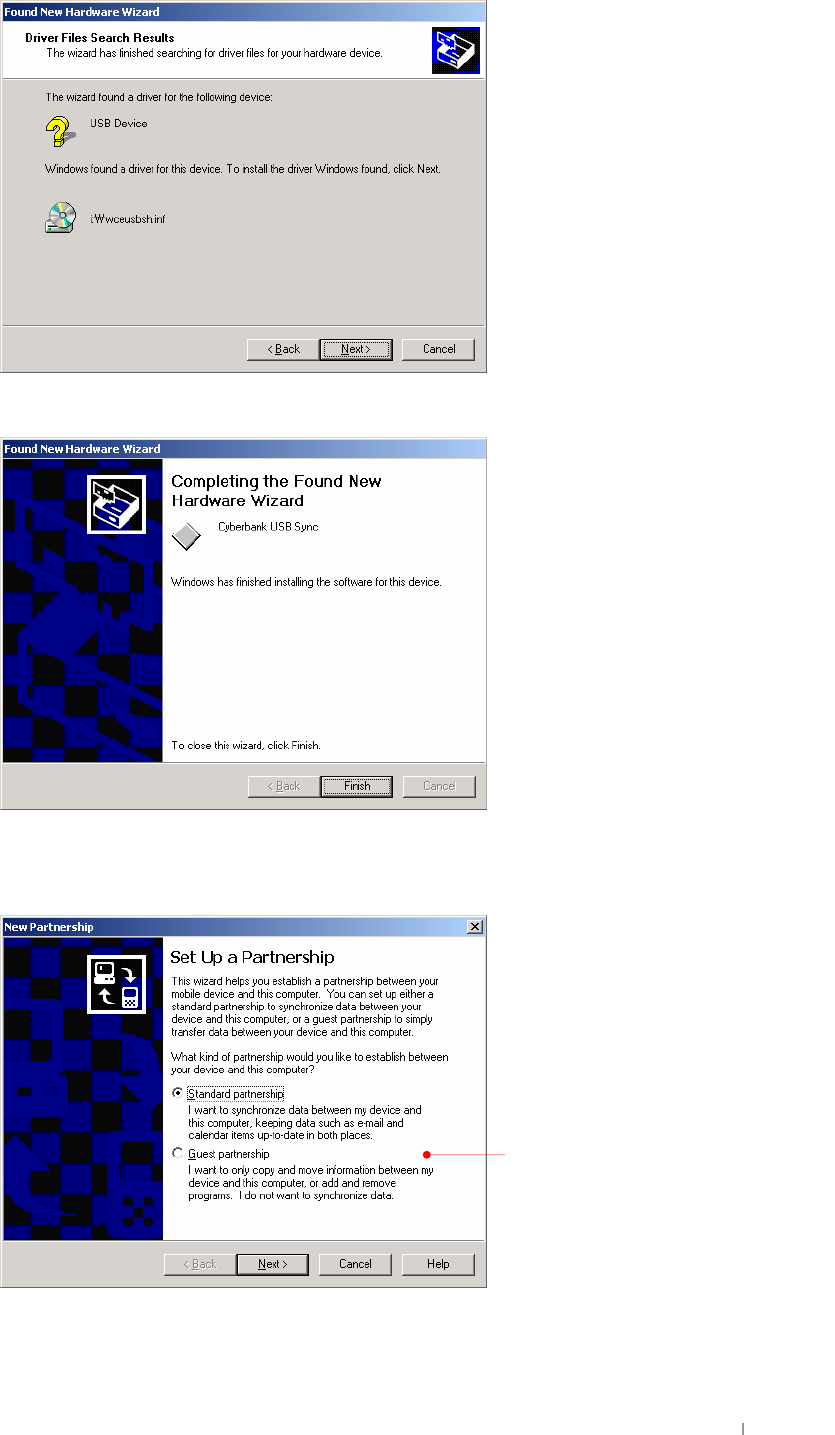
Chapter 4 Connecting to Desktop PC 4-5
Click Next.
Click Finish and automatically the synchronization process will begin. And then the
following processes will appear on your desktop PC.
Instead of synchronizing, you may set up your device as guest. Even though a guest,
you may transfer files and data between your device and your desktop PC.
When you perform hard reset or re-establish a new partnership after deleting the existing
Now, you are ready to synchronize
between your device and desktop PC, it
may take a little long time to finish
synchronization. When it is in a state of
Guest, find files you want by pressing the
Explore button of toolbar.
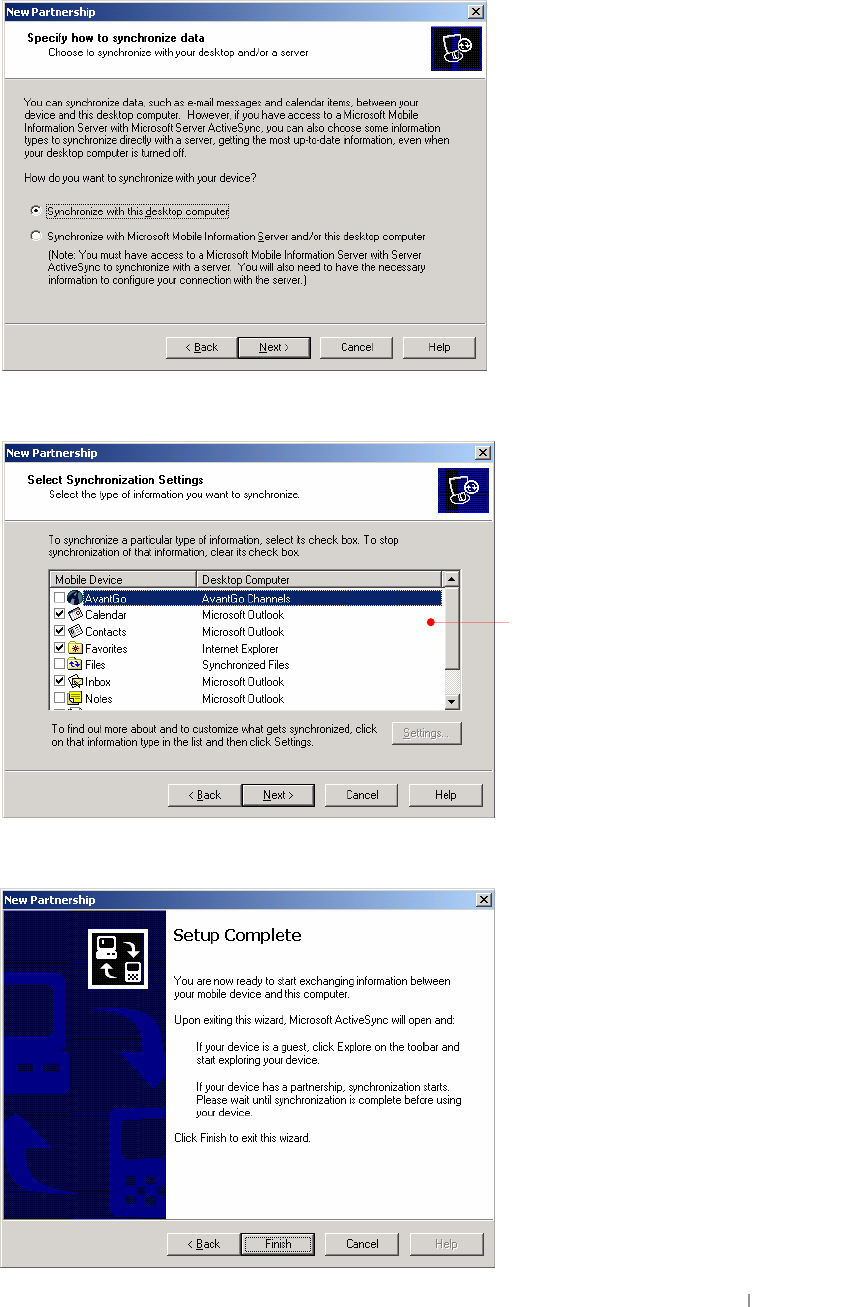
User’s Manual 4-6
partnership, you can select one of the options.
A desktop PC can establish partnerships with several devices while one device can
establish partnerships with up to two desktop PCs. However, you cannot synchronize
two devices with one desktop PC at the same time.
Click Next.
Click Next.
Select any items you want to synchronize
and otherwise, deselect the others.
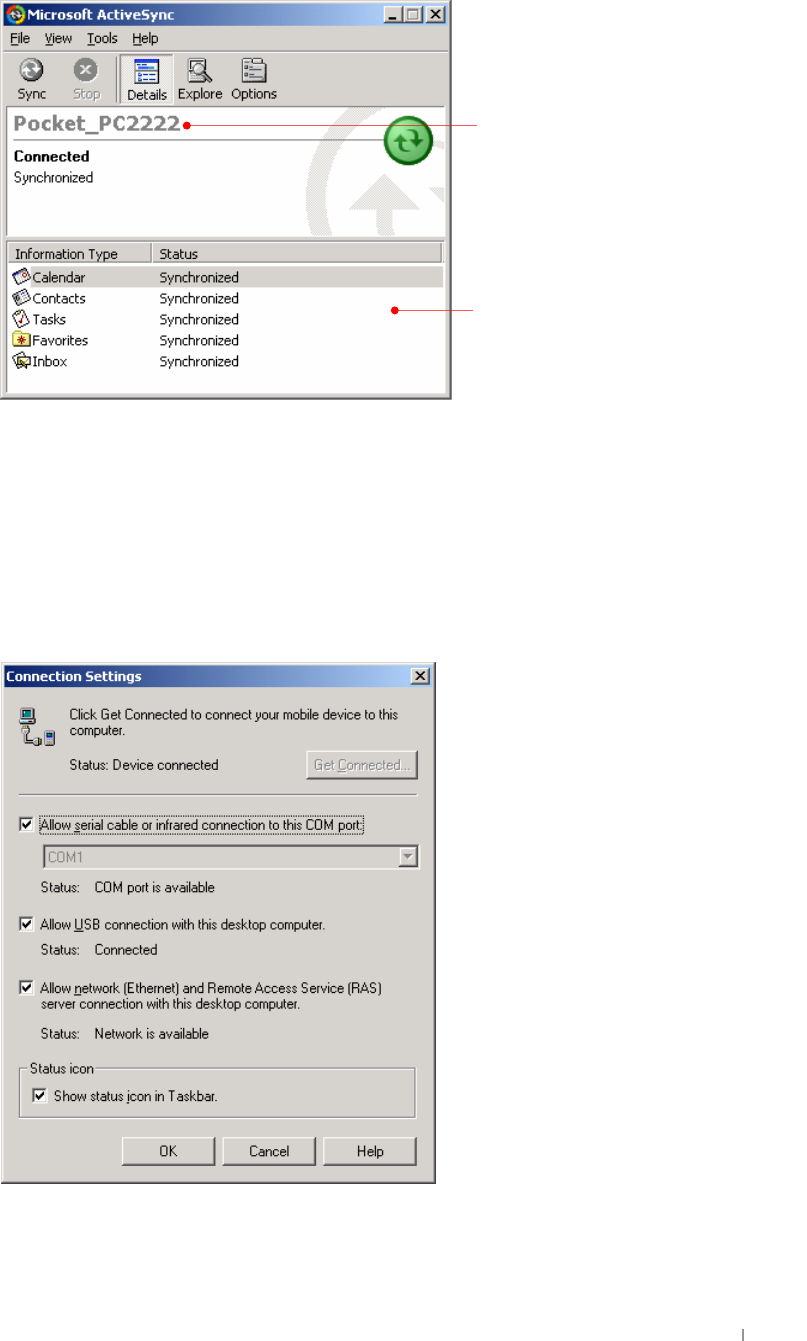
Chapter 4 Connecting to Desktop PC 4-7
Click Finish. Now, you are ready to establish a new partnership.
You will have the Microsoft ActiveSync screen as shown below.
When you perform hard reset on your device, you need to change the partnership name
that is preset as Pocket_PC. (for example : Pocket_PC1, Pocket_PC2, Pocket_PC3,
Pocket_PC4)
When you have some difficulties synchronizing your device with your desktop PC, click
the Connection Settings on the File menu to have the Connection Settings screen
displayed as below.
This is the partnership name that is
established with your desktop PC through
ActiveS
y
nc.
These are the items you have selected for
synchronizing with desktop PC.
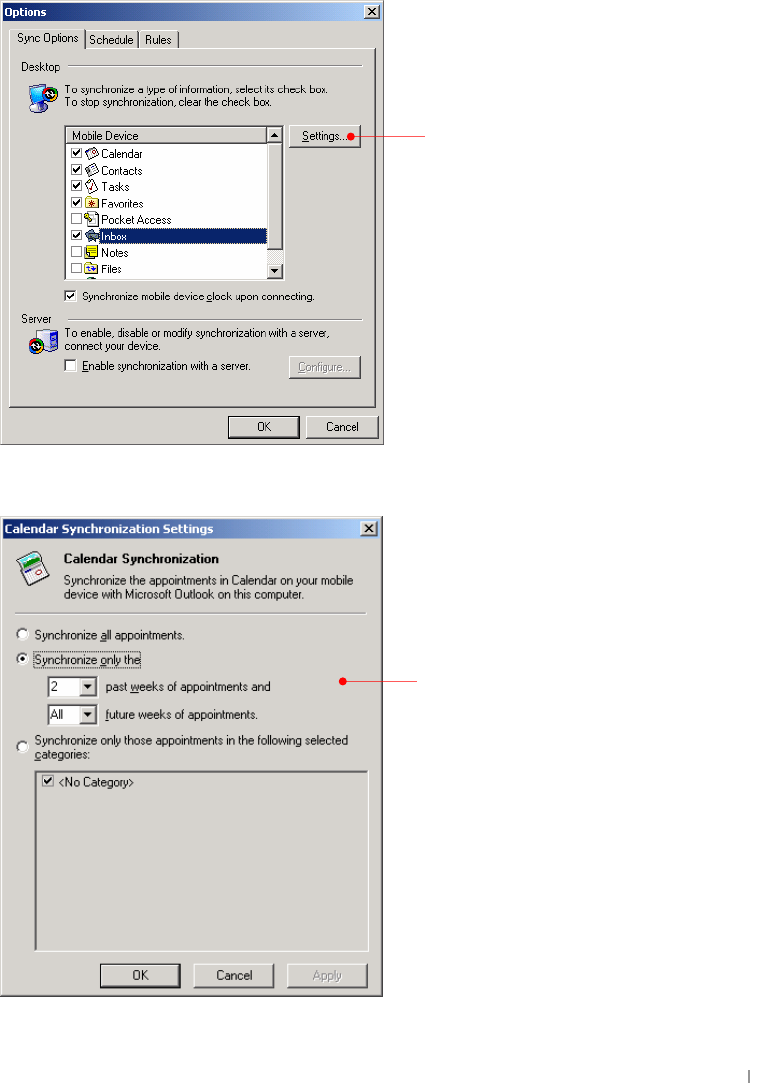
User’s Manual 4-8
Synchronizing Data
Synchronization compares the data on your device with your desktop PC and updates both
computers with the most recent information. For example, you can synchronize Microsoft
Word and Microsoft Excel files between your device and desktop PC. Your files are
automatically converted to the correct format. And you can synchronize e-mail messages in
Inbox on your device with e-mail messages in Microsoft Outlook on your desktop PC. And
you can keep your Pocket Outlook Contacts, Calendar, and Tasks databases up-to-dated by
synchronizing your device with Microsoft Outlook data on your desktop PC. Use the
ActiveSync options to select which information should be synchronized and to control how
much data is synchronized. By default, ActiveSync does not automatically synchronize all
types of information.
Select Calendar and click the Settings button.
Tap Settings to customize the selected
item.
Select any option you want to customize
Pocket Calendar during the synchronizations.
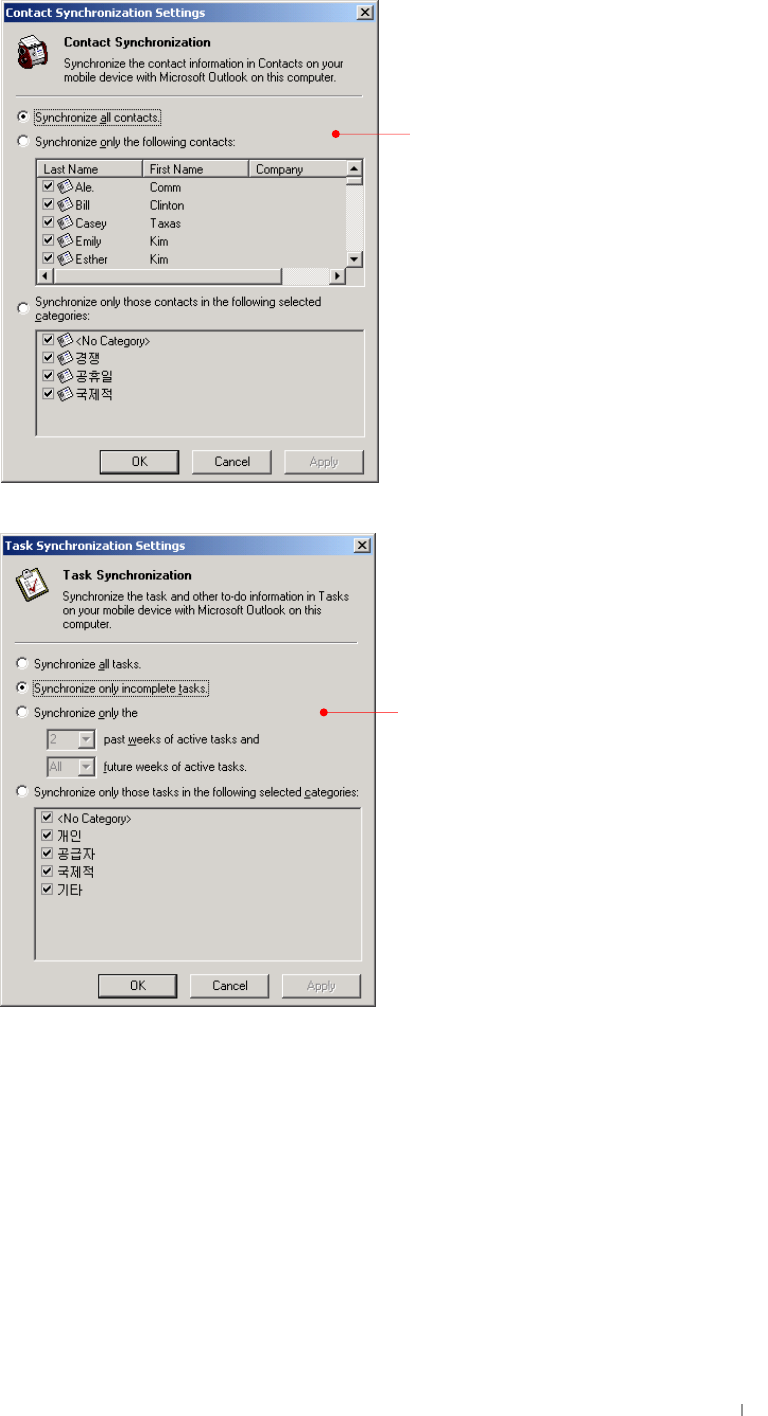
Chapter 4 Connecting to Desktop PC 4-9
Select Contacts and click the Settings button.
Select Tasks and click the Settings button.
Select any option you want to customize
Pocket Contacts during the synchronizations.
Select any option you want to customize
Pocket Tasks during the synchronizations.
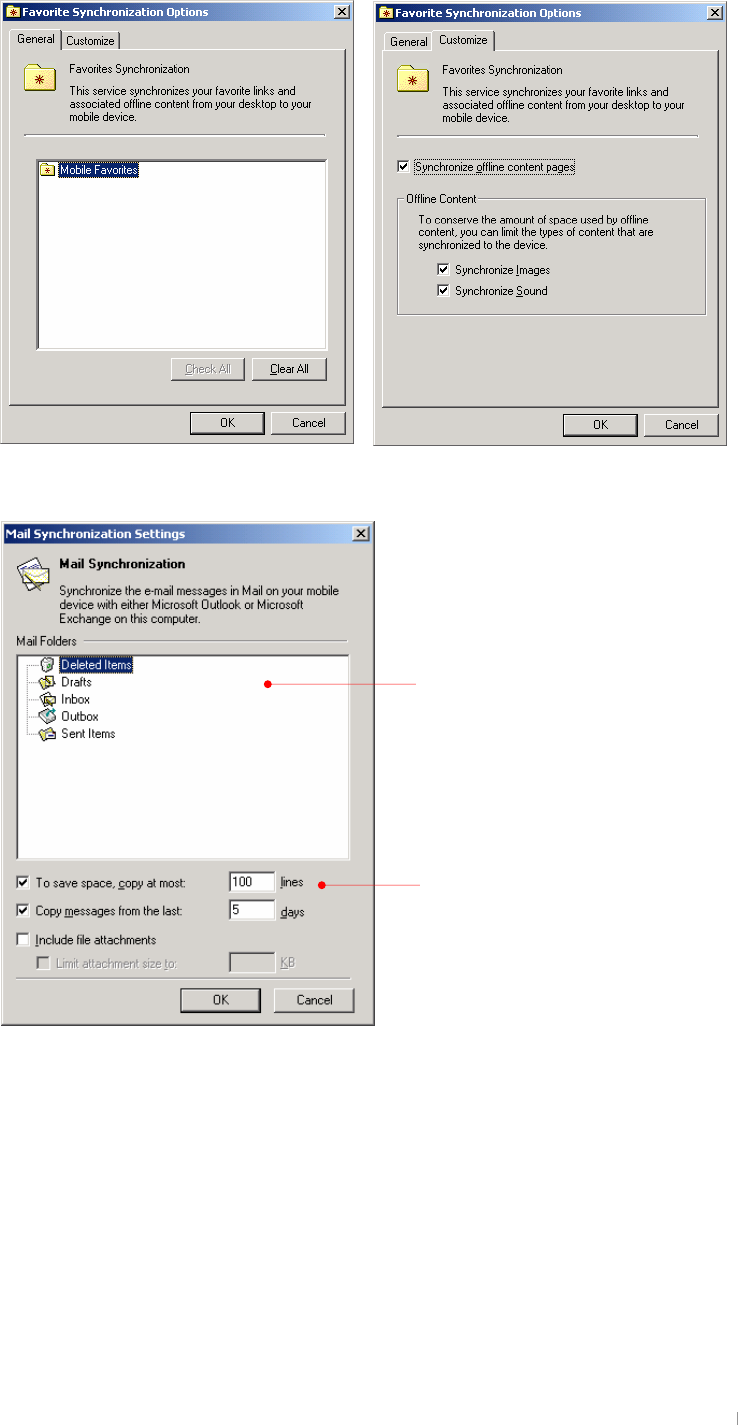
User’s Manual 4-10
Select Favorites and click the Settings button.
Select Inbox and click the Settings button.
You have to select the folder you have
made to be synchronized in the Inbox
program.
In this example, while synchronizing, it is
set as copy at most 100 lines to save
space, copy messages from the last 5
days.
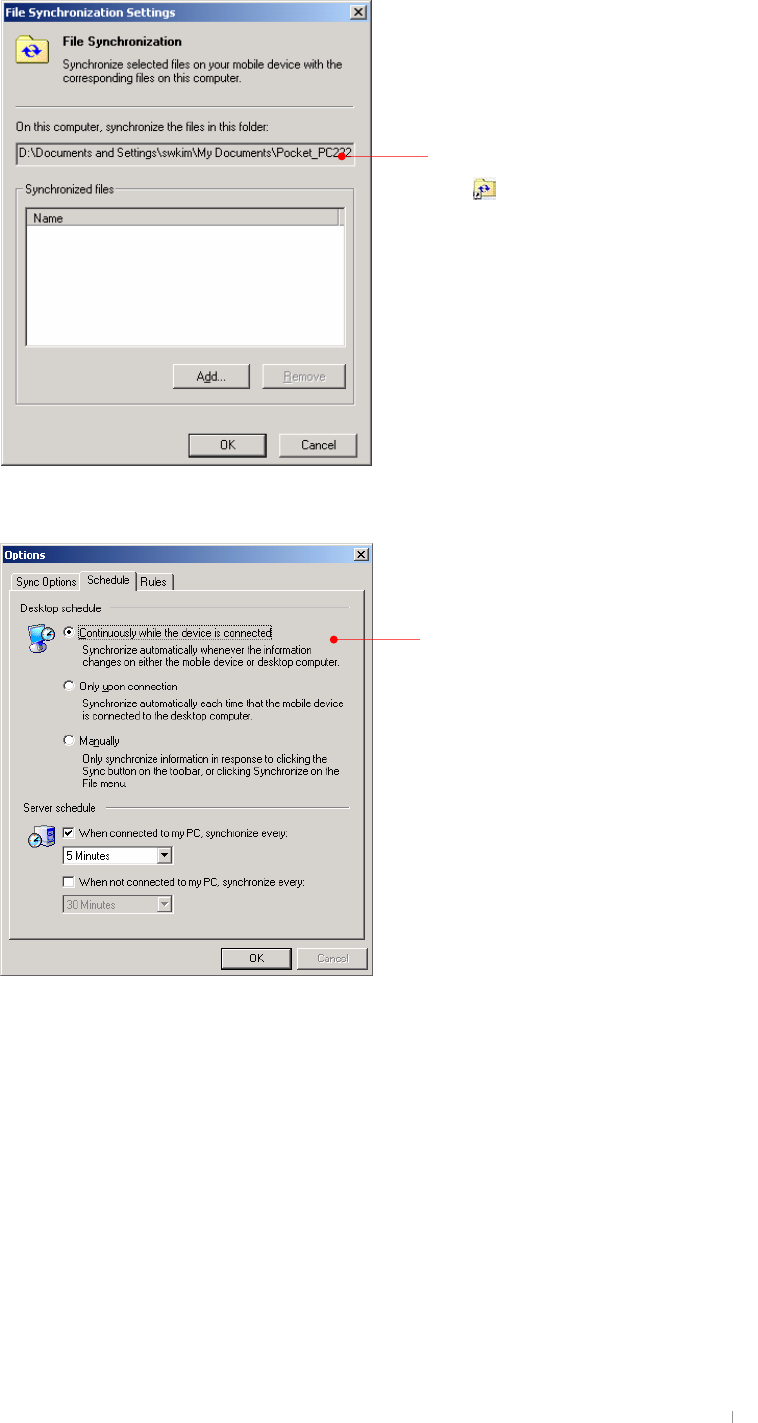
Chapter 4 Connecting to Desktop PC 4-11
Select Files and click the Settings button.
After you customized ActiveSync and completed the first synchronization, you can control
when synchronization occurs by selecting a synchronization mode.
Select one of the 3 options: continuously
while the device is connected, only upon
connection and manuall
y
.
This is the folder that includes the file
synchronized with your desktop PC. You
will find the Shortcut to the Files
icon( )on your desktop PC.
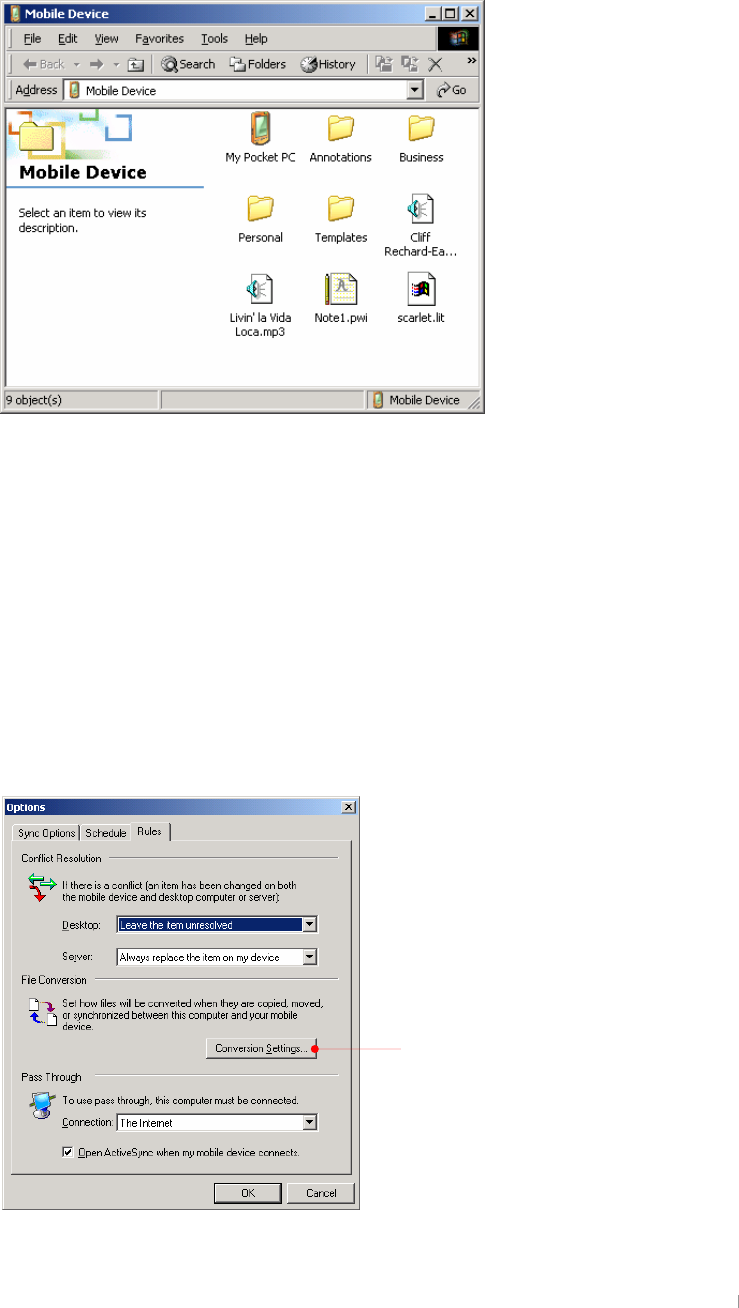
User’s Manual 4-12
Copy, Paste and transfer files
Select the file(s) you want to copy and select Copy on the Edit menu or select Copy on the
pop-up menu. For pasting file(s), select the Explore button on the Microsoft ActiveSync
screen of your desktop PC to have the Mobile Device screen displayed as below :
First, select the folder you want to paste and select Paste on the Edit menu or select Paste
on the pop-up menu.
However, when you transfer file(s) between desktop PC and your device, files created on
your desktop PC may automatically need to be converted before you can use them on your
device, and also files created on your device may automatically need to be converted before
you can use them on your desktop PC. However, when you work with software such as
ClearVue Presentations or ClearVue Image, files should not be converted to the different
format. In other words, those software use the format identical to the corresponding
software of your desktop PC. That’s why we need to change the settings of converting
file format when files don’t need to be converted before you can use them on your
device.
You can change the settings as follows :
Tap the Conversion Settings to change
the options for conversion between
desktop PC and your device while
copying, pasting and synchronizing.
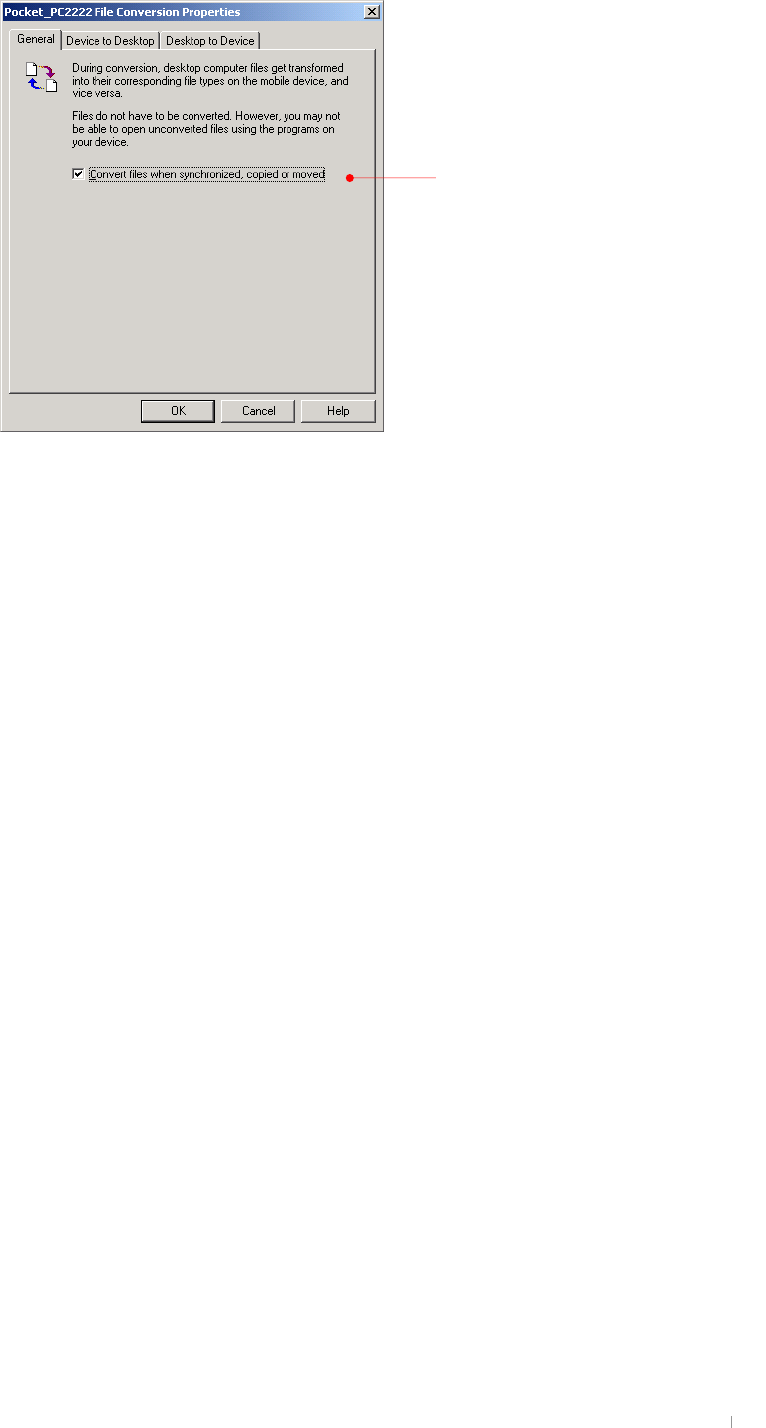
Chapter 4 Connecting to Desktop PC 4-13
Select Conversion Settings.
Deselect this option box not to change the
file format.
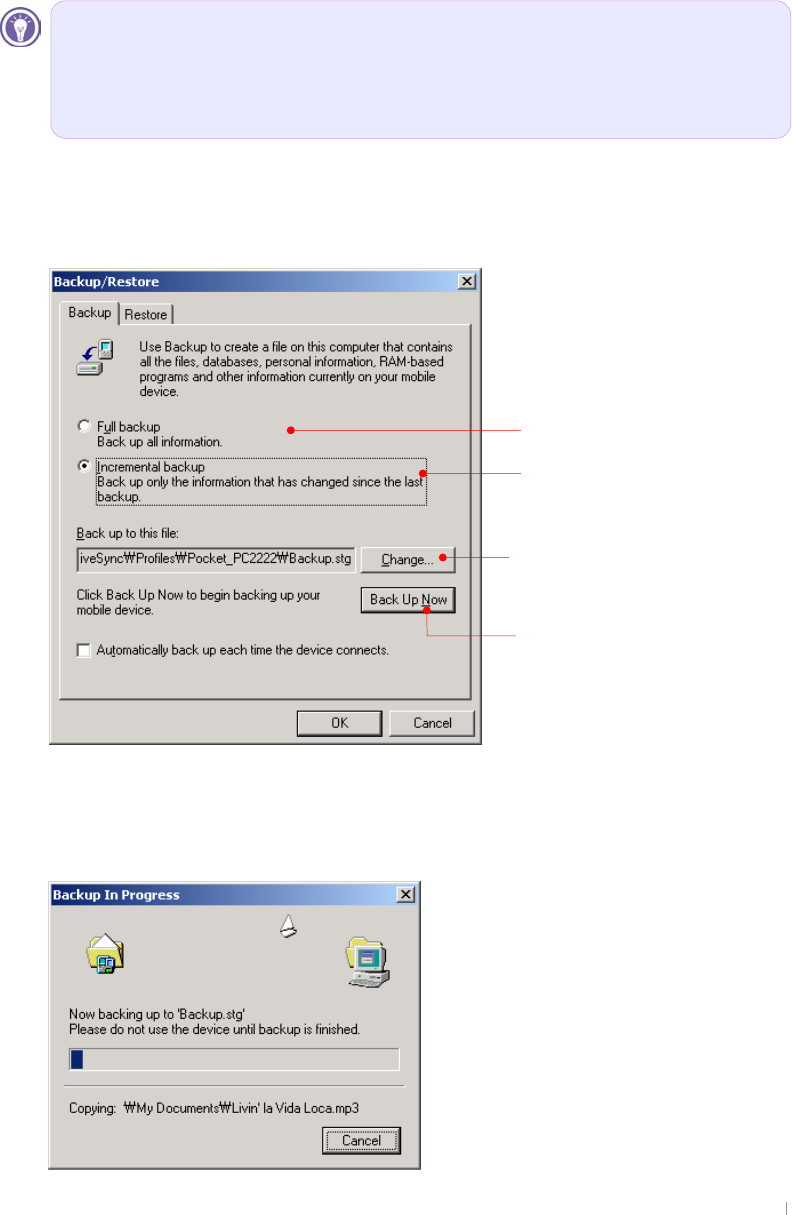
User’s Manual 4-14
Full Backup & Restore using Backup/Restore of ActiveSync
You can back up files, database, PIM data and programs installed in RAM to your
desktop PC using Microsoft ActiveSync, and restore them when needed.
Backup can either be performed automatically when your device is connected to your
desktop PC, or manually whenever needed. Also, you can back up updated or new data
only or choose to back up all data.
Backup
1. Connect your device to desktop PC.
2. Tap Backup/Restore on the Tools menu of the ActiveSync screen.
3. Select “Full backup” or “Incremental backup” according to your needs.
4. You may need the backup file name and the folder when restoring your backup file.
Tap the Change button to confirm the folder.
5. Tap the Back Up Now button to begin.
Tap Back Up Now to begin.
Tap Change to change backup
name.
Full backup
Incremental backup.
Automatic backup is only possible when a Partnership is established with a
desktop PC. Only a manual backup is possible when the partnership is
established as Guest. For more information on Backup/Restoring to and from a
desktop PC, see Microsoft ActiveSync Help.
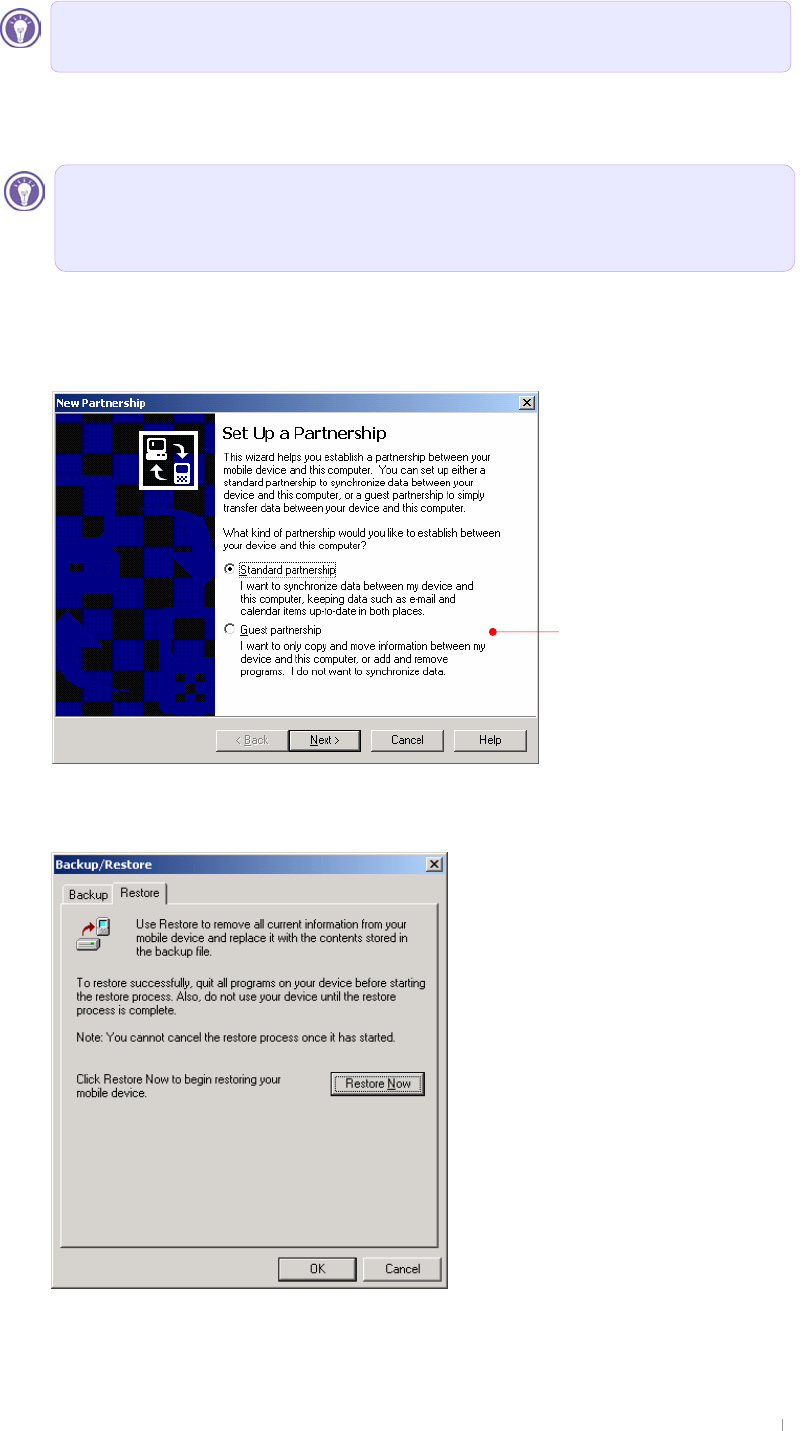
Chapter 4 Connecting to Desktop PC 4-15
Restore
1. Connect your device to desktop PC.
2. Close all programs running on your device.
3. Establish a partnership as Guest.
4. Tap Backup/Restore on the Tools menu of the ActiveSync screen, and select the
Restore tab.
Do not remove your device from the cradle or disconnect the USB cable during
backup.
As newly installed programs or new files created on your device since your last
backup will be lost after restore, you should move them to your desktop PC or to
File Store (NAND Flash memory) before you restore data.
Select this options box to set
up your device as guest.
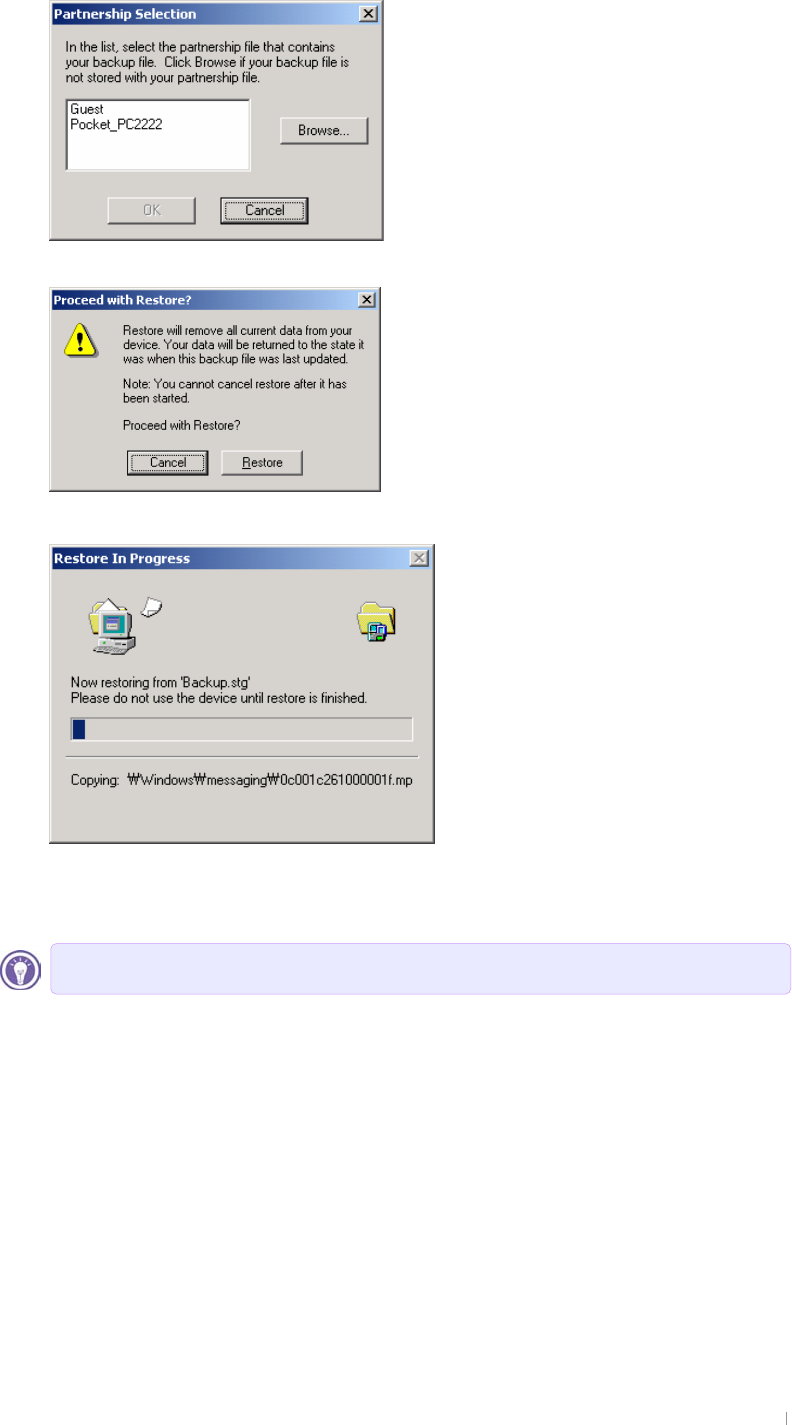
User’s Manual 4-16
5. Tap the Restore Now button.
6. Select the backup file you want to restore and select OK to begin.
7. Click Restore to begin the restore process.
8. When completed, perform soft Reset on your device with your stylus and seat your
device on your cradle to synchronize.
Do not use your device until Restore is completed.

Chapter 4 Connecting to Desktop PC 4-17
How to install programs using ActiveSync
Using Setup.exe or Install.exe
1. Download the program to your desktop computer (or insert the CD or disk that
contains the program into your desktop computer).
2. Connect your device to your desktop PC.
3. If the program includes an installer program (typically named Setup.exe or Install.exe),
double-click the installer program on the desktop PC. The installer program copies the
necessary files to your device.
Using cabinet (*.cab) file
1. Download the program to your desktop computer (or insert the CD or disk that
contains the program into your desktop computer).
2. Connect your device to your desktop PC.
3. Use the ActiveSync Explore button to copy the cabinet (*.cab) file to the Program Files
folder on your device, and then double-tap the icon on your device to install the program.
4. Refer to the Read Me file or documentation that came with the program to be sure you
have copied the necessary file(s). For more information on copying files using
ActiveSync, see ActiveSync Help.
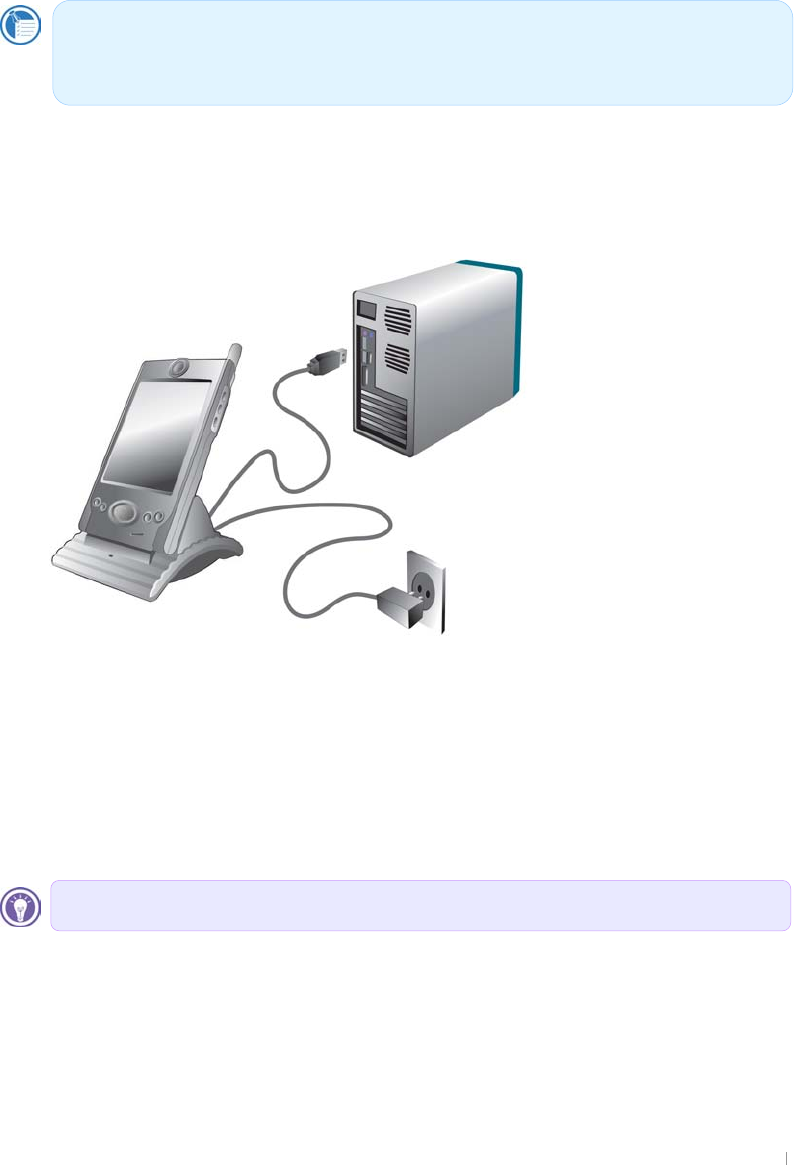
User’s Manual 4-18
Connecting to Device
Connecting by USB Cradle
Using the USB cradle, you can charge and synchronize your device at the same time
even though the charging circuit is not included on your cradle.
Keep your device in the cradle when you are not carrying it with you, so it is always
charged, synchronized, and ready to go.
Turn off your device or remove it from the cradle before you shut down your desktop PC.
When you remove your device from the cradle, hold the cradle with one hand, and gently lift
your device with the other to avoid putting stress on the connectors.
1. Connect your device to your desktop PC as below:
2. How to use the Infrared port of your device:
The infrared port on your device provides a convenient way to connect to an IrDA-equipped
PC without using a cable or cradle. Many notebook computers have built-in infrared ports;
however, you may need to install and configure an infrared port on a desktop PC. To install
the port, follow the manufacturers instructions.
Before you connect, be sure of the following: your desktop PC is on, you have
installed ActiveSync on your desktop PC, and ActiveSync is configured to allow a
USB connection.
Windows 95 and Windows NT® do not support USB or infrared connectivity.

Chapter 5 Using the Internet & E-mail 5-1
In addition to connecting your device to your desktop PC, you may want to connect to
remote computers so you can access e-mail, browse the Internet, or retrieve files from a
corporate network, whether you are at home or on the road.
⊙ To start the connection, simply open a program that requires a connection to the
Internet. Your device will attempt to connect automatically.
Visit Internet or intranet Web or WAP pages by using Pocket Internet Explorer.
Send and receive e-mail messages by using Inbox. Before you can use Inbox, you
need to provide the information it needs to communicate with the e-mail server.
Send and receive instant messages with MSN Messenger. For more information, see
“MSN Messenger” in chapter 9.
⊙ This chapter describes
− browsing the Web using Microsoft Pocket Internet Explorer and Mobile Favorites
− sending and receiving e-mail messages
Chapter 5
Using the Internet & E-mail
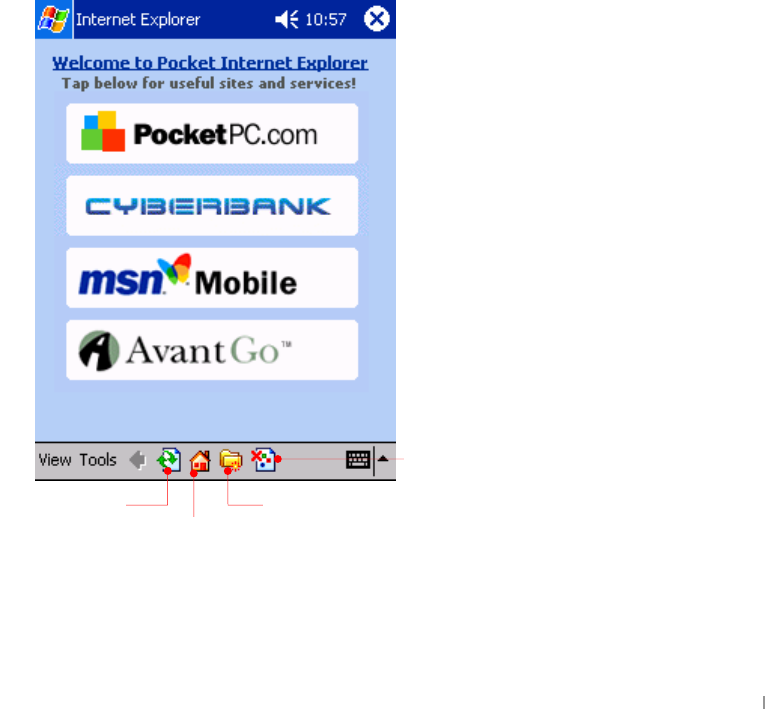
User’s Manual 5-2
Browsing the Web from your device
You have to set up the Internet Settings before you use the Internet Explorer for the first
time. For more information, refer to the Internet Settings section later in Chapter 6.
Once you are connected to an ISP or to a network, you can browse the Internet or a
corporate intranet. You can also use Pocket Internet Explorer to browse Web and WAP
content while you are not connected—by downloading mobile favorites and channels to
your device.
Using Microsoft Pocket Internet Explorer
Use Microsoft Pocket Internet Explorer to view Web pages in either of these ways:
Connect to an ISP or network and browse the Web. To do this, you will need to
create the connection first.
During synchronization with your desktop PC, download mobile favorites that are
stored in the Mobile Favorites subfolder in Internet Explorer on the desktop PC.
While you are connected to an ISP or network, you can also download files and
programs from the Internet or an intranet.
To start Pocket Internet Explorer
1. On the Start menu, tap Internet Explorer.
2. On the View menu, tap Address Bar.
3. Enter address you want on the address bar located on the top of screen and tap the
arrow next to the address bar, then it will automatically connect to the Internet using
Hide Picture button
Mobile Favorites button
Home button
Refresh button

Chapter 5 Using the Internet & E-mail 5-3
CDMA module.
4. When the internet connection is completed, the internet connect ( ) icon will
appear on the Navigation bar.
5. When you want to finish using Internet, tap the stop ( ) button on the Command bar
so that you have the Internet browse( ) icon stopped. And also you need to tap X on
the right-upper corner and tap the Internet connect ( ) icon and tab the End button on
the Connected pop-up screen to stop your Internet connection completely.
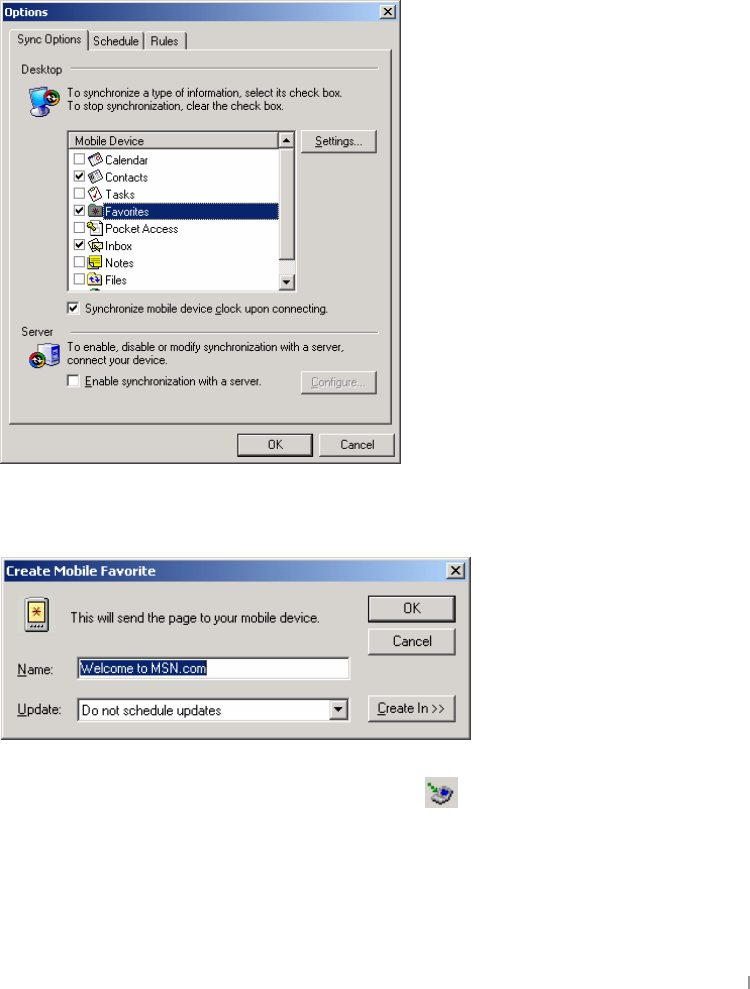
User’s Manual 5-4
Mobile Favorites folder
Only items stored in the Mobile Favorites subfolder in the Favorites folder in Internet
Explorer on your desktop PC will be synchronized with your device. This folder is created
automatically when you install ActiveSync.
You can only view the mobile favorites offline that was synchronized with your desktop
PC. If the page is not synchronized with your desktop PC, it will be dimmed in the
Favorites list of your device. You will need to synchronize with your desktop PC again to
download the page to your device, or connect to the Internet to view the page.
To make Mobile Favorites
1. Select Options on the Tools menu or click the Options button to have the Options
screen displayed. Then select the Favorites check box and click OK.
2. Select Create Mobile Favorites on the Tools menu of Microsoft Internet Explorer of
your desktop PC.
3. When you select OK, the Internet Explorer will download the latest version of the
corresponding page. Then you will find the icon( ) on the task tray bar of your desktop
PC.
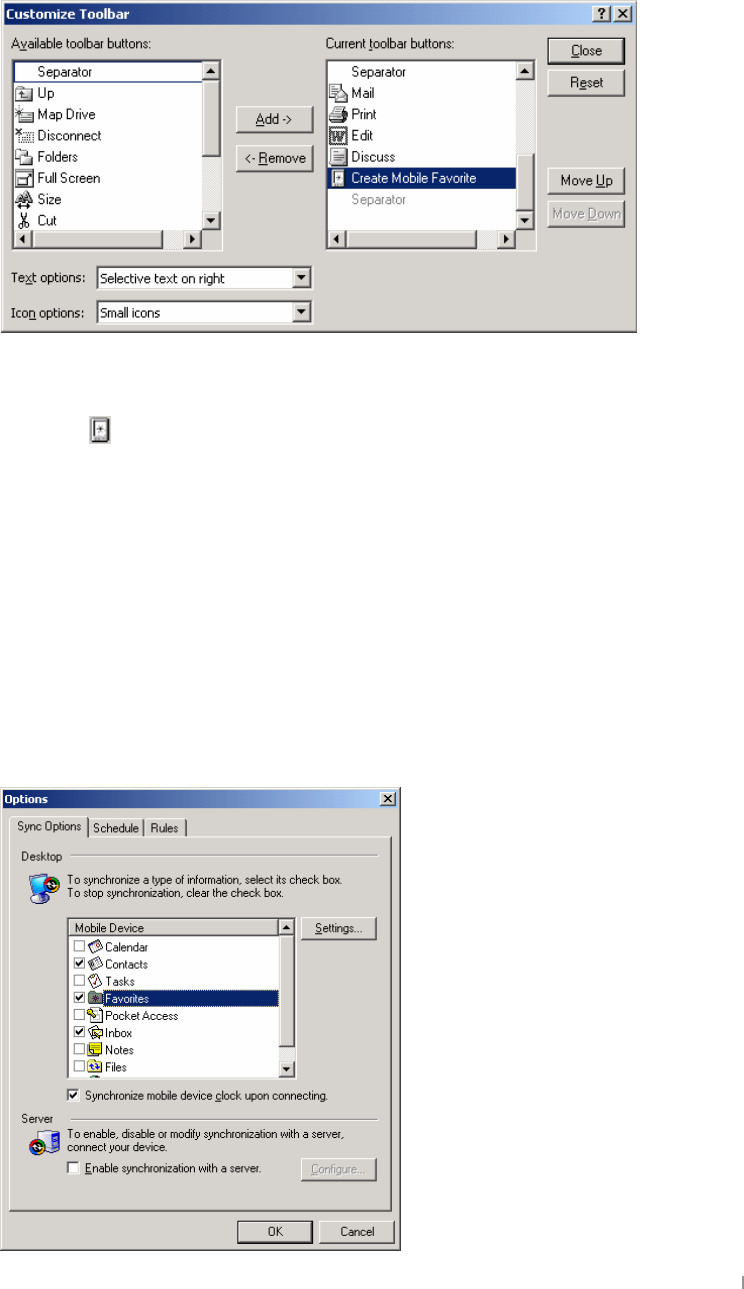
Chapter 5 Using the Internet & E-mail 5-5
To make the Mobile Favorites button on the Tools menu of
your desktop PC
Select Tools bar > Customize on the View menu of Microsoft Internet Explorer to add the
Mobile Favorites button on the Tools bar.
Select Create Mobile Favorites on your left pane and click the Add button to send that
item you select to the right pane as described above. Then you will find the Mobile
Favorites( ) button on your tools bar of your Microsoft Internet Explorer.
To reduce the amount of memory caused by Mobile Favorites
Mobile favorites take up storage memory on your device. Follow these tips to minimize
the amount of memory used:
Use ActiveSync settings to turn off pictures and sounds for the Mobile Favorites or to
stop some mobile favorites from being downloaded to your device. For more
information, see ActiveSync Help.
1. Select Options on the Tools menu or click the Options button to have the Options
screen displayed.
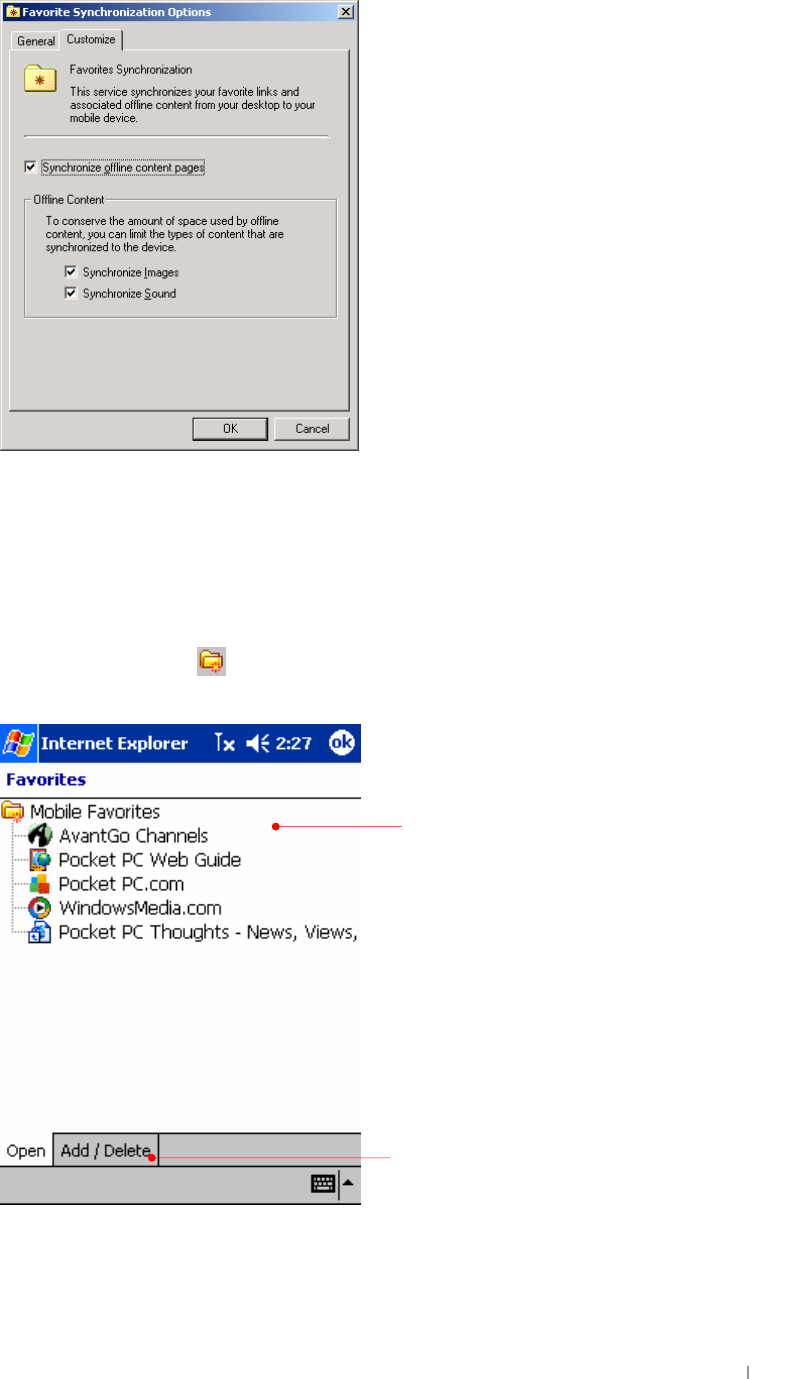
User’s Manual 5-6
2. Then select the Favorites check box and click the Settings button.
3. Deselect pictures and sounds for the Mobile Favorites and click OK.
To view Mobile Favorites offline
1. Tap the Favorites ( ) button on Pocket Internet Explorer of your device to display
your list of favorites.
2. In the list, tap the page you want to view.
Tap the favorite you want to view.
Tap to add or delete a folder or favorite link.
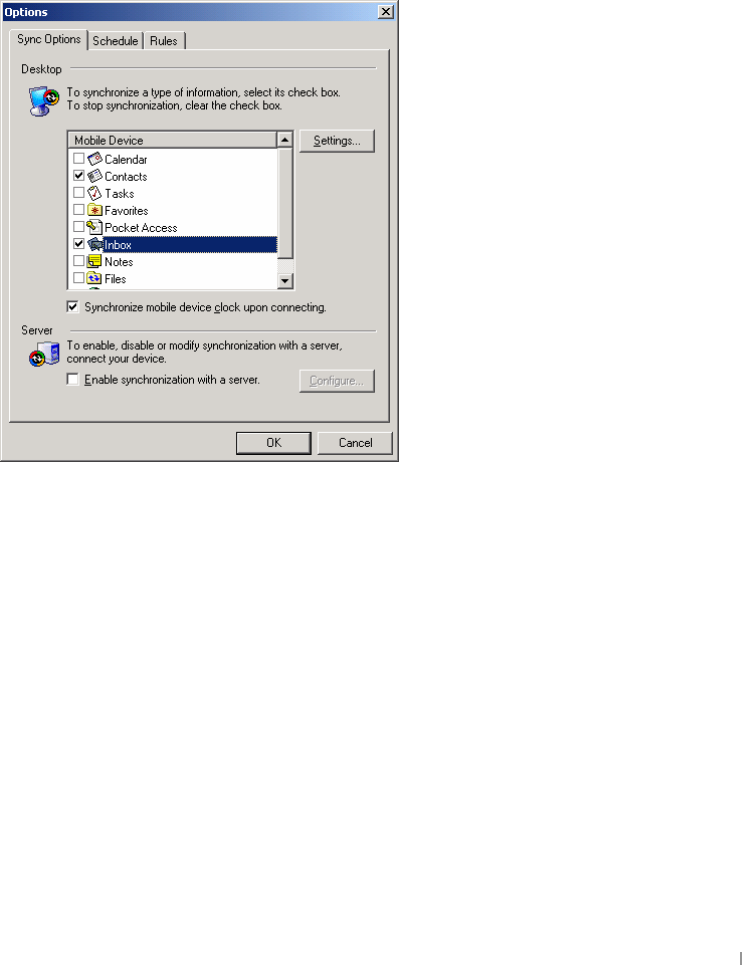
Chapter 5 Using the Internet & E-mail 5-7
Sending and Receiving E-mail
If you have an e-mail account with an ISP or on a corporate network, you can use Inbox
to send and receive e-mail messages in two ways:
Synchronize e-mail messages with Microsoft Outlook on your desktop PC.
Send and receive e-mail messages by connecting directly to an e-mail server
through an ISP or a network.
Synchronizing E-mail Messages
You can synchronize e-mail messages as part of the general synchronization process
whenever you connect your device to your desktop PC. First, you must enable Inbox
synchronization in ActiveSync.
Select the Options button on the Microsoft ActiveSync screen.
Select Inbox and click the Settings button.
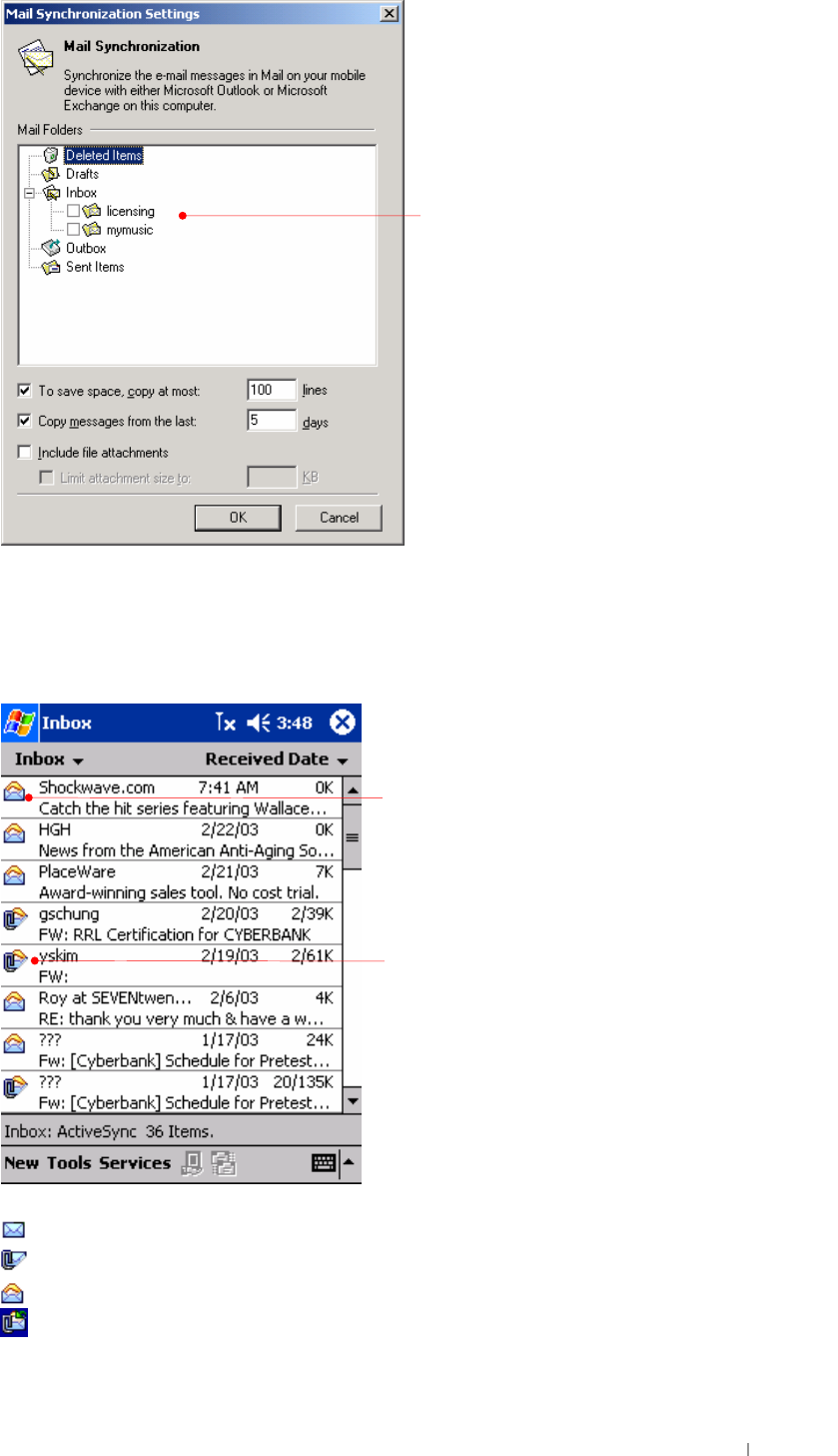
User’s Manual 5-8
Make selections as you want and click OK to copy the Inbox folder of your desktop PC to
the Inbox folder of your device.
Here is the list of mail messages after you synchronize through ActiveSync.
This is unread message.
This is unread message with attachments that need to be downloaded.
This is already read message.
This is read message with attachments that is already downloaded.
Select the folders you have made to synchronize.
Shows you this is a read mail message.
Shows you this is a mail message with attachments
that need to be downloaded.
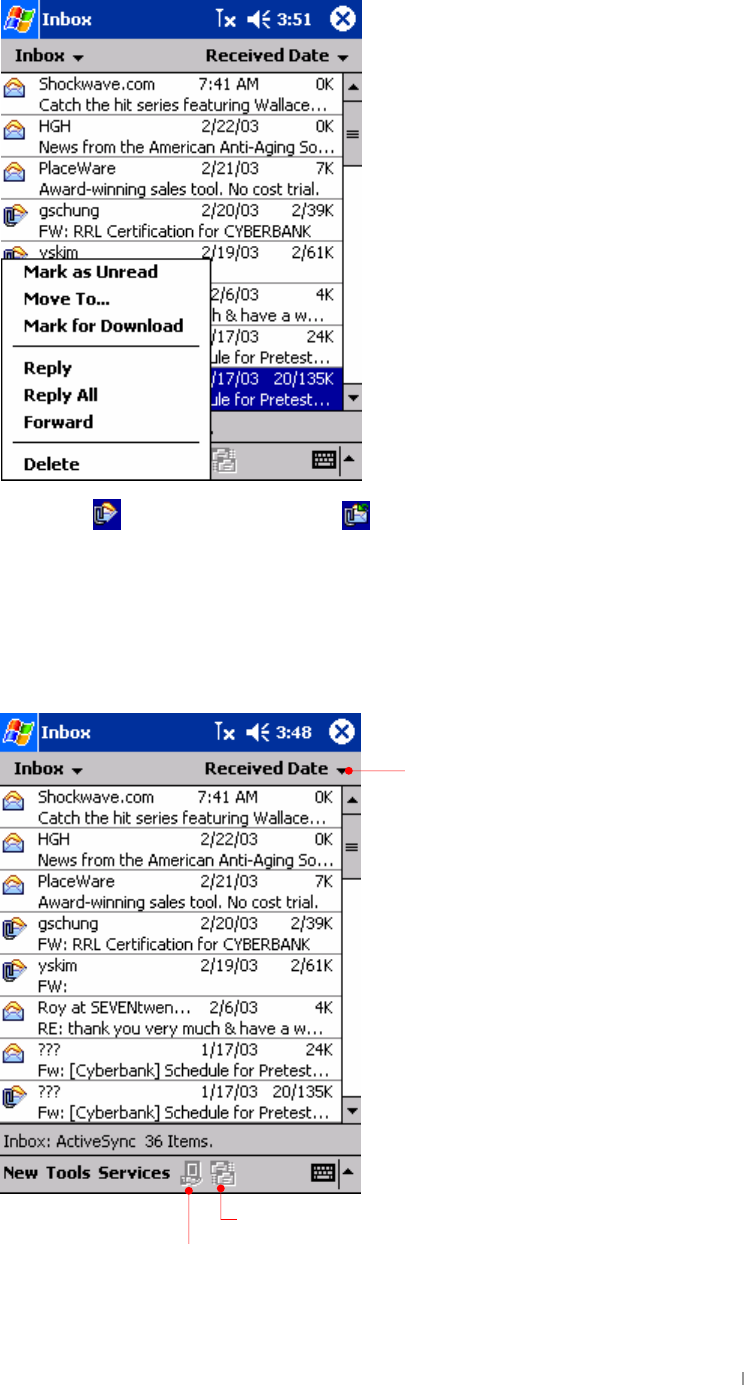
Chapter 5 Using the Internet & E-mail 5-9
If you want to download the attachments, tap and hold the corresponding message to
have pop-up menu displayed. Then select Mark for Download.
Then this icon will be changed to .
Using the Message List
Messages you receive are displayed in the message list. By default, the most recently
received messages are displayed first in the list.
Select the sort order for messages.
Ta
p
to connect and to send and receive e-mail.
Tap to connect to the
selected service.
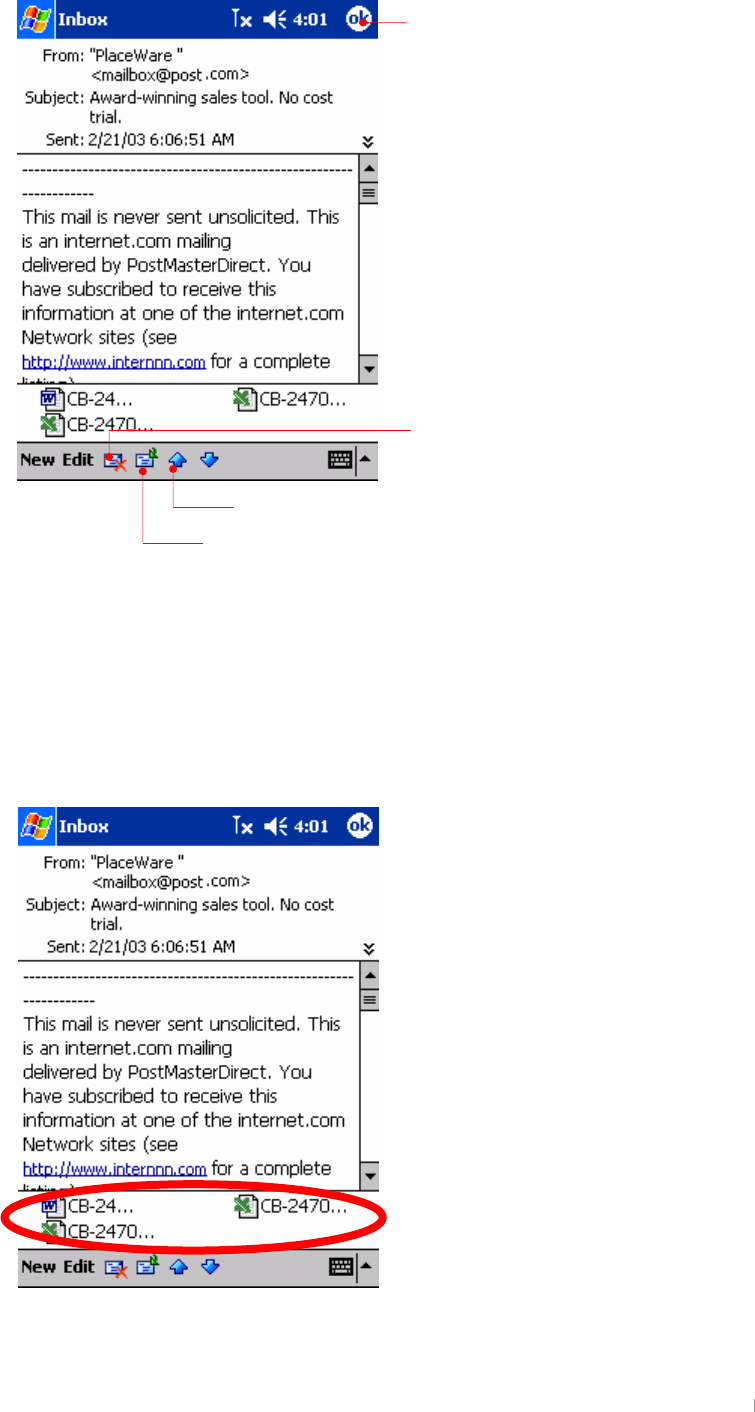
User’s Manual 5-10
When you receive a message, tap it to open it.
You can mark the messages that you want to retrieve in full during your next
synchronization. In the message list, tap and hold the message you want to retrieve. On
the pop-up menu, tap Mark for Download. The icons in the Inbox message list give you
visual indications of message status.
When you select this message with attachments that is already downloaded, the
message will open with attachments displayed on the bottom of screen.
Tap to return to the message list.
Tap to delete this message.
Tap to view the previous or next message.
Tap to reply to or forward this message.
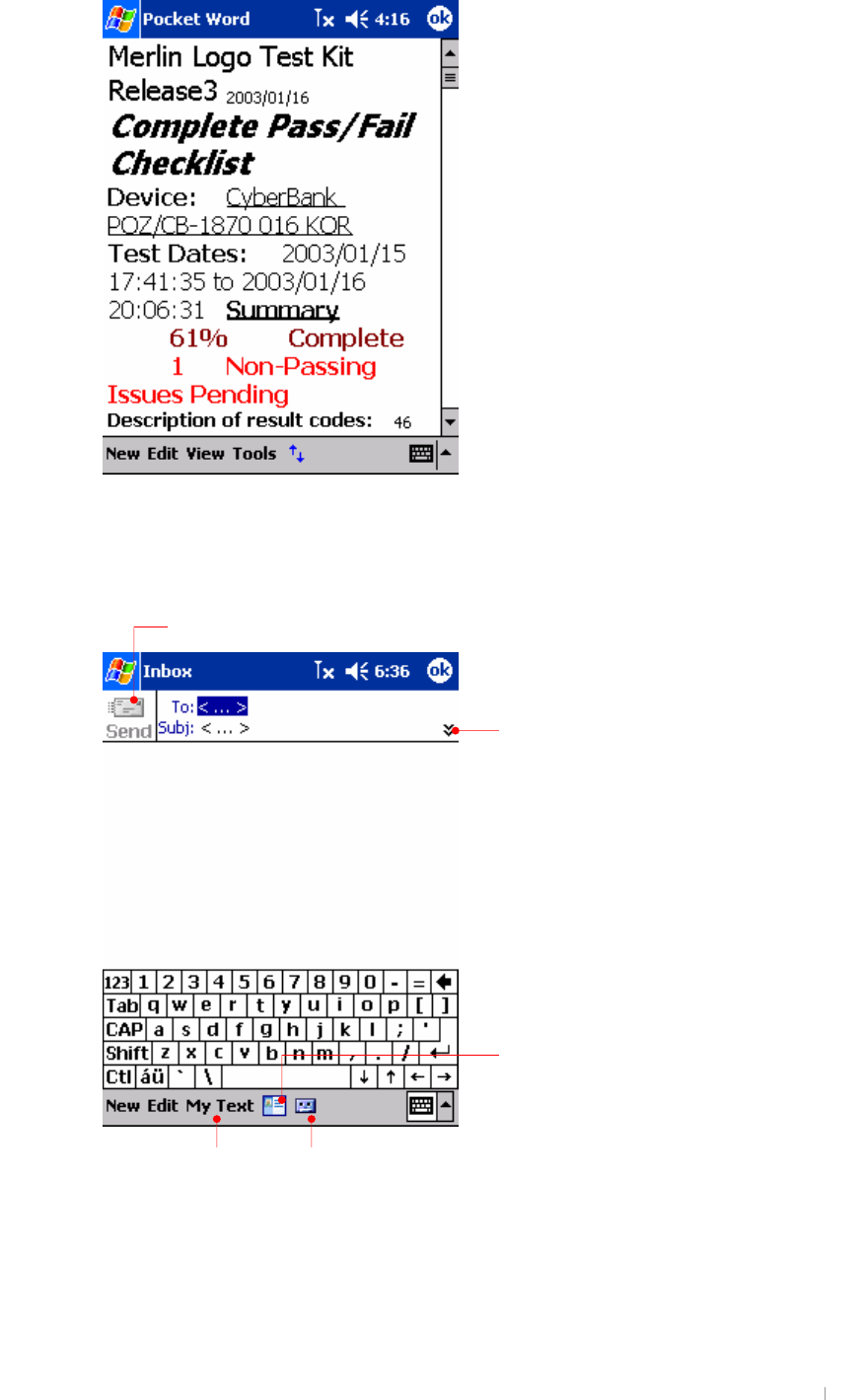
Chapter 5 Using the Internet & E-mail 5-11
Tap the attachments to open the corresponding file as shown below.
Make a new message
1. Tap New.
Tap to send the message.
Tap to show or hide the complete header.
Tap to show / hide the recording toolbar.
Tap to display the Address Book.
Tap to insert common messages.
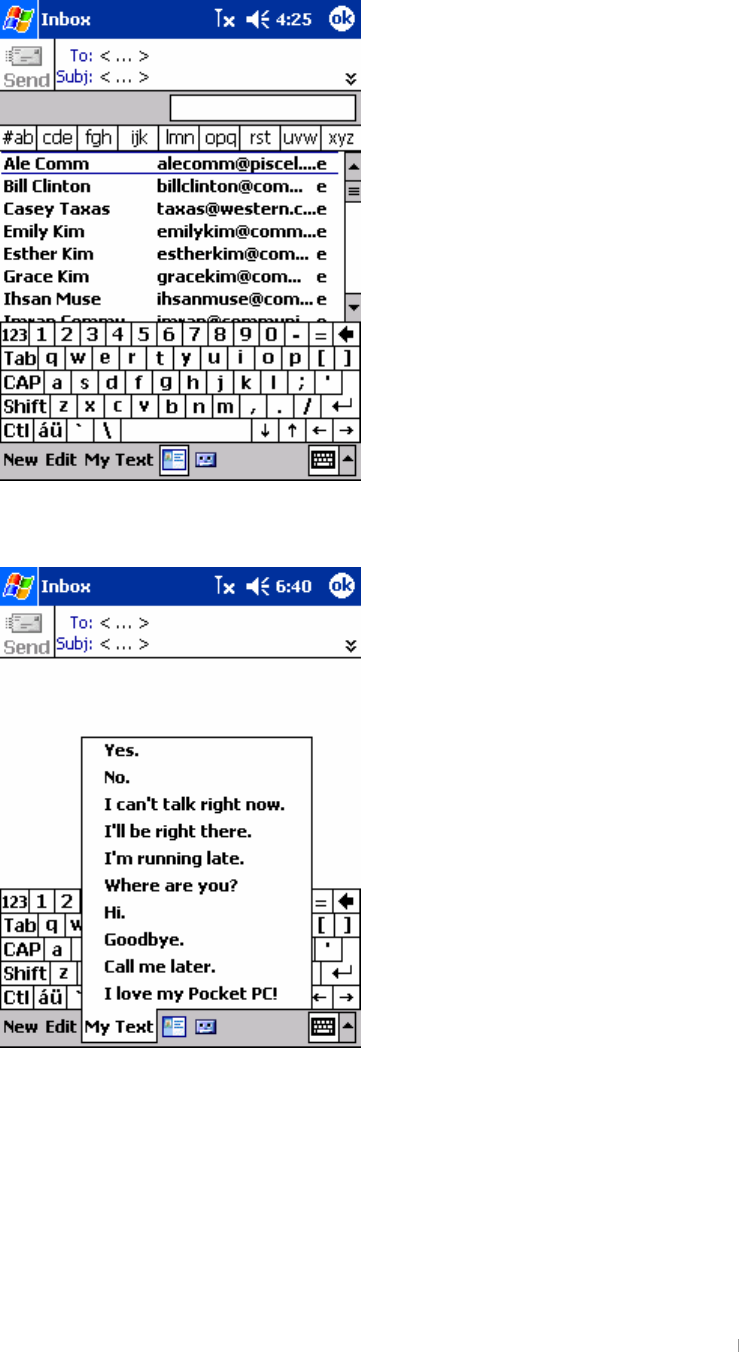
User’s Manual 5-12
2. In the To field, enter an e-mail address of one or more recipients, separating them
with a semicolon, or select a name from the contact list by tapping the Contacts
button.
3. Compose your message. To enter preset or frequently used messages, tap My Text
and select a message.
4. When you have finished the message, tap Send.
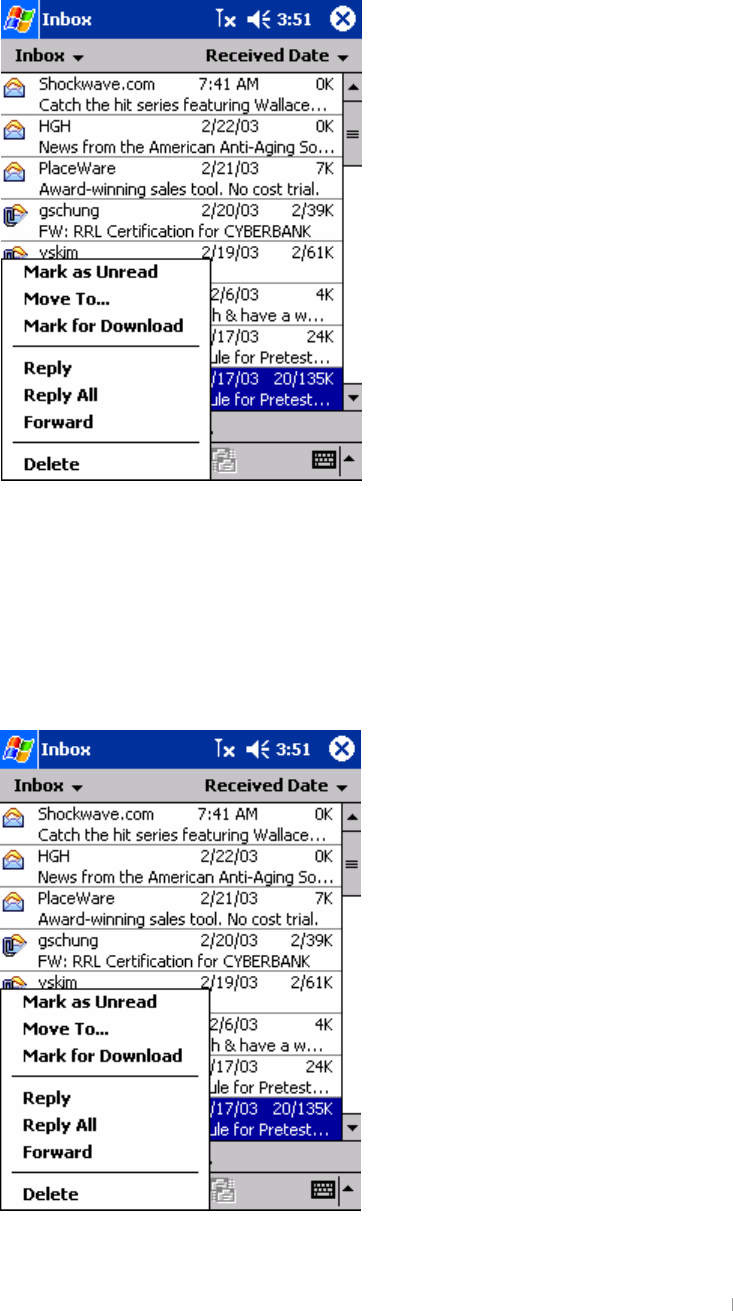
Chapter 5 Using the Internet & E-mail 5-13
Delete a message
When your device is synchronized with your desktop PC, and when you want to delete a
message on your device, tap and hold the message to have pop-up menu displayed.
Then select Delete.
If your device is not synchronized with your device, the next time your device is
synchronized, the corresponding message on your desktop PC will be deleted.
Reply, Reply all or Forward a message
When you want to reply, reply all or forward a message on your device, tap and hold the
message to have pop-up menu displayed. Then select Reply, Reply all or Forward.
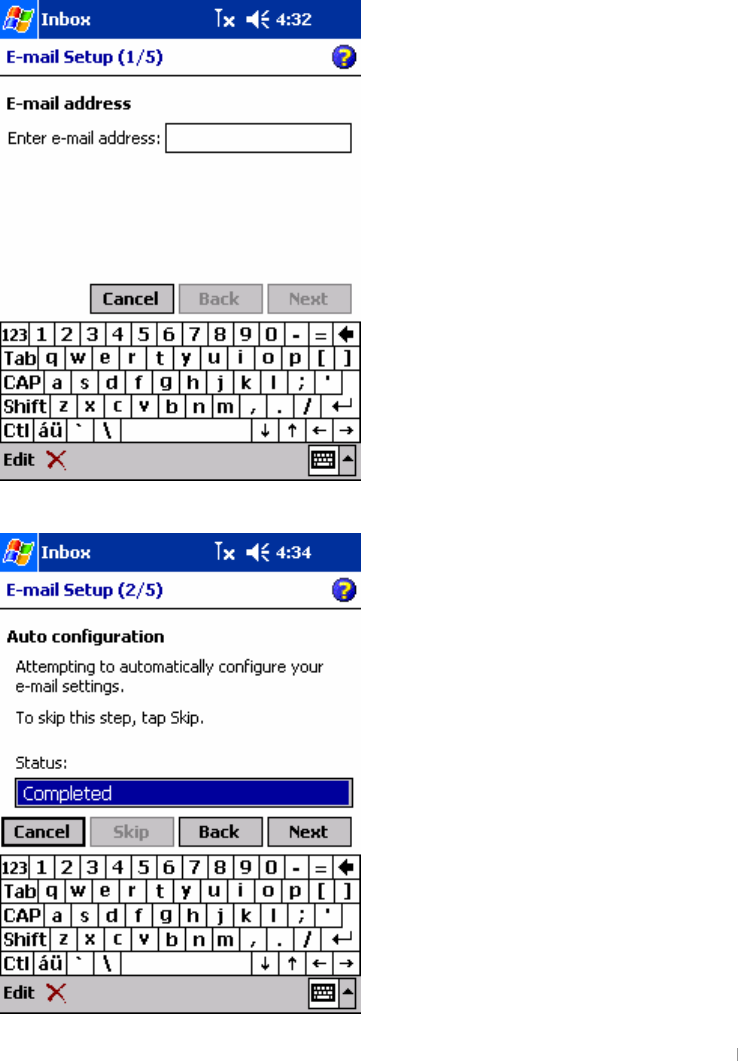
User’s Manual 5-14
Connecting Directly to an E-mail Server
In addition to synchronizing e-mail messages with your desktop PC, you can send and
receive e-mail messages by Inbox on your device using CDMA module.
The ISP or network must use a POP3 or IMAP4 e-mail server and an SMTP gateway.
Customize a new mail service
You can use multiple e-mail services to receive your messages. For each email service
you intend to use, first set up and name the e-mail service. If you use the same service
to connect to different mailboxes, set up a separate service for each mailbox.
In Inbox, tap Services, and then tap New Service. Follow the directions in the New
Service Wizard. Here is just parts of setting a wizard.
Enter e-mail address and tap Next.
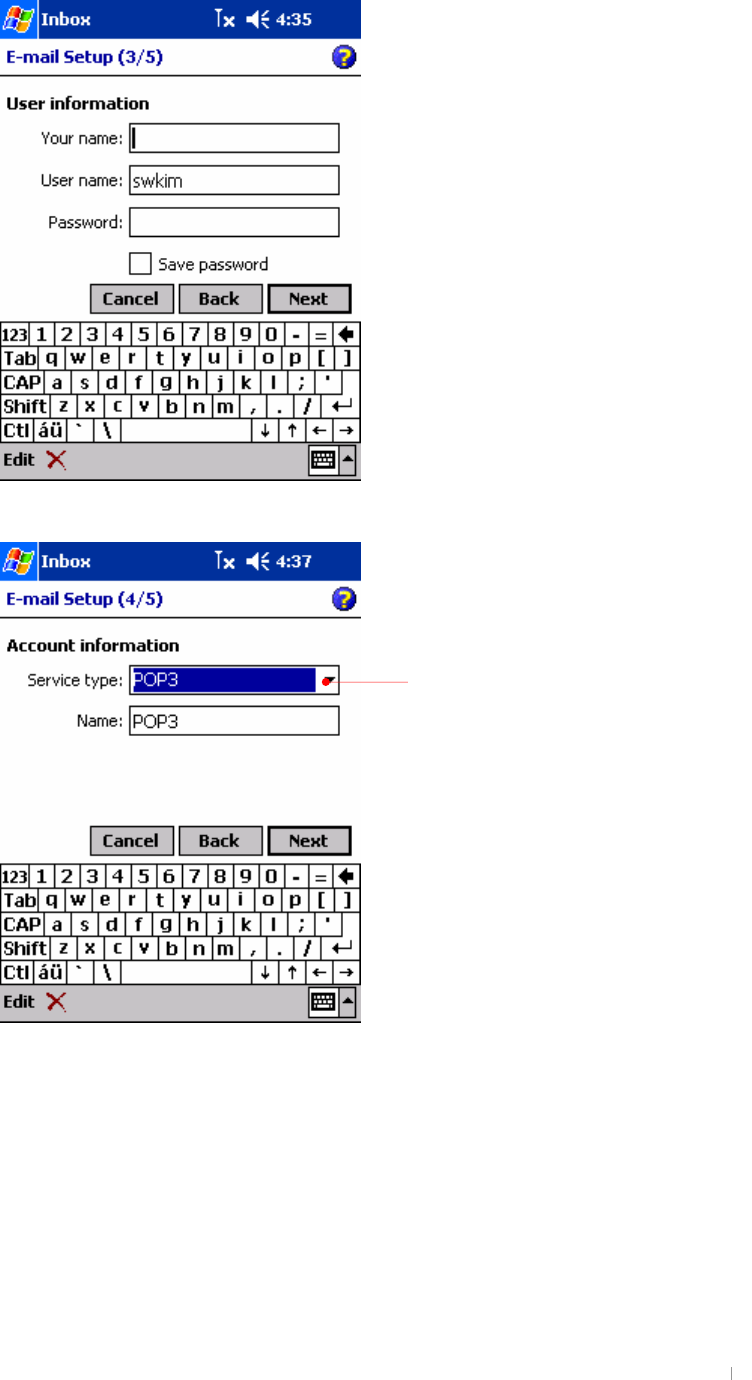
Chapter 5 Using the Internet & E-mail 5-15
After the status becomes Completed as shown above, tap Next.
Enter your name and password and then tap Next.
Select POP3 or IMAP4 that is supported,
enter a name in the Name box (for
exam
p
le
,
M
y
Mail
)
.
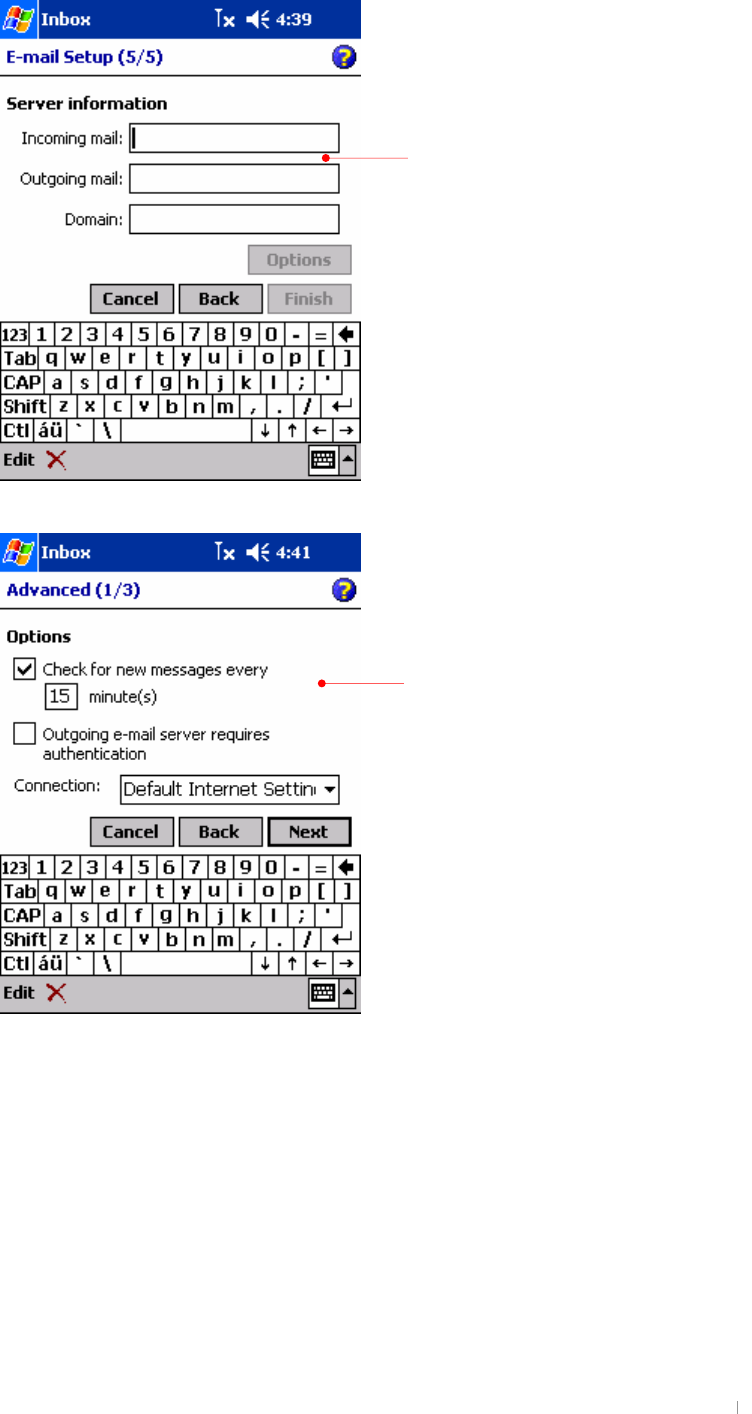
User’s Manual 5-16
Enter a name in the Name box (for example, My Mail) and tap Next.
If needed, tap the Options button.
Enter server names in the Incoming mail
box and the Outgoing mail box(for example,
****.cb.co.kr), and if needed, tap Options to
set the other options. For more detailed
information, ask your the network
administrator or corporate mail-server
administrator.
Check for new messages every 15
minutes.
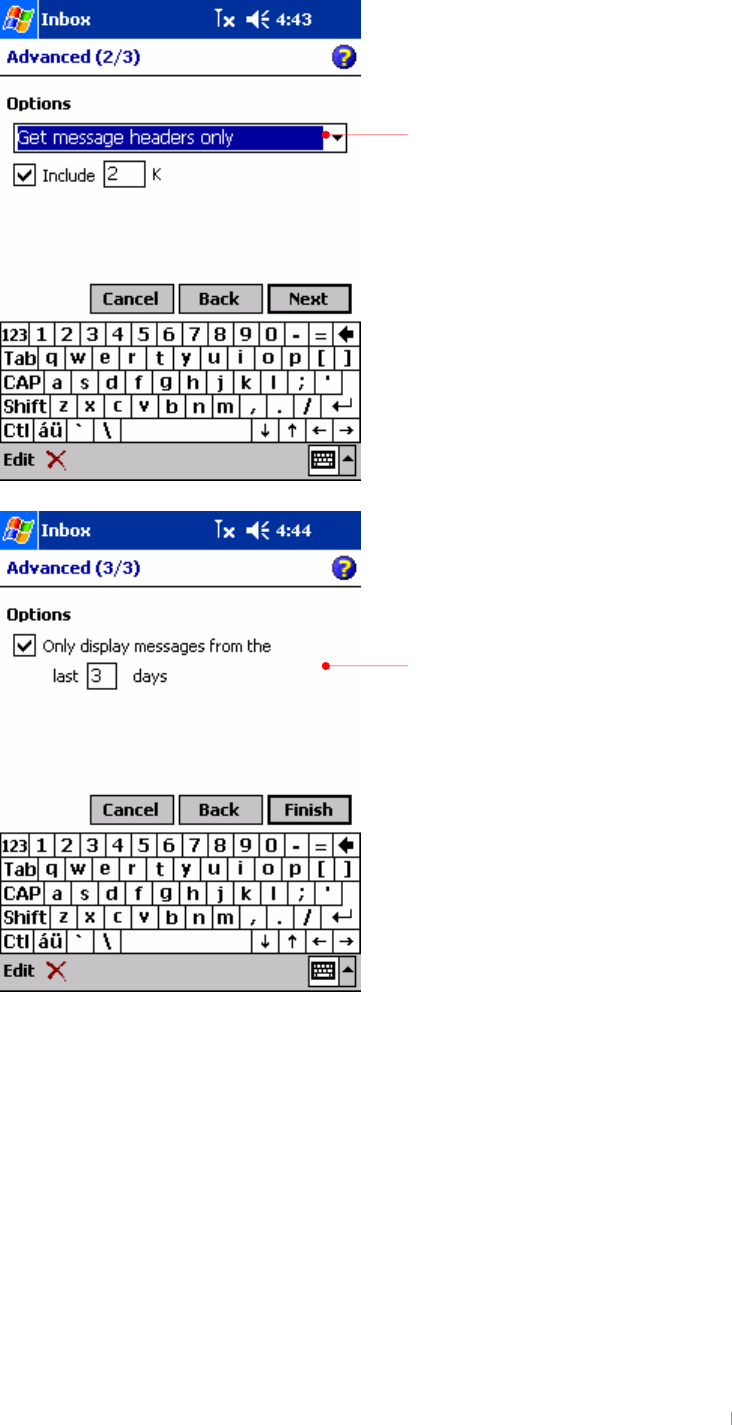
Chapter 5 Using the Internet & E-mail 5-17
Tap the Finish button.
Select one of options provided: Get
message headers only, Get full copy of
messages. When you select Get full
copy of messages, also you will
receive messages from file
attachments of less than 25 KB in
size.
Only display messages from the
last 3 days.
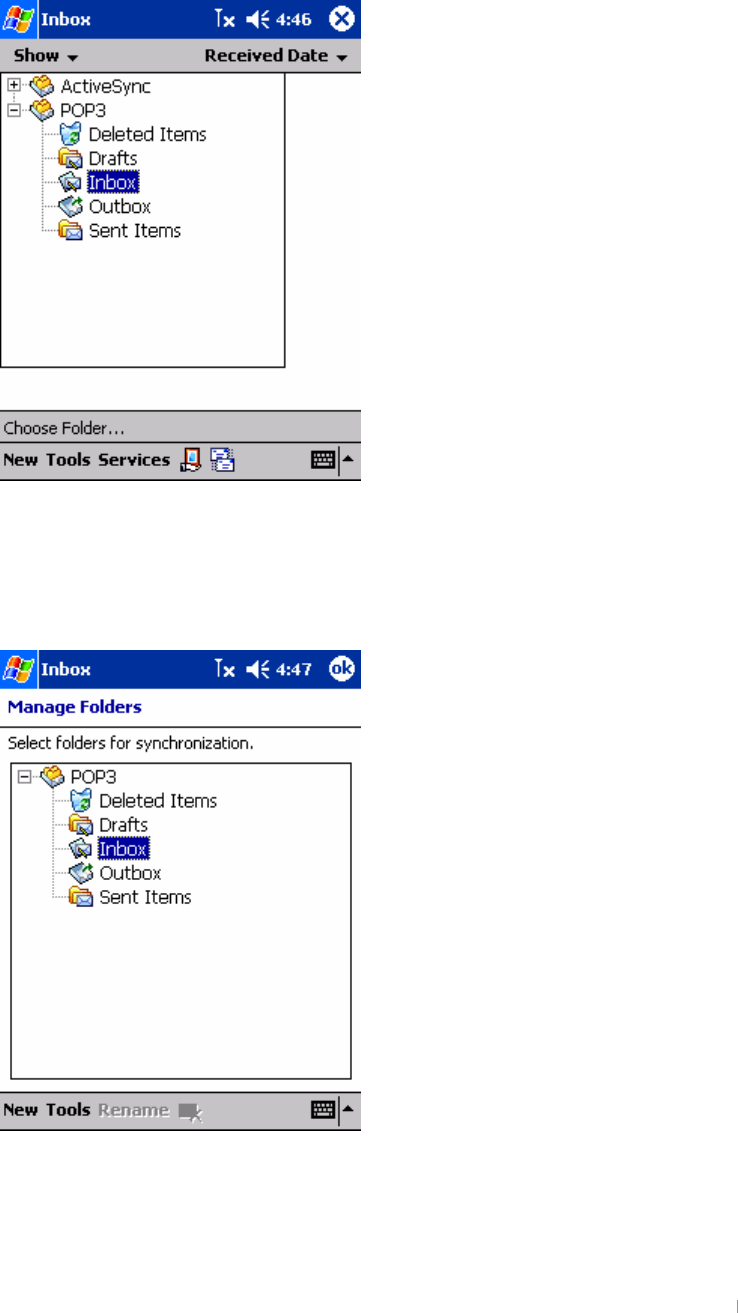
User’s Manual 5-18
To connect to an e-mail service
In Inbox, tap Services, and then tap Connect. Then through CDMA module, you will be
connected to mail server. Messages in your own local folder will be downloaded from this
mail server directly.
To synchronize your own local folder through ActiveSync
If you want to synchronize your own local folder through ActiveSync, select the local
folder(for example, POP3 as shown below) and on the Tools menu, select Manage
Folders.
Select the subfolder you want to synchronize through ActiveSync and tap OK on the
upper-right corner.
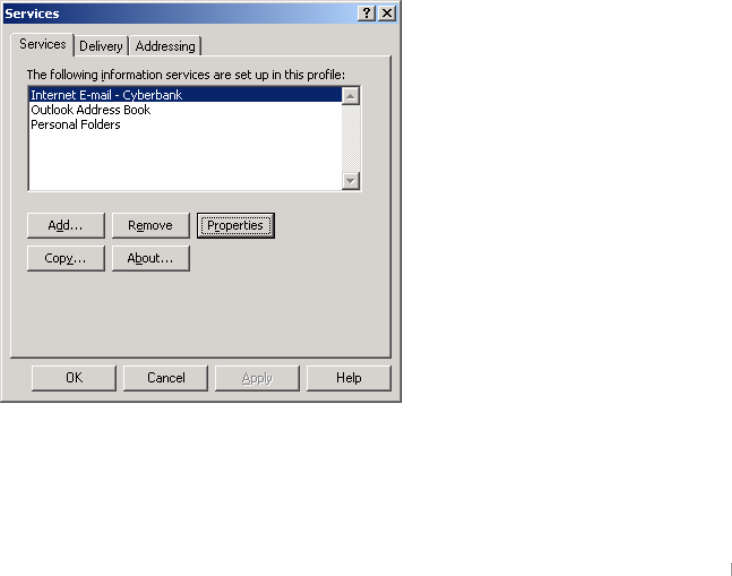
Chapter 5 Using the Internet & E-mail 5-19
By default, each mail service is composed of 5 subfolders.
z Inbox
z Outbox
z Sent Items
z Deleted Items
z Drafts
When you connect to the e-mail server, new messages are downloaded to the Inbox
folder on your device, messages in the Outbox folder are sent, and messages that have
been deleted on the e-mail server are removed from the Inbox folder on your device.
You can work online or offline. When working online, you read and respond to messages
while connected to the e-mail server. Messages are sent as soon as you tap Send,
which saves space on your device.
When working offline, you should download new message headers or partial messages,
and then you can disconnect from the e-mail server while you decide which messages to
download completely. The next time you connect, Inbox downloads any messages you
marked for retrieval and sends the messages in your Outbox folder.
To leave a copy of messages on Server
Once when you download mail messages on your desktop PC or device from mail server,
the mail messages will be deleted on mail server. You need to leave a copy of messages
on mail server.
Here is an explanation on how you can leave a copy of messages on mail server on your
desktop PC. Select Services on the Tools menu.
Then click Properties and click the Advanced tab.
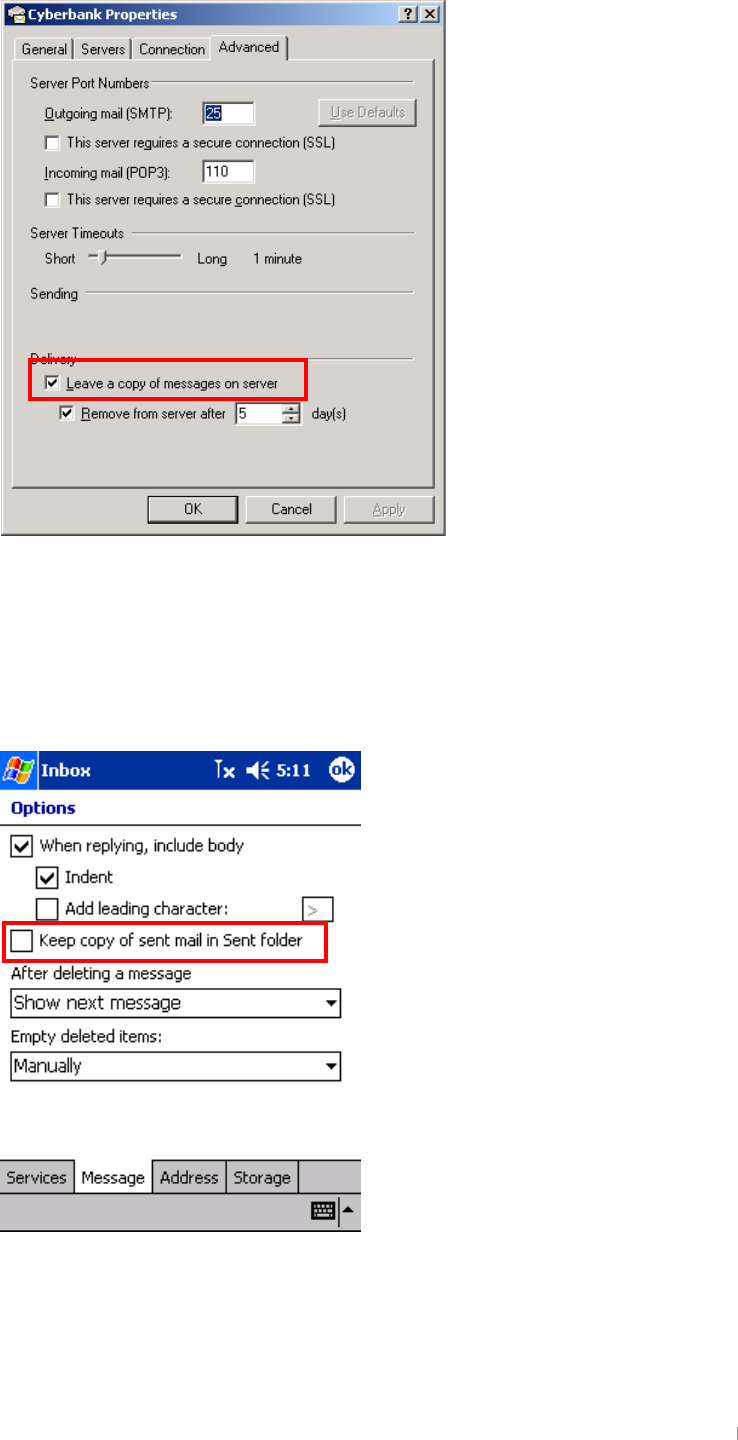
User’s Manual 5-20
Select the Leave a copy of messages on server item as described above.
Here is an explanation on how you can leave a copy of messages on mail server on your
device. Select Options on the Tools menu, click the Messages tab and select the Keep
copy of sent mail in Sent folder check box.
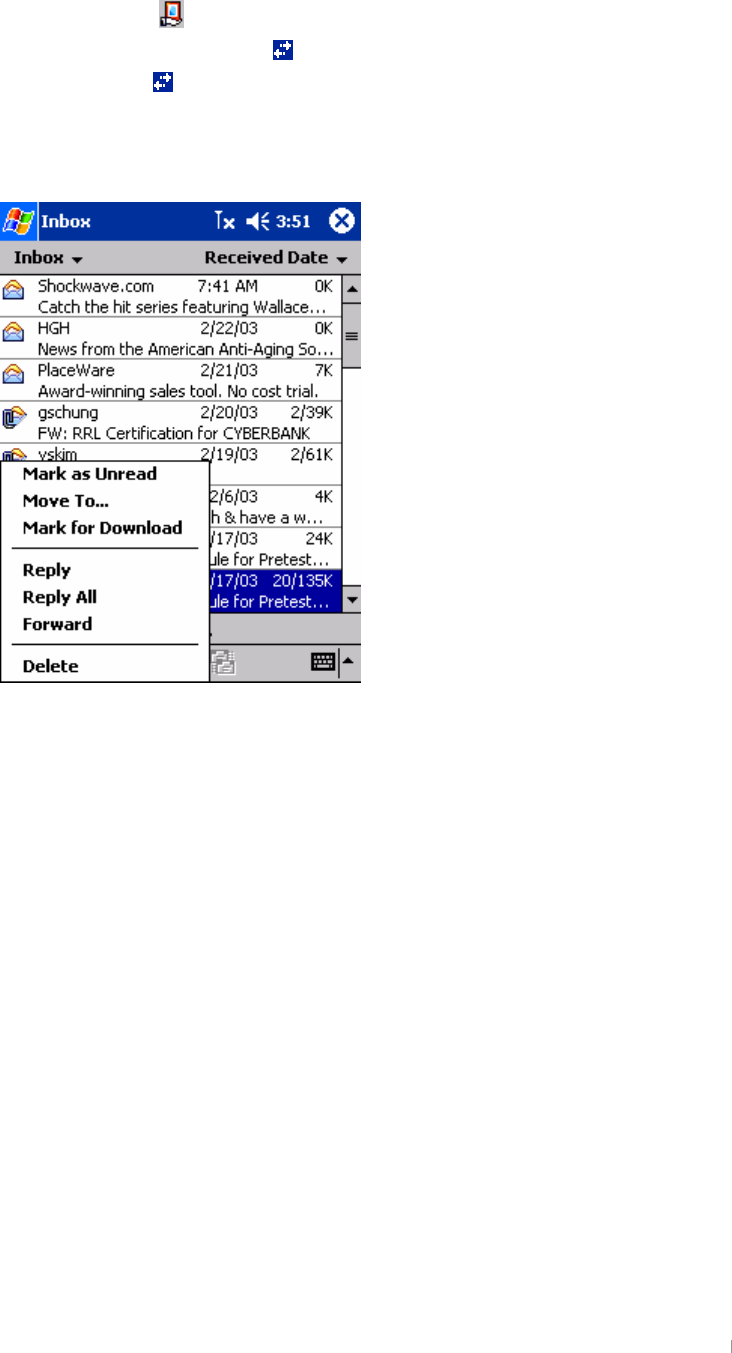
Chapter 5 Using the Internet & E-mail 5-21
To download the attachments of message
You can download the attachments of message through directly connecting to mail
server using the CDMA module.
Tap the Connect ( ) icon to directly connect to the mail server.
Then you will find the connect icon on the navigation bar.
Tap the connect icon on the navigation bar to finish this connection.
Tap and hold the message to download the attachments and select Mark for Download
on the pop-up menu.
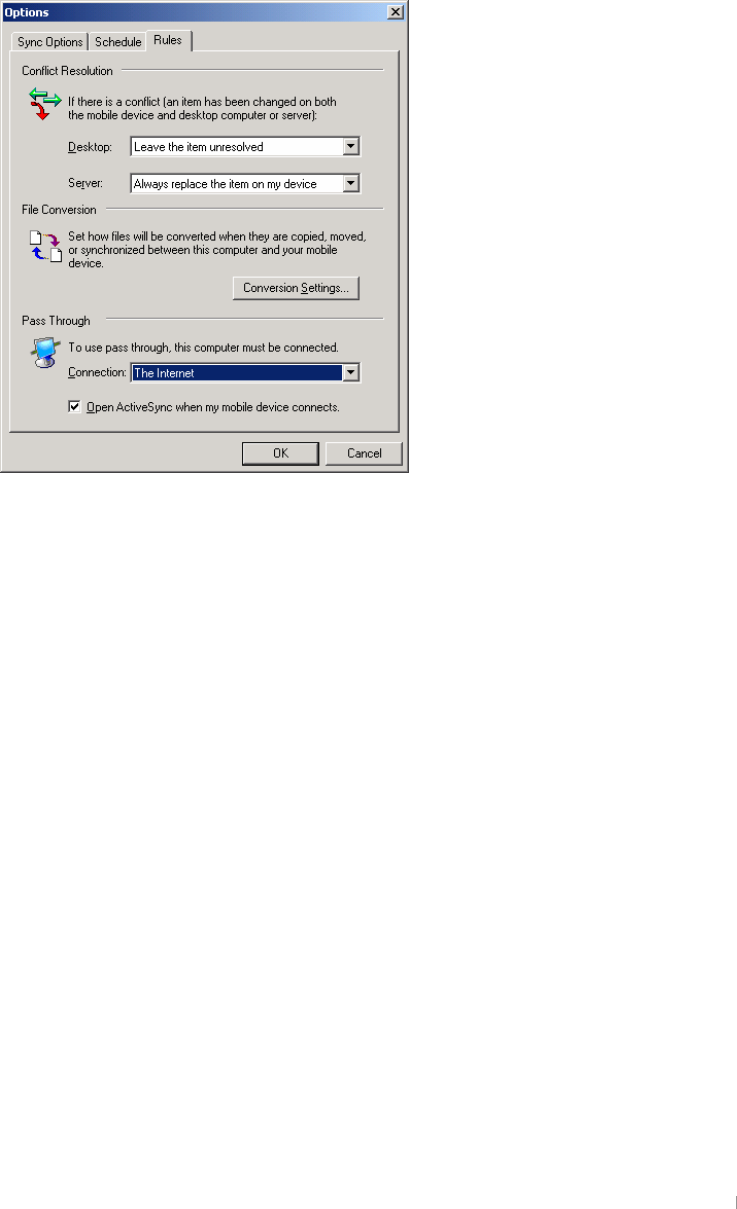
User’s Manual 5-22
To download messages of your local folder through
ActiveSync
You can download the attachments of message through directly connecting to mail
server using the CDMA module.
Select the Options button on the ActiveSync toolbar and select the Rules tab as below.
Select the Internet on the connection of the Pass Through item to download messages
of your local folder through ActiveSync. However, when you need to download your mail
messages on your desktop PC, you have to select the Work.

Chapter 6 Configuring Device 6-1
This chapter details ways you can optimize your device using the Settings, and
describes ways you can expand features and functionality by adding programs. This
chapter also offers important tips on safeguarding your data by managing power and
memory.
- Adjust Settings
- Managing Memory
Chapter 6
Configuring Device
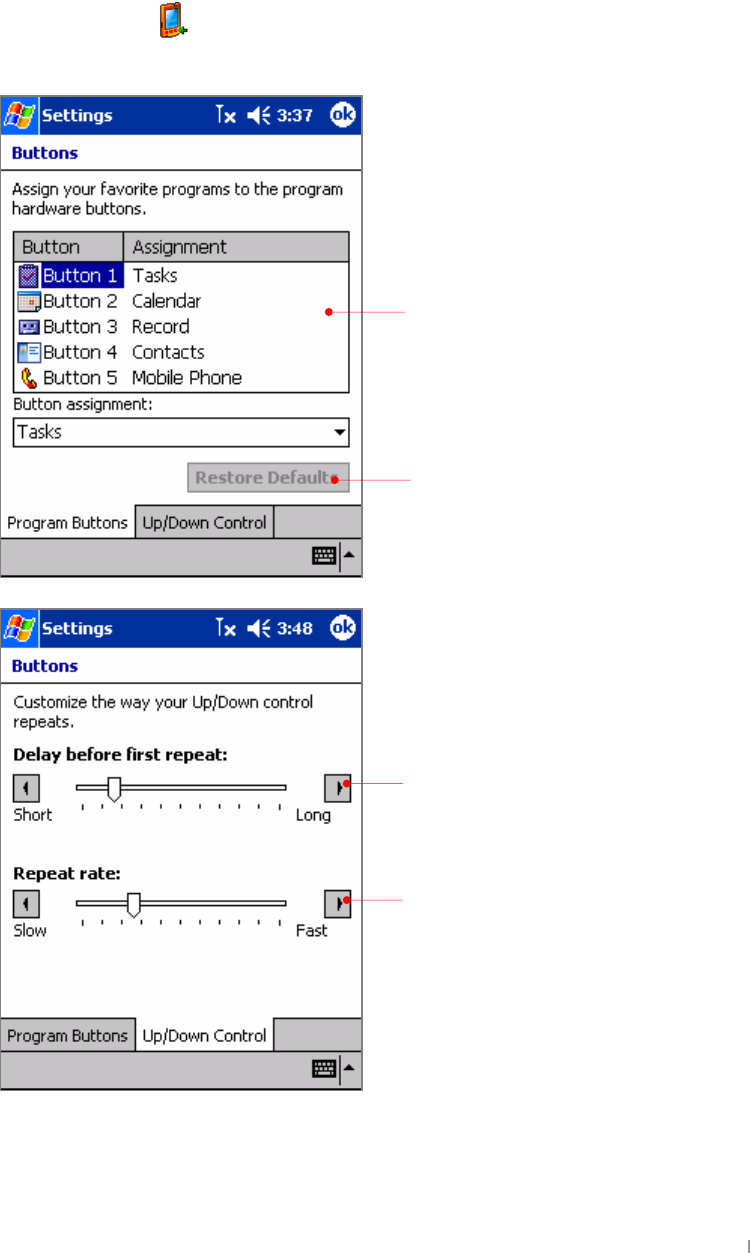
User’s Manual 6-2
Adjust Settings
On the Start menu, tap Settings that is composed of 3 tabs: Personal, System, and
Connections.
1. the Personal tab
Tap the Buttons ( ) icon to assign functions to the 4 buttons located on the bottom of
your device. You can assign some functions to the hardware buttons using this setting.
First, select a button among the 5 buttons
and select a function you want for that
button on the Button assignment.
Select the Restore Defaults button to go
back to the factory defaults provided when
y
ou
p
urchase this device.
Move the slide to adjust the delay before
first repeat.
Move the slide to adjust the repeat rate.
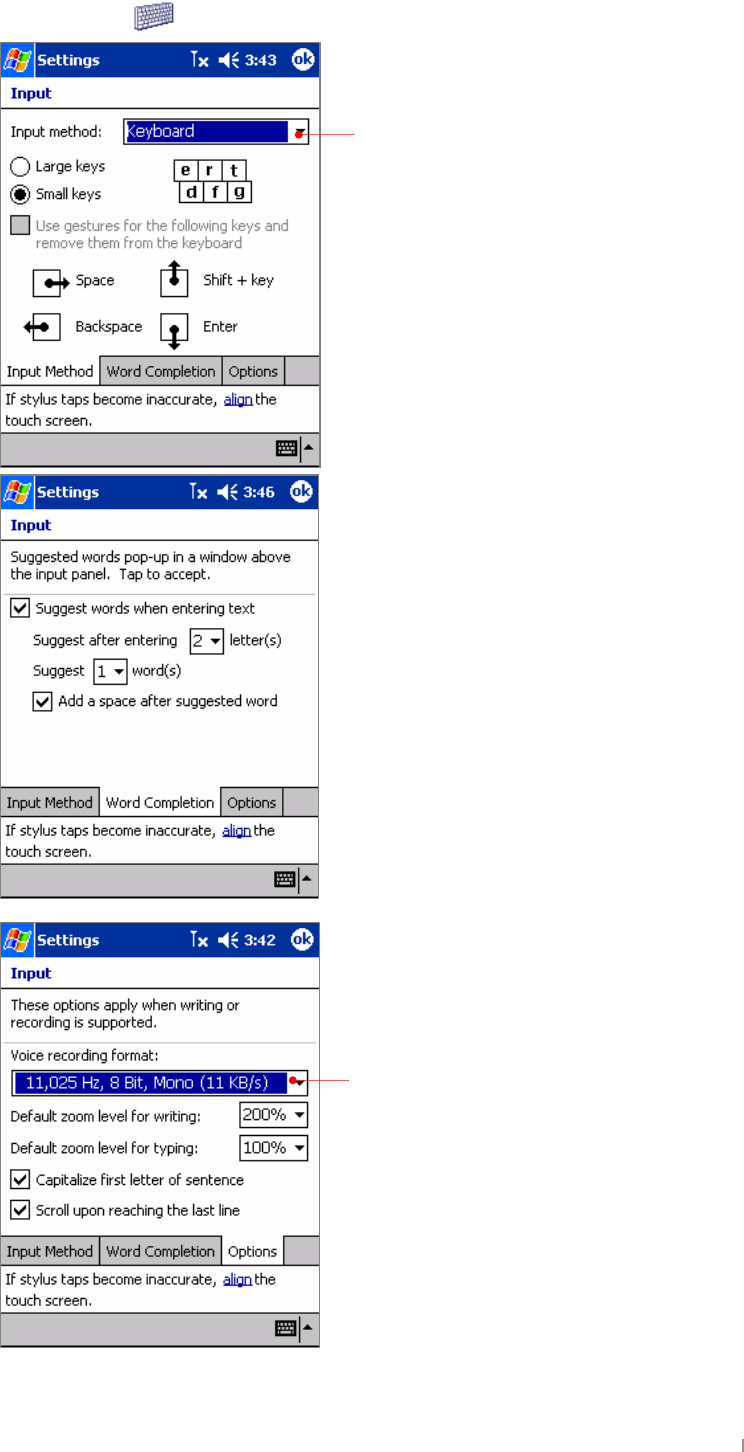
Chapter 6 Configuring Device 6-3
Tap the Input ( ) icon to adjust a setting on the Input Panel .
It is recommended that you select the
default mode of voice recording format to
conserve your memory size.
Select the default mode among Block
Recognizer, keyboard, Letter Recognizer
and Transcriber.
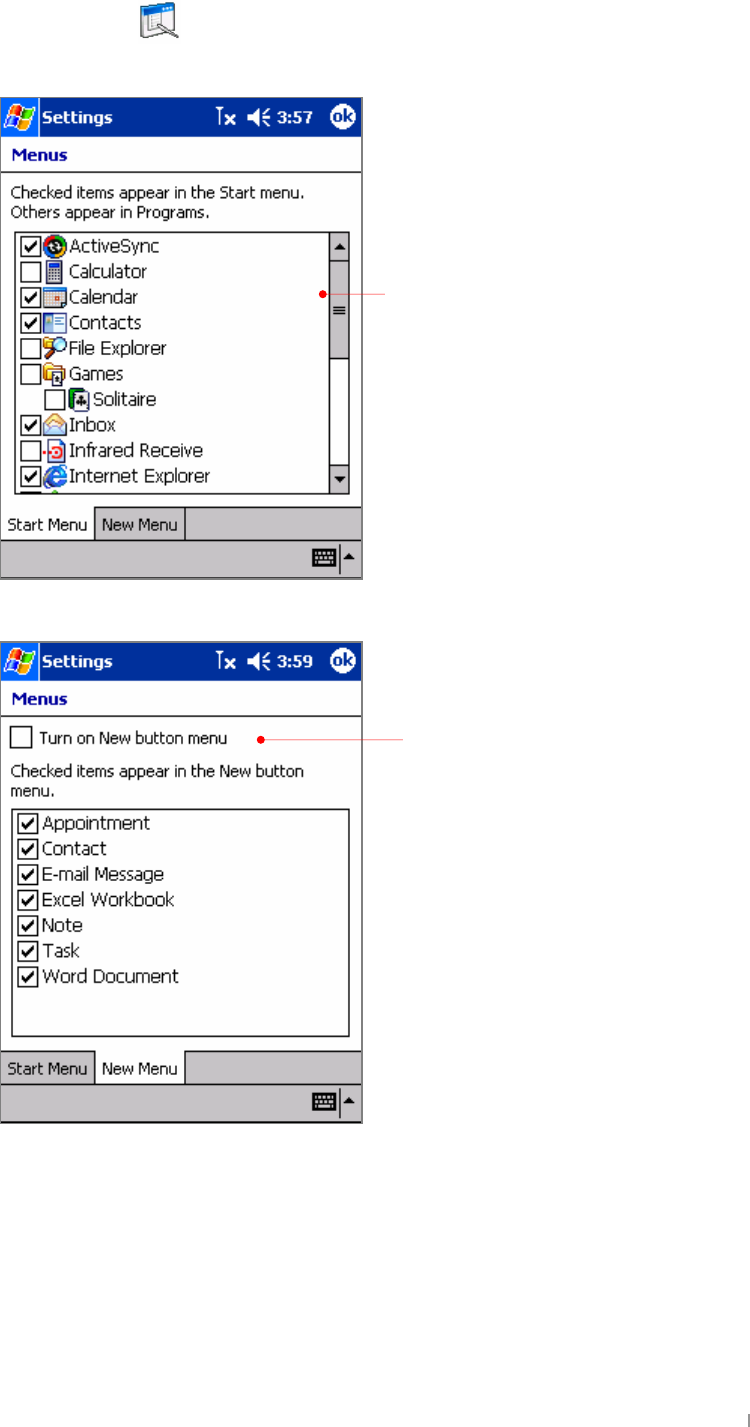
User’s Manual 6-4
Tap the Menu ( ) icon to adjust the programs listed on the Start menu and New
menu.
Select items appear in the Start
menu. Otherwise, the rest appear in
Programs.
Select the Turn on New button menu
item to have the selected items
displayed on the New menu list.
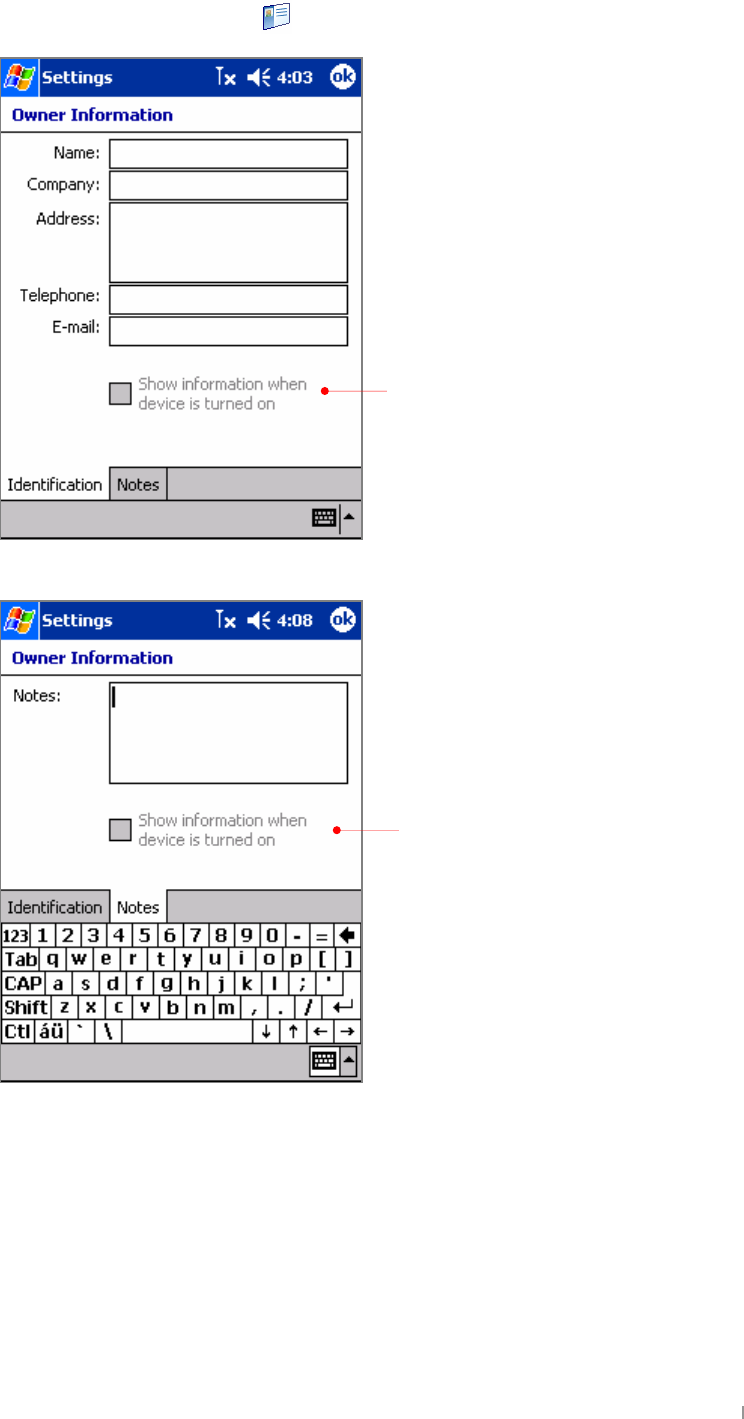
Chapter 6 Configuring Device 6-5
Tap the Owner Information ( ) icon to enter your personal information.
Select this option box to show this
information when device is turned on.
Select this option box to show this
information when device is turned on.
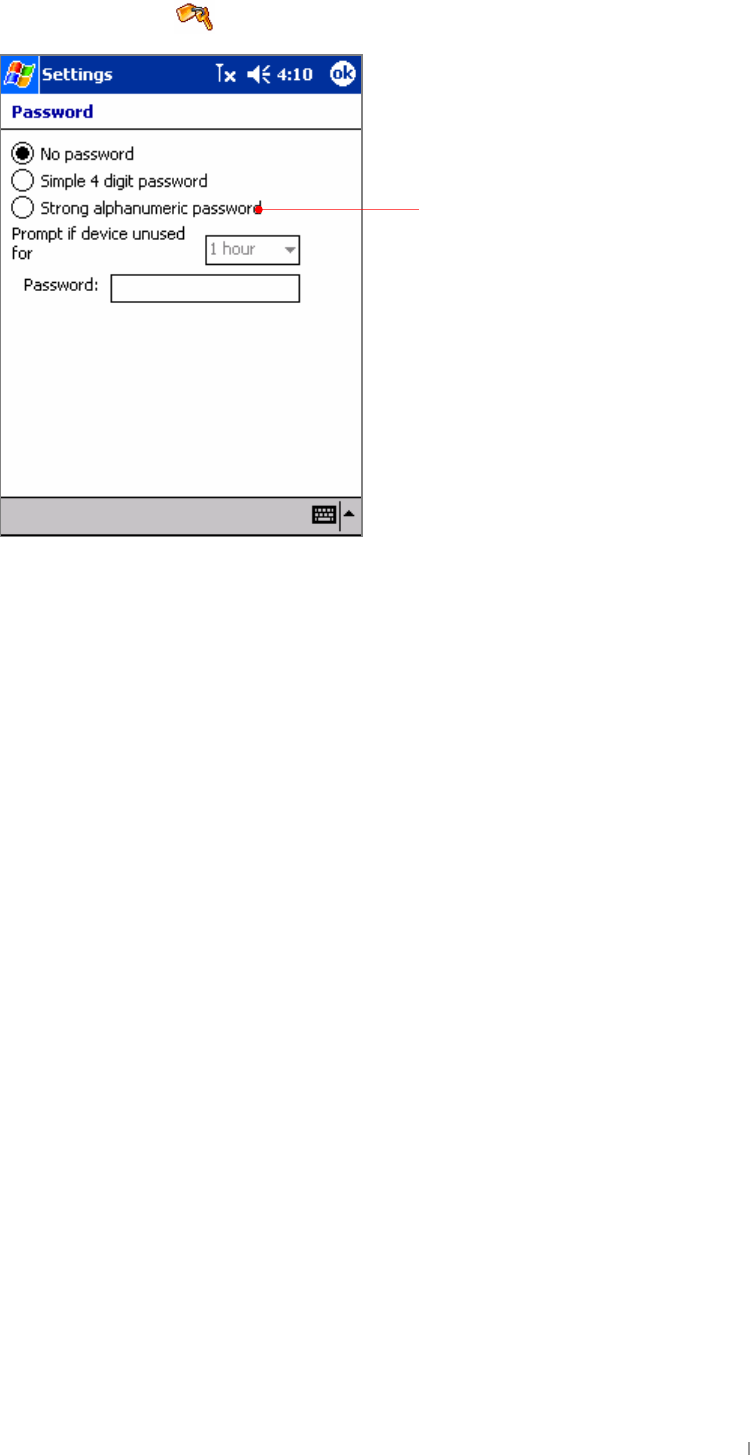
User’s Manual 6-6
Tap the Password ( ) icon to change a password.
When you select the Strong
alphanumeric password item, you
have to enter the 7-digit password: a
combination of the English upper
case, lower case letters.
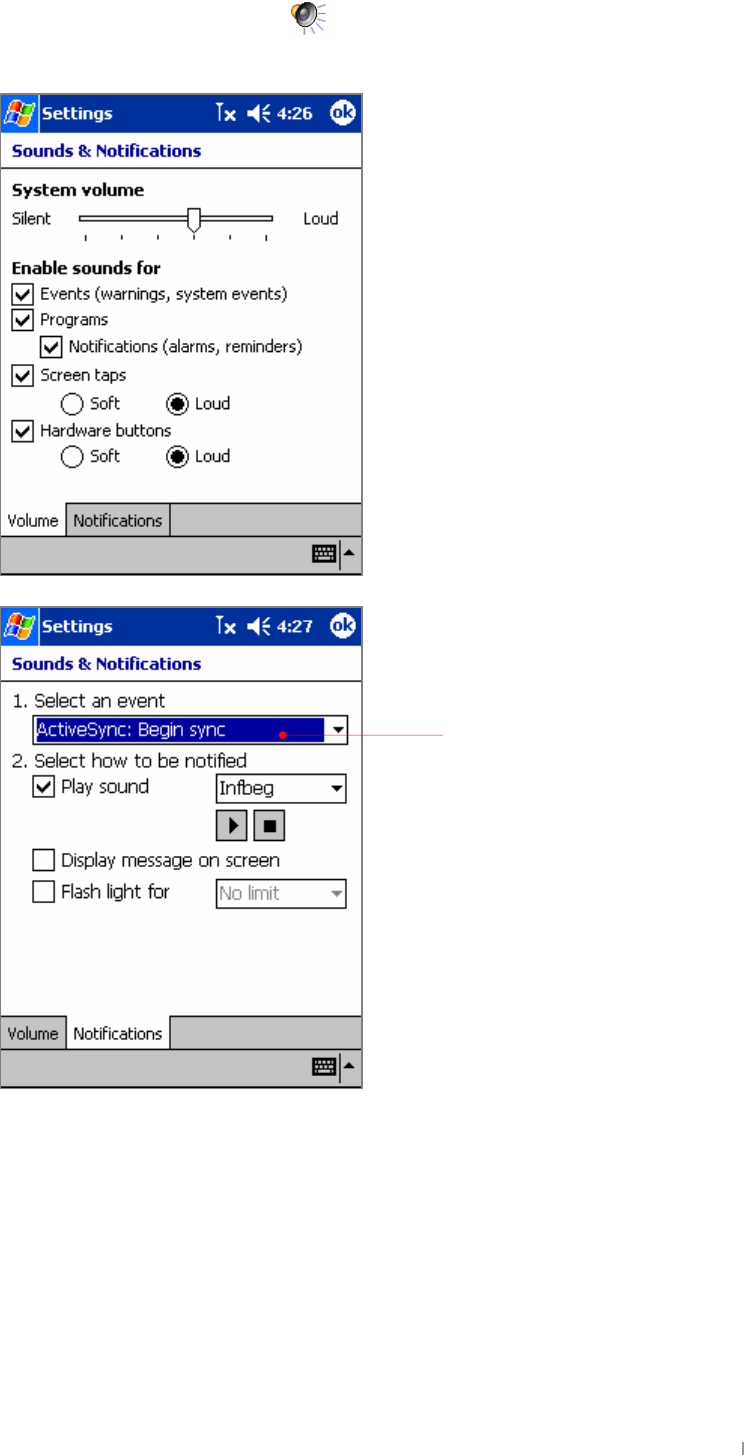
Chapter 6 Configuring Device 6-7
Tap the Sounds & Notifications ( ) icon to adjust sounds that is enabled for events,
programs, screen taps and hardware buttons.
According to each event, select the
corresponding sounds or
notifications.
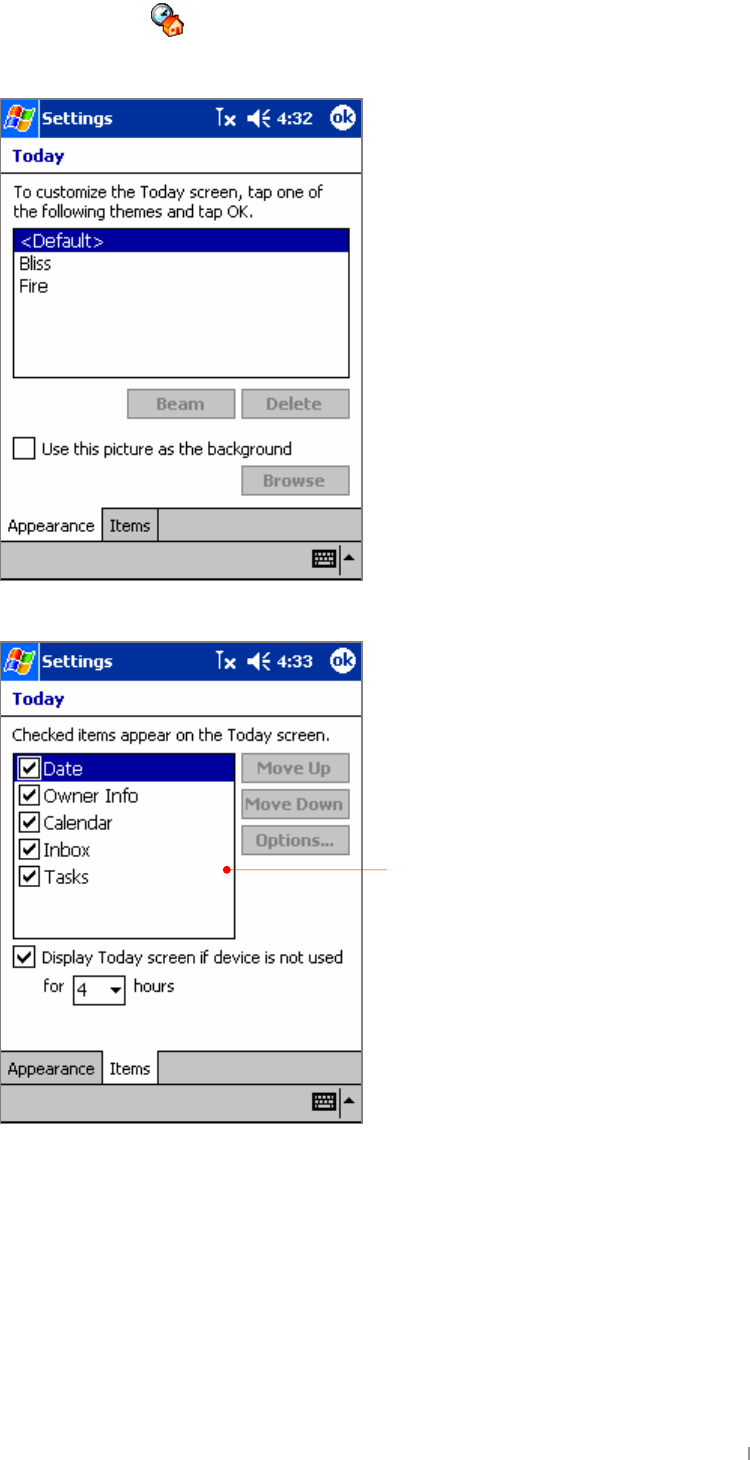
User’s Manual 6-8
Tap the Today ( ) icon to use an image file as the background and select programs
that appear on the Today screen.
Select items listed to show them on
the Today screen.
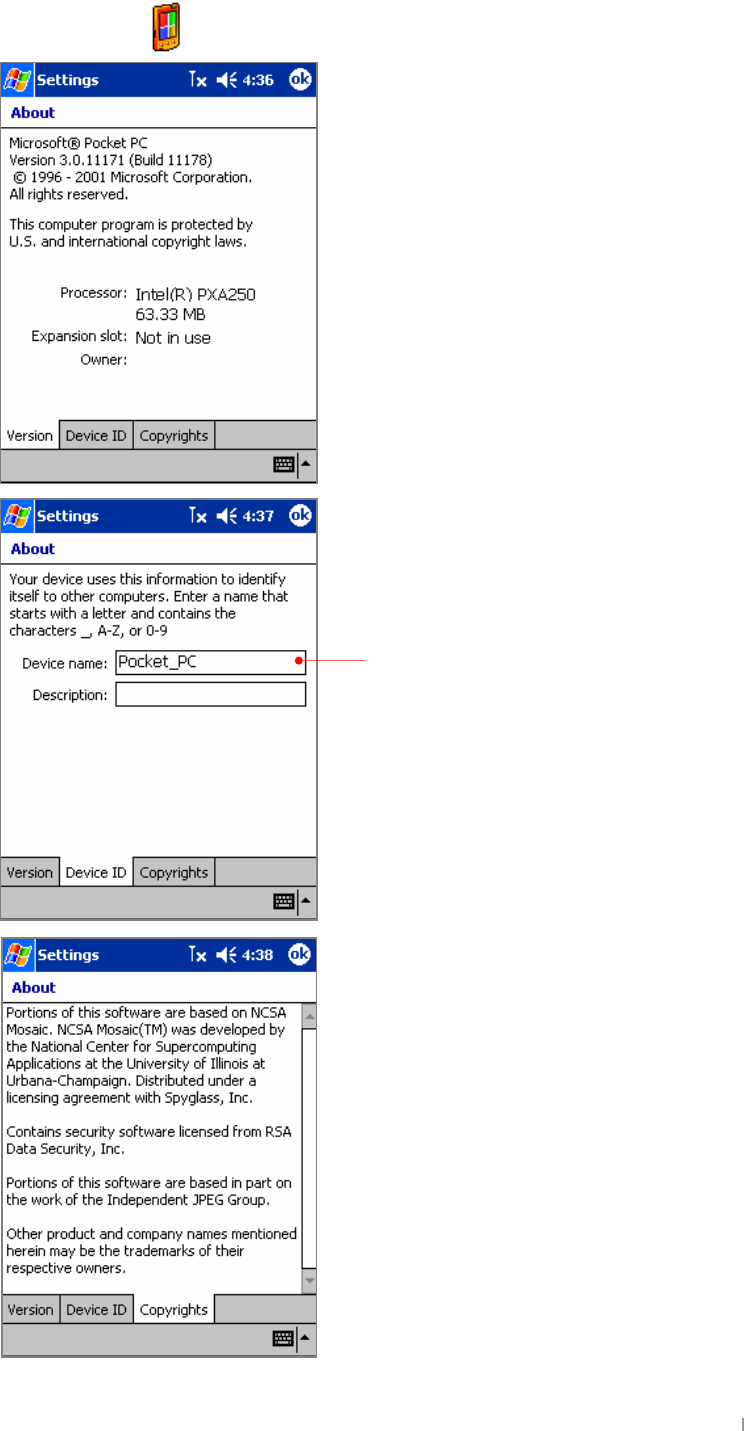
Chapter 6 Configuring Device 6-9
2. the System tab
Tap the About ( ) icon to adjust the About screen.
While synchronizing, this will be
used for identifying itself and
establishin
g
a
p
artnershi
p
.
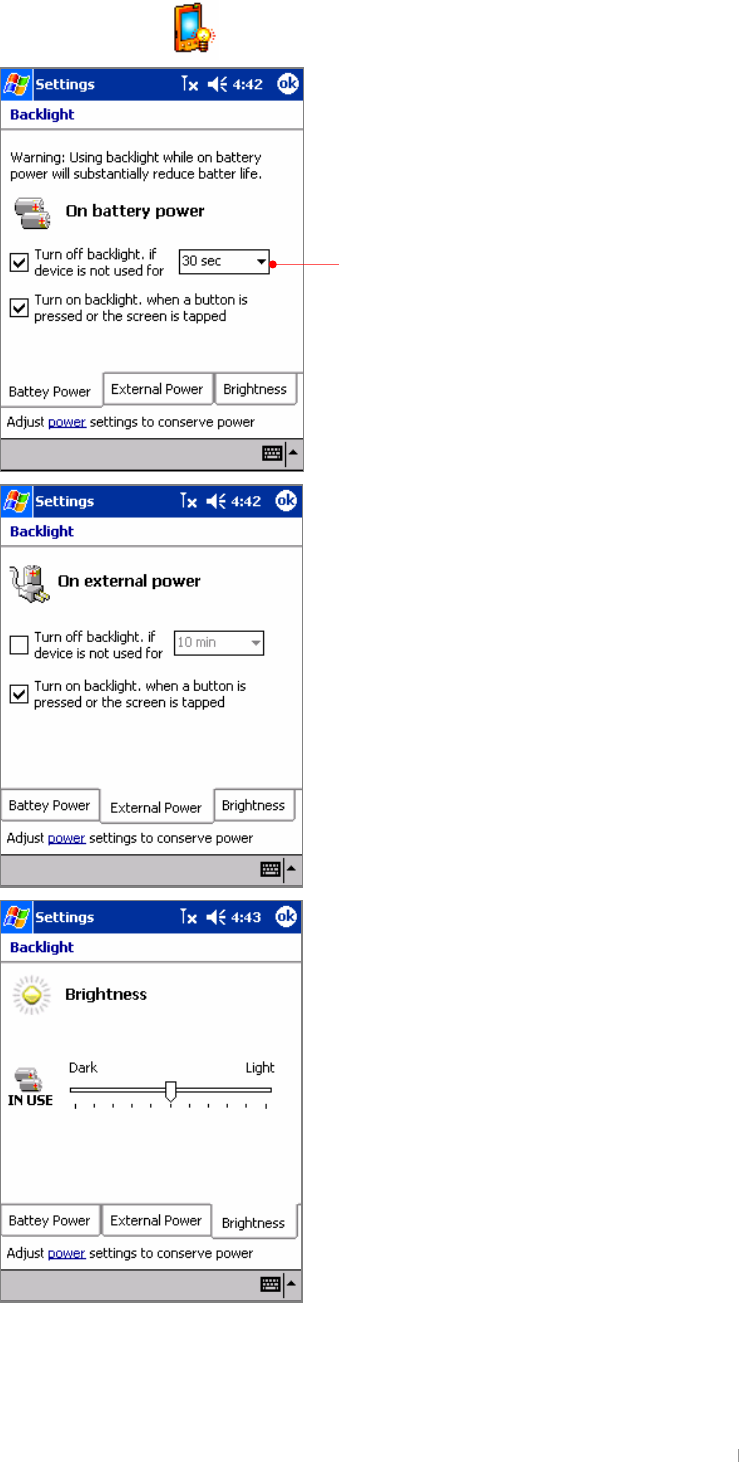
User’s Manual 6-10
Tap the Backlight ( ) icon to adjust the backlight.
It is recommended to conserve your
battery life that you turn off backlight
if device is not used for the time you
select here.
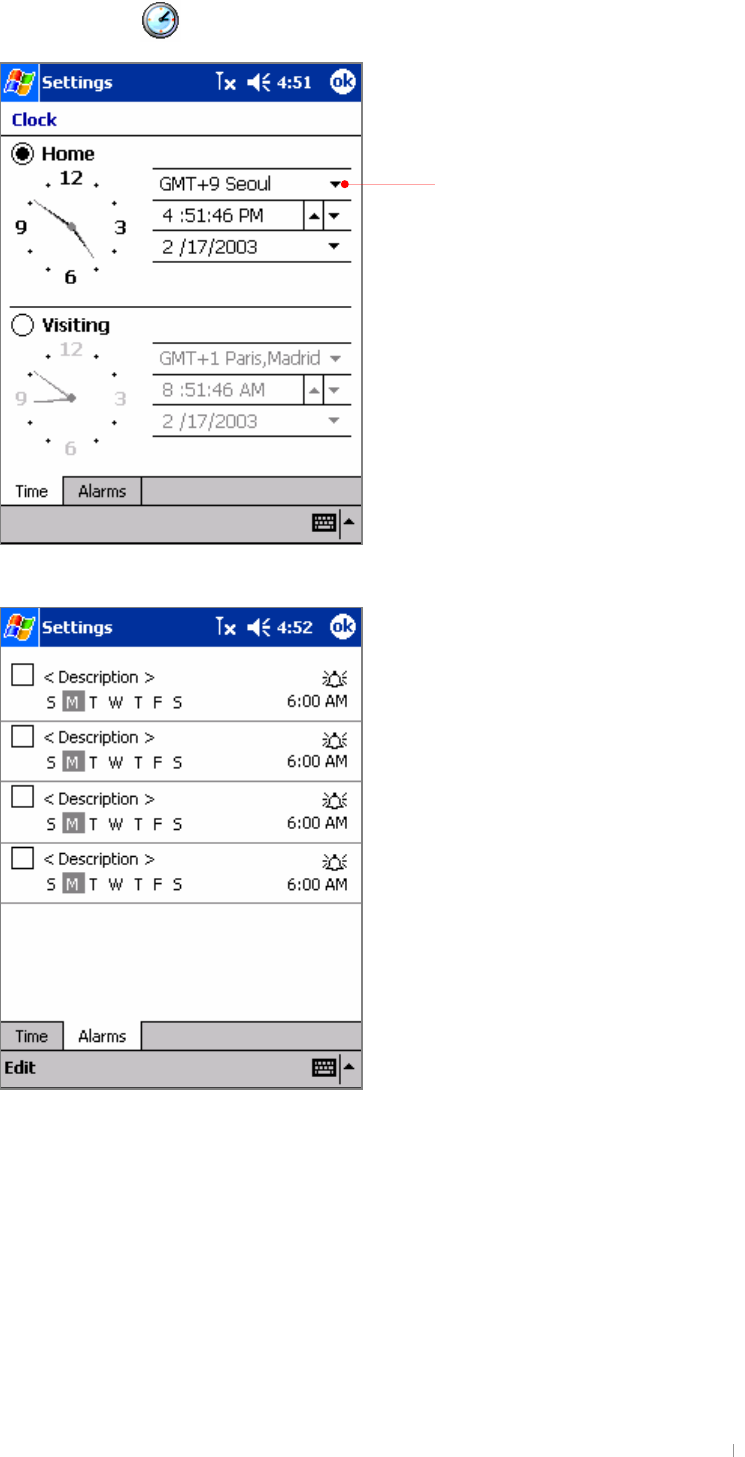
Chapter 6 Configuring Device 6-11
Tap the Clock ( ) icon to adjust the current time and alarm.
Select the right one according to where
you stay.
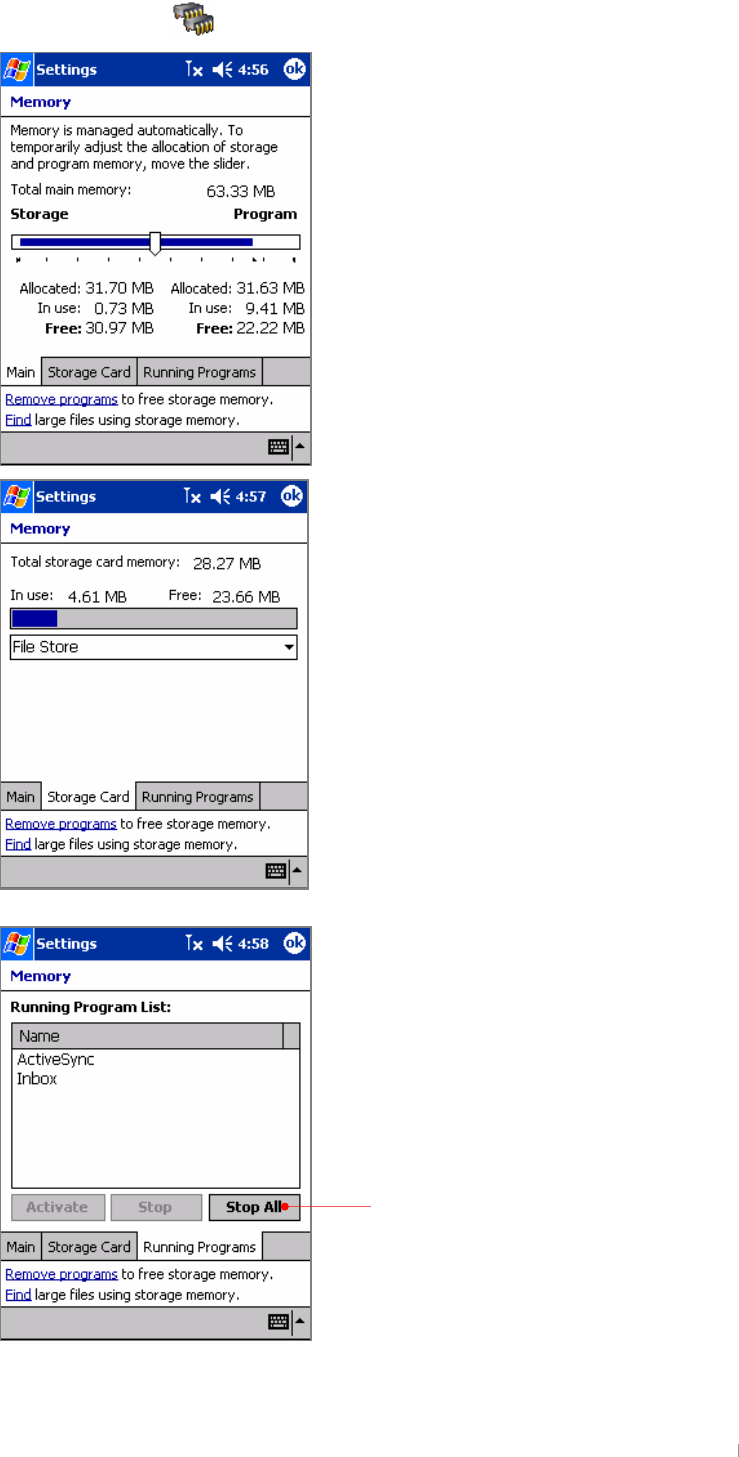
User’s Manual 6-12
Tap the Memory ( ) icon to adjust the allocation of memory temporarily.
To conserve the program memory, you can
stop programs that are not used from.
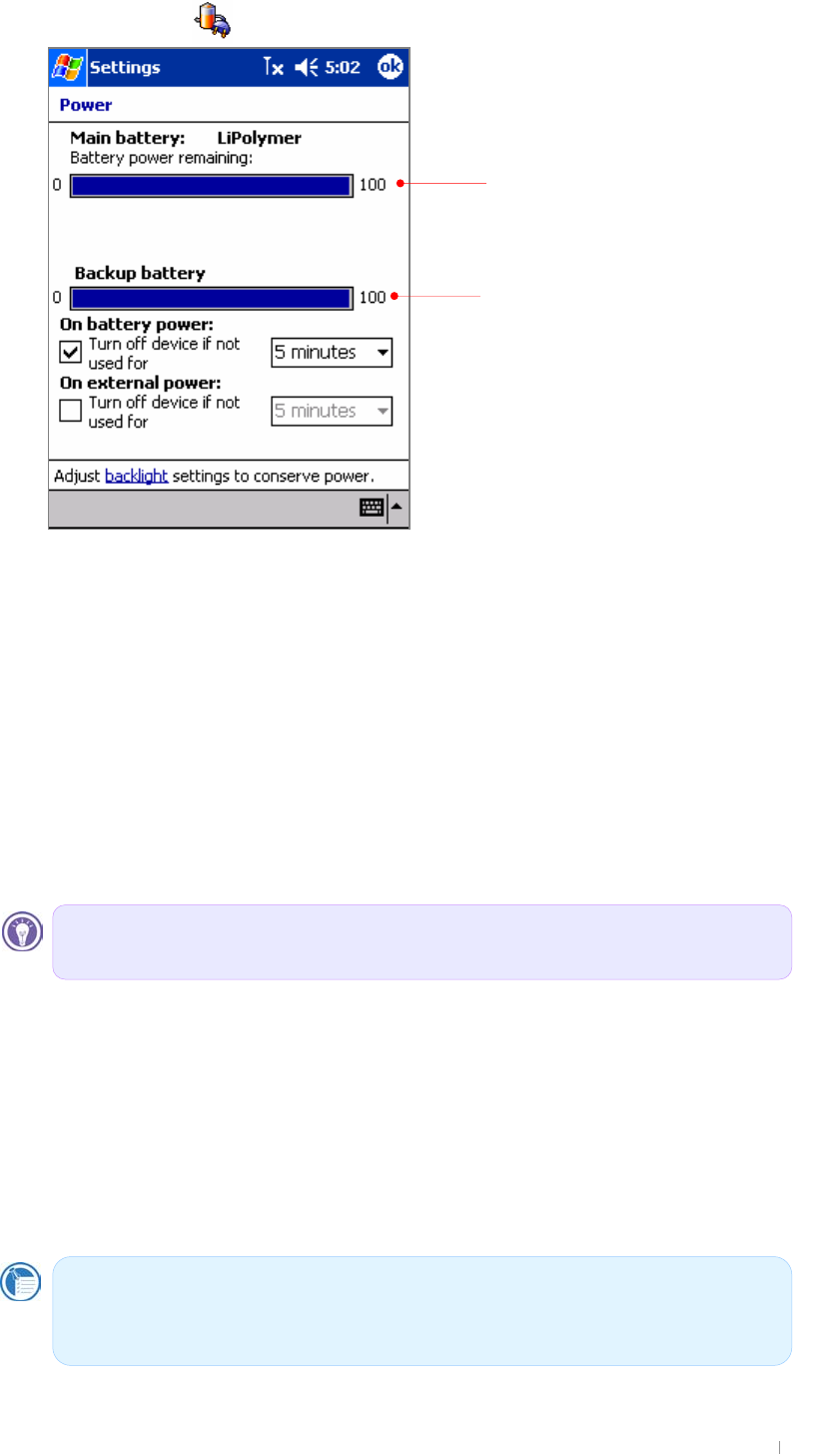
Chapter 6 Configuring Device 6-13
Tap the Power ( ) icon to see the status of battery.
Because the data and files you save on your device are stored in RAM, maintaining a
continuous power supply at all times is extremely important. If your device runs out of
power, all information stored in RAM is lost. Although Microsoft Windows for Pocket PC
and the preinstalled programs will not be erased, any information you have entered,
programs you have added, and customized settings are erased if you lose power.
Data stored in the File Store folder(NAND Flash) or on a SD card will be saved, even if
your device loses power. To protect your data, use the pocket backup application or
Microsoft ActiveSync Backup to back up regularly to the File Store folder(NAND Flash)
or to a SD card.
How long you can operate your device without recharging the battery depends on the
features and functions you use most.
When your device displays a dialog box warning of low power, you should respond as
soon as possible by recharging the battery. If you continue to use your device until
power reaches a critical low condition, a “Battery very low” message appears, and the
device shuts down automatically. You will be unable to use your device until you connect
to external power for charging.
Because the battery is charged automatically whenever your device is connected to ac
power, simply connect the AC power adapter or put your device on the USB cradle to
recharge it when the power is low.
Display the status of main battery.
Some functions, such as listening to music or using SD cards, use considerable
power and may reduce this time significantly.
While your device is connected to AC power, the charging status LED indicates
as follows :
Red : charging(not fully charged), Blue : fully charged.
Display the status of backup battery.
While being seated on cradle, if main battery
is not fully charged, it will move from 0 to
100% on the charging bar
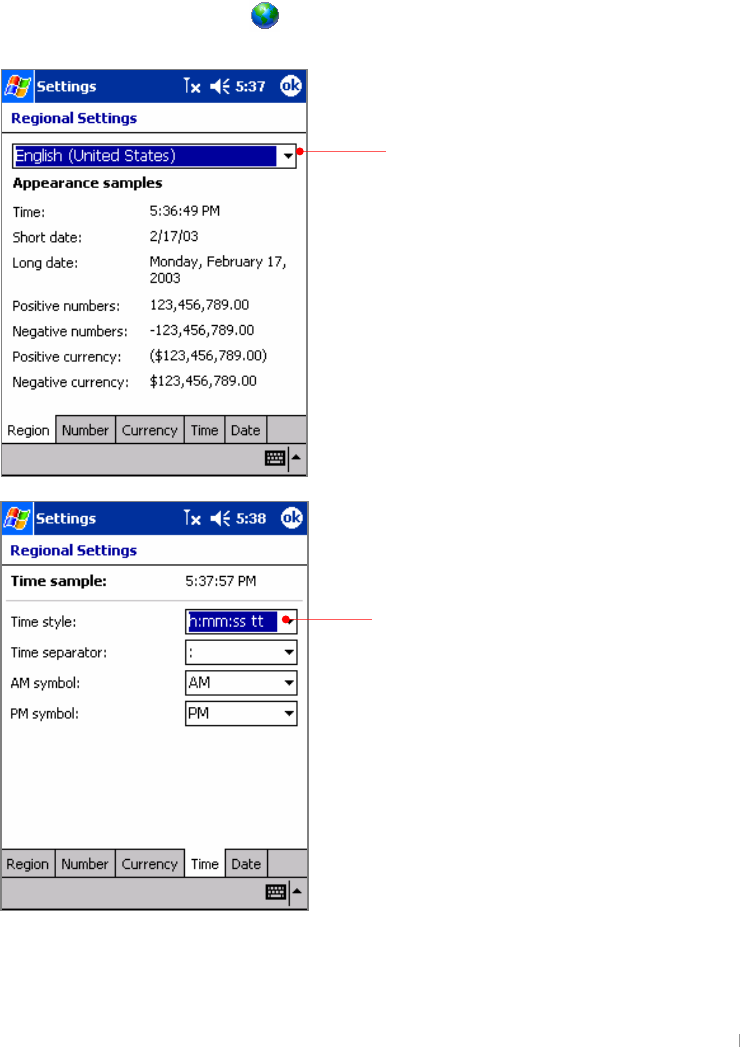
User’s Manual 6-14
Power Tips
⊙ Follow these tips to ensure the longest use of your device between charges:
Turn off the display manually.
If you are playing music or using other functions that do not require the display, turn
off the display by pressing and holding the power button. (Turn on the display by
pressing and holding the power button again.)
Turn off sounds.
Use the settings to mute the speaker, or use the Sounds & Notifications settings to
turn off all but the most necessary system sounds.
Avoid using SD card while on battery power.
Most SD cards use considerable power and will quickly drain your battery.
Tap the Regional Settings ( ) icon to adjust the time, number, especially period,
money and data type.
Select the type of time display.
Select where you stay.
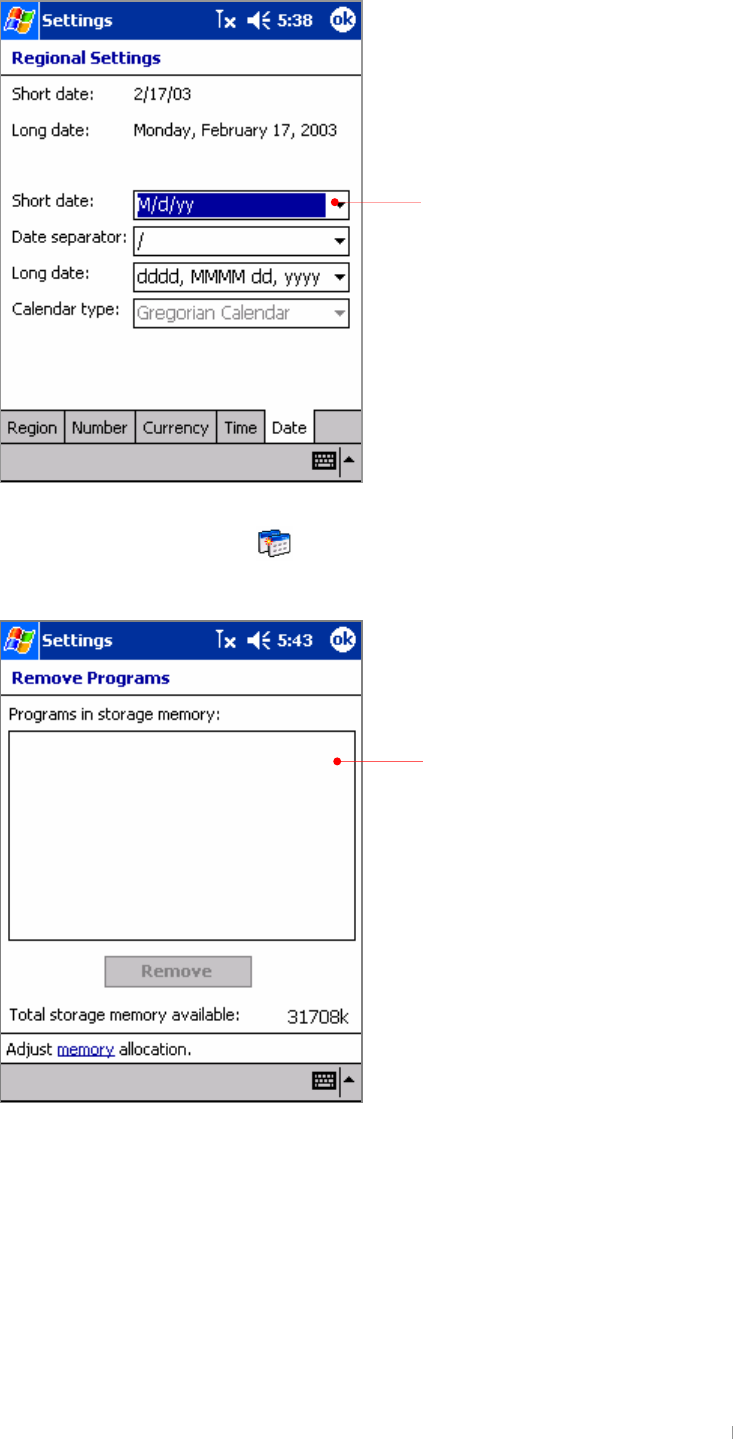
Chapter 6 Configuring Device 6-15
Tap the Remove Programs ( ) icon to remove the programs that are installed on
your device from the storage memory.
Select the type of date display.
When the storage memory is
short, remove the program
installed on your device.
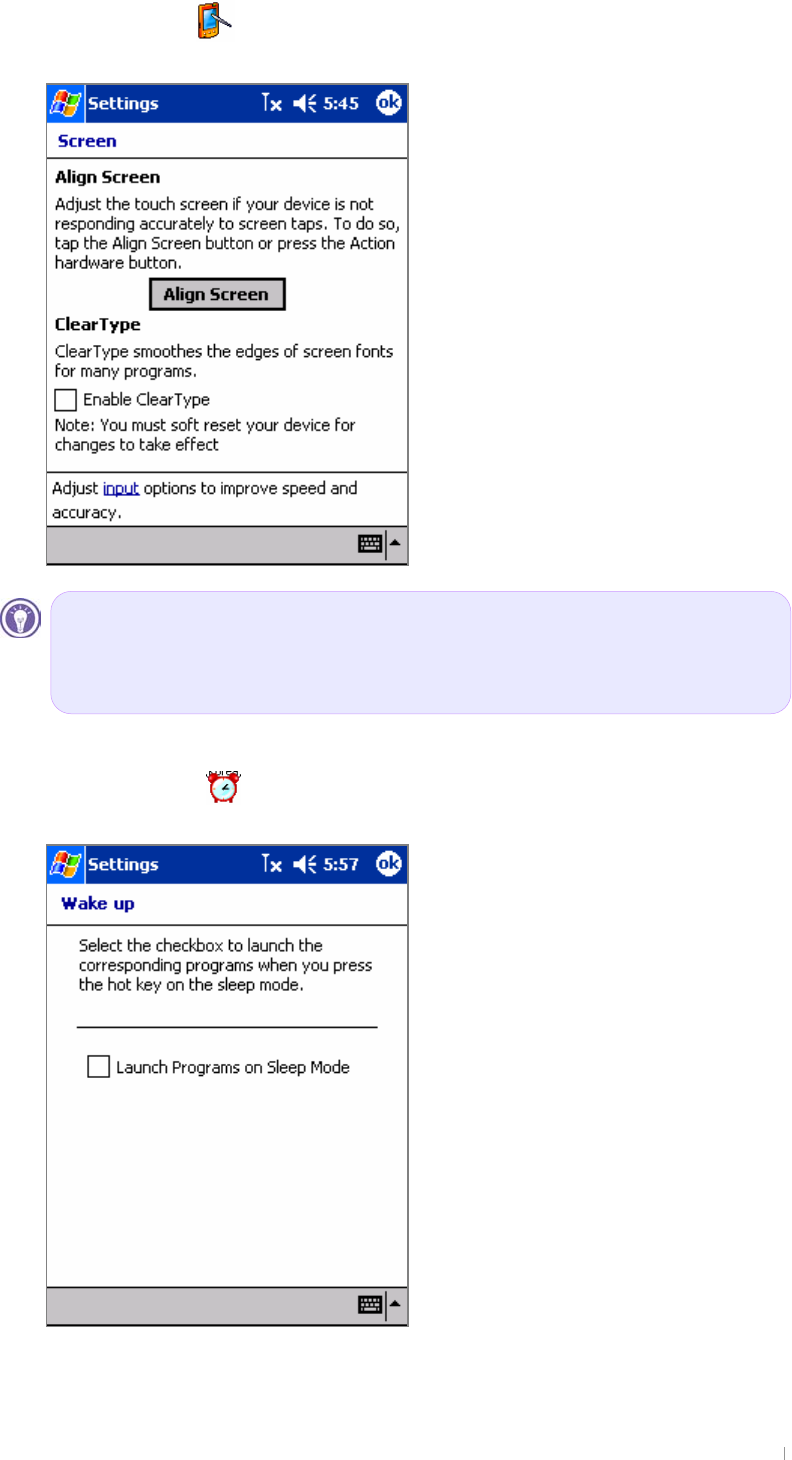
User’s Manual 6-16
Tap the Screen ( ) icon to adjust the touch screen if your device is not responding
accurately to screen taps.
Tap the Screen ( ) icon to launch the corresponding program when you press the
hot key on the sleep mode.
This is easy way how to align screen during using other programs.
Press down the up button of the up
/
down control and press the power button to
have the Align Screen displayed and press the Enter button to begin the action of
aligning screen.
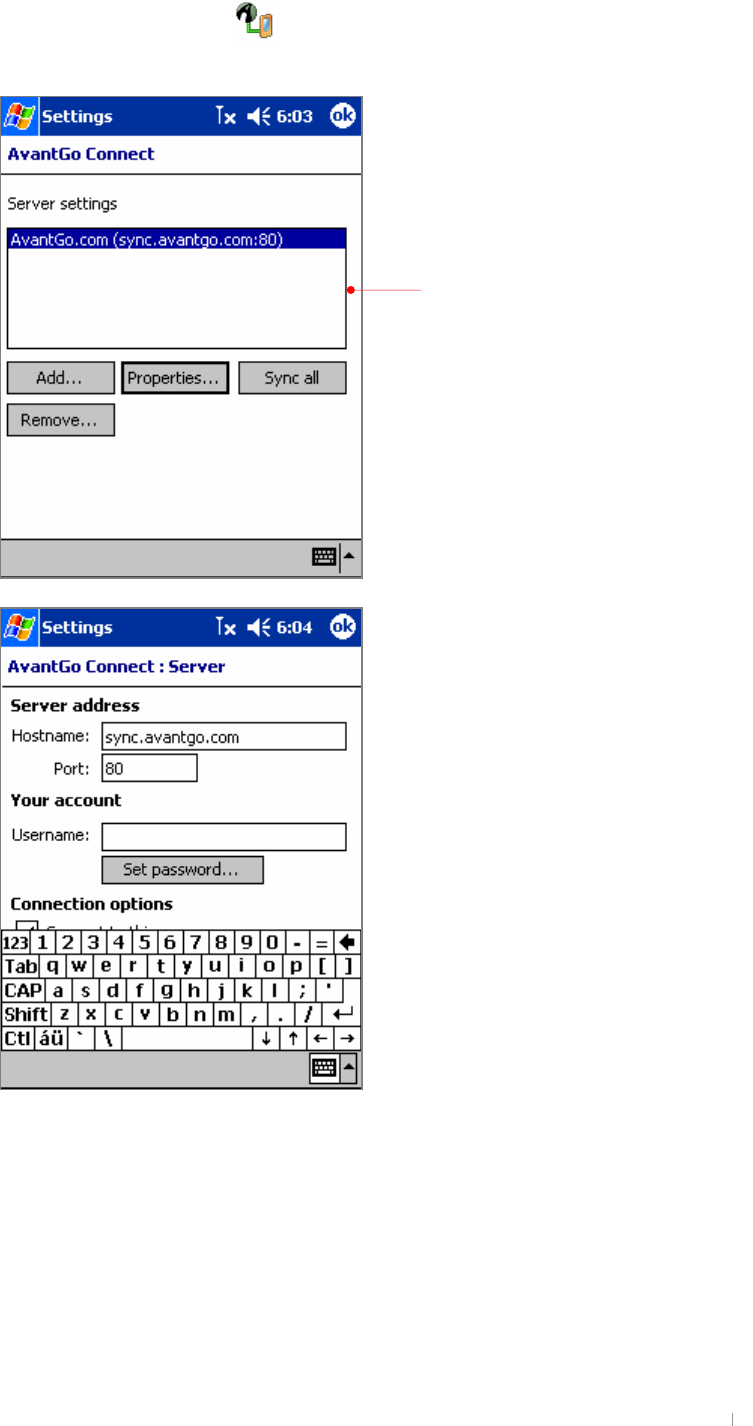
Chapter 6 Configuring Device 6-17
3. the Connections tab
Tap the AvantGo Connect ( ) icon to set the options for AvantGo that allows you to
browse the Internet offline.
You can add or delete Website displayed
on the list and also set the options for
each Web site.
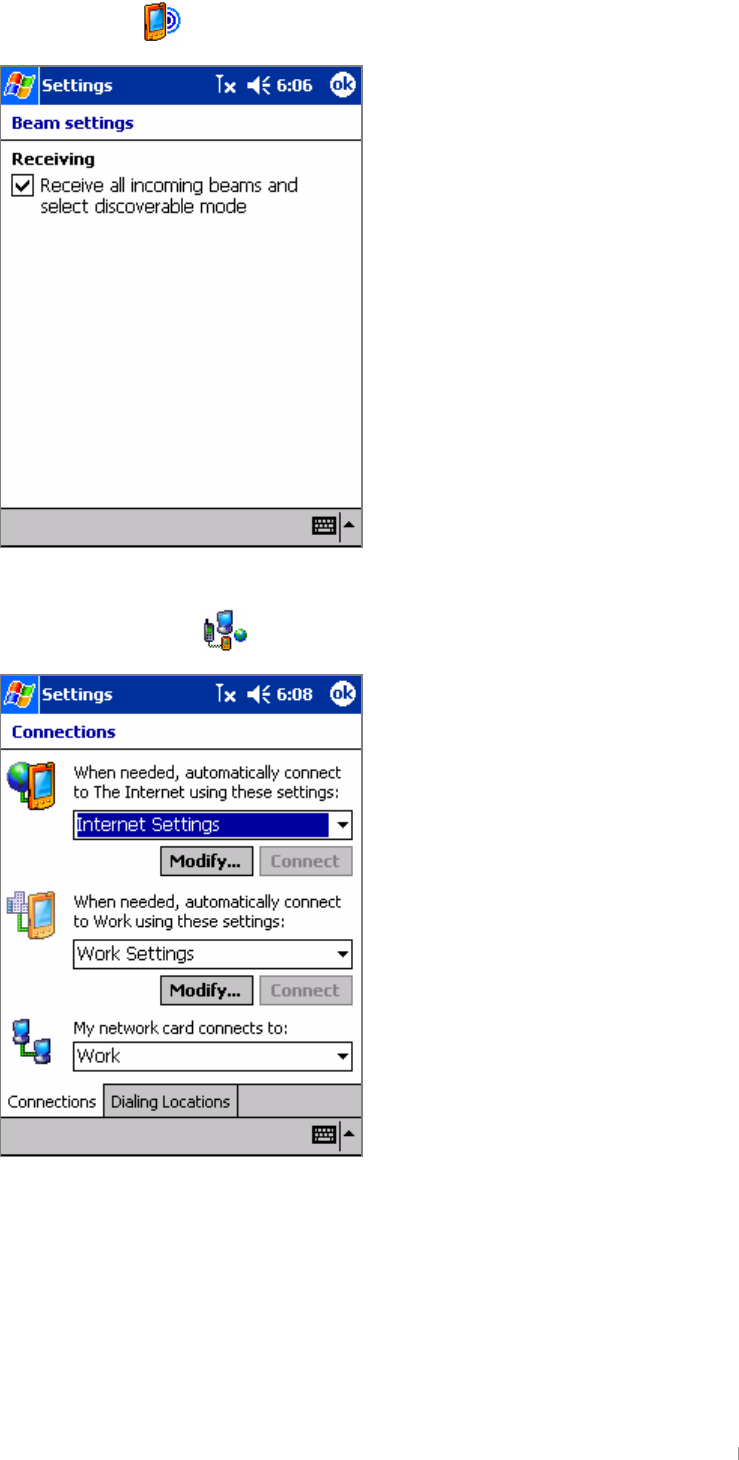
User’s Manual 6-18
Tap the Beam ( ) icon to adjust the beam settings of your device .
Tap the Connections ( ) icon to set the options for a modem connection .
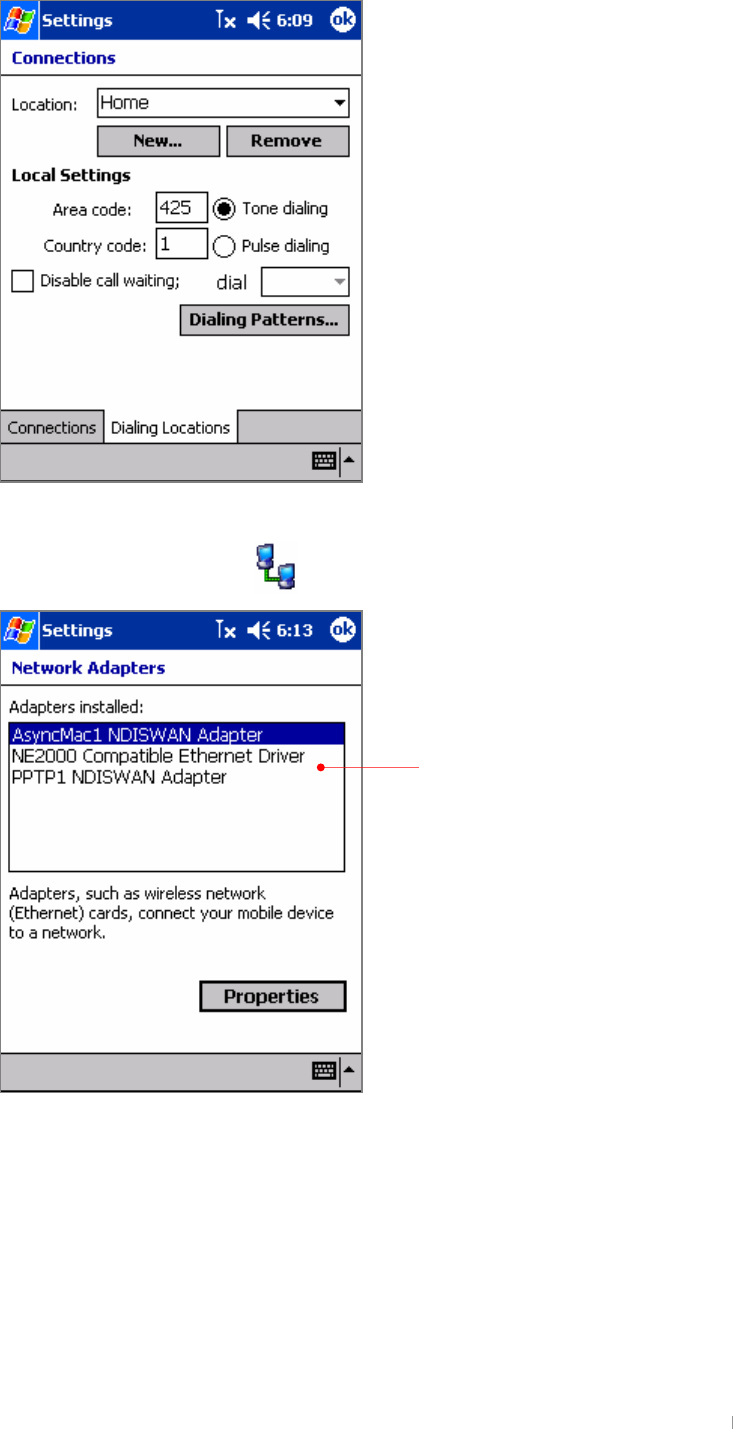
Chapter 6 Configuring Device 6-19
Tap the Network Adapters ( ) icon to change the settings for network adapters .
To change the options of a network driver,
select the driver first and tap the
Properties button. The drivers on the list
are installed as defaults, and you can
install the corresponding drivers that come
with an adapter that you purchase.

User’s Manual 6-20
Managing Memory
Your device uses three kinds of memory: 64 MB of ROM, 64MB of storage and program
memory (RAM), and optional SD memory cards.
Storage and Program Memory (64MB of RAM)
The volatile RAM memory on your device is allocated between storage memory and
program memory. The operating system automatically manages the allocation between
storage and program memory; however, in some situations—such as when memory is
low—it may not be able to adjust the memory properly. Maybe you will find a little short
memory because of the bad sectors among 64MB of RAM.
If you receive a message stating that storage or program memory is unavailable, try the
following solutions.
⊙ To increase storage memory, you can
Move files or programs into the File Store(NAND Flash).
Buy an optional SD extended memory card, and move files from internal memory to
the card.
Remove Web pages stored for viewing offline in Internet Explorer folders.
⊙ To increase program memory, you can
Use Task Manager or the Memory settings to stop programs you are not currently
using. In most cases, programs automatically stop to free needed memory. However,
in some situations, such as when a dialog box is waiting for a response, the program
may not be able to stop automatically.
Remove your device from the cradle, remove the SD card (if inserted), and reset your device.
ROM(32MB NAND Flash out of 64MB)
This uses nonvolatile memory; that is, it will not be erased if your device loses power. In
other words, ROM is composed of 32MB NOR memory and 32MB File Store(NAND
Flash). The system codes and applications, including Inbox, Tasks, Calendar and
Contacts, etc., are installed on the NOR memory so that you cannot erase or install
those applications. However, the phone program is installed on the File Store(NAND
Flash) and you can use the rest memory of the File Store(NAND Flash) to store your
most important files or as a location for your backup file.
However, when you erase the Cyberbank and CallNotes folder of the File Store memory,
you have to upgrade your device. Maybe you will find memory that is less than 32MB of
File Store because some memory is used on system.
The File Store appears under the My Device folder of your device. Files stored in
the File Store are not included when you back up your files using ActiveSync or
the pocket backup application.

Chapter 6 Configuring Device 6-21
For more information on backing up your device to the File Store(NAND Flash), see
“Backing Up and Restoring Data” in chapter 4.
SD Memory Cards
SD memory cards are small, removable flash storage cards that enable you to expand
the memory of your device. You can use SD memory cards for backup storage, archives,
or to transfer large files to other devices. SD cards can be purchased from a variety of
third-party vendors.
The File Store is non-volatile memory so that it will not be erased after
performing hard-resetting. However, when you mistakenly erase the sub-folder
of your File Store folder where the some programs are installed from your
Companion CD, you have to re-install them from Companion CD.

Chapter 7 Using the Mobile Phone 7-1
Your device has a built-in CDMA module that supports wide-range data communication
and additional features including SMS (Short Message Services), along with voice calls.
These features save you the trouble of having to purchase another cellular phone with a
phone number. Remember that you have no other right to copy the ESN number against
the communication law.
⊙ This chapter includes information on:
Phone Program
SMS : Short Message Service
Chapter 7
Using the Mobile Phone
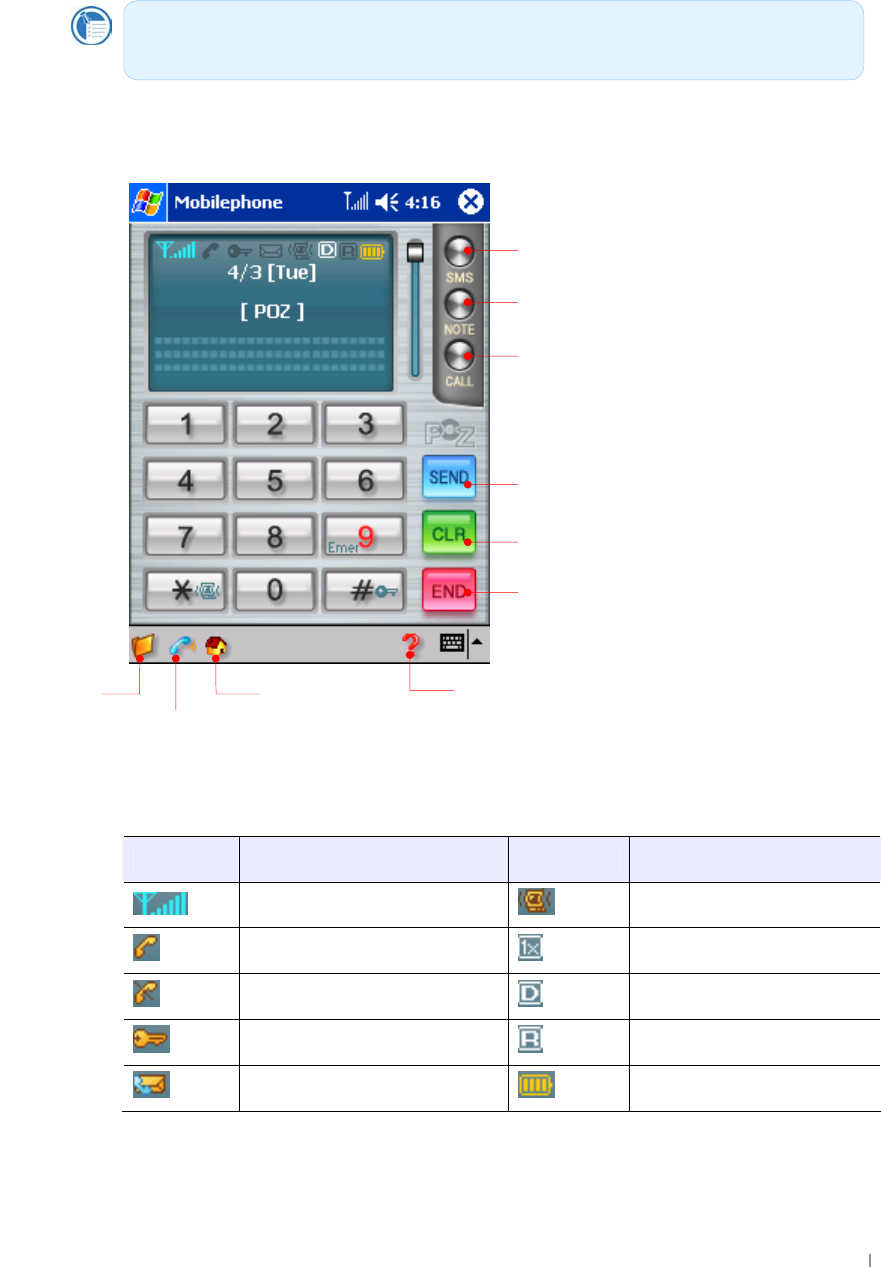
User’s Manual 7-2
Phone Program
This phone program enables you to place a call.
Use the dial pad to enter the phone number and tap the Send button.
The Phone display
Indicators in the Phone display
Indicators Description Indicators Description
Signal Intensity Vibrate mode
Service area 1x network
Not in service area 95A network
Lock Roaming
Voice message or SMS Battery charging status
Short Message Service
Note
Call
Send button
Clear button
End button
Recently Dialed Phone display
Contacts
Settings
You can communicate with other persons through the speaker and microphone
and the optional earphone that should be inserted into earphone jack.
Display Own Number and Version
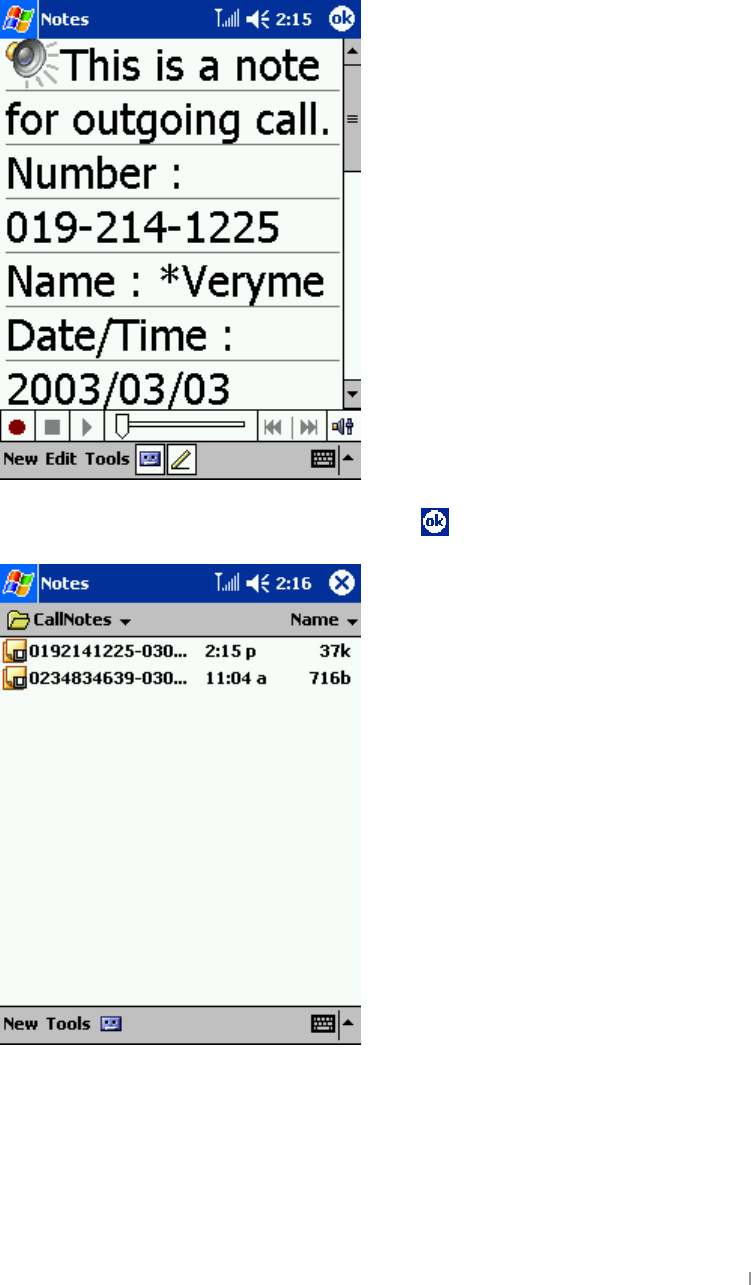
Chapter 7 Using the Mobile Phone 7-3
Using the NOTE button
Here is how we can use the NOTE button during a voice call.
When you need to make a note during a voice call, tap the NOTE button to open the note program that is
provided on your phone program. You can enter any contents you want and record your voice.
When you finish entering any contents you want, tap the button to display the folder(File
Store\CallNotes).
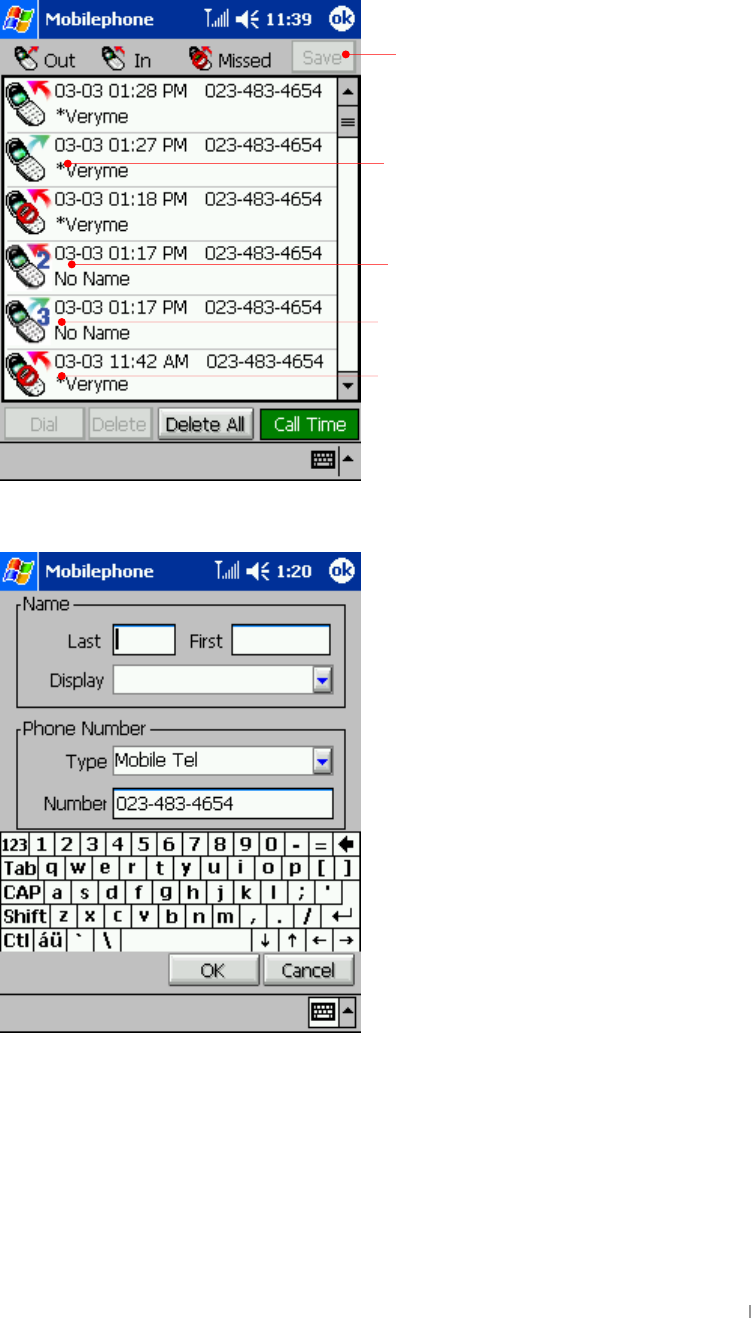
User’s Manual 7-4
Using the CALL button
Tap the Call button to display a list of recently incoming, outgoing and missed calls,
including caller information and call time since initializing your phone.
Select the item that is displayed as No Name and tap the Save button to save a corresponding name.
Add the corresponding name for it and tap OK.
Tap to save to Contacts
Three-way calling
Call waiting
Missed call
Outgoing call
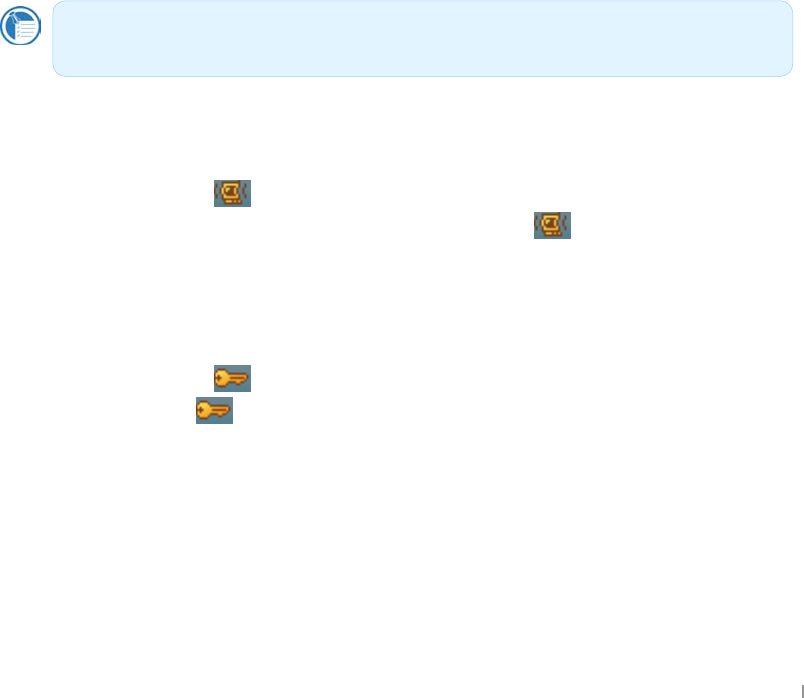
Chapter 7 Using the Mobile Phone 7-5
Using the SEND button
You can make a call as follows :
z Enter phone number and tap the SEND button to make a call.
z When you tap the SEND button shortly once, the number you last called
appears on the screen and if you tap this button once more, you are connected
to this number.
z You can use the up/down control to have the recently dialed numbers displayed.
When you press the up button or down button of the up/down control, the
number you last called appears on the screen. If you press the Enter button,
you are connected to this number.
Using the CLEAR button
If a mistake is made while dialing, tap the Clear button to clear the last digit, or tap and
hold the Clear button to clear all the digits.
Using the END button
Tap the END button to end a call.
Tap and hold the END button for a little longer (2 or 3 seconds) to turn the CDMA
module off so that you cannot make a call, send SMS messages and browse the Internet.
Tap and hold the END button again for a little longer (2 or 3 seconds) to turn the CDMA
module on.
Using the Vibrate mode
Tap and hold the icon on the dial pad to turn the Vibrate mode on. Then you will be
able to feel vibrating on your device and also see the icon on the Phone status pane.
On this Vibrate mode, you will feel the vibration on your device when a call is coming.
Using the Lock button
Tap and hold the icon on the dial pad to turn the Lock mode on. Then you will be
able to see the icon on the Phone status pane. You cannot make any calls on the
Lock mode. When you want to get out of the Lock mode temporarily, enter the password
on your dial pad. Turn your phone program off and on to go back to the Lock mode. If
you want to get out of the Lock mode permanently (in stead of temporarily), tap and hold
the Lock button to have the password screen displayed. Then enter the password that is
set as “0000”.
You can not make a call, browse the Internet and send SMS messages while the
CDMA module is not on.
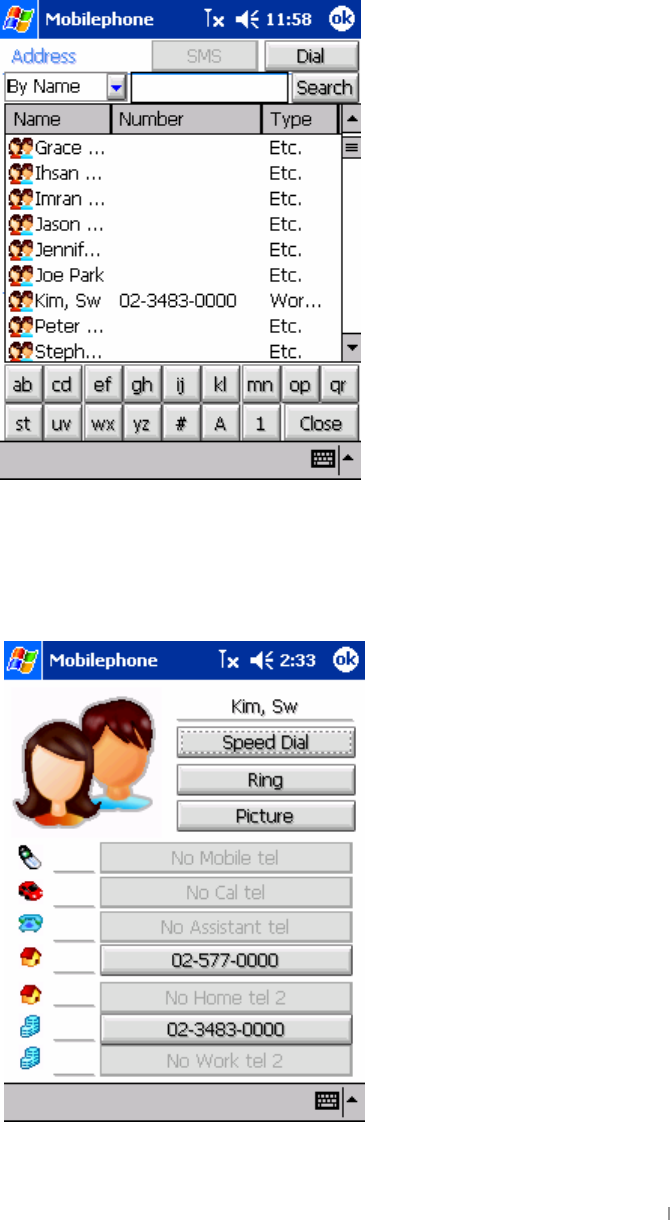
User’s Manual 7-6
Placing a call
You can place a call as follows :
z Use the dial pad to enter the phone number, including the area code and tap
the Send button.
z When you want to use the Contacts to place a call, tap the Contacts icon on the
Command bar.
Select a phone number you want and tap the Dial button on the upper-right
corner. You will see only one phone number for each person at this screen. If
you want to place a call with another phone number, double-tap the
corresponding contact to display the screen as below:
Tap a phone number you want to place a call automatically.
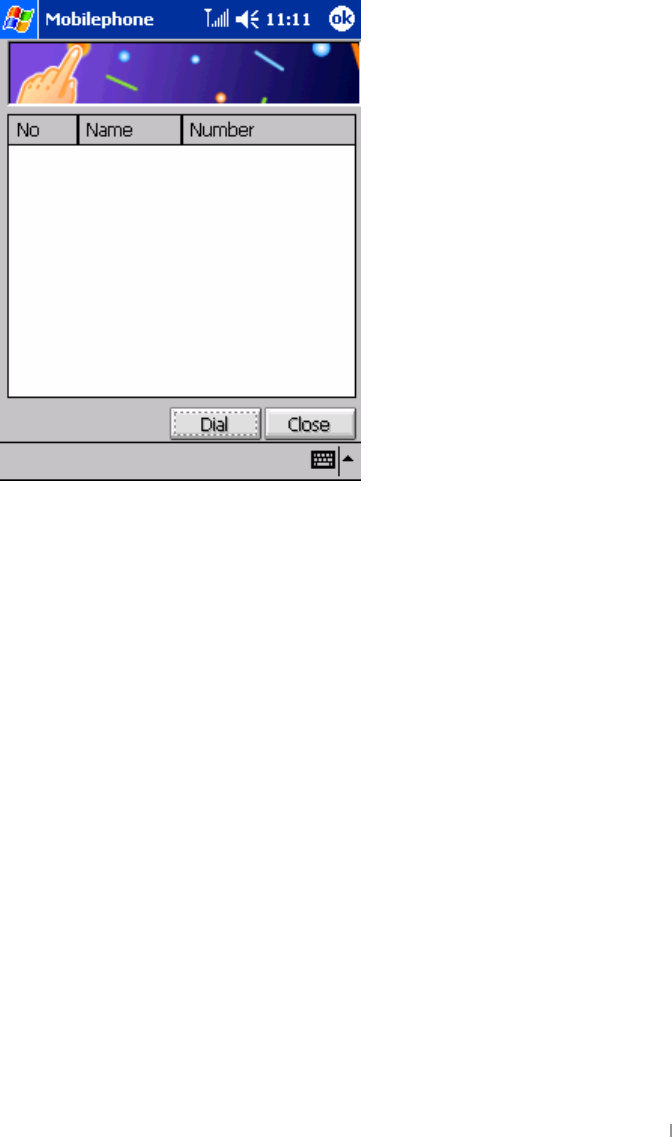
Chapter 7 Using the Mobile Phone 7-7
z Use speed dial numbers to place a call as follows:
9 One-digit number (0 ~ 9): Tap and hold (about 2 seconds) the
corresponding speed dial number.
9 Two-digit number (10 ~ 99): tap the first digit of the speed dial number,
and then tap and hold the second digit of the speed dial number.
9 Or tap the corresponding speed dial and tap the Send button.
If you don’t remember the corresponding speed dial, tap the Settings icon on
the Command bar > the User button and select the Speed dial icon.
Select the speed dial you want and tap the Dial button.
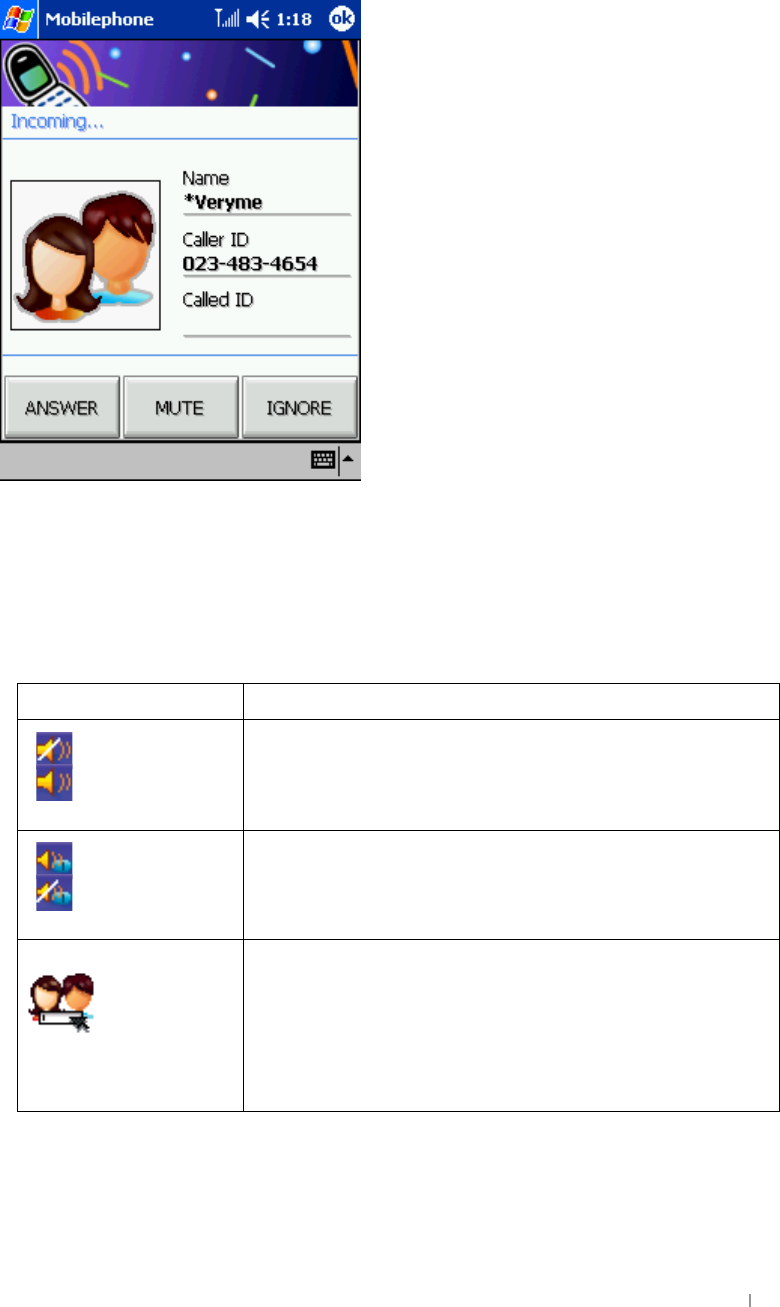
User’s Manual 7-8
To receive a call
When the incoming call is alerted with a flashing indicator and an audible sound or a
vibrating alert with the screen displayed as follows:
Tap the ANSWER button to receive this call, or tap the MUTE button when you don’t
want to hear the bell sound (but the caller can still hear the outgoing bell sound) or tap
the IGNORE button to disconnect the call without answer.
While communicating through your phone module, you will also see icons on the Command bar as follows:
Icons Descriptions
Mute
Un-mute
Tap one icon to have the other icon displayed.
You can un-mute while communicating.
Key Sound
Remove Key Sound
Tap icon to have the other icon displayed.
You cannot hear any key sound while tapping any key on your dial
pad.
User Information Tap this icon to have the User Information screen displayed and you
can select any number you have entered before to send out.
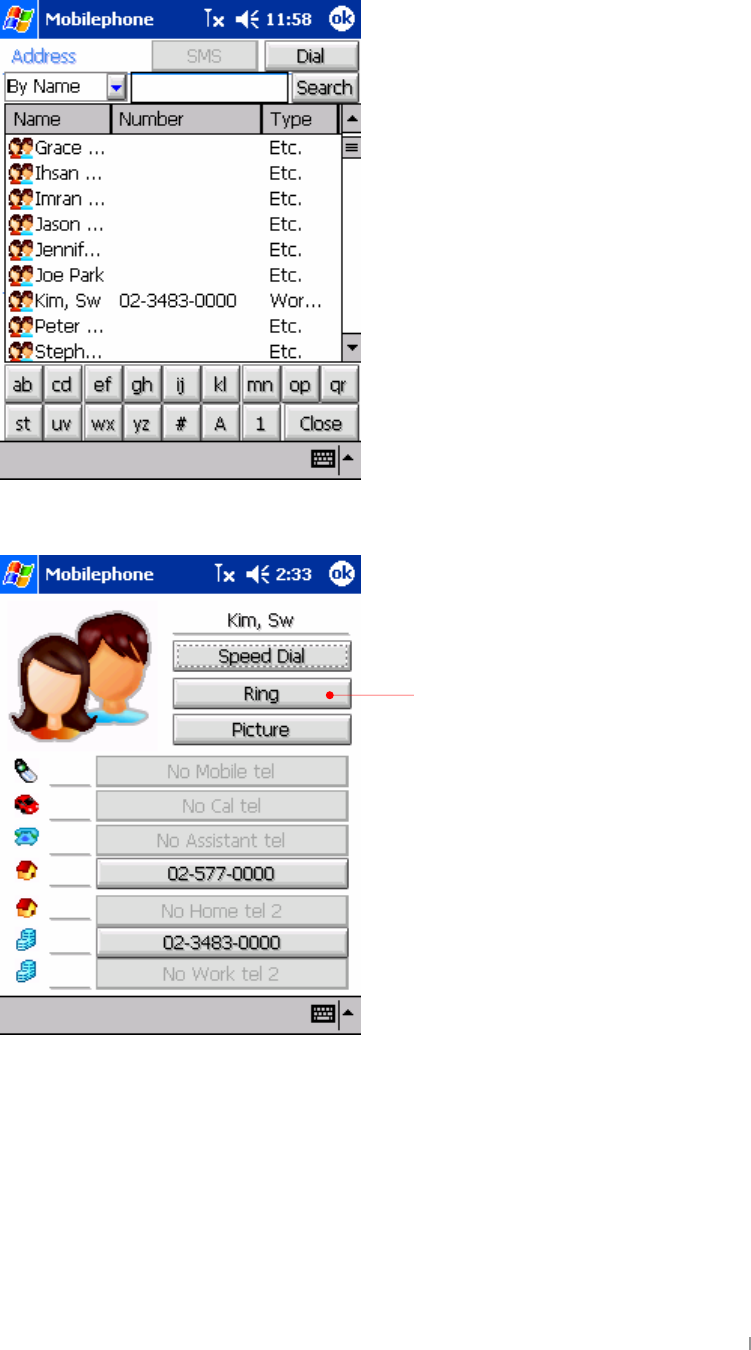
Chapter 7 Using the Mobile Phone 7-9
Make a speed dial using Contacts
Tap the Contacts icon on the Command bar.
Double-tap a contact you want to make a speed dial for.
Tap the Speed dial button.
Tap to assign a specific bell sound to the
specific person.
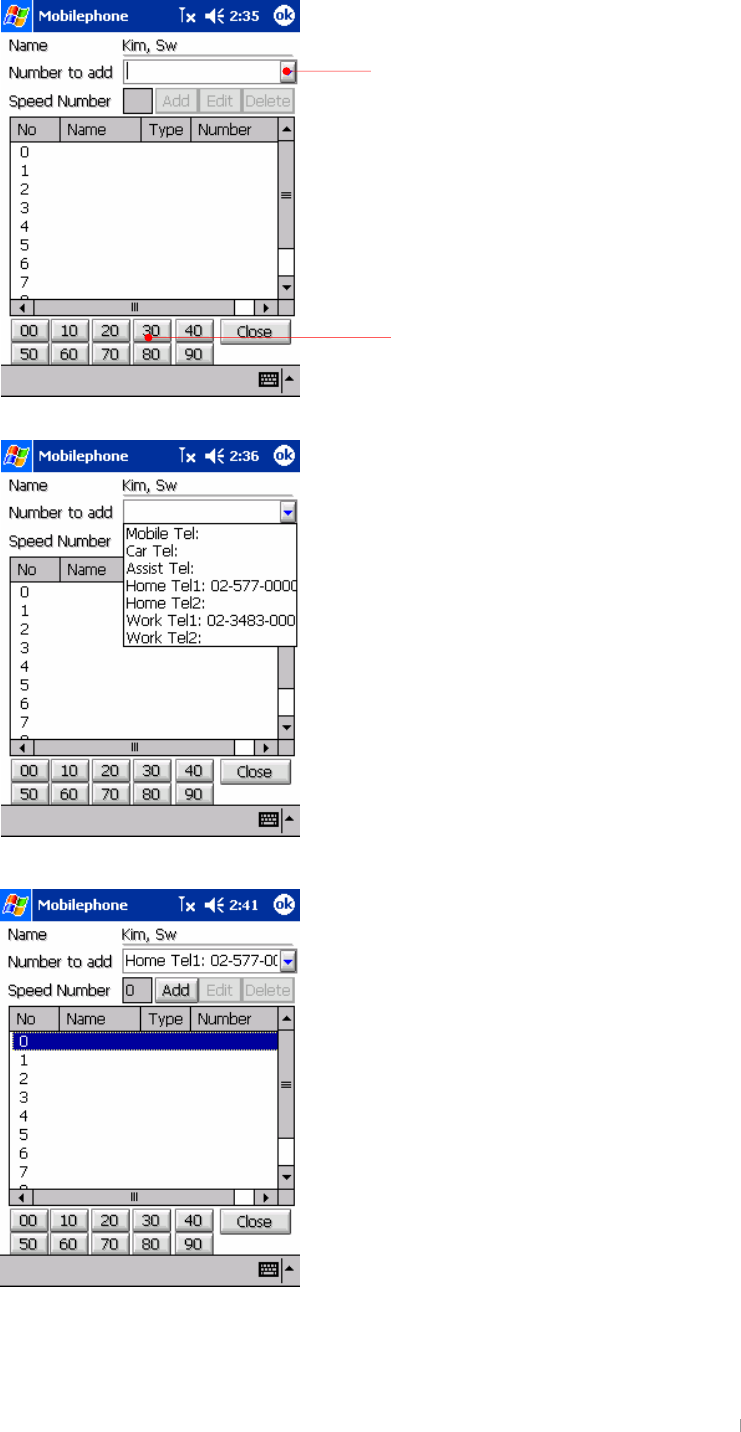
User’s Manual 7-10
Tap the arrow to select a phone number that is saved for the specific person.
Select the phone number you want and select speed dial number on the list as shown below.
Tap the Add button to add this number to the Speed Dial list
Tap the arrow to select a phone number
that is saved for the specific person and
enter the speed dial number and tap the
Add button.
If you have too many speed dial
numbers, you can use these buttons as
shortcut buttons.
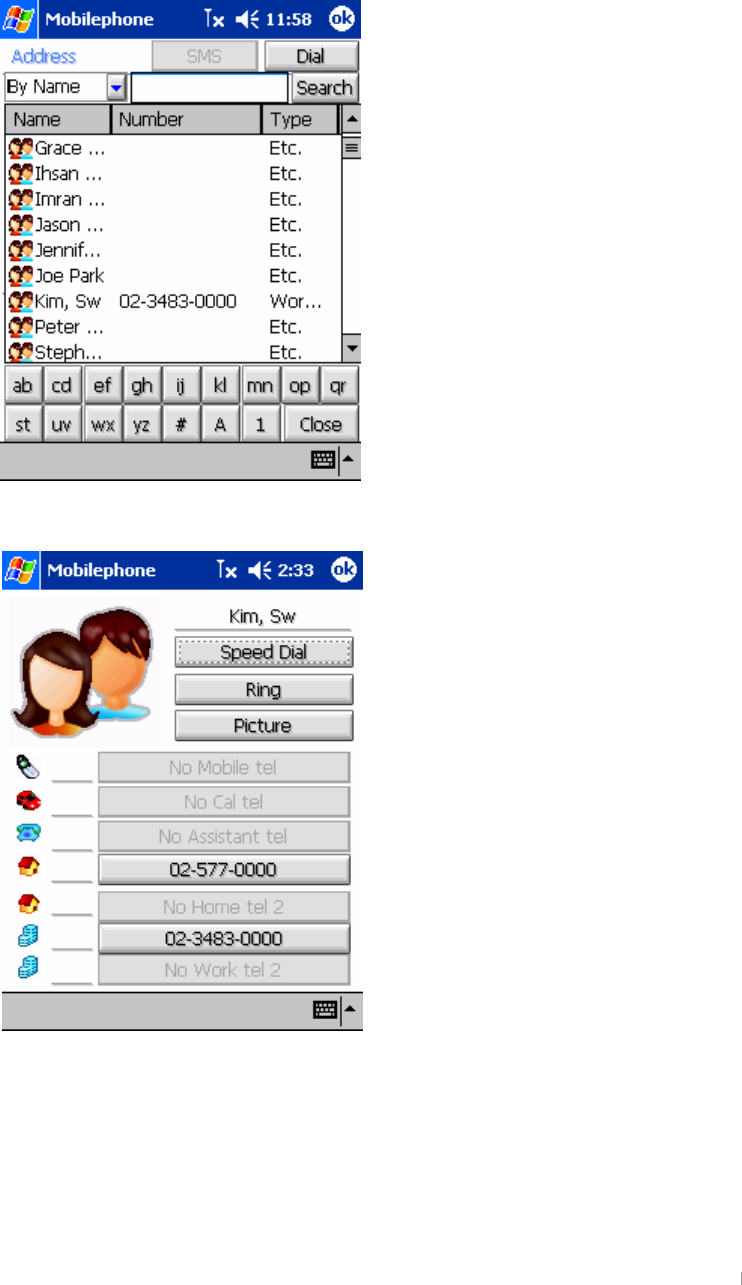
Chapter 7 Using the Mobile Phone 7-11
Add your picture to contact
Copy a picture (100*100 pixel, BMP file recommended) to a folder you want through
Microsoft ActiveSync.
Tap the Contacts icon on the Command bar.
Double-tap a contact you want.
Tap the Picture button.
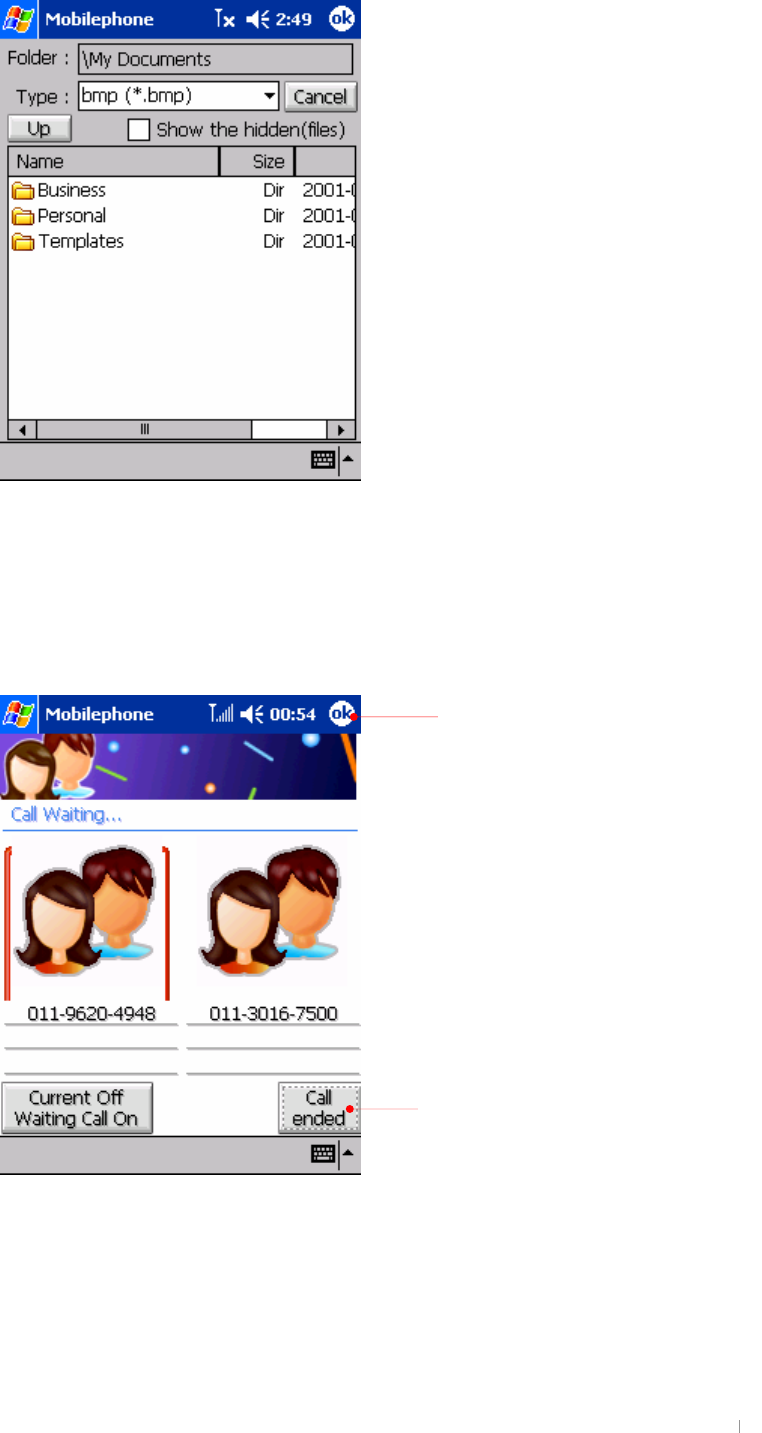
User’s Manual 7-12
Select the folder you want and tap the picture.
Call Waiting
When you are on the phone and another call is received, you hear a call waiting tone
and you will have the next screen on the display.
Select any person you want to communicate.
Tap OK to enter a numeric digit on the
main screen of phone program.
However, you are still on the Call Waiting
mode.
On the main screen of the phone
program, you can try as follows :
Press the 1 button and the Send button
to disconnect the original caller and
switch to another caller.
Press the 2 button and the Send button
to switch to another caller.
Press the 3 button and the Send button
to move to the conference call mode.
Tap to end all calls.
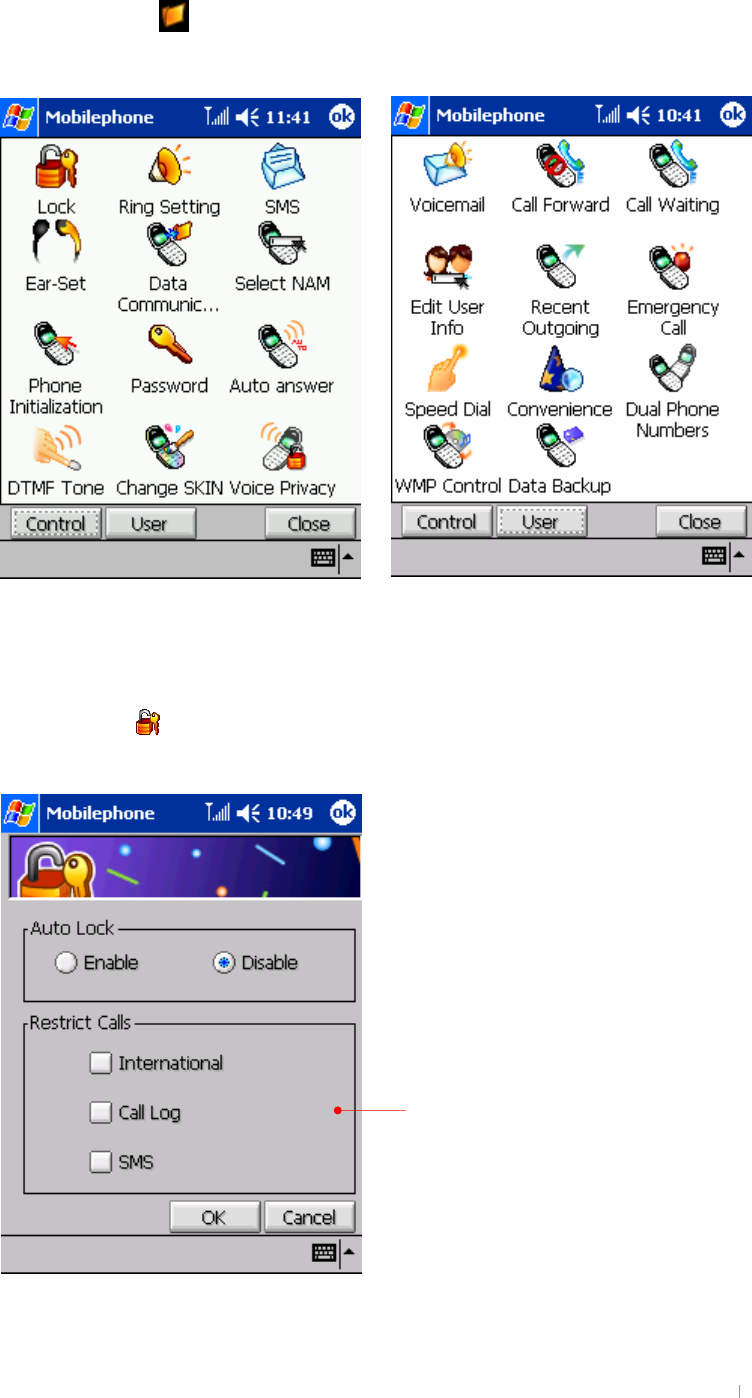
Chapter 7 Using the Mobile Phone 7-13
Using the Settings button
Tap the Settings ( ) icon to adjust the settings on the phone program. Tap the User
Settings button to display the User Settings screen.
Tap the Lock ( ) icon to adjust the settings on restricting calls including the
international call, Call Log and SMS.
Control Panel Settings User Settings
This enables you to restrict these
functions: international call, call log,
SMS.
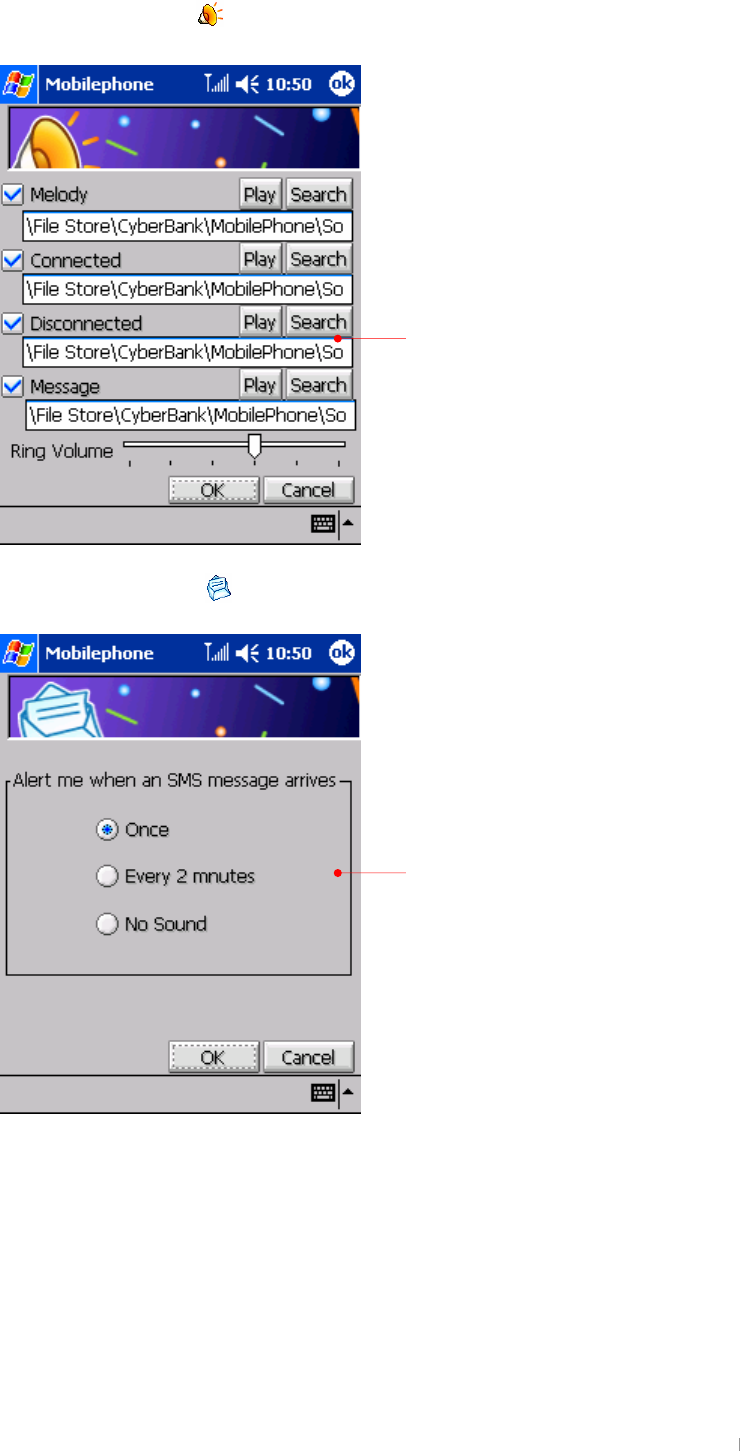
User’s Manual 7-14
Tap the Ring Setting ( ) icon to display the sound screen.
Tap the SMS settings ( ) icon to display the SMS settings screen.
Select the bell sound or adjust the
volume. Also you can download the
bell and install it for your favorite bell
sound.
Select the option of how your device
let you know that SMS arrives.
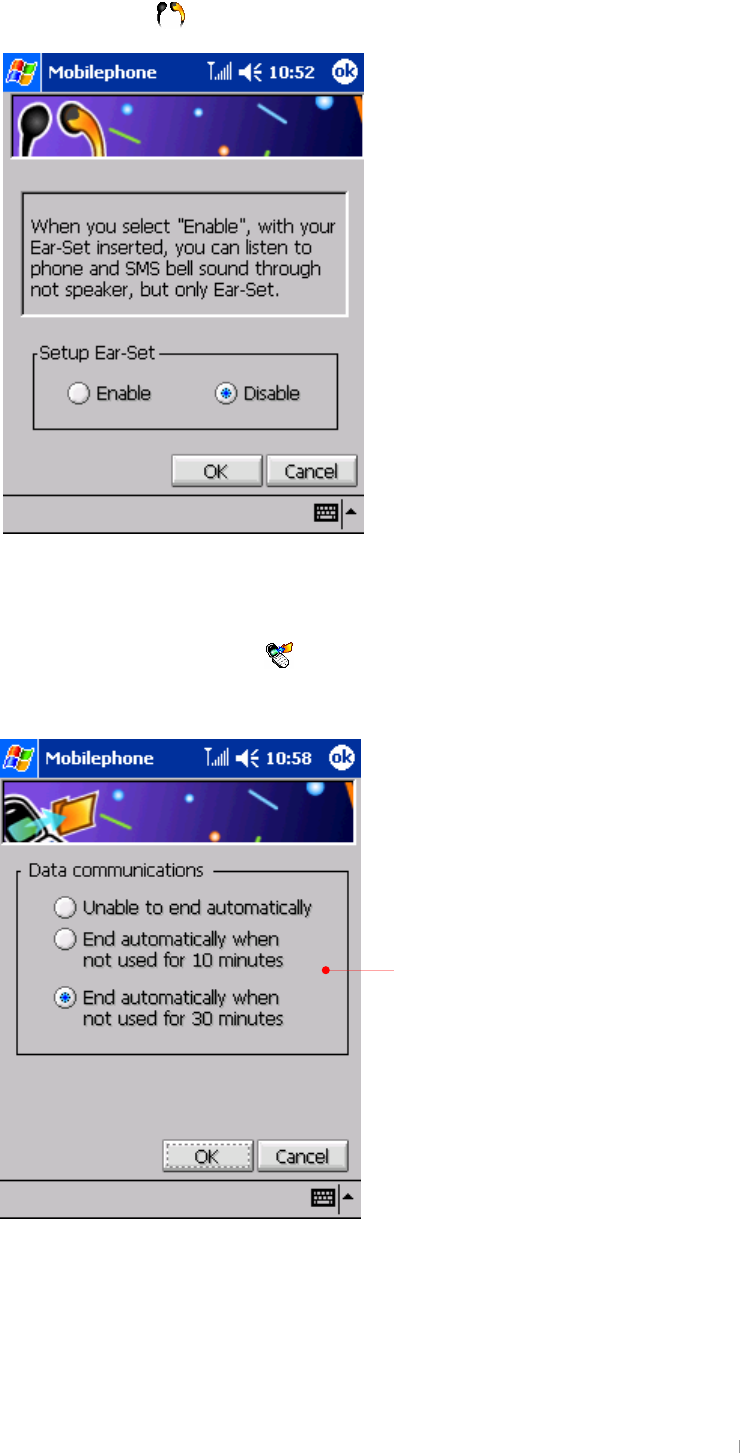
Chapter 7 Using the Mobile Phone 7-15
Tap the Ear-Set ( ) icon to adjust the setting on headphone.
Tap the Data Communiation ( ) icon to adjust the setting on how you close the
connection to avoid unnecessary charging after using data communication.
It is recommended that you set up
the option to avoid unnecessary
charging after using data
communication.
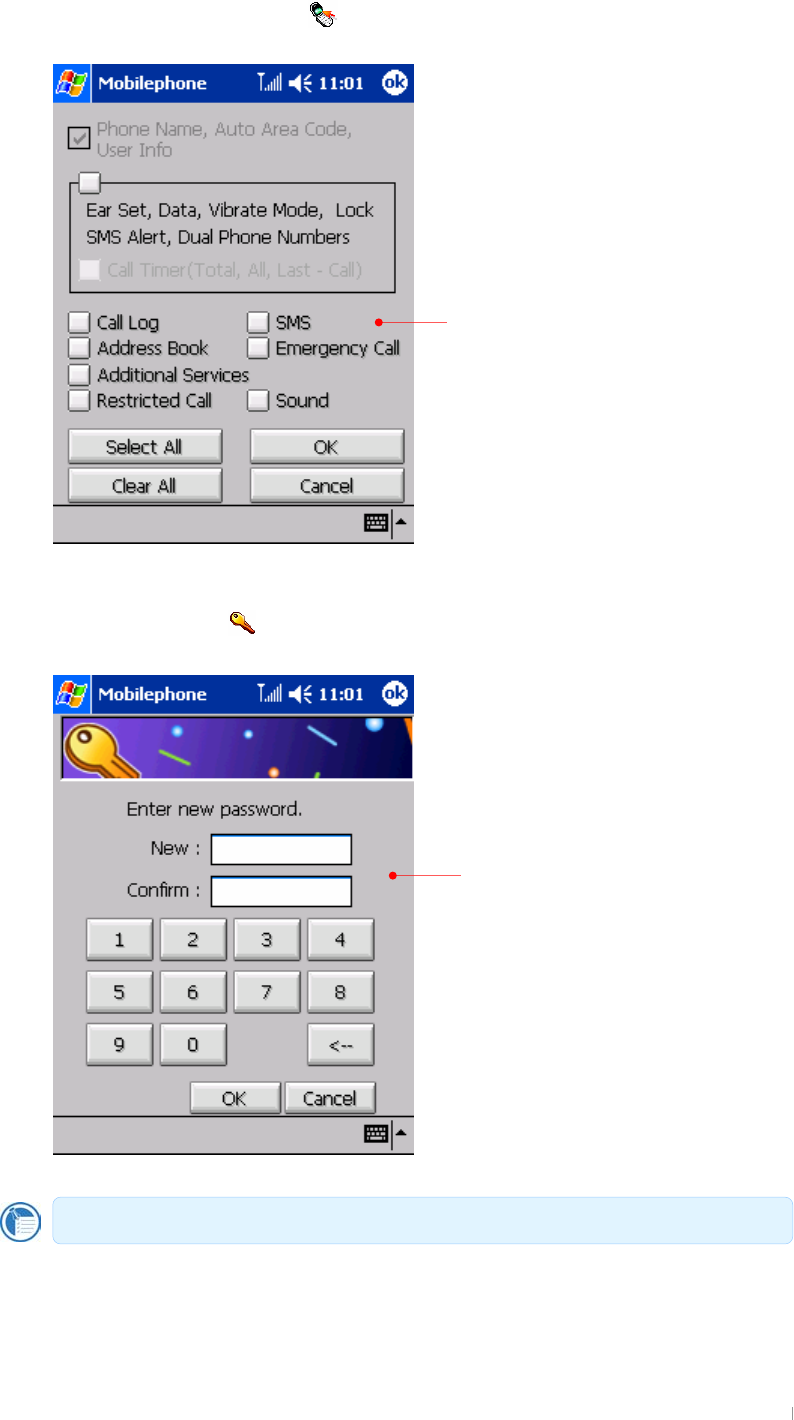
User’s Manual 7-16
Tap the Phone Initialization ( ) icon to initialize your phone program.
Tap the Password ( ) icon to change your password.
Select the items you want to
Initialize and tap the OK button.
As default, your password is “0000”,
but when you want to change to
another number your want, use this
setting. And also be sure to
remember your new password.
Otherwise, you have to ask A/S
center to repair.
Your password should be 4 digit number.
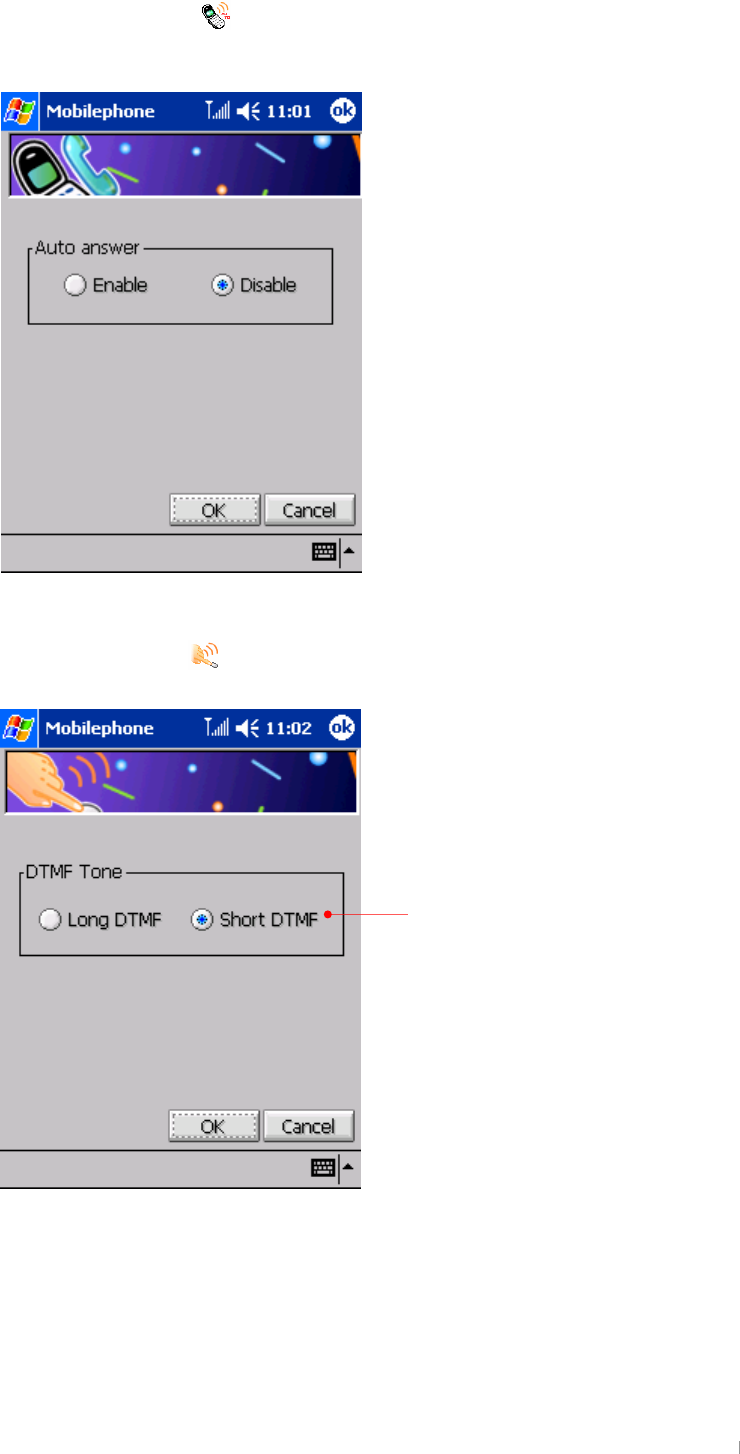
Chapter 7 Using the Mobile Phone 7-17
Tap the Auto Answer ( ) icon to automatically answer an incoming call after a few
rings without any key press.
Tap the DTMF Tone( ) icon to change the DTMF tone.
Select Long DTMF when you want
the key-pressing tone to sound long,
and select Short DTMF when you
want the key-pressing tone to sound
short, regardless of how long you
press the key.
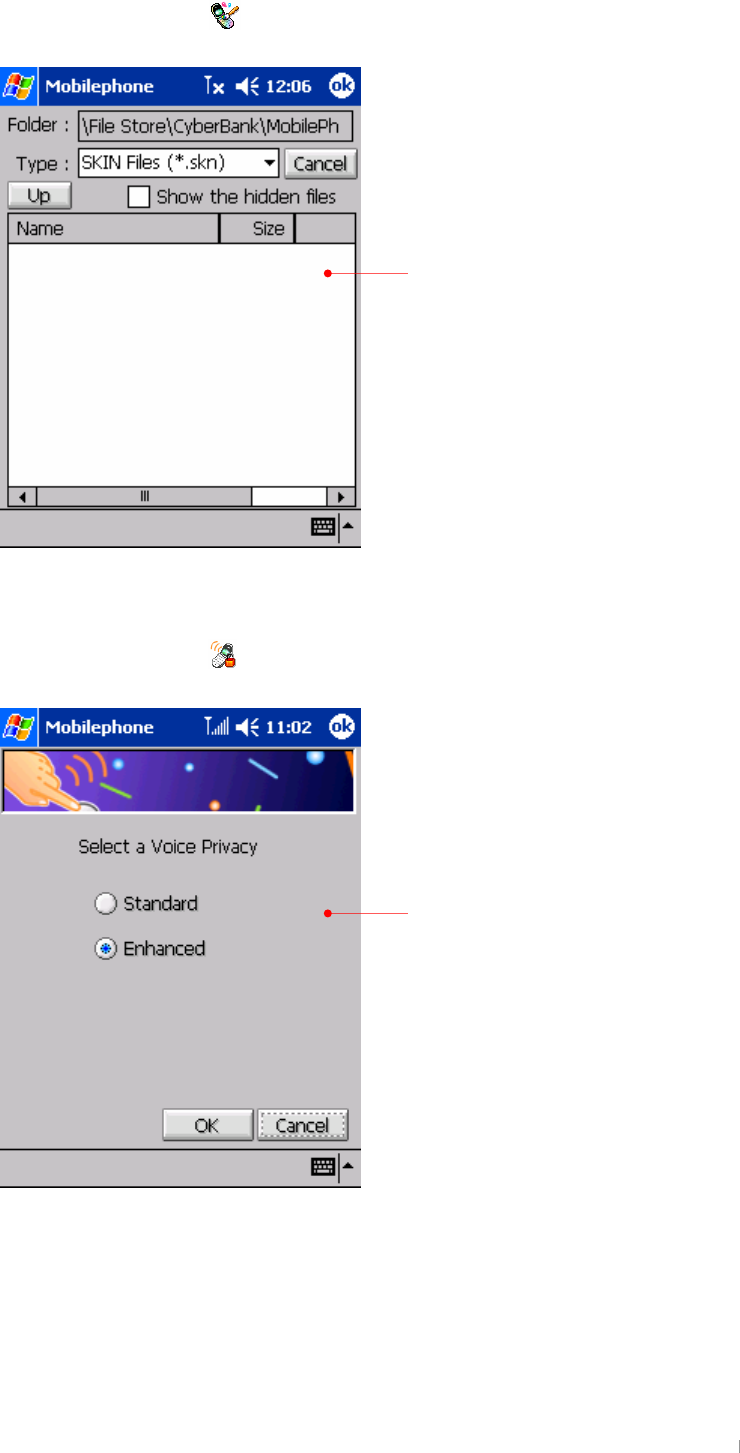
User’s Manual 7-18
Tap the Change SKIN ( ) icon to change the skin.
Tap the Voice Privacy ( ) icon to make Voice Privacy available during a call.
First, save your skin to a folder you
want, then your phone program skin
will be displayed.
Tap Enhanced to make Voice
Privacy available during a call.
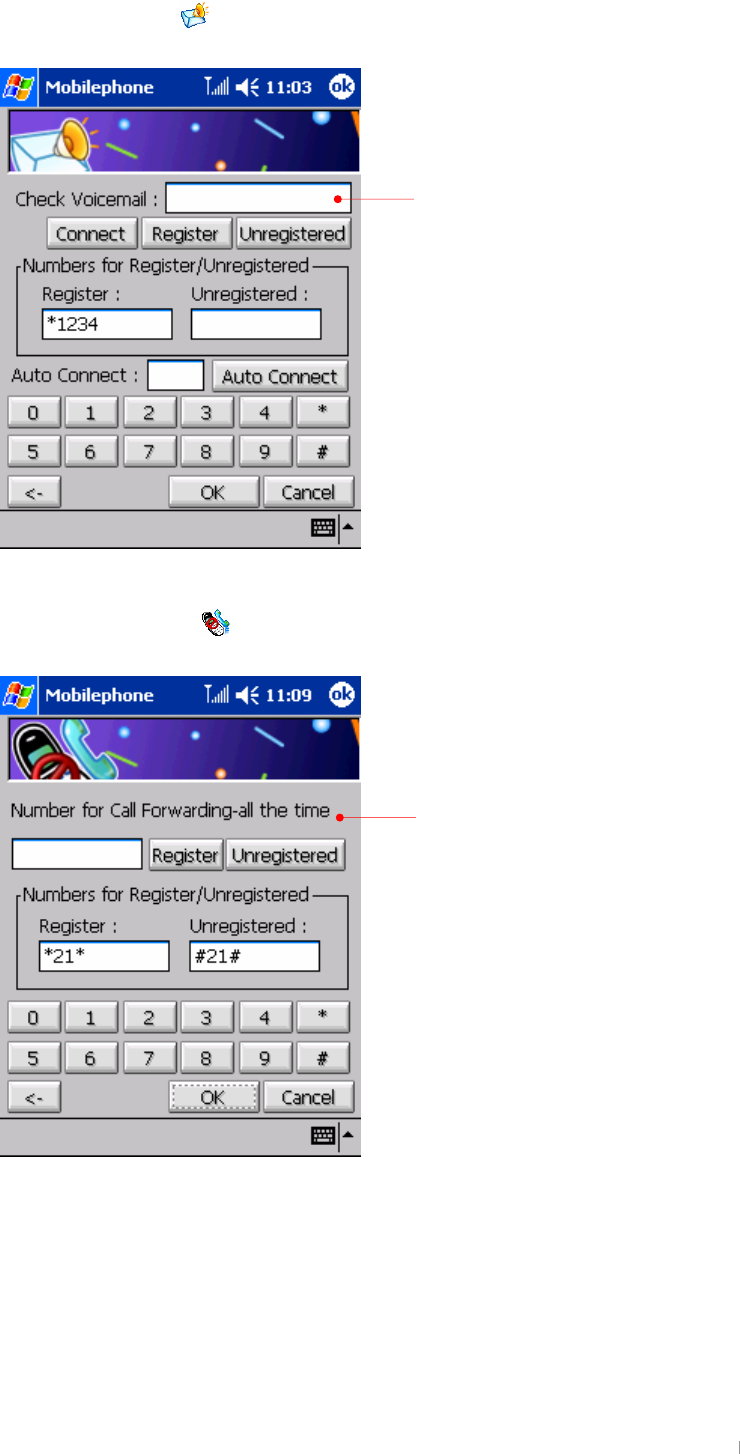
Chapter 7 Using the Mobile Phone 7-19
Tap the Voice mail ( ) icon to adjust the settings of voice mail.
Tap the Call Forward ( ) icon to adjust the settings of call forward.
First, ask your service provider of
how you register for this service and
tap the register button to register. To
hear the voice mail that arrived while
you could not receive them, tap the
Connect button.
Enables you to reroute incoming
calls to a different phone number
when it is registered. For information
on registration, ask your service
provider.
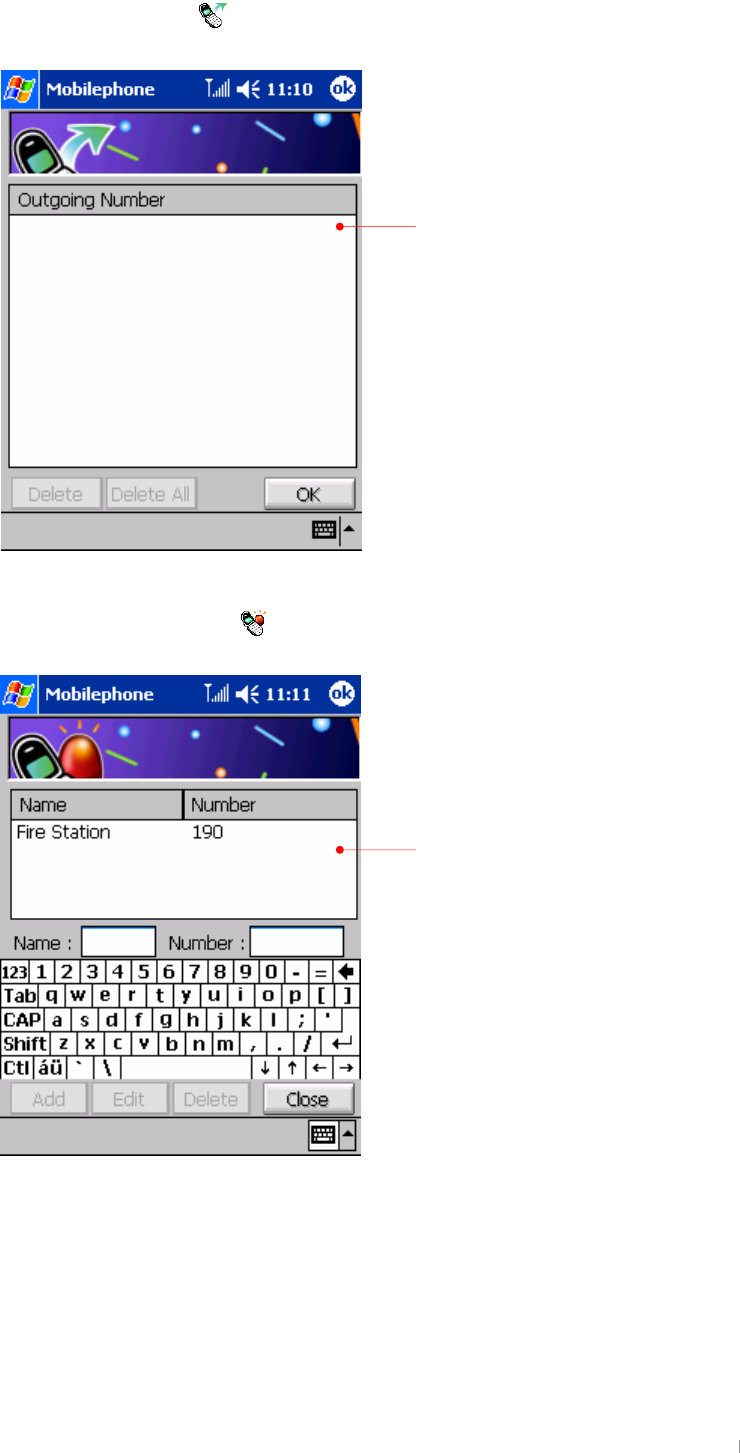
User’s Manual 7-20
Tap the Recent Outgoing ( ) icon to delete or see the recently sent messages.
Tap the Emergency Calls ( ) icon to see emergency calls on the list.
Enables you to add, modify and
delete emergency numbers. Double-
tap a number you want to make a
call.
Double-tap the number you want to
make a call to.
Select an item you want to delete
and tap the Delete button.
Be careful not to tap the Delete All
button mistakenly.
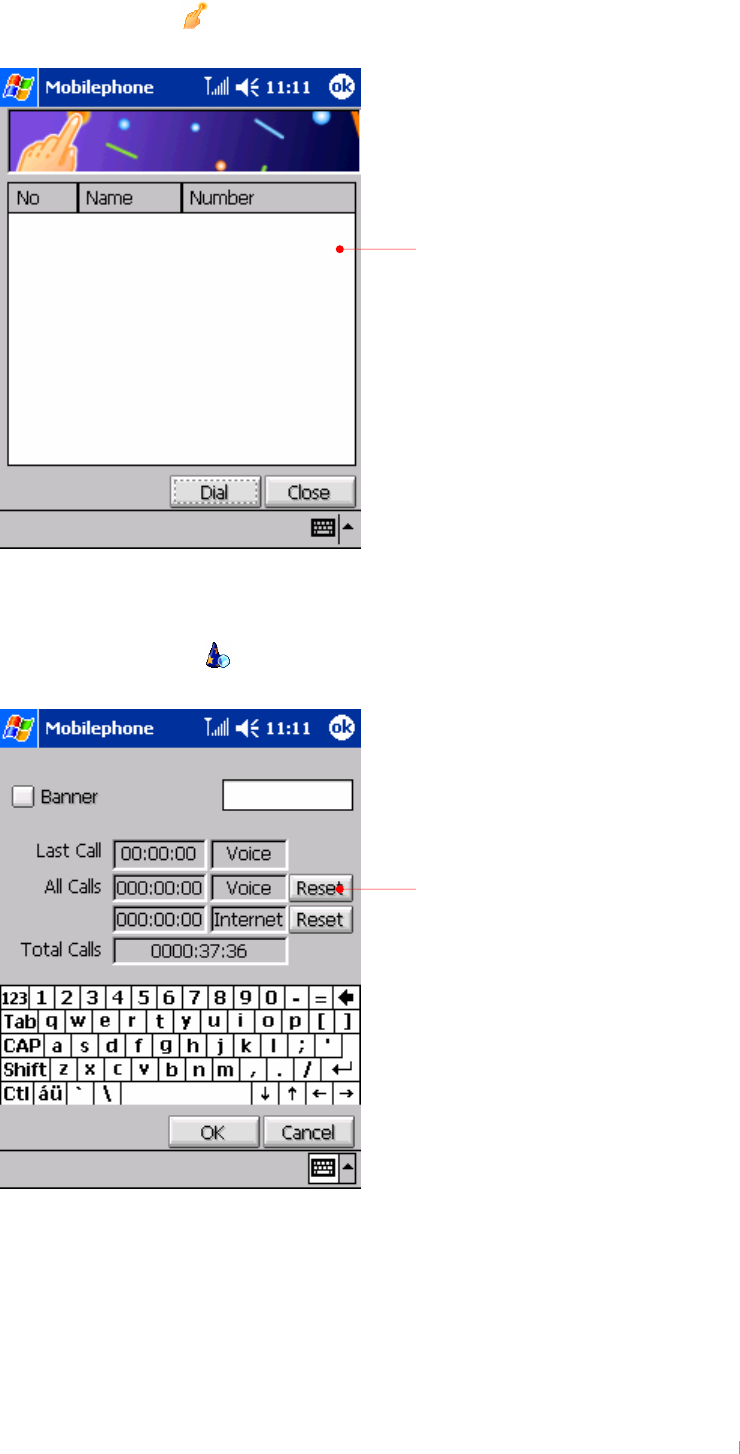
Chapter 7 Using the Mobile Phone 7-21
Tap the Speed dial ( ) icon to see a speed dial for the number you use frequently.
Tap the Convenience ( ) icon to reset your calls including voice and Internet.
Select a speed dial added before for
your convenience number to make a
call.
Enables you to reset your past voice
calls and Internet.
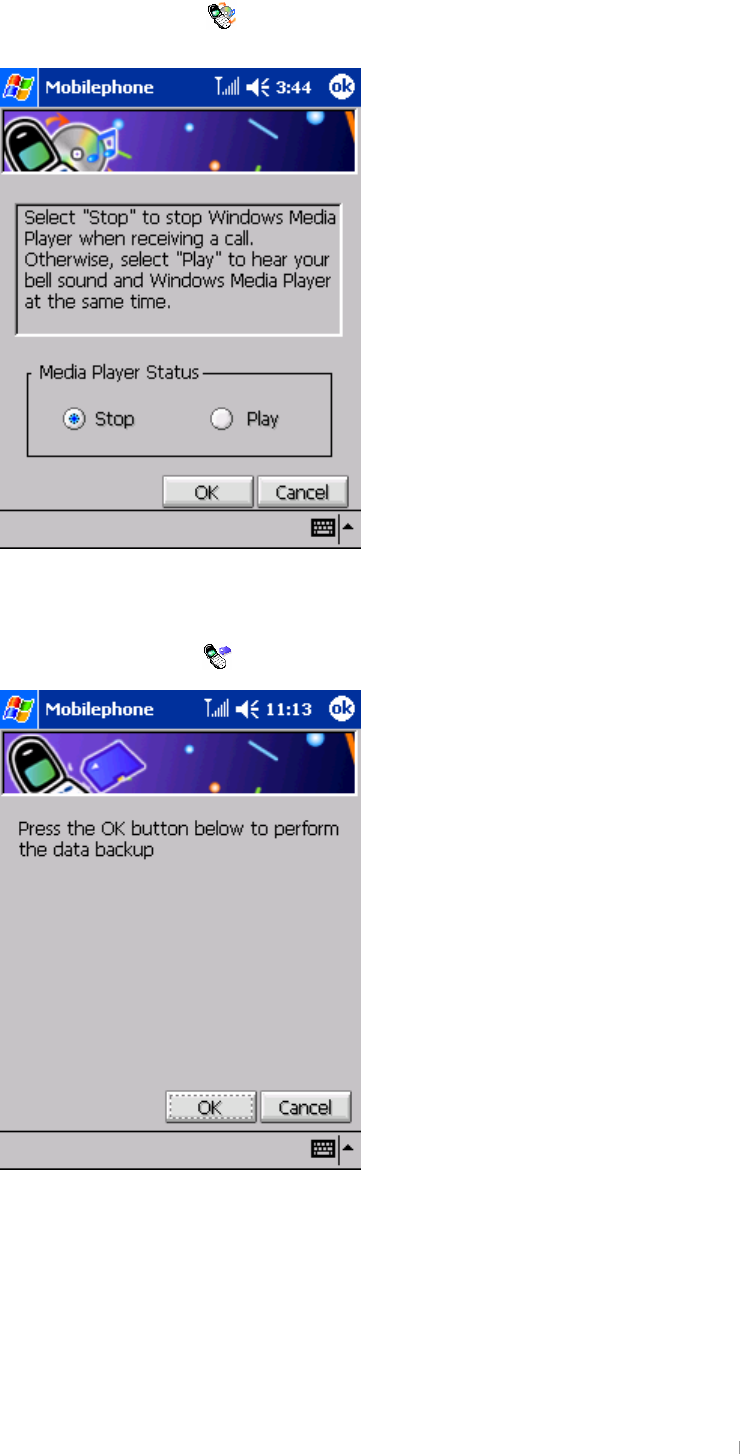
User’s Manual 7-22
Tap the WMP Control ( ) icon to adjust the settings of Windows Media Player.
Tap the Data Backup ( ) icon to perform the data backup.
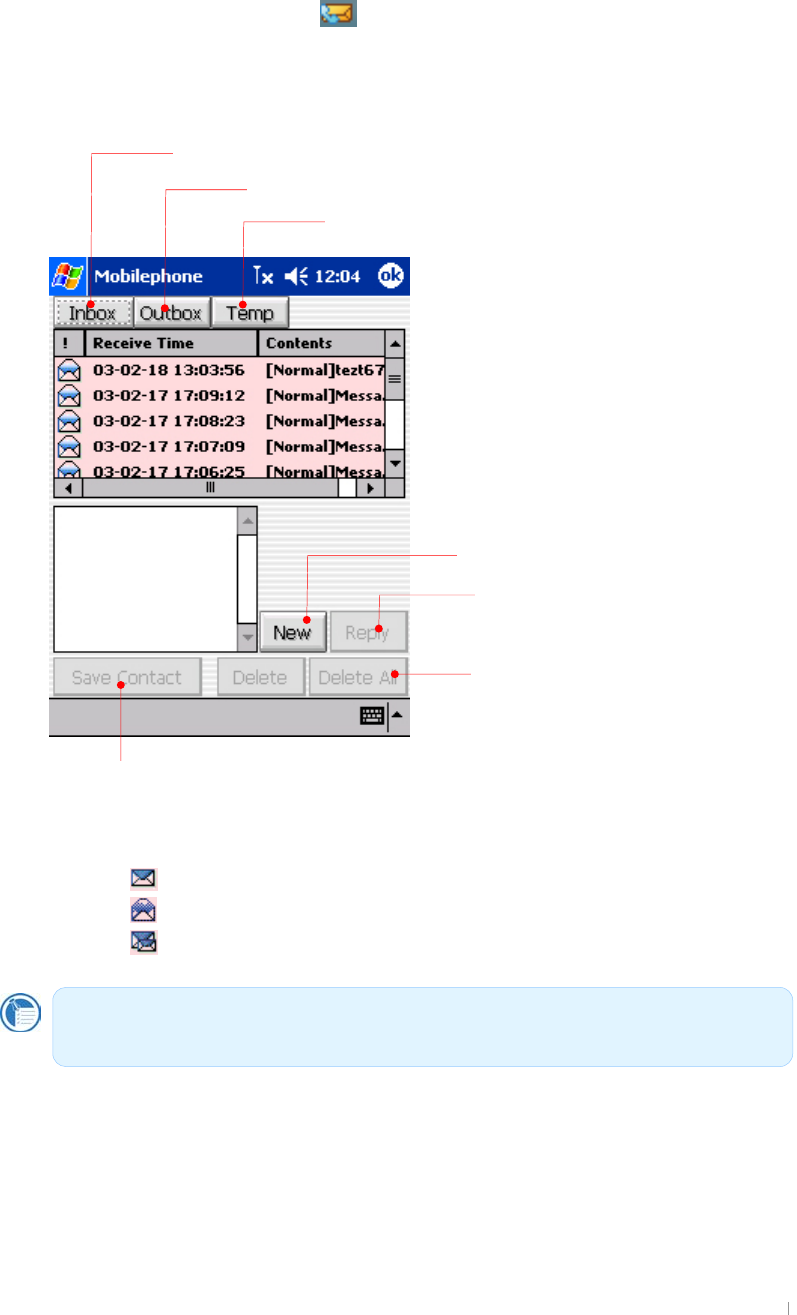
Chapter 7 Using the Mobile Phone 7-23
SMS(Short Message Service)
Contact your service provider before using this function.
Tap the SMS button on the phone program to display the SMS message screen. When
you receive a SMS message, appears on the phone status pane of the phone
program. When you tap this icon on the phone status pane of the phone program,
nothing happens and you have to tap the SMS button on the right side of the phone
program.
Tap a message you want to open.
z
: Unread message
z
: Read message
z
: Duplicated message
During data communications(Internet), if SMS message is sent or received, the
Internet may be disconnected depending on the settings of your service provider.
Tap the Delete All button to delete all
messages listed above. So be careful
not to delete all messages mistakenly.
Tap to save sender’s information on
your contacts.
Tap to make a new SMS message.
Tap to reply to the selected message.
Tap to open the list of SMS Inbox.
Tap to open the list of SMS Outbox.
Tap to open the list of SMS Temporary folder.
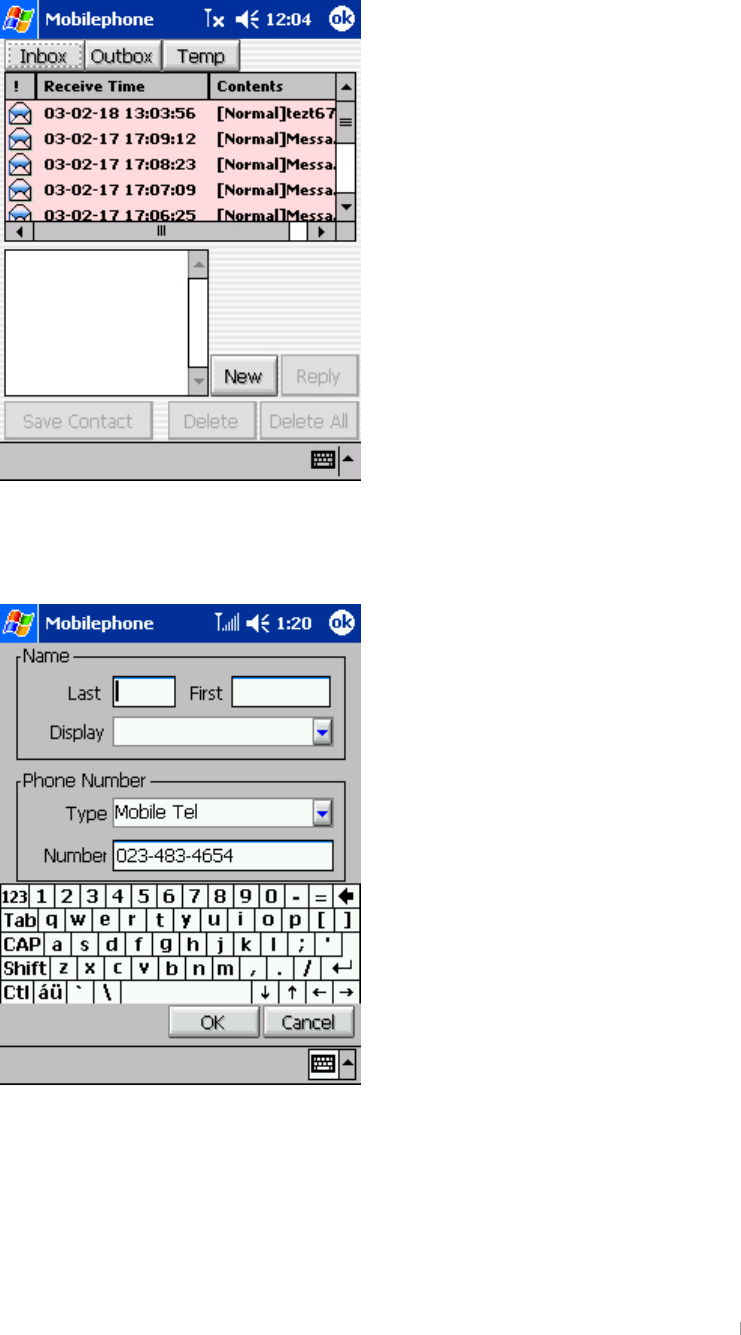
User’s Manual 7-24
Add sender’s phone number to your contacts
Tap the SMS button on the right side of the phone program.
Among the SMS messages listed on the Inbox tab, if there are messages whose phone
number you want to add to your contacts, select the message and tap the Save Contacts
button to save the phone number to Contacts.
Enter any necessary information and tap OK.
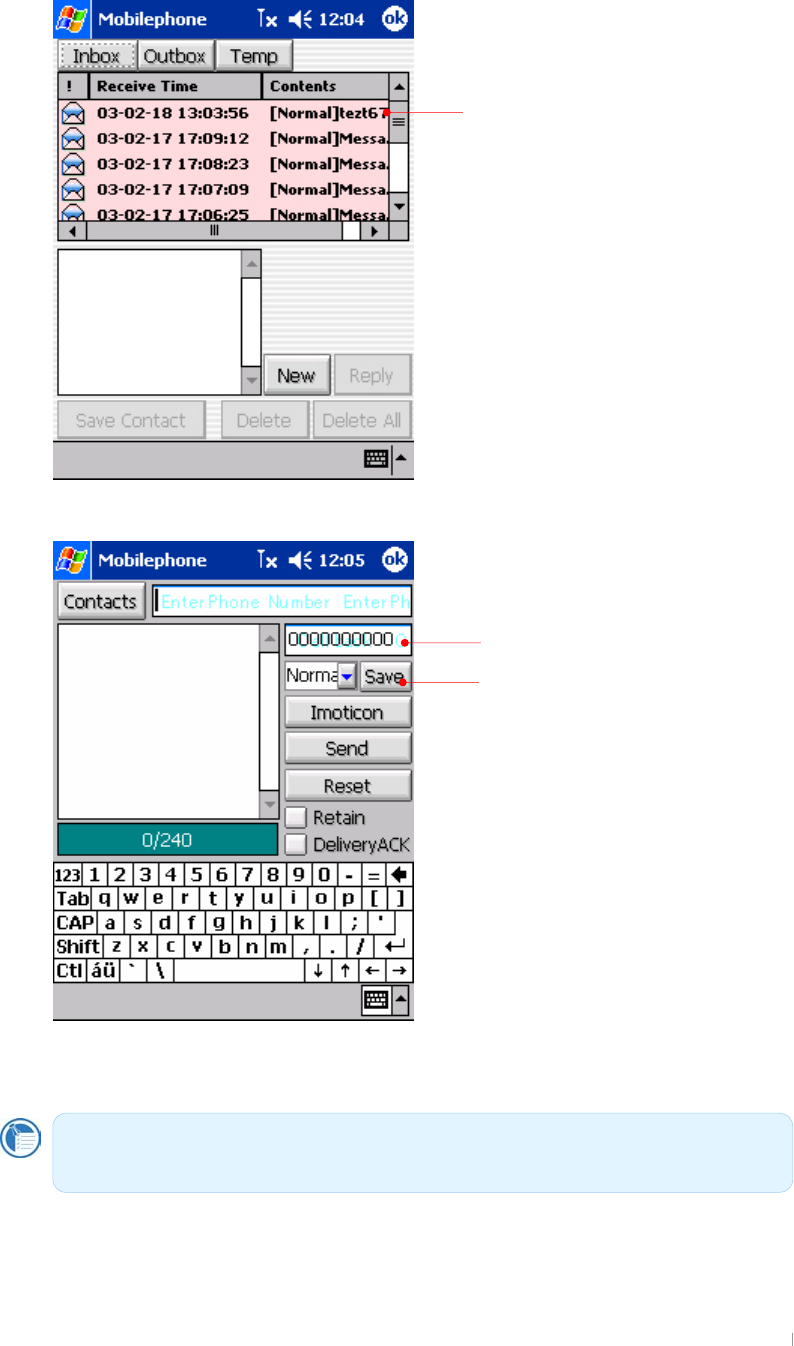
Chapter 7 Using the Mobile Phone 7-25
Reply to and Forward SMS
Among the messages listed on the Inbox, select a message you want to reply to.
Tap the Reply button
Tap the Contacts button or tap the Enter Phone Number box to enter phone number you
want directly.
Enter messages on the text box and tap the Send button to send the message.
When you enter several phone numbers on the Enter Phone Number box, each
phone number should be separated by semicolon (;).
Tap to enter the call back.
Tap to temporarily save this message
to the temporary folder.
Double-tap to forward this message.
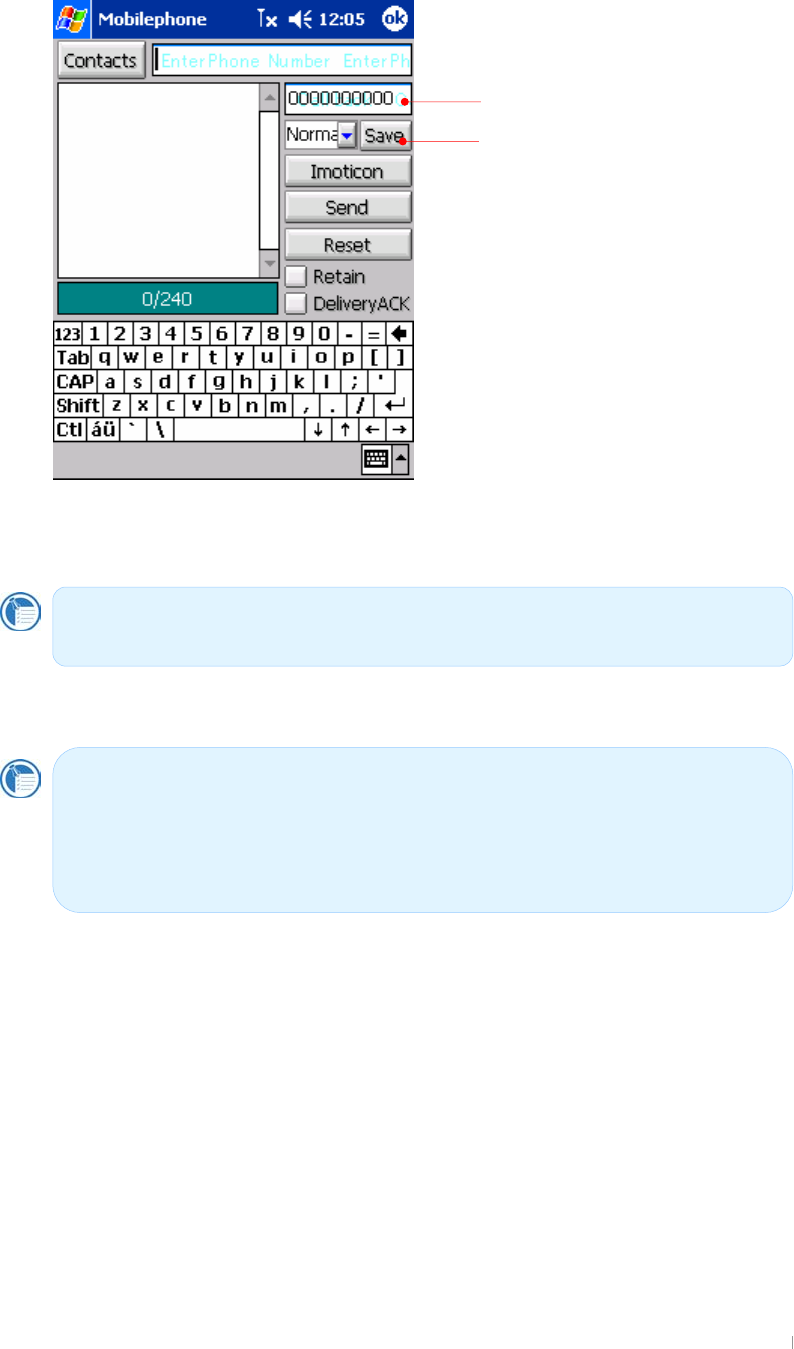
User’s Manual 7-26
Compose a new message
Tap the New button of each view. (Inbox, Outbox and Temp of SMS)
Tap the Contacts button or tap the Enter Phone Number box to enter phone number you
want directly.
Enter messages on the text box and tap the Send button to send the message.
Tap to enter the call back.
Tap to temporarily save this message
to the temporary folder.
When you enter several phone numbers on the Enter Phone Number box, each
phone number should be separated by semicolon (;).
The length of a text message that you can send each time varies slightly from
each service provider, but it is mainly limited to approximately 80 characters for
English. Therefore, if the message you have created surpasses the limit, it will
be divided into 80 characters. The number of messages to be sent is
automatically displayed on the bottom part of the New window.

Chapter 8 Microsoft Pocket Outlook 8-1
Microsoft Pocket Outlook includes Calendar, Contacts, Tasks, Inbox, and Notes. You
can use these programs individually or together. For example, e-mail addresses stored
in Contacts can be used to address e-mail messages in Inbox.
Using ActiveSync, you can synchronize information in Microsoft Outlook on your desktop
PC with information in Pocket Outlook on your device. Each time you synchronize,
ActiveSync compares the changes you made on your device and desktop PC and
updates both computers with the latest information. For information on using ActiveSync,
see ActiveSync Help on your desktop PC.
⊙ In this chapter, you will learn to
− Schedule appointments and meetings using Calendar.
− Keep track of friends and colleagues using Contacts.
− Keep a to-do list in Tasks.
− Capture thoughts and ideas with Notes.
For details on using Inbox to send and receive e-mail messages, see “Sending and
Receiving E-mail” in chapter 5.
Chapter 8
Microsoft Pocket Outloo
k
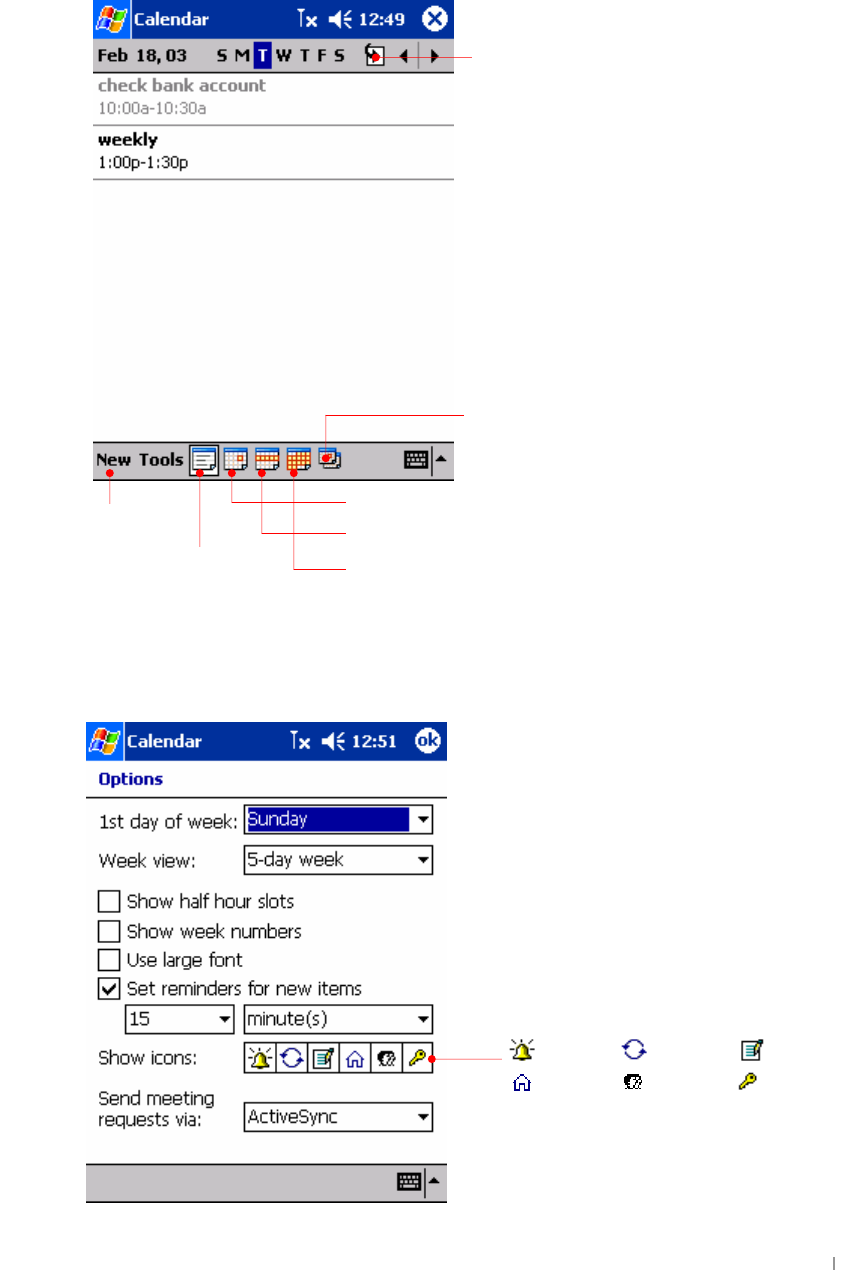
User’s Manual 8-2
Calendar : Scheduling Appointments and Meetings
Use Calendar to schedule appointments, including meetings and other events. You can
check your appointments in one of several views (Agenda, Day, Week, Month, and Year)
and easily switch views by using the View menu.
You can customize the Calendar display (for example, change the first day of the week),
by tapping Options on the Tools menu.
Tap to
g
o to toda
y
.
Tap to create a new
a
pp
ointment.
Agenda view
Day view
Week view
Month view
Year view
Reminder Recurs Note
Location Attendees Private
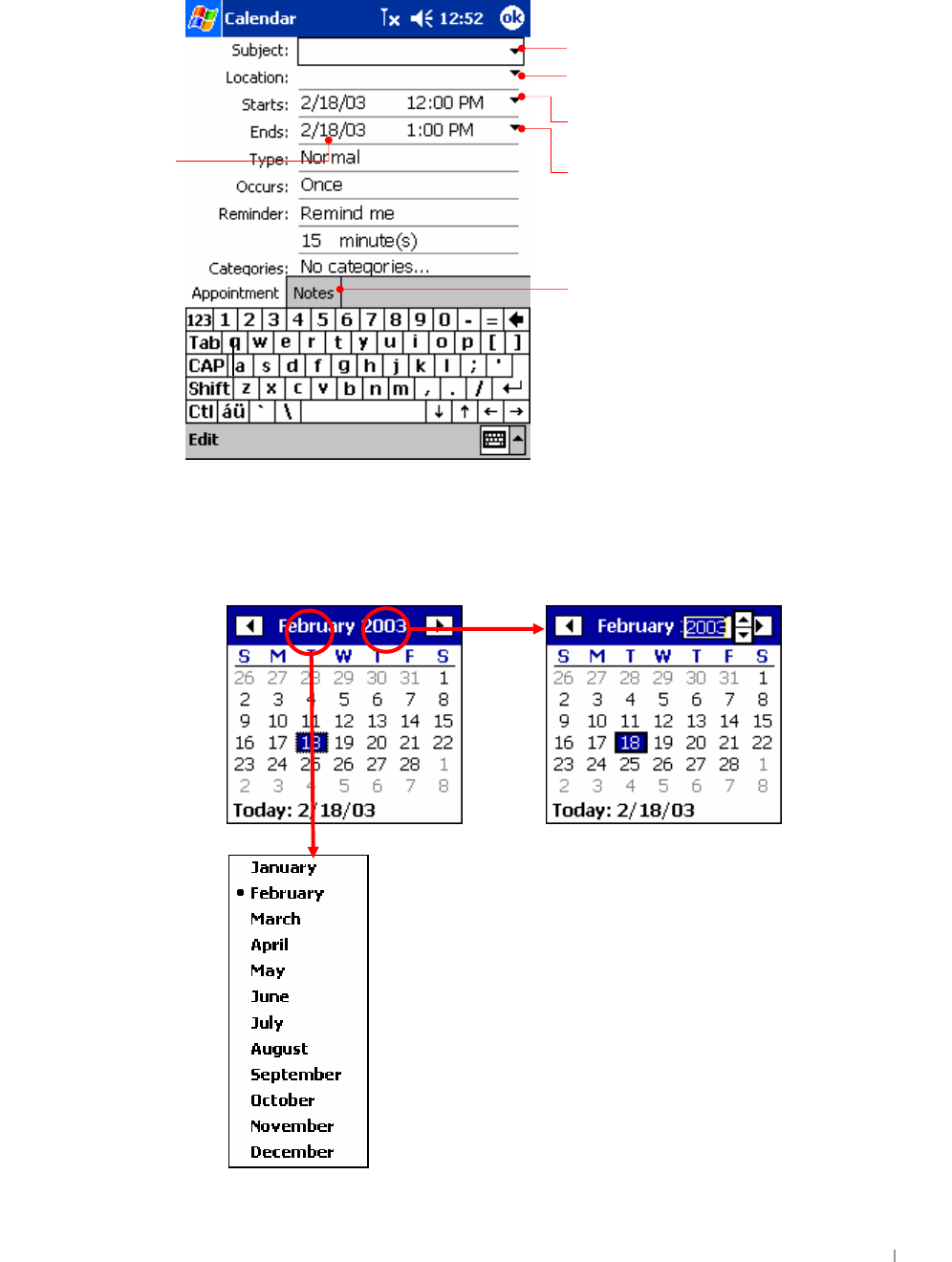
Chapter 8 Microsoft Pocket Outlook 8-3
To create an appointment
1. In Day or Week view, tap the desired date and time for the appointment.
2. Tap New.
3. Using the Input panel, tap first to select the field, and then enter a description and a
location.
4. If needed, tap the date and time to change them.
For example, select the date to have the calendar pane displayed as below.
5. Enter other desired information. You will need to hide the Input panel to see all
Tap to choose from predefined text.
Tap to choose from previously entered locations.
Tap to return to the calendar (the
a
pp
ointment is saved automaticall
y)
.
Tap to select a time.
Tap to select a date.
The Notes tab is a good place for maps
and directions.
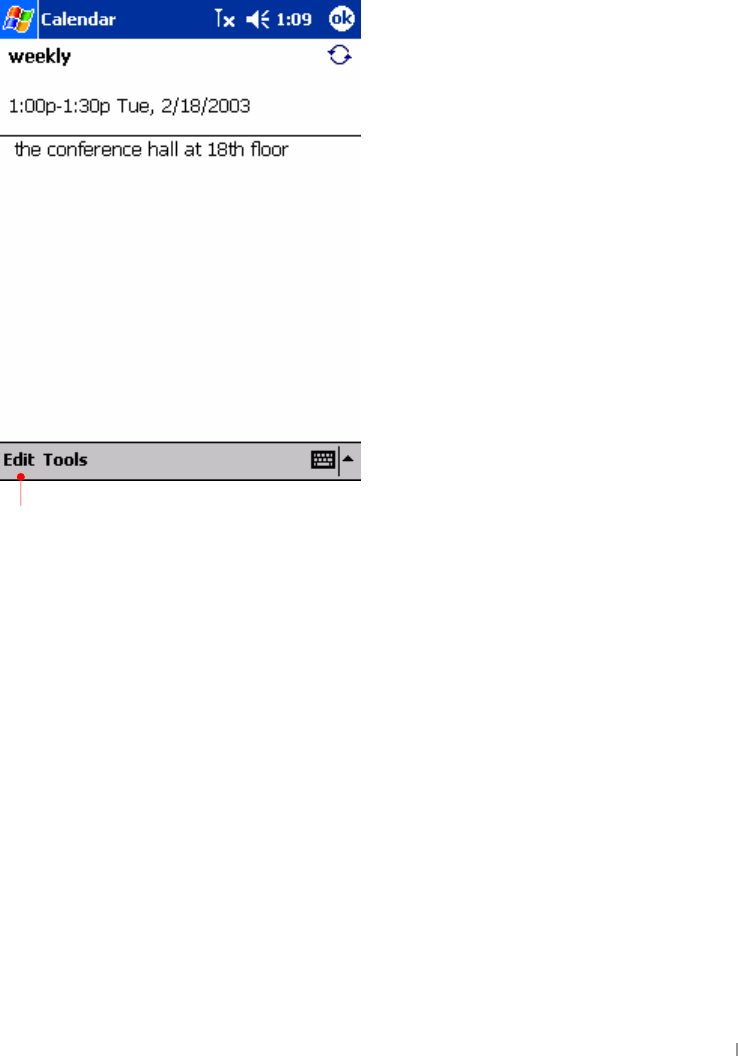
User’s Manual 8-4
available fields.
6. To add notes, tap the Notes tab. You can enter text, draw, or create a recording. For
more information on creating notes, see “Notes: Capturing Thoughts and Ideas,”
later in this chapter.
7. Tap OK to return to Calendar.
If you select Remind me in an appointment, your device will remind you according to the
options set in the Sounds & Notifications control panel.
Using the Summary Screen
When you tap an appointment in Calendar, a summary screen is displayed. To change
the appointment, tap Edit.
Creating Meeting Requests
You can use Calendar to set up meetings with users of Outlook or Pocket Outlook. The
meeting notices will be created automatically and sent either when you synchronize
Inbox or when you connect to your e-mail server.
Indicate how you want meeting requests sent by tapping Tools and then Options.
Tap to change appointment.
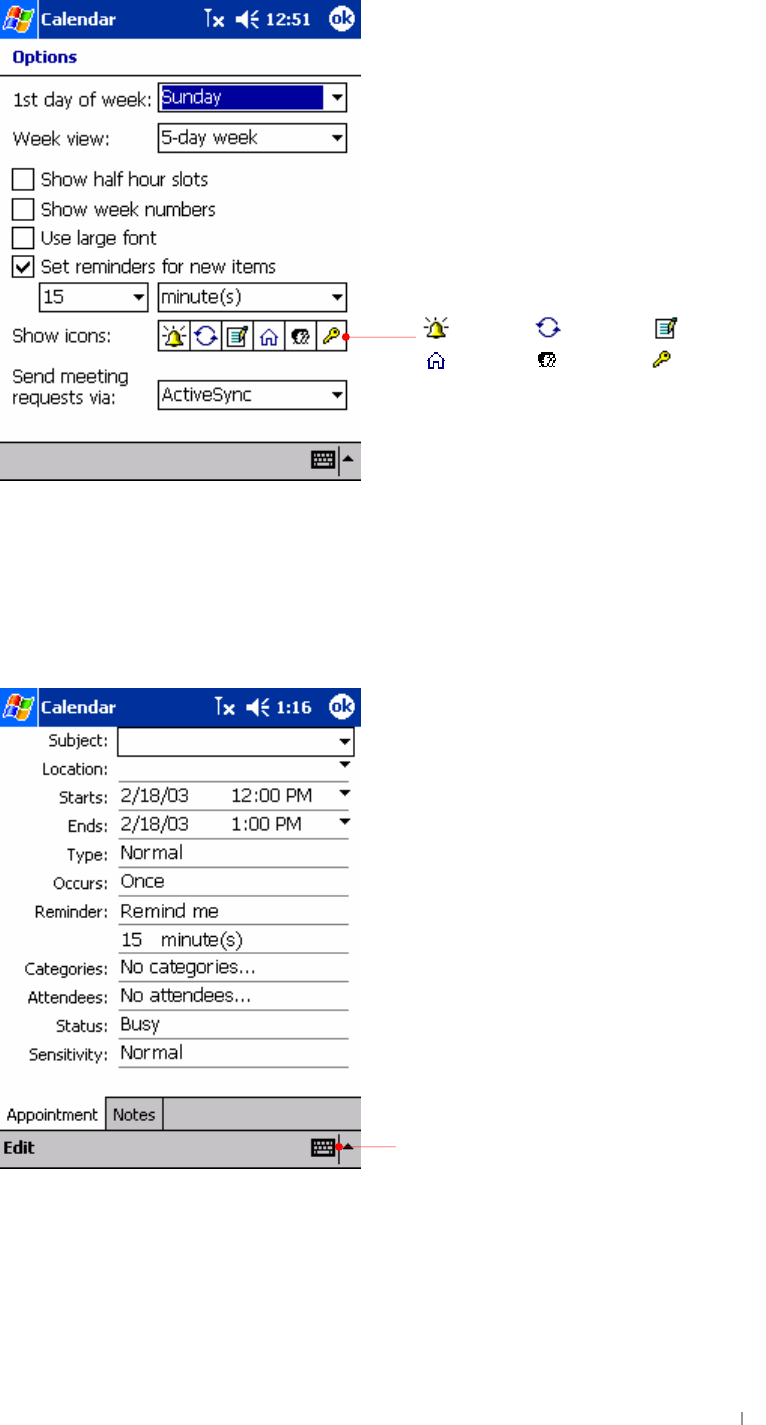
Chapter 8 Microsoft Pocket Outlook 8-5
If you send and receive e-mail messages through ActiveSync, select ActiveSync.
⊙ To schedule a meeting
1. Create an appointment.
2. In the appointment details, hide the Input panel, and then tap Attendees.
3. From the list of e-mail addresses in Contacts, select the meeting attendees.
Tap to show Input Panel.
Reminder Recurs Note
Location Attendees Private
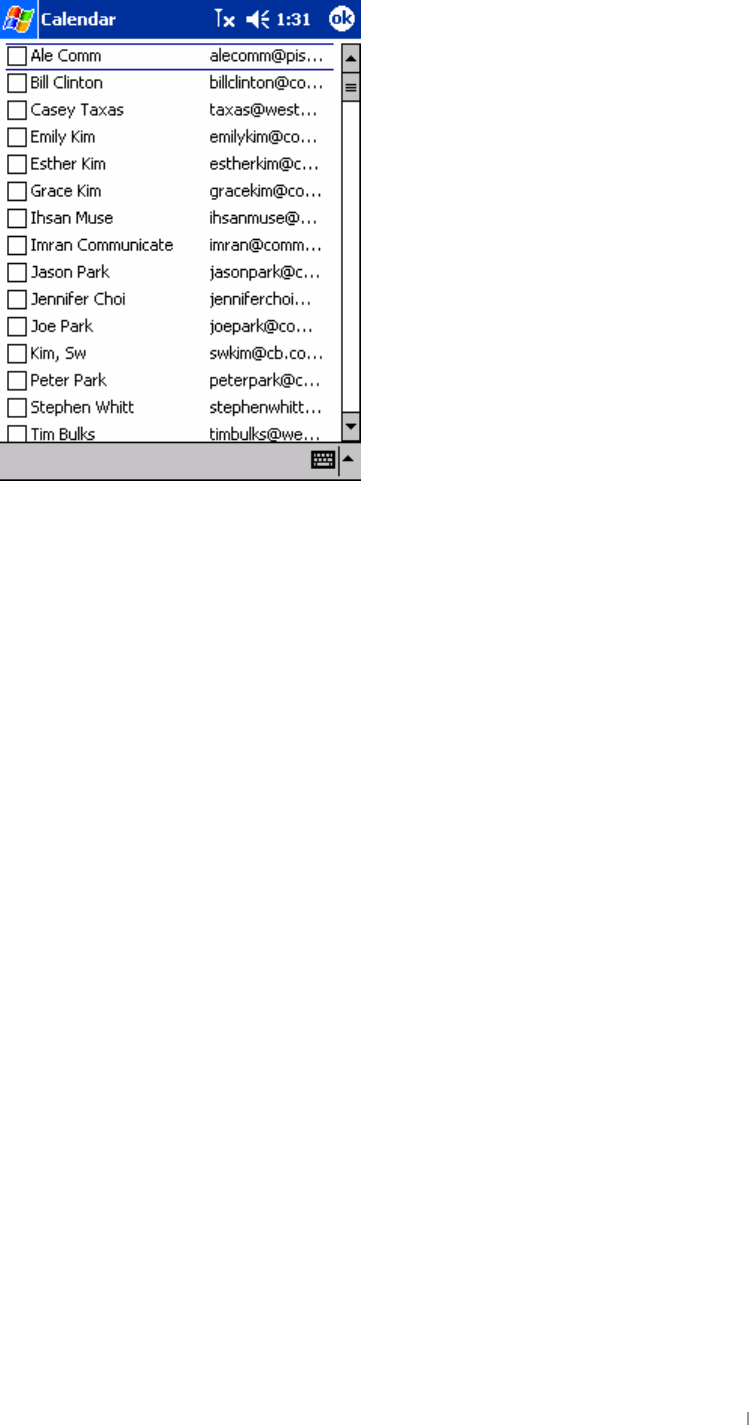
User’s Manual 8-6
The meeting notice is created automatically and placed in the Outbox folder.
For more information on sending and receiving meeting requests, see Calendar Help
and Inbox Help on your device.
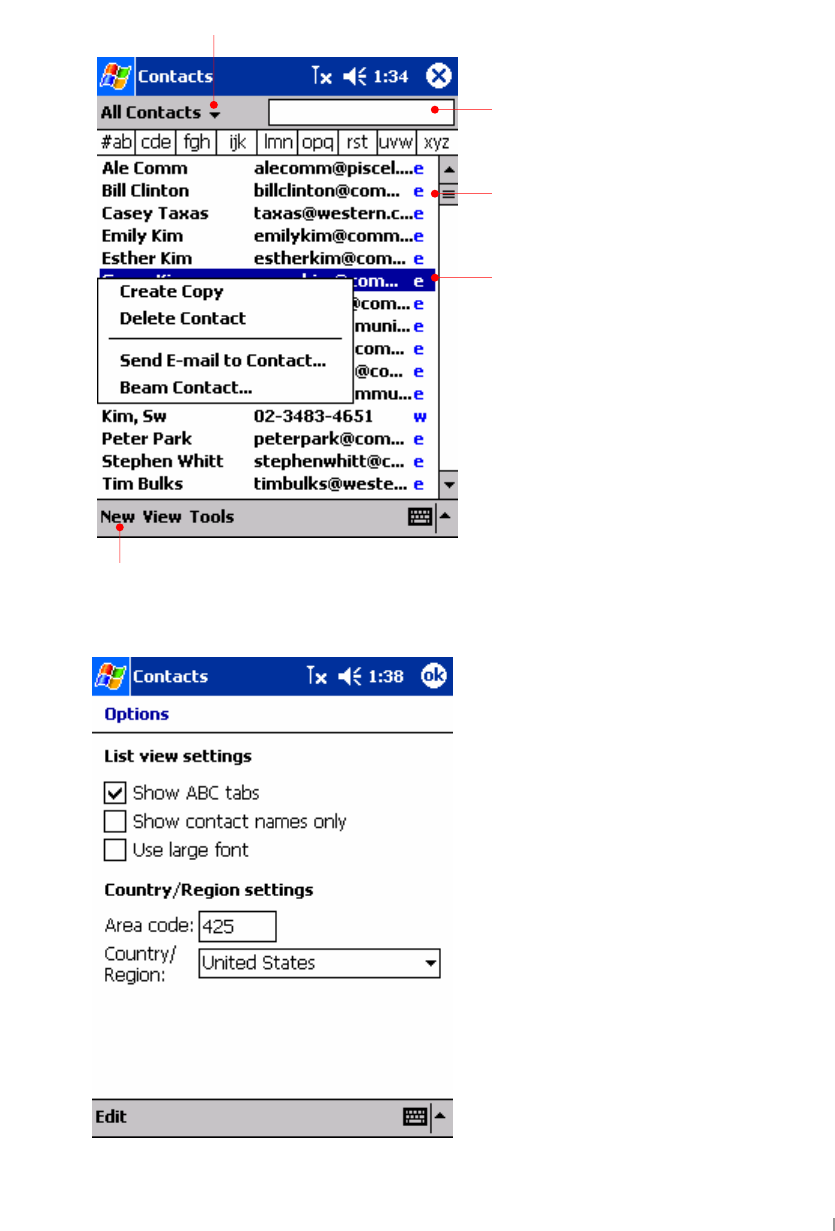
Chapter 8 Microsoft Pocket Outlook 8-7
Contacts: Tracking Friends and Colleagues
Contacts maintains a list of your friends and colleagues so that you can easily find the
information you are looking for, whether you are at home or on the road. Using the
infrared port of your device, you can quickly share Contacts information with users of
Pocket PCs and other mobile devices.
To change the way information is displayed in the list, tap Tools, and then tap Options.
Tap and enter part of a name to quickly
find it in the list.
Select the category of contacts you want displayed in the list.
Tap to display or edit the contact details.
Tap and hold to display a pop-up menu of
actions.
Tap to create a new contact.
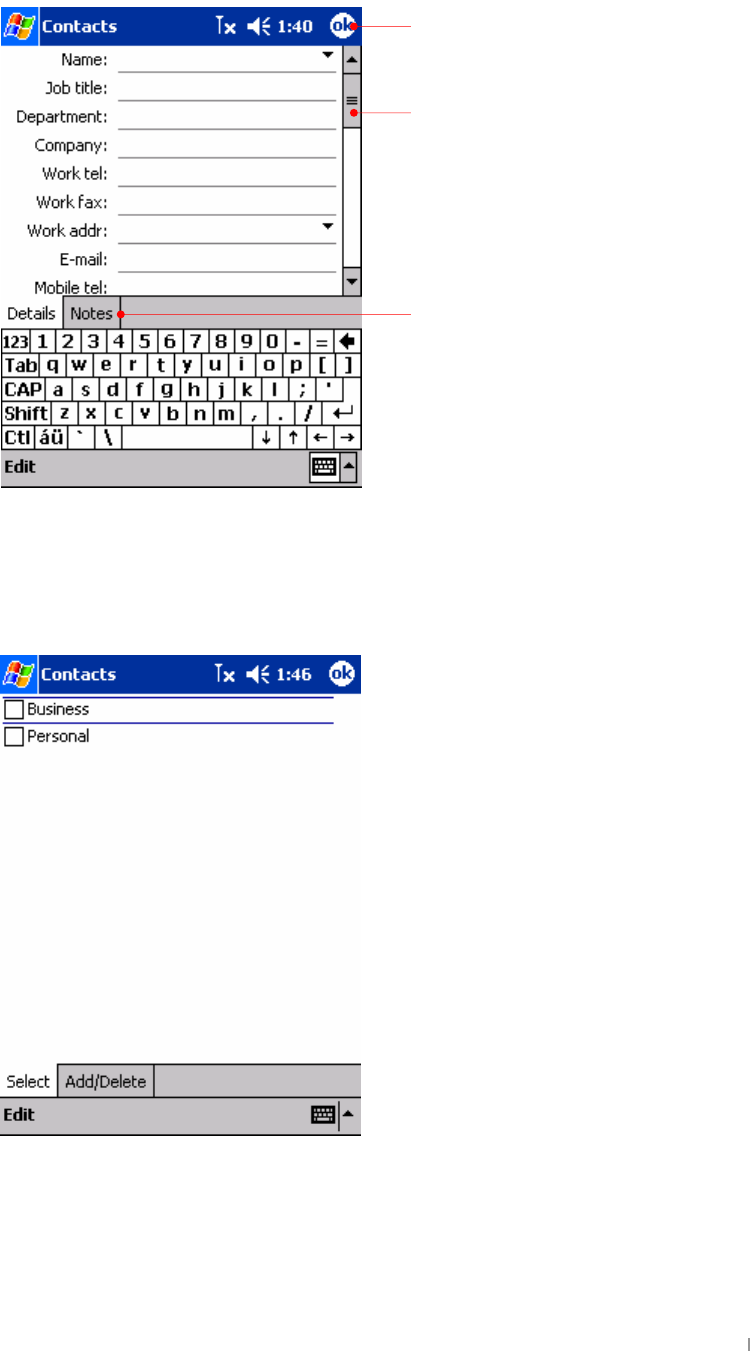
User’s Manual 8-8
To create a contact
1. Tap New.
2. Using the Input panel, enter a name and other contact information. You will need to
scroll down to see all available fields.
3. To assign the contact to a category, scroll to and tap Categories and select a
category from the list. In the contact list, you can display contacts by category.
4. To add notes, tap the Notes tab. You can enter text, draw, or create a recording. For
more information on creating notes, see “Notes: Capturing Thoughts and Ideas,”
later in this chapter.
5. Tap OK to return to the contact list.
Tap to return to the contact list (the
contact is saved automaticall
y)
.
Scroll to see more fields.
The Notes tab is a good place
for maps and directions.
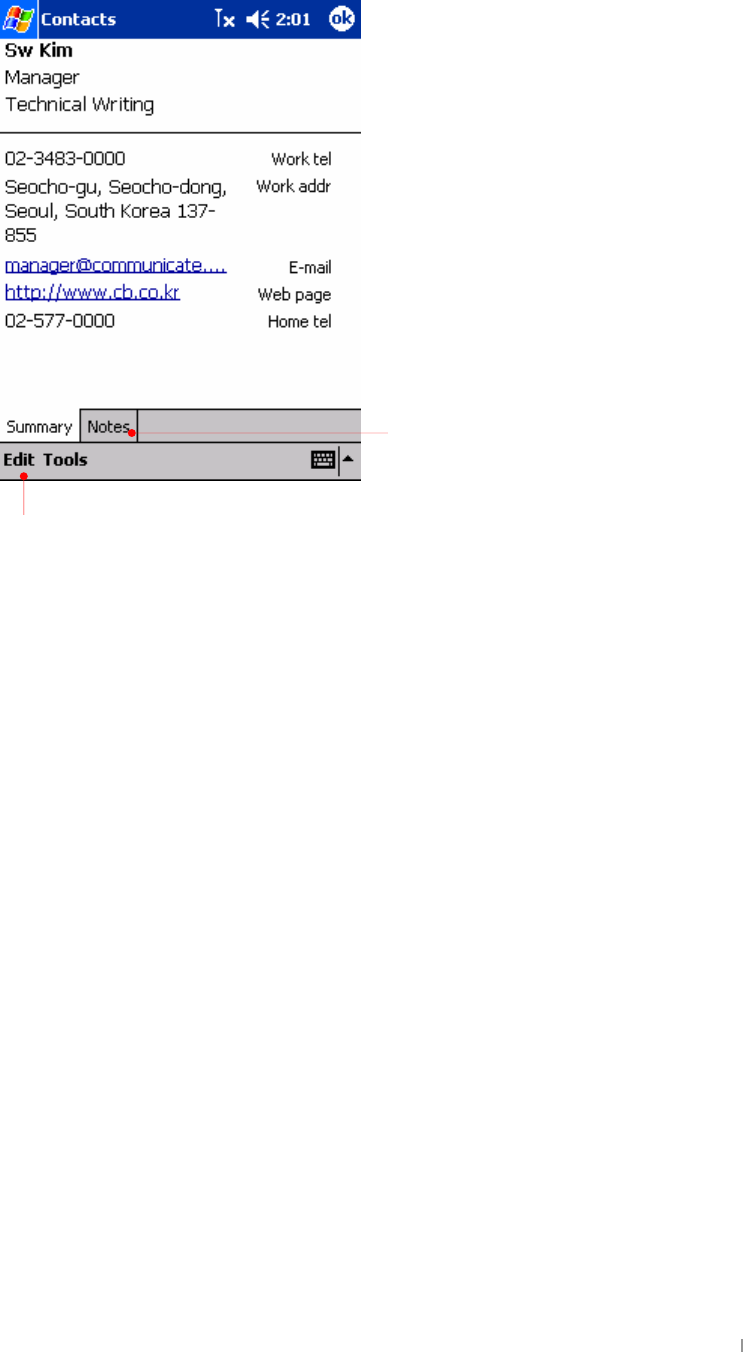
Chapter 8 Microsoft Pocket Outlook 8-9
Using the Summary Screen
When you tap a contact in the contact list, a summary screen is displayed.
Tap to view notes.
Tap to change contact
information.
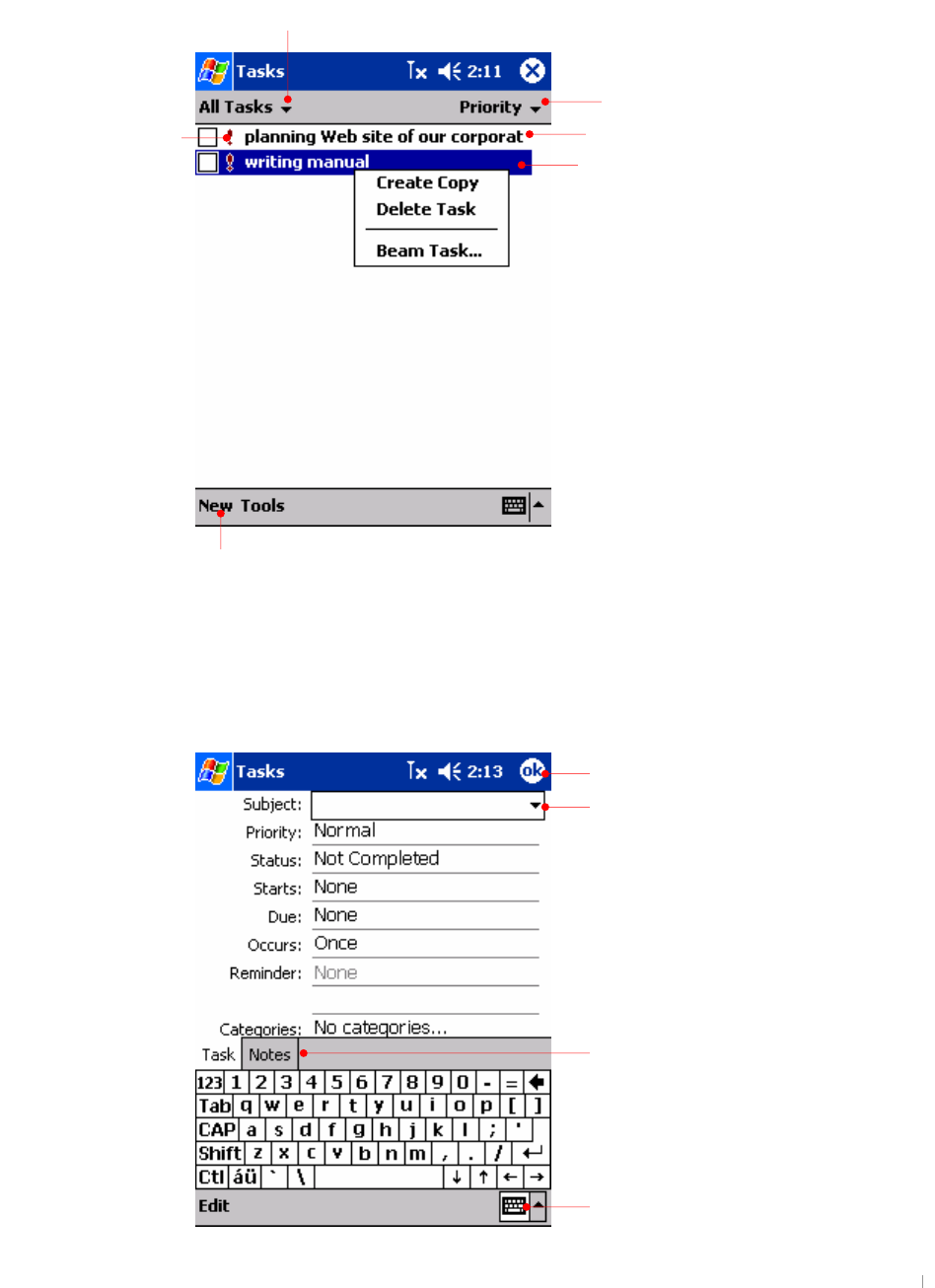
User’s Manual 8-10
Tasks : Keeping a To-Do List
Use Tasks to keep track of what you have to do.
To change the way information is displayed in the list, tap Tools, and then tap Options.
To create a task
1. Tap New.
Select the sort order of the list.
Select the category of tasks you want displayed in the list.
Tap to create a new task.
Indicates high priority. Tap to display or edit the task details.
Tap to return to the task list (the task is
saved automatically).
Tap to choose from predefined subjects.
Notes is a good place for maps
and drawin
g
s.
Tap to hide Input Panel.
Tap and hold to display a pop-up menu
of actions.
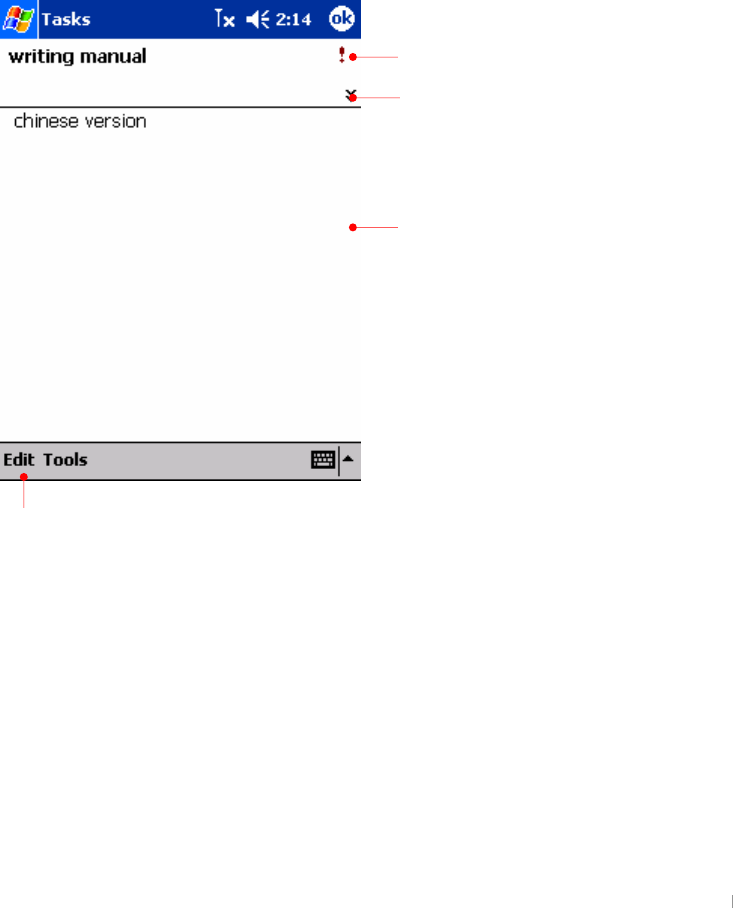
Chapter 8 Microsoft Pocket Outlook 8-11
2. Using the Input panel, enter a description.
3. You can enter a start date and due date or enter other information by first tapping
the field. If the Input panel is open, you will need to hide it to see all available fields.
4. To assign the task to a category, tap Categories and select a category from the list.
In the task list, you can display tasks by category.
5. To add notes, tap the Notes tab. You can enter text, draw, or create a recording. For
more information on creating notes, see “Notes: Capturing Thoughts and Ideas,”
later in this chapter.
6. Tap OK to return to the task list.
To quickly create a task with only a subject, tap Entry Bar on the Tools menu, and then
tap Tap here to add a new task.
Using the Summary Screen
When you tap a task in the task list, a summary screen is displayed. To change the task,
tap Edit.
View task details.
Tap to show and hide additional summary
information.
View notes.
Tap to change task.
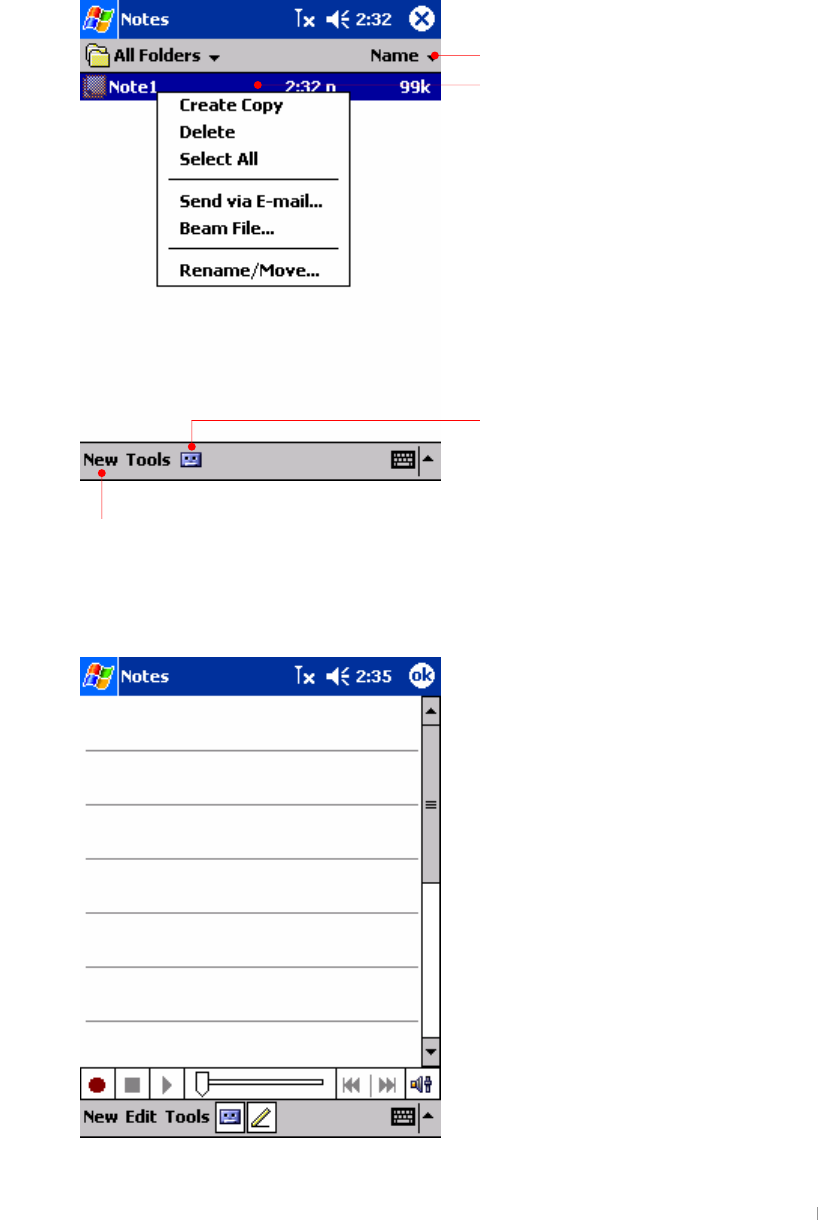
User’s Manual 8-12
Notes : Capturing Thoughts and Ideas
Quickly capture thoughts, reminders, ideas, drawings, and phone numbers with Notes.
You can create a written note or a recording. You can also include a recording in a note.
If a note is open when you create the recording, it will be included in the note as an icon.
If the note list is displayed, it will be created as a stand-alone recording.
To create a note
1. Tap New.
Tap to change the sort order of the list.
Tap and hold to display a pop-up
menu of actions.
Tap to show or hide the Recording
toolbar.
Tap to create a new item.
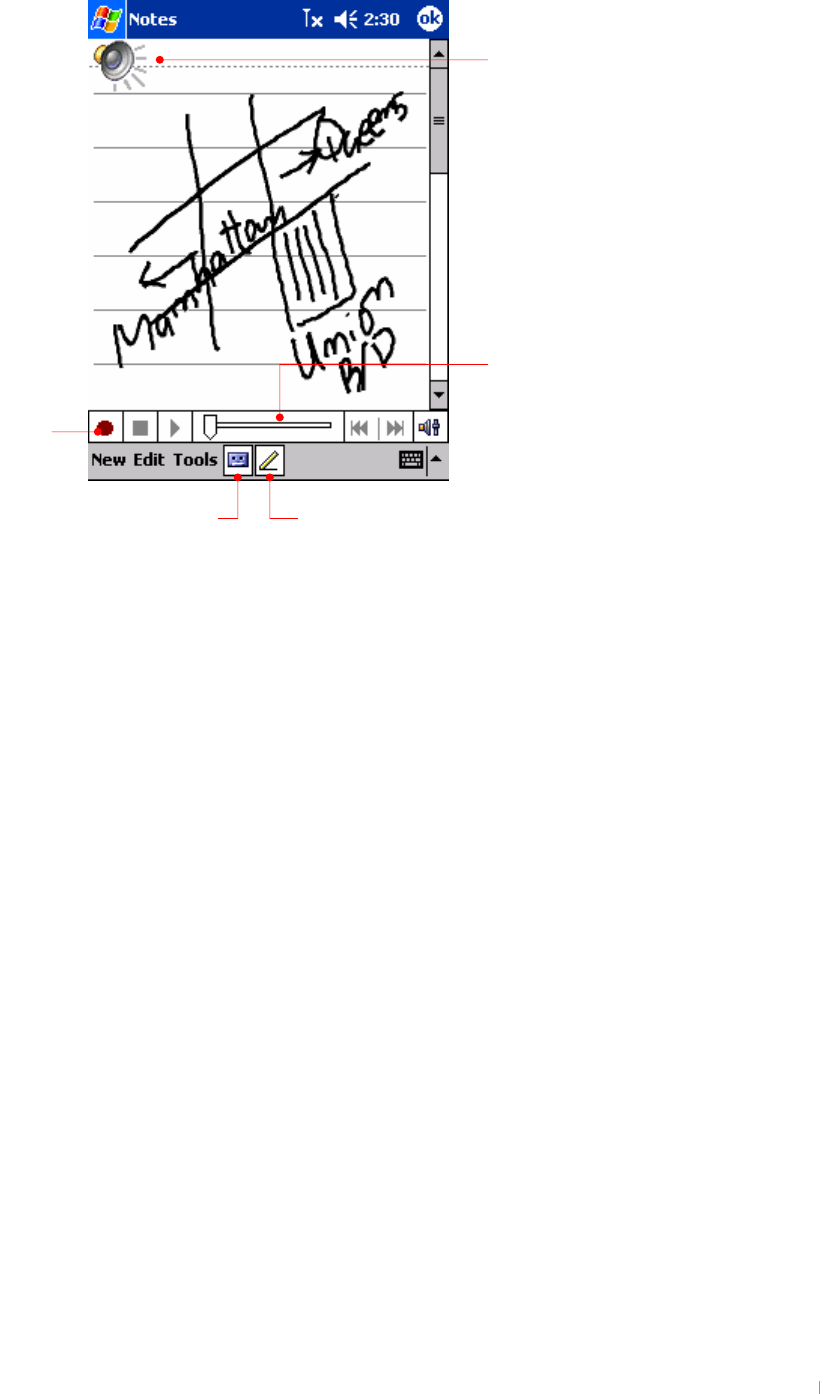
Chapter 8 Microsoft Pocket Outlook 8-13
2. Create your note by writing, drawing, typing, or recording.
Create your note by writing, drawing, typing, or recording. For more information about
using the Input panel, writing and drawing on the screen, and creating recordings, see
“Entering Information Using the Input Panel” in chapter 3.
These icon display the voice recording.
Record button
Display the process of recording.
Pen buttonTap to show or hide the
Recordin
g
toolbar.

Chapter 9 Microsoft Programs 9-1
Your device includes Microsoft Pocket PC Software 2002(Microsoft Pocket Word,
Microsoft Pocket Excel, Windows Media Player for Pocket PC, Microsoft Reader, and
Microsoft Messenger). This section provides an overview of these programs and enough
information to get you started. For complete instructions on using a program, refer to
online Help for that program.
⊙ In this chapter, you will learn about
− Microsoft Pocket Word
− Microsoft Pocket Excel
− Microsoft Windows Media Player
− Microsoft Reader
− Microsoft Messenger
Chapter 9
Microsoft Programs
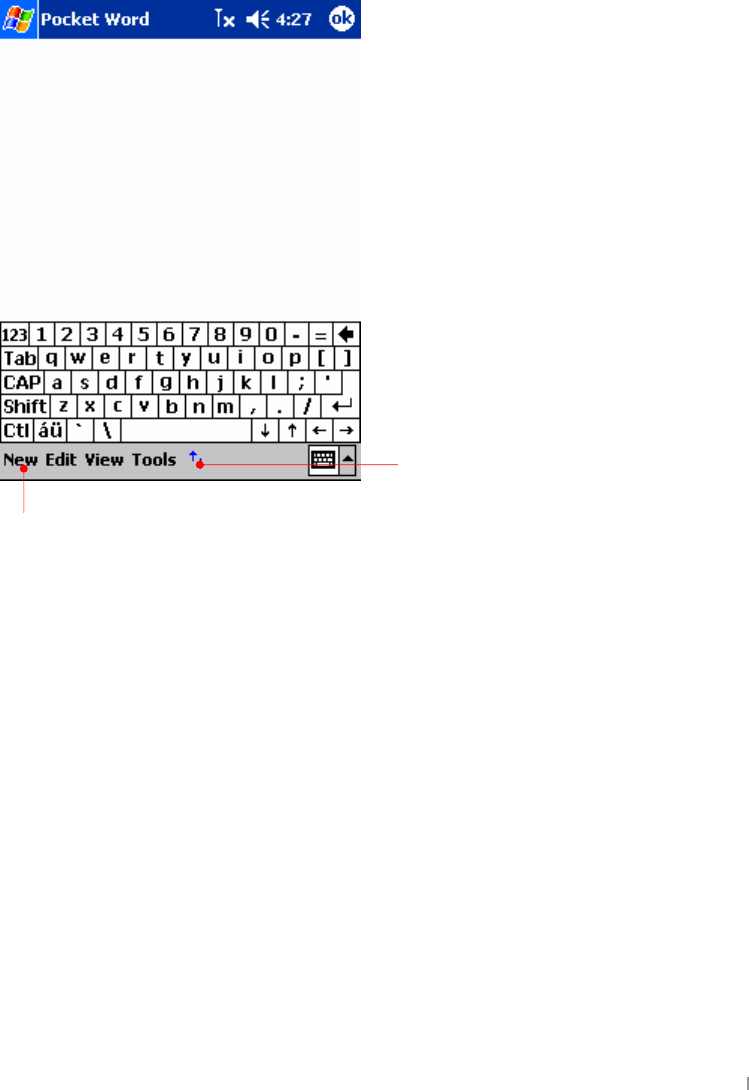
User’s Manual 9-2
Microsoft Pocket Word
Microsoft Pocket Word works with Microsoft Word on your desktop PC to give you easy
access to copies of your documents. You can create new documents on your device, or
you can copy documents from your desktop PC. Synchronize documents between your
desktop PC and your device regularly so that you have the most up-to-date content in
both locations.
To use Pocket Word
1. On the Start menu, tap Programs, and then tap the Pocket Word icon.
2. Tap New to open a blank document.
You can open only one document at a time; when you open a second document, you will
be asked to save the first. You can save a document you create or edit in a variety of
formats, including Pocket Word (.psw), Rich Text Format (.rtf), and Plain Text (.txt).
You can enter information in Pocket Word in four modes: typing, writing, drawing, and
recording. Use the View menu to switch between modes. Each mode has its own toolbar,
which you can show and hide by tapping the Show/Hide Toolbar button on the
Command bar.
Typing Mode. Use the Input panel to enter typed text into the document with either the
keyboard or the Letter Recognizer.
For more information on entering typed text, see “Entering Information” in chapter 3.
Writing Mode. In writing mode, use your stylus to write directly on the screen. Ruled
lines are displayed as a guide, and the zoom magnification is greater than in typing
Tap to show and hide toolbar.
Tap to make a new word file.
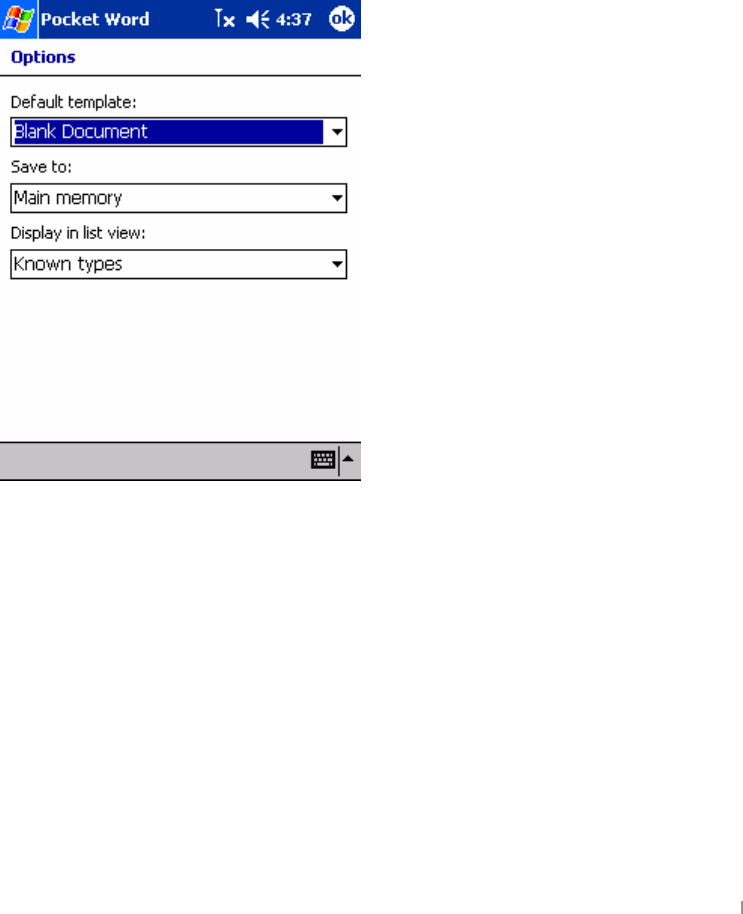
Chapter 9 Microsoft Programs 9-3
mode to allow you to write more easily. For more information on writing and selecting
writing, see “Entering Information” in chapter 3.
Written words are converted to graphics (metafiles) when a Pocket Word document is
converted to a Word document on your desktop PC.
Drawing mode. In drawing mode, use your stylus to draw on the screen. Gridlines
appear as a guide. When you lift your stylus off the screen after the first stroke, you will
see a drawing box indicating the boundaries of the drawing. Every subsequent stroke
within or touching the drawing box becomes part of the drawing. For more information on
drawing and selecting drawings, see “Entering Information” in chapter3.
Recording mode. Use recording mode to embed a recording into your document.
Recordings are saved as WAV files. For more information on recording, see “Entering
Information” in chapter3.
To open a template rather than a blank document, select a template for new documents.
On the Tools menu, tap Options, and then browse to select the default template. When
you tap New, the template appears with appropriate text and formatting already provided.
Tips for Working in Pocket Word
You can change the zoom magnification by tapping View and then Zoom. Then
select the percentage you want. Select a higher percentage to enter text and a lower
one to see more of your document.
If you are opening a Word document created on a desktop PC, select Wrap to
Window on the View menu so that you can see the entire document.
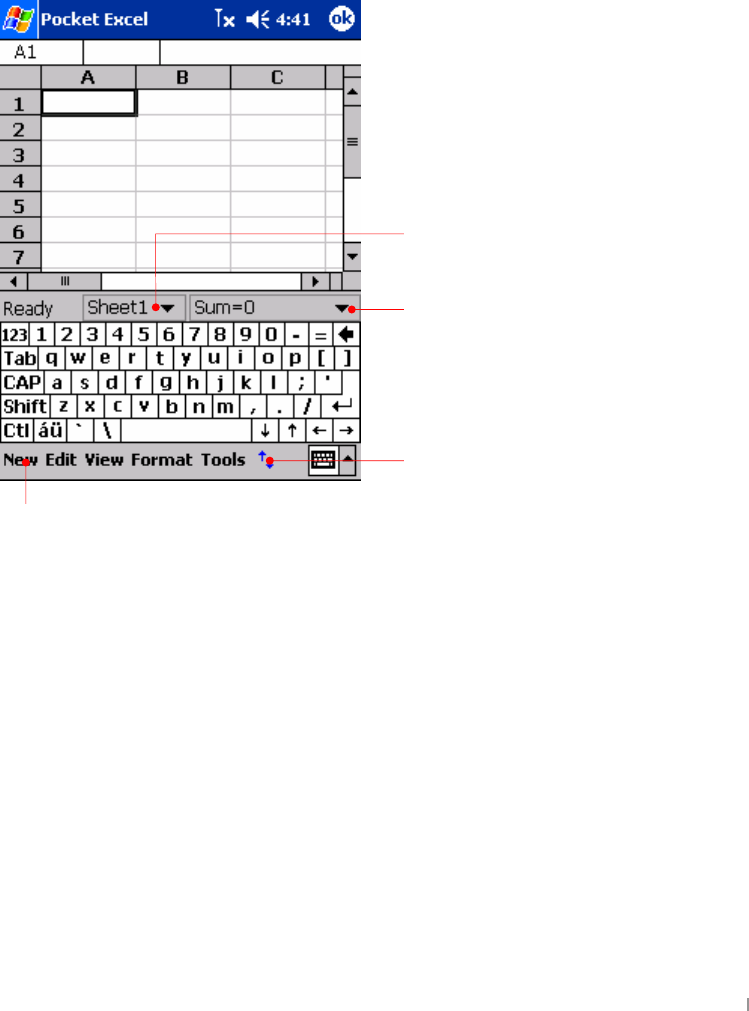
User’s Manual 9-4
Microsoft Pocket Excel
Microsoft Pocket Excel works with Microsoft Excel on your desktop PC to give you easy
access to copies of your workbooks. You can create new workbooks on your device, or
you can copy workbooks from your desktop PC to your device. Synchronize workbooks
between your desktop PC and your device so that you have the most up-to-date content
in both locations. Pocket Excel provides fundamental spreadsheet tools, such as
formulas, functions, sorting, and filtering, which enable you to create simple workbooks,
such as expense reports and mileage logs.
To use Pocket Excel
1. On the Start menu, tap Programs, and then tap the Pocket Excel icon.
2. Tap New to open a blank workbook.
To open a template rather than a blank workbook, select a template for new workbooks.
On the Tools menu, tap Options, and then browse to select the default template. When
you tap New, the template appears with appropriate text and formatting already provided.
You can open only one workbook at a time; when you open a second workbook, you will be
asked to save the first. You can save a workbook you create or edit in a variety of formats,
including Pocket Excel (.pxl) and Excel (.xls).
Tap to select a function you want.
Tap to select a sheet.
Tap to show and hide toolbar.
Tap to make a new Excel file.

Chapter 9 Microsoft Programs 9-5
Tips for Working in Pocket Excel
View in full-screen mode to see as much of your worksheet as possible. Tap View
and then tap Full Screen.
If your workbook contains sensitive information, you can protect it with a password.
To do so, open the workbook, tap Edit, and then tap Password.
Freeze panes on a worksheet. First, select the cell where you want to freeze panes.
Tap View and then tap Freeze Panes. You might want to freeze the top and leftmost
panes in a worksheet to keep row and column labels visible as you scroll through a
sheet.
Split panes to view different areas of a large worksheet. Tap View and then tap Split.
Then drag the split bar to where you want it. To remove the split, tap View and then
tap Remove Split.
Show and hide rows and columns. To hide a row or column, select a cell in the row
or column you want to hide. Tap Format, then tap Row or Column, and then tap
Hide. To show a hidden row or column, tap Tools, then tap Go To, and then type a
reference that is in the hidden row or column. Tap Format, then tap Row or Column,
and then tap Unhide.
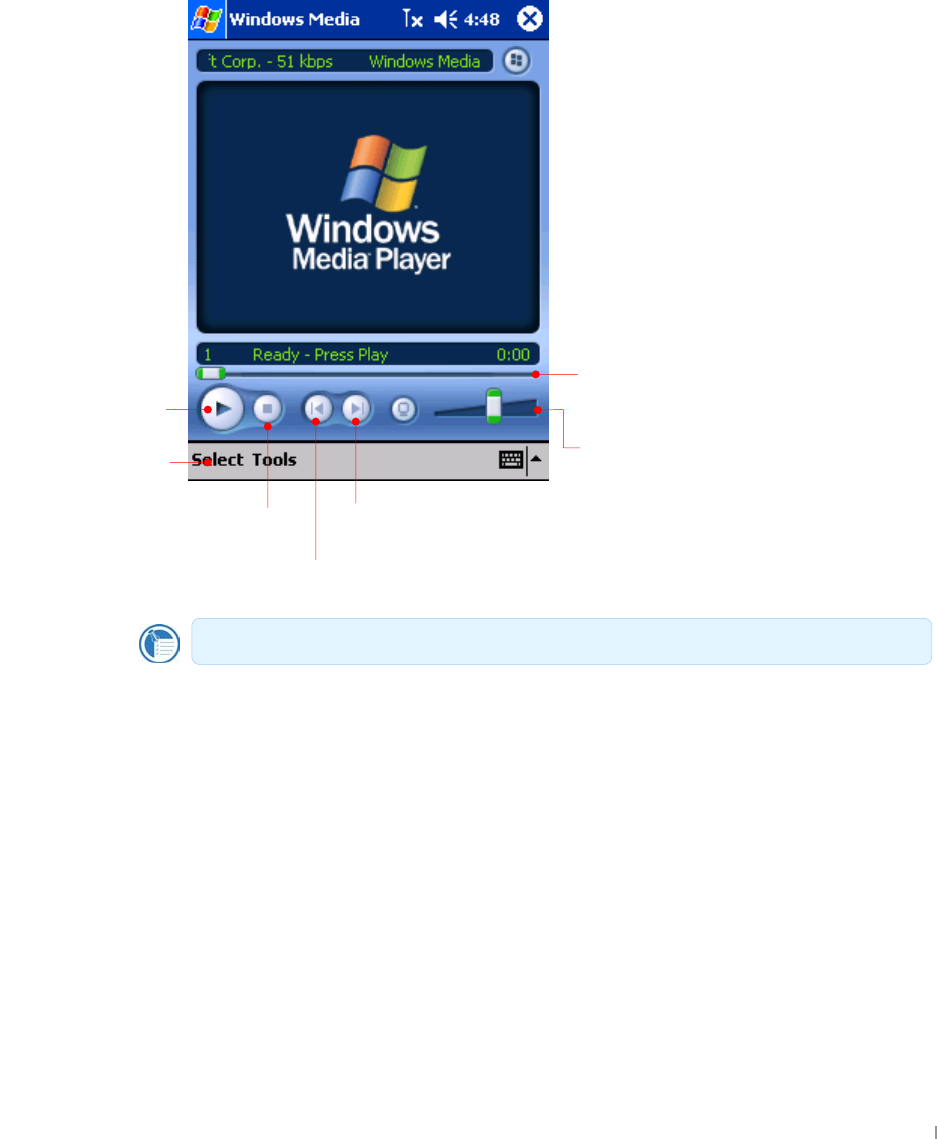
User’s Manual 9-6
Microsoft Windows Media Player
Use Microsoft Windows Media Player for Pocket PC to listen to digital audio and video
files, such as songs or movie clips. Media Player supports sound files recorded in MP3,
WMA, WMV, ASF, WMP formats.
To start Windows Media Player
On the Start menu, tap Programs, and then tap the Windows Media Player icon.
Indicates the progress of the
current track.
Tap to adjust volume.
Tap to stop.
Tap to pla
y
a previous song.
Tap to skip to the next song.
Tap to pla
y
or
pause.
Tap to select a song
or make a
p
la
y
list.
To play the music file repeatedly, select Repeat on the Tools menu.
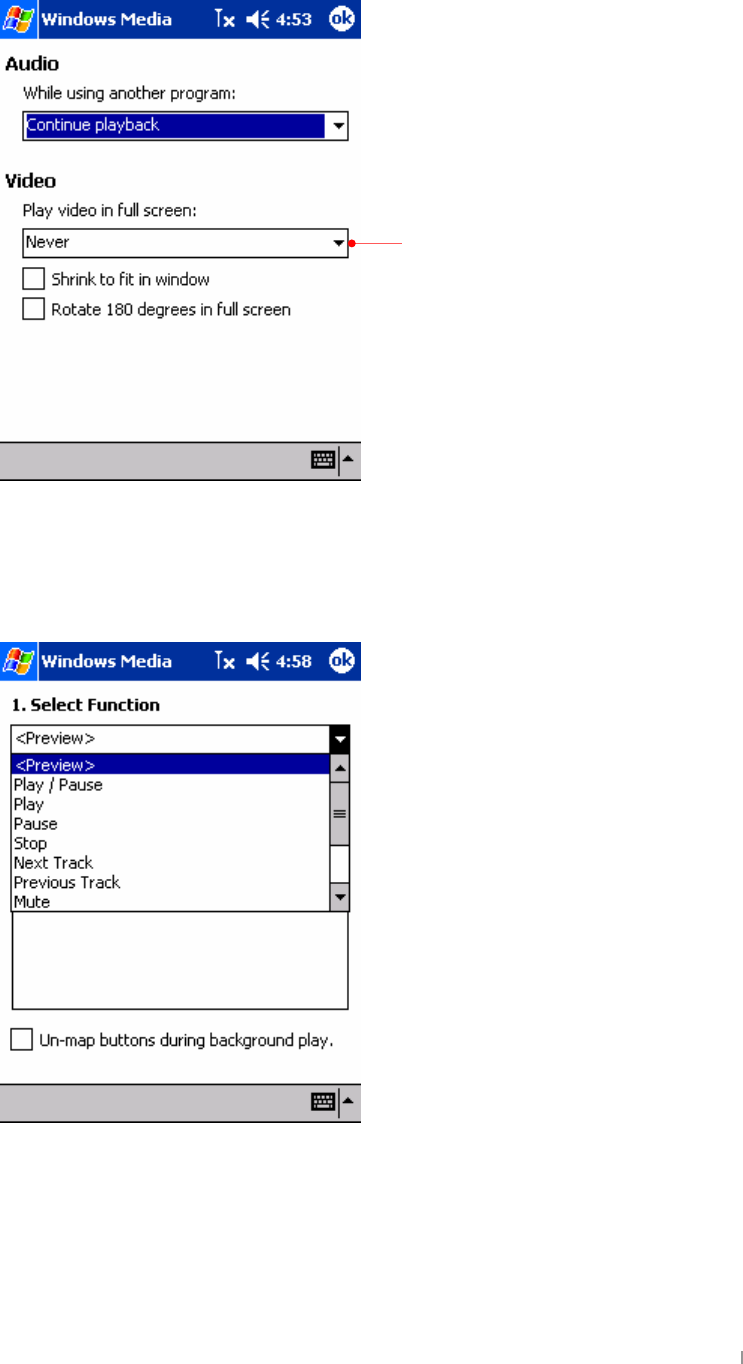
Chapter 9 Microsoft Programs 9-7
To set the options of Audio & Video, select Settings on the Tools menu and then select
Audio & Video.
To set the options on buttons of Windows Media Player, select Settings on the Tools
menu and then select Buttons.
Tap to set the size of screen when
playing back a video file.
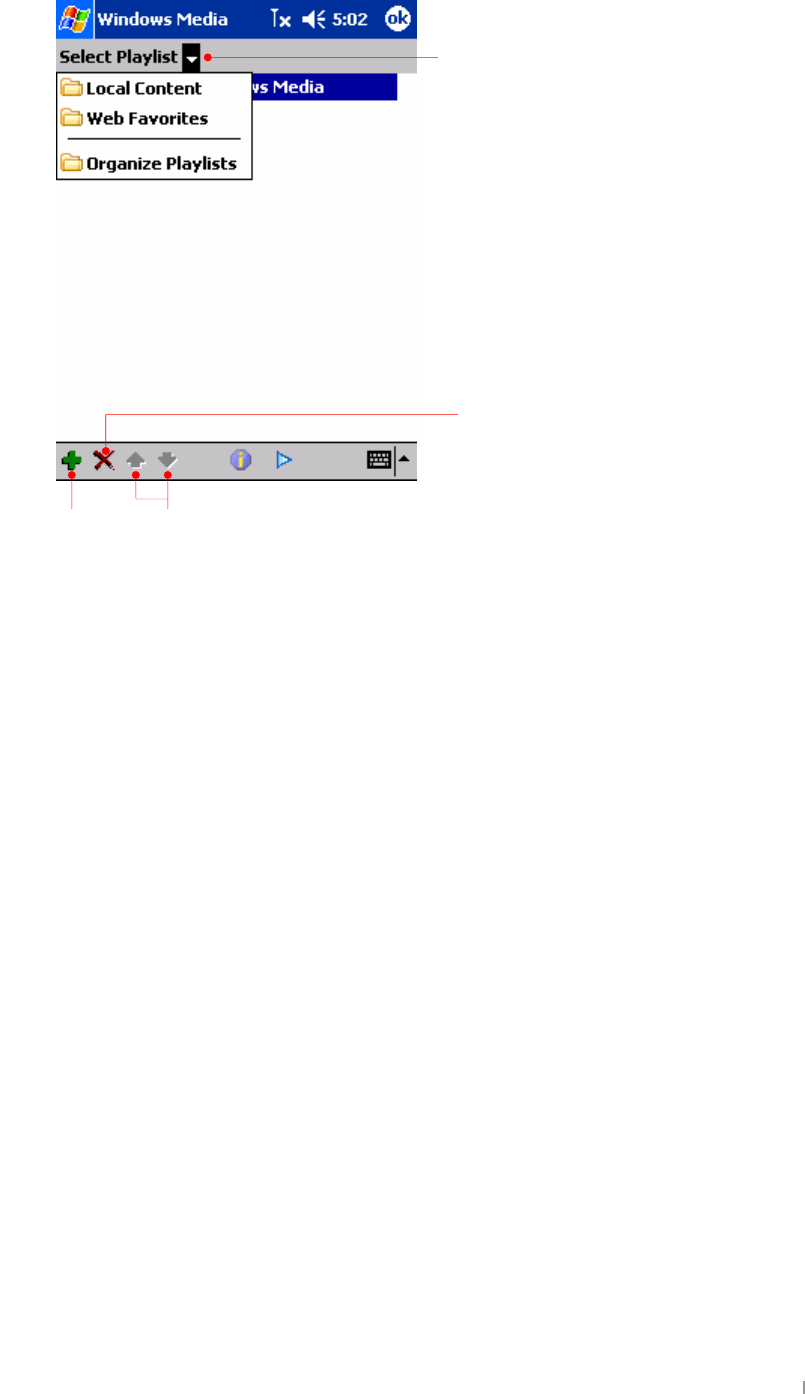
User’s Manual 9-8
To select a song and a playlist, tap Select.
Your device is uniquely identified by a UUID (Universally Unique ID). Many publishers of
digitally secured content, such as MP3 music files and electronic books (eBooks) use
digital rights management that relies on the device’s UUID to prevent unauthorized
usage. After your device has been serviced or repaired, you may be unable to access
digitally secured content that you had downloaded prior to the service. In such cases,
contact the content publisher for assistance.
Working with Audio Files on a SD Card
Because songs and audio files can use a lot of storage memory, you might want to store
them on a SD memory card.
Tap to select a folder
Tap to delete the selected item.
Tap to add the
selected file to
a playlist.
Tap to move the selected file
u
p
ward and downward.
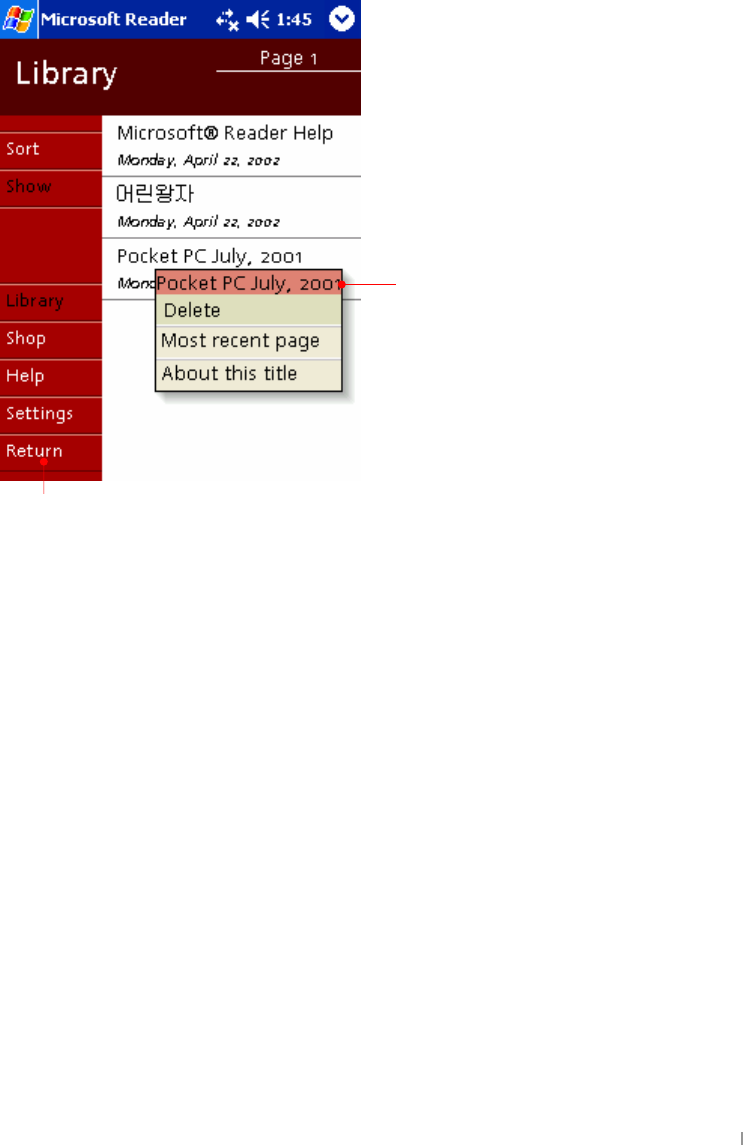
Chapter 9 Microsoft Programs 9-9
Microsoft Reader
Use Microsoft Reader to read eBooks(extension name : *.lit) on your device. Download
books to your desktop PC from eBook Web sites. Then, use ActiveSync to copy the book
files to your device. The books appear in the Reader Library.
To start Microsoft Reader
On the Start menu, tap Programs, and then tap Microsoft Reader.
Each book consists of a cover page, an optional table of contents, and the pages of the
book. You can
Page through the book by using the up/down control on your device or by tapping the
page number on each page.
Annotate the book with highlighting, bookmarks, notes, and drawings.
Search for text and look up definitions for words.
The Reader Guidebook is preinstalled on your device, and contains all the information
you will need to use Microsoft Reader. To open the Guidebook, tap Help on the Reader
command bar. Or, on a book page, tap and hold on the book title, and then tap Help on
the pop-up menu.
Pop-up menu that results from
tapping and hold.
Tap to go back to the Library.
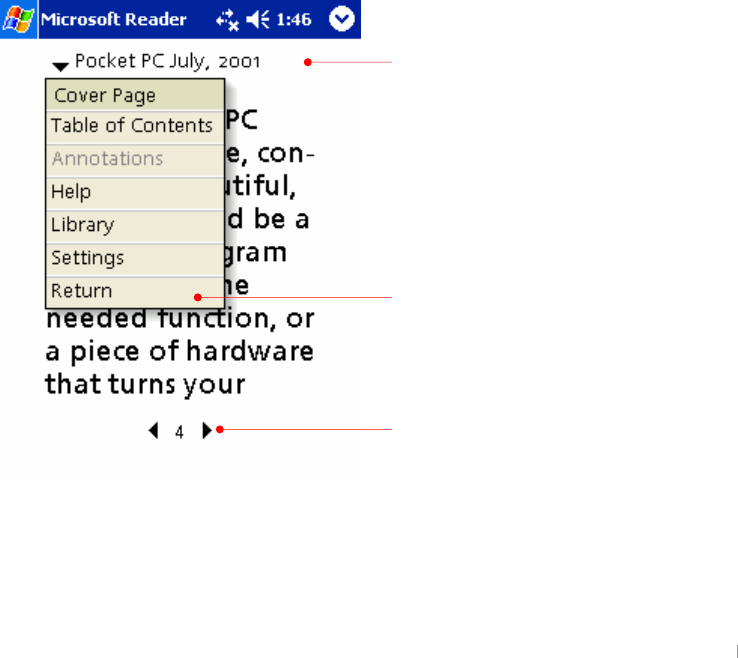
User’s Manual 9-10
Getting eBooks for Your device
You can download book files from the Web. Just visit your favorite eBook retailer and
follow the instructions to download the book files. Sample books and a dictionary are
also included in the MSReader folder in the Extras folder on the Pocket PC Companion
CD.
Your device is uniquely identified by a UUID (Universally Unique ID). Many publishers of
digitally secured content, such as MP3 music files and eBooks, use digital rights
management that relies on the device's UUID to prevent unauthorized usage. After your
device has been serviced or repaired, you may be unable to access digitally secured
content that you had downloaded prior to the service. In such cases, contact the content
publisher for assistance.
Using the Library
The Library is your Reader home page; it displays a list of all books stored on your
device or storage card.
Reading a Book
Each book consists of a cover page, an optional table of contents, and the pages of the
book. Navigation options are listed in the bottom portion of the cover page.
The first time you open a book, you will probably want to go to the first page or to the
table of contents, if there is one. Subsequently, whenever you open the book, you will be
automatically taken to the last page you read.
In addition to the text, each book page includes a page number and book title.
Tap to open pop-up menu.
Ta
p
to
g
o back to the Librar
y
.
Tap arrows to turn the page, or tap and
hold page number to bring up page riffle.
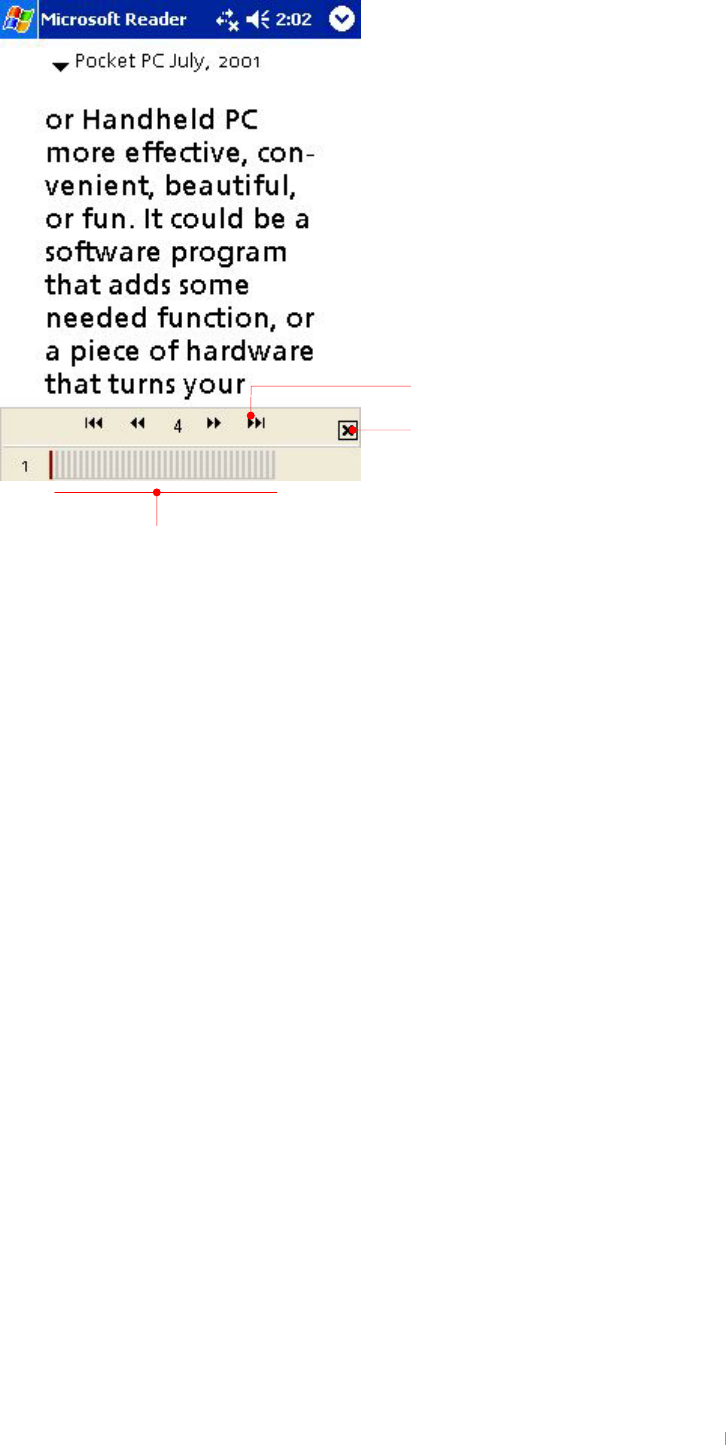
Chapter 9 Microsoft Programs 9-11
You can also page through a book by using the up/down control on your device.
Using Reader Features
Reading a book electronically gives you several options not available with paper books.
These options are available from any book page.
Select text by dragging across the text on the page. Then, tap an option on the pop-up
menu, as described here:
Search for text. Find text in a book by tapping Find on the popup menu. Enter the
word you want to search for, and tap the desired Find option. Reader highlights the
found text on the page. To close Find, tap outside the box. To return to your original
page, tap the title and then tap Return on the pop-up menu.
Copy text. You can copy text from books that support this feature into any program
that accepts text. On a book page, select the text you want to copy, and then tap
Copy Text on the pop-up menu. The text can be pasted into the program of your
choice.
Bookmarks. When you add a bookmark to a book, a color-coded bookmark icon
appears in the right margin. You can add multiple bookmarks to a book. Then, from
anywhere in the book, tap the bookmark icon to go to the bookmarked page.
Highlights. When you highlight text, it appears with a colored background.
Notes. When you attach a note to text, you enter the text in a notepad that appears
on top of the book page. A Note icon will be displayed in the left margin. To show or
hide the note, tap the icon.
Drawings. When you add a drawing, a Drawing icon appears in the lower-left corner
of the page, and drawing tools appear across the bottom of the page. Draw by
dragging your stylus.
Tap to return to the
original state.
Tap here to navigate to other parts of the Reader.
Tap here to turn much
more pages with one tap.
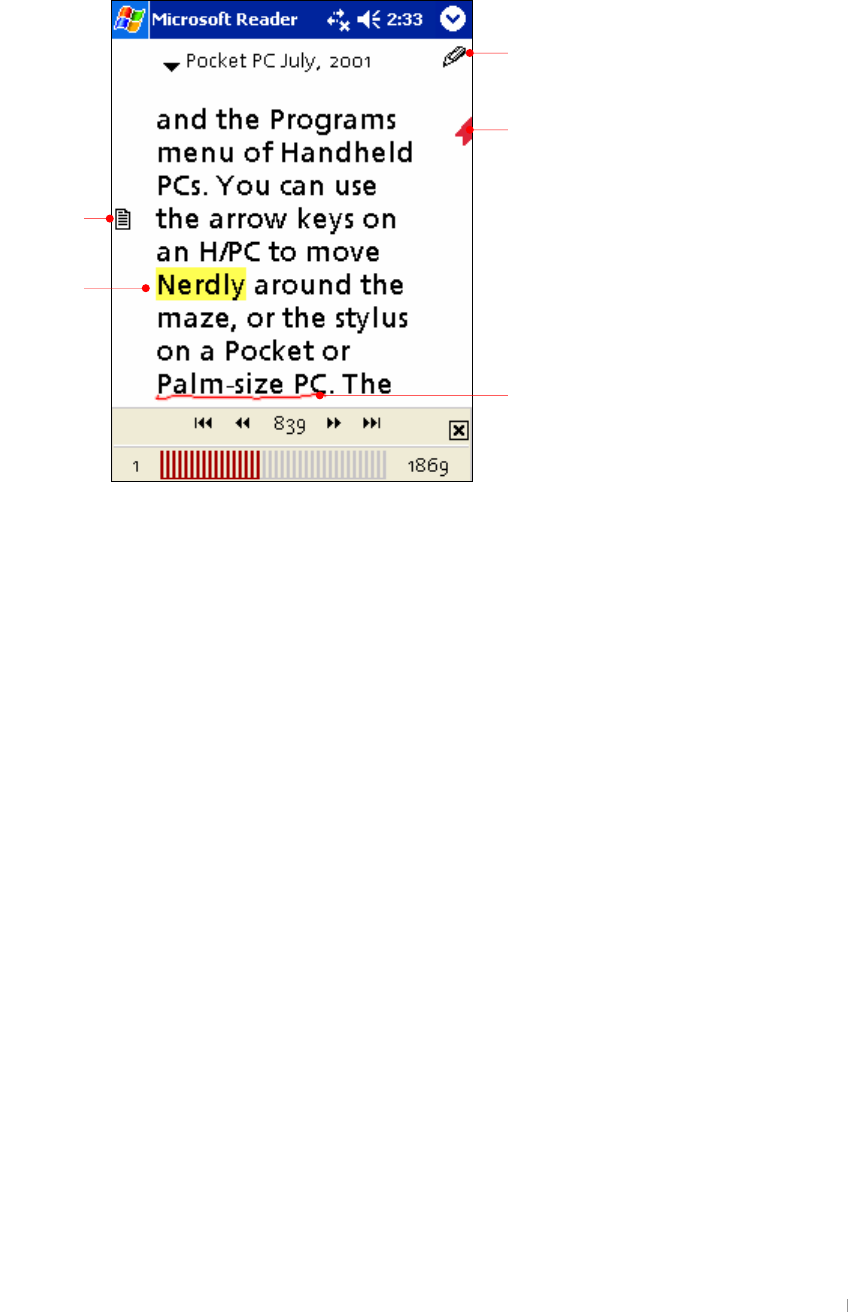
User’s Manual 9-12
Annotations. To see a list of a book’s annotations, including bookmarks, highlights,
text notes, and drawings, tap Annotations Index on the book’s cover page. You can
tap an entry in the list to go to the annotated page.
Removing a Book
When you finish reading a book, you can delete it to conserve space on your device. If a
copy of the book is stored on your desktop PC, you can download it again at any time.
To remove a book from your device, tap and hold the title in the Library list, and then tap
Delete on the pop-up menu.
Drawing icon
Bookmark
Text
Drawing
Highligh
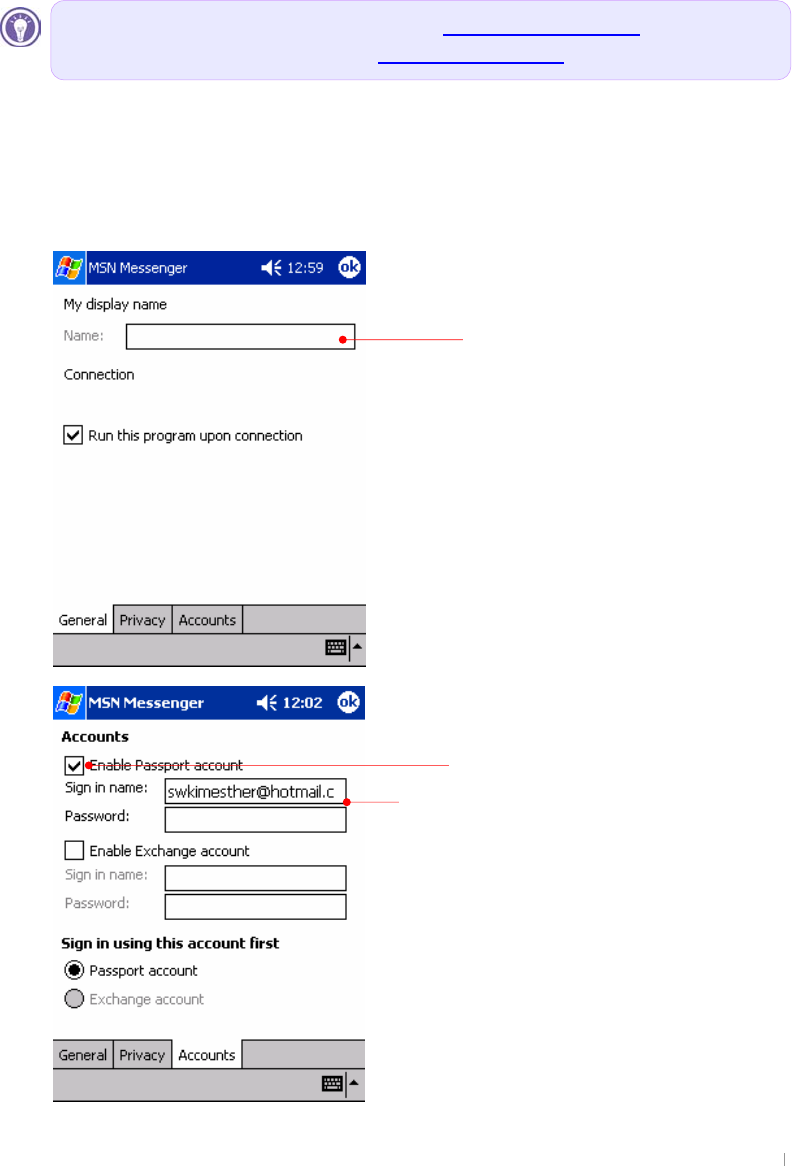
Chapter 9 Microsoft Programs 9-13
MSN Messenger
MSN Messenger is an instant messaging program that lets you see who is online, send
and receive instant messages and have instant message conversations with groups of
contacts.
To use MSN Messenger, you must have a Microsoft Passport account. If you have a
Hotmail® or MSN account, you already have a Passport. Once you have obtained a
Microsoft Passport, you are ready to set up your account.
To set up an account and sign in
1. On the Start menu, tap Programs, and then tap the MSN Messenger icon.
2. On the Tools menu, tap Options. On the Accounts tab, enter your Passport
account information.
Select Passport account.
Enter your name and password.
Sign up for a Microsoft Passport account at http://www.passport.com . Get a free
Microsoft Hotmail e-mail address at http://www.hotmail.com.
Enter your name for chat.
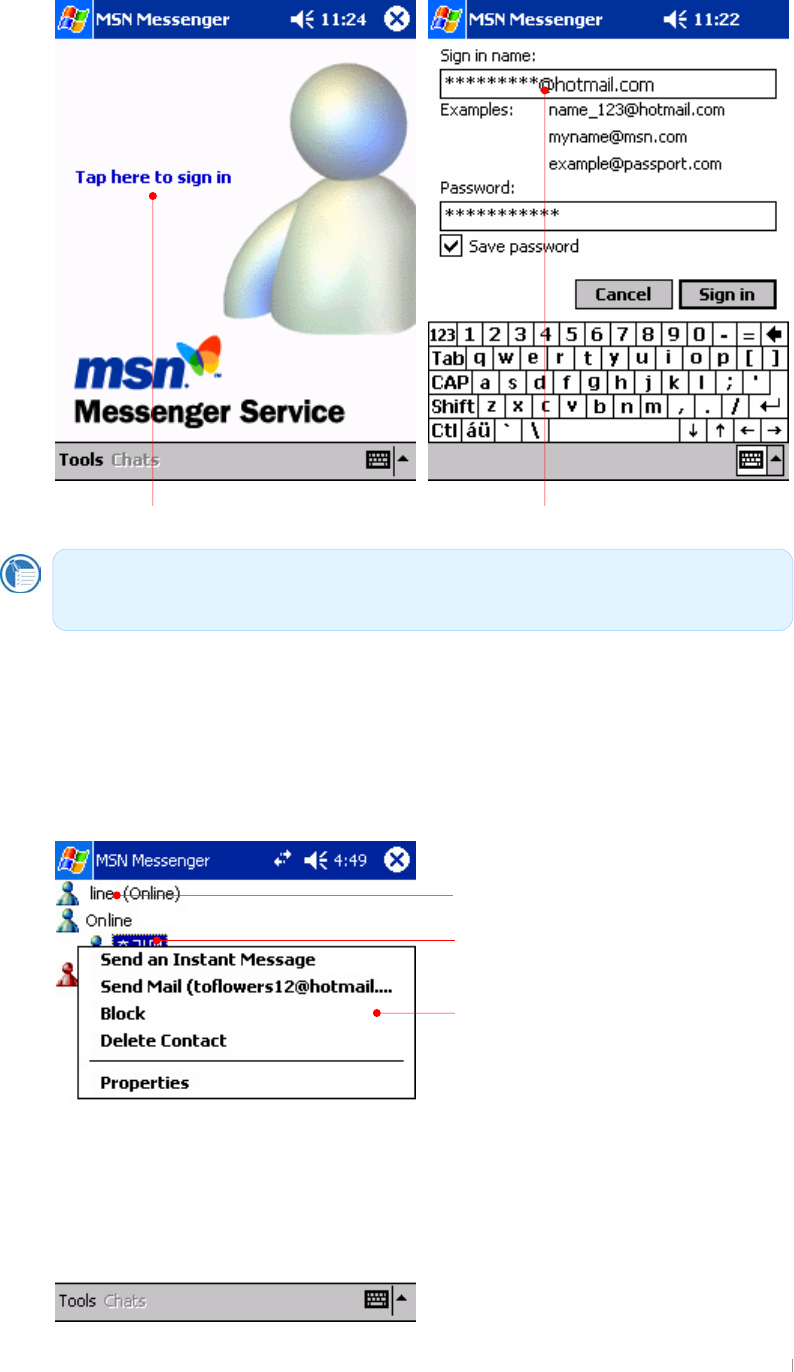
User’s Manual 9-14
3. Tap OK.
4. To sign in, tap the sign-in screen and enter your e-mail address and password.
Working with Contacts
The MSN Messenger window shows all of your messenger contacts at a glance, divided
into Online and Not Online categories. From this view, while connected, you can chat,
send e-mail messages, block the contact from chatting with you, or delete contacts from
your list using the pop-up menu.
Tap here to register. The account you entered before displays.
Tap and hold to display a pop-up menu of
actions.
Tap a contact to start a chat.
To make a new name for chat, tap
O
p
tions on the Tools menu.
If you already use MSN Messenger on your desktop PC, your contacts will show
up on your device without being added again.
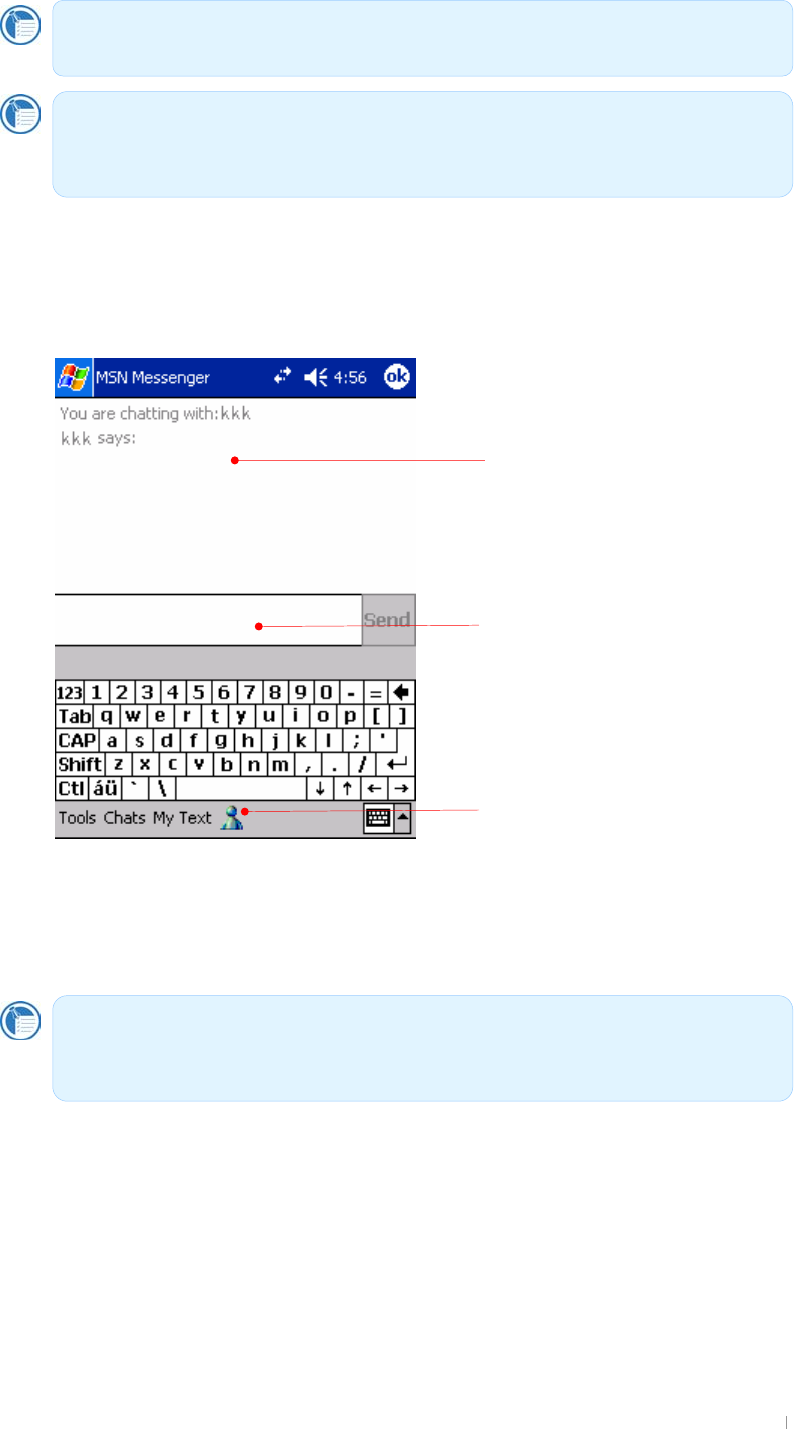
Chapter 9 Microsoft Programs 9-15
Chatting with Contacts
Tap a contact name to open a chat window.
Enter your message in the text entry area at the bottom of the screen (or tap My Text to
enter a preset message), and then tap Send. To invite another contact to a multi-user
chat, on the Tools menu, tap Invite, and then tap the contact you want to invite.
Contacts icon
The message you enter
display here.
Text entry area
To see others online without being seen, on the Tools menu, tap My Status, and
then tap Appear Offline.
If you block a contact, you will appear offline but will remain on the blocked
contact’s list. To unblock a contact, tap and hold the contact, then tap Unblock
on the pop-up menu.
To switch back to the main window without closing a chat, tap the Contacts
button. To revert to your chat window, tap Chats, and then select the person with
whom you were chatting.
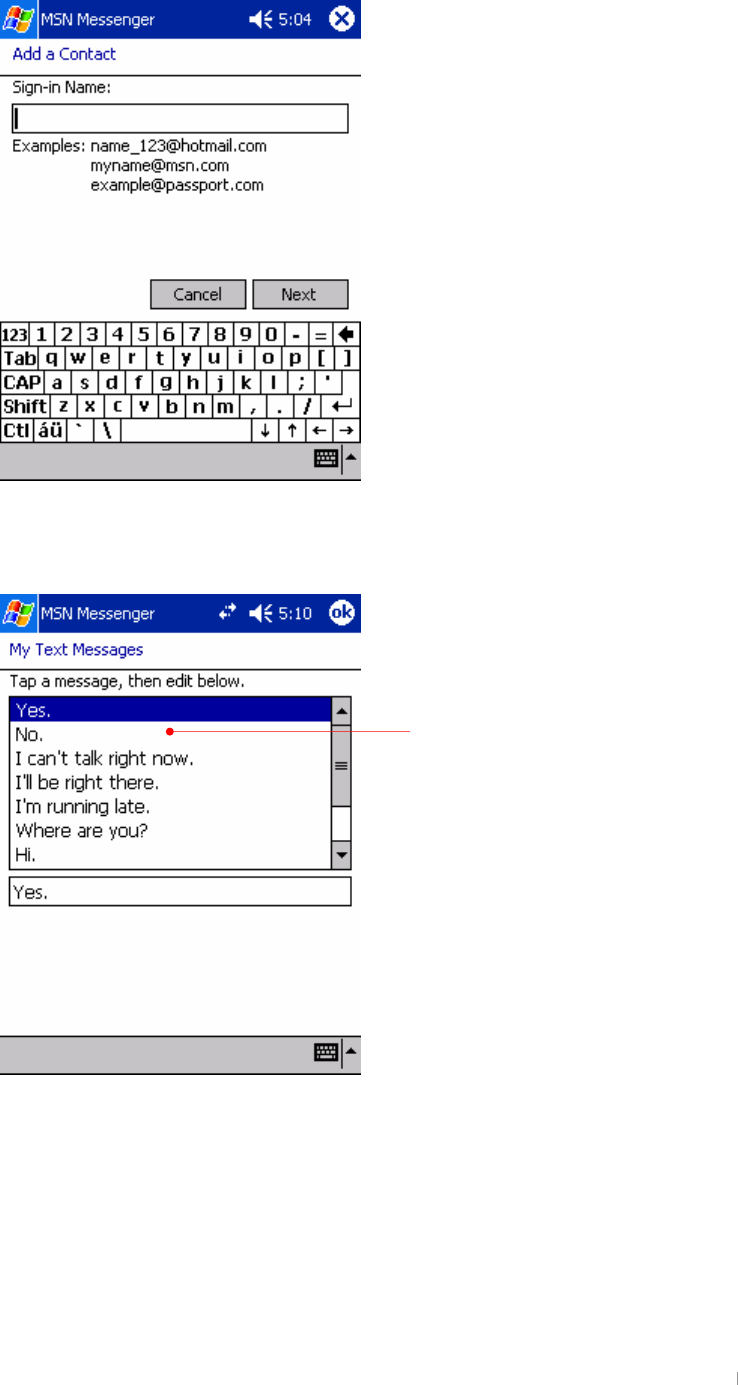
User’s Manual 9-16
Adding a Contact
To add a new contact, tap Add a Contact on the Tools menu.
Editing My Text Messages
Tap Edit My Text Messages on the Tools menu to enter a preset message.
Select a message among the list
that is preset.

Chapter 10 Support & Service 10-1
Web site
You can obtain product information as well as tips and hints on how to get more from the
product at our Web site. This computer service is provided free of charge; you pay only
for telephone charges and Internet service fees. To connect to this Web site from a
computer via the Internet, go to www.cb.co.kr.
Service
For diagnostic instructions and other service information, contact one of the technical
support numbers. Please do not ship your device for service without first contacting a
CYBERBANK office. If your device qualifies for in-warranty service, be ready to supply a
dated proof of purchase.
Before you contact us for help, be sure to:
1. Review the manuals whenever possible.
2. Have the following information about the product:
model number
serial number
purchase date
3. Have your product ready to use. The support personnel may ask you to run tests
and other operations.
4. Organize your question or problem. The more detailed information you can provide,
the quicker the support personnel can help you.
Chapter 10
Support & Service
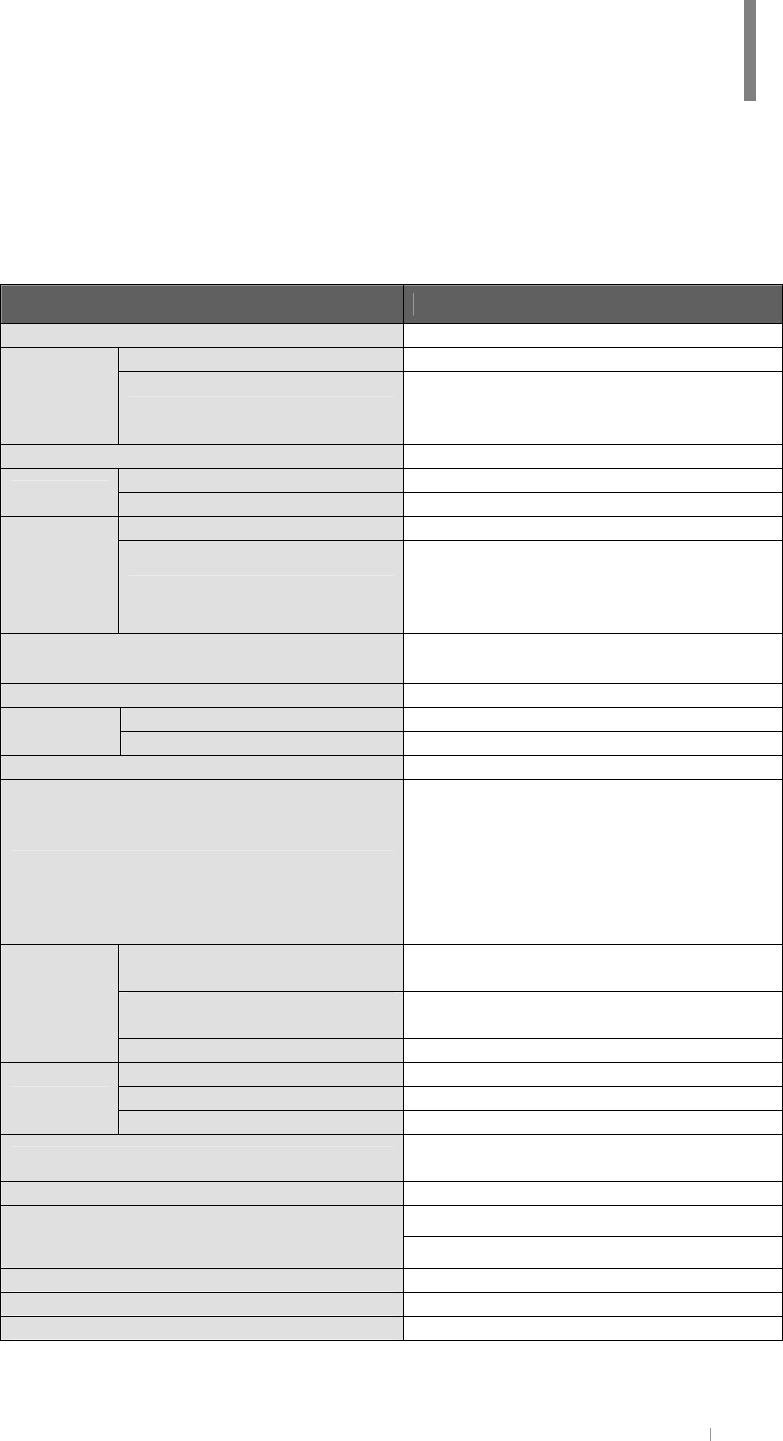
Appendix A Hardware Specification A-1
Hardware Specifications
Items Descriptions
OS Pocket PC 2002
PDA PXA250 –200MHz (Cotulla)
Processor CDMA
MSM5000
(Temperature : -20~60℃,
Humidity : 0 ~ 95%)
Phone Module CDMA2000 1XRTT
ROM Flash Memory(64Mbyte)
Memory RAM SDRAM(64Mbyte)
Main Li-Polymer 1400mAh
Battery Backup
Li-Ion 3.7V, 110mAh,
Time for charging : 6 hours
Charge by Main battery or the external
power
Size (mm)
widthxlengthxheight 70.5 x129.5 x 18
Weight (g) 199g
Resolutions 240 X 320
Screen Color 3.5 " Reflective, TFT LCD 65K Color
External Power 110~220V(charging : 800mAh)
Cradle
DC 5V, 2A
Charging the main and backup battery
at the same time
Time for charging the backup battery :
max 3.5 hours
Operating Temperature : -20~60℃
Operating Humidity : 0 ~ 95%
USB
(Universal Serial Bus) Client(charging : 450mA)
SD
(Secure Digital) External memory card
I/O
Connector
IrDA 115Kbps
For Stand-by 80~200 hours
For voice communications 2.5 hours (PDA Sleep mode)
Time
For PDA 12 hours(Phone stand-by mode)
LED Battery charging status (Red, Blue)
Phone Status (Red, Green, Blue)
Sound Stereo while using headset
For voice communications
Speaker For PDA alarm
Vibrator Muting instead of phone ring
Microphone For voice communications & recording
Interface Connecter USB Client, Power, DM Port, Serial
Appendix A

Appendix B Warranty B-1
Warranty
Important: This is your hardware product warranty statement. Read it carefully. Warranty
terms may be different in your country. If so, your authorized dealer or sales and service
office can give you details.
One year limited hardware warranty
CYBERBANK warrants this hardware product against defects in material and
workmanship for a period of one year from receipt by the original end-user purchaser. If
CYBERBANK receives notice of the above-defined defects during the warranty period,
CYBERBANK will either, at its option, repair or replace products that prove to be
defective. Should CYBERBANK be unable to repair or replace the product within a
reasonable amount of time, the customer's alternate exclusive remedy shall be a refund
of the purchase price upon return of the product.
Limitation of warranty
The above warranty shall not apply to defects resulting from: misuse;
unauthorized modification; opening for any reason; operation or storage outside the
environmental specifications for the product; in-transit damage;
improper maintenance; or defect resulting from use of non-CYBERBANK software,
accessories, media, supplies, consumables, or such items not designed for use with the
product.
CYBERBANK makes no other express warranty, whether written or oral, with respect to
this product.
Any implied warranty of merchantability or fitness for a particular purpose is limited to the
one-year duration of this written warranty.
Some states, provinces, or countries do not allow limitations on how long an implied
warranty lasts, so the above limitation or exclusion may not apply to you.
This warranty gives you specific legal rights, and you may also have other rights that
vary from state to state, province to province, or country to country.
Appendix B

User’s Manual B-2
CYBERBANK Software Product License Agreement and
CYBERBANK Software Product Limited Warranty
This CYBERBANK product contains preinstalled software programs. Please read the
CYBERBANK Software Product License Agreement before proceeding.
Important: Carefully read this License Agreement and the Limited Warranty statement
before operating the equipment. The rights to the software are licensed, not sold.
CYBERBANK or its licensors continue to own all intellectual property rights to the
software, and you will be granted certain rights to use the software upon your
acceptance of this license. Rights in the software are offered only on the condition that
you agree to all terms and conditions of the License Agreement. Operating the
equipment indicates your acceptance of these terms and conditions. If you do not agree
to the terms and conditions of the License Agreement, return the complete package for a
full refund now.
CYBERBANK Software Product License Agreement
The CYBERBANK Software Product License Agreement shall govern the use of all
software that is provided to you, the customer, as part of this CYBERBANK product with
the exception of Microsoft Software. Microsoft Products are licensed to you under the
Microsoft End User License Agreement (EULA) contained in the Microsoft
documentation. Any third-party software supplier's warranty terms that may be found
online, or in any documentation or other materials contained in the product packaging,
shall govern the use of that third-party software.
Use
You may only use the software on a single computer. You may not reverse, assemble, or
decompile the software.
Copies and adaptations
You may make copies or adaptations of the software (a) for archival purposes, or (b)
when copying or adaptation is an essential step in the use of the software with a
computer so long as the copies and adaptations are used in no other manner.
You have no other rights to copy unless you acquire an appropriate license to reproduce
which is available from CYBERBANK for some software.
You agree that CYBERBANK provides no warranty, free installation, or free training for
any copies or adaptations made by you.
All copies and adaptations of the software must bear the copyright notice(s) contained in
or on the original.

Appendix B Warranty B-3
Ownership
You agree that you do not have any title to or ownership of the software, other than
ownership of the physical media. You acknowledge and agree that the software is
copyrighted and protected under the copyright laws.
You acknowledge and agree that the software or part thereof may have been developed
by a third-party software supplier named in the copyright notice(s) included with the
software, who shall be authorized to hold you responsible for any copyright infringement
or violation of this or their own License Agreement.
Transfer of rights in software
You may transfer rights to the software to a third party only as part of the transfer of all your
rights and only if you obtain the prior agreement of the third party to be bound by the terms of
this License Agreement. Upon such a transfer, you agree that your rights to the software are
terminated and that you will either destroy all your copies and adaptations or deliver them to
the third party. Transfer to a U.S. government department or agency or to a prime or lower
tier contractor in connection with a U.S. government contract shall be made only upon prior
written agreement to terms required by CYBERBANK.
Sublicensing and distribution
You may not lease, sublicense the software, or distribute copies or adaptations of the
software to the public in physical media, by telecommunication or at all without the prior
written consent of CYBERBANK.
Termination
CYBERBANK may terminate this software license for failure to comply with any of these
terms, provided CYBERBANK has requested you to cure the failure and you have failed to do
so within thirty (30) days of such notice.
Updates and upgrades
You agree that the software does not include updates and upgrades that may be available
from CYBERBANK under a separate support agreement.